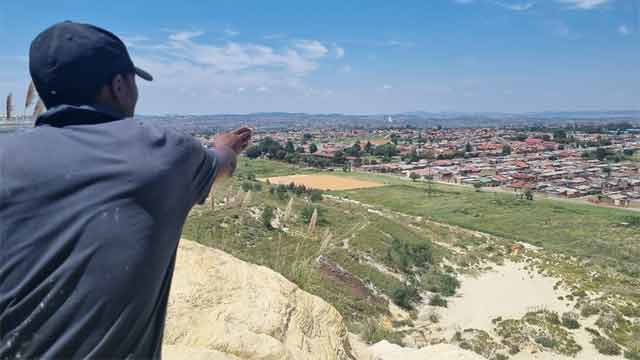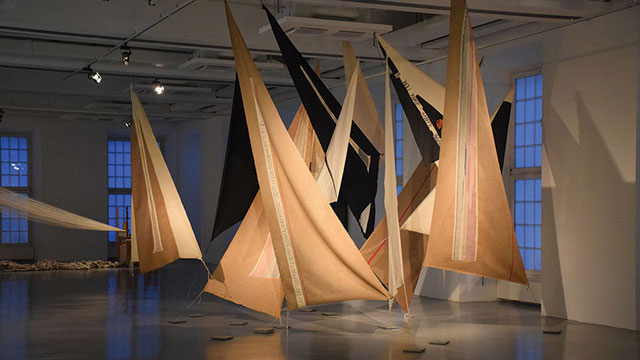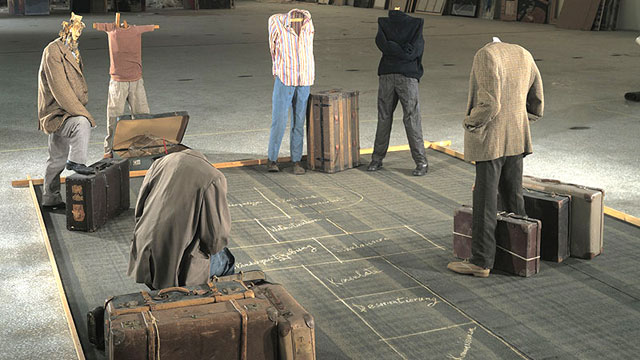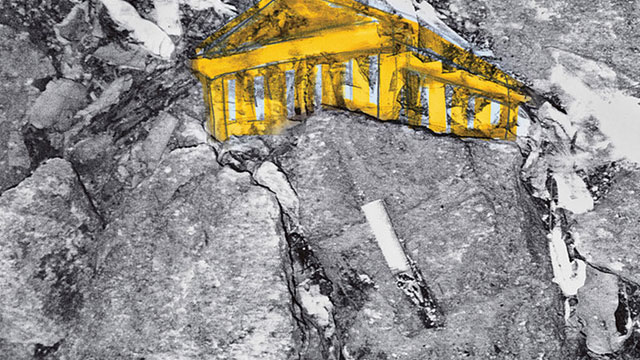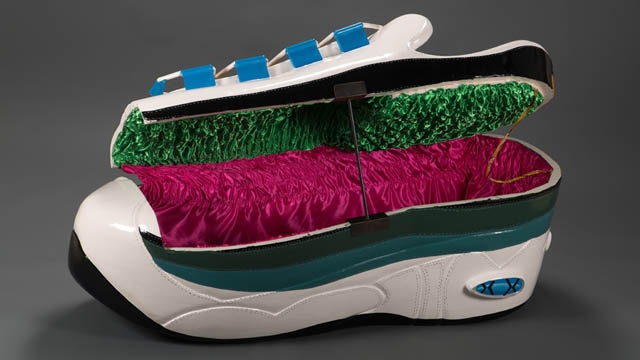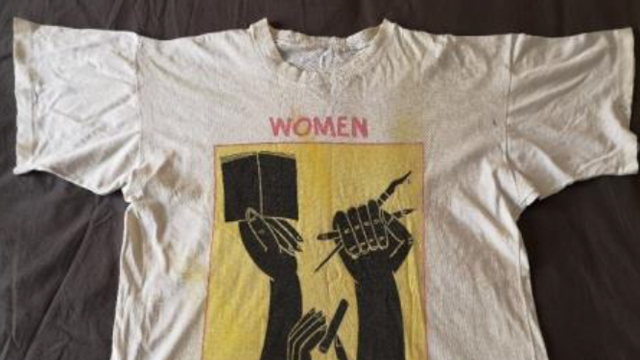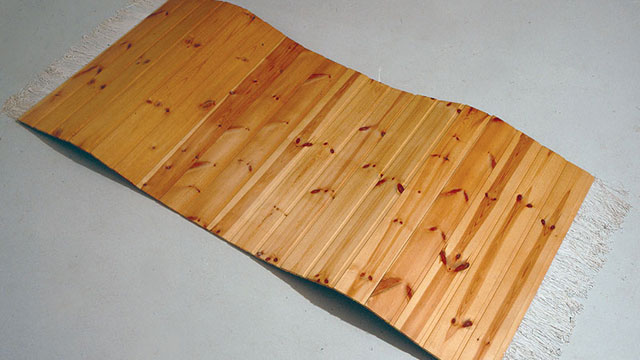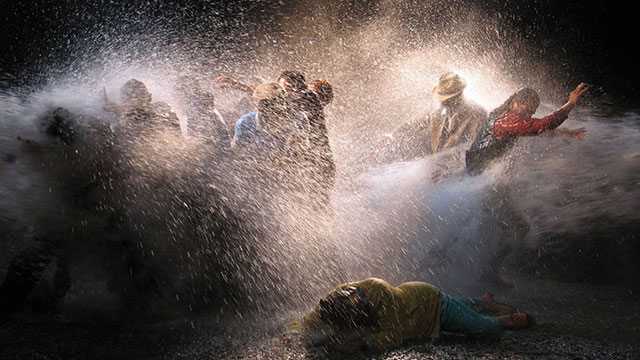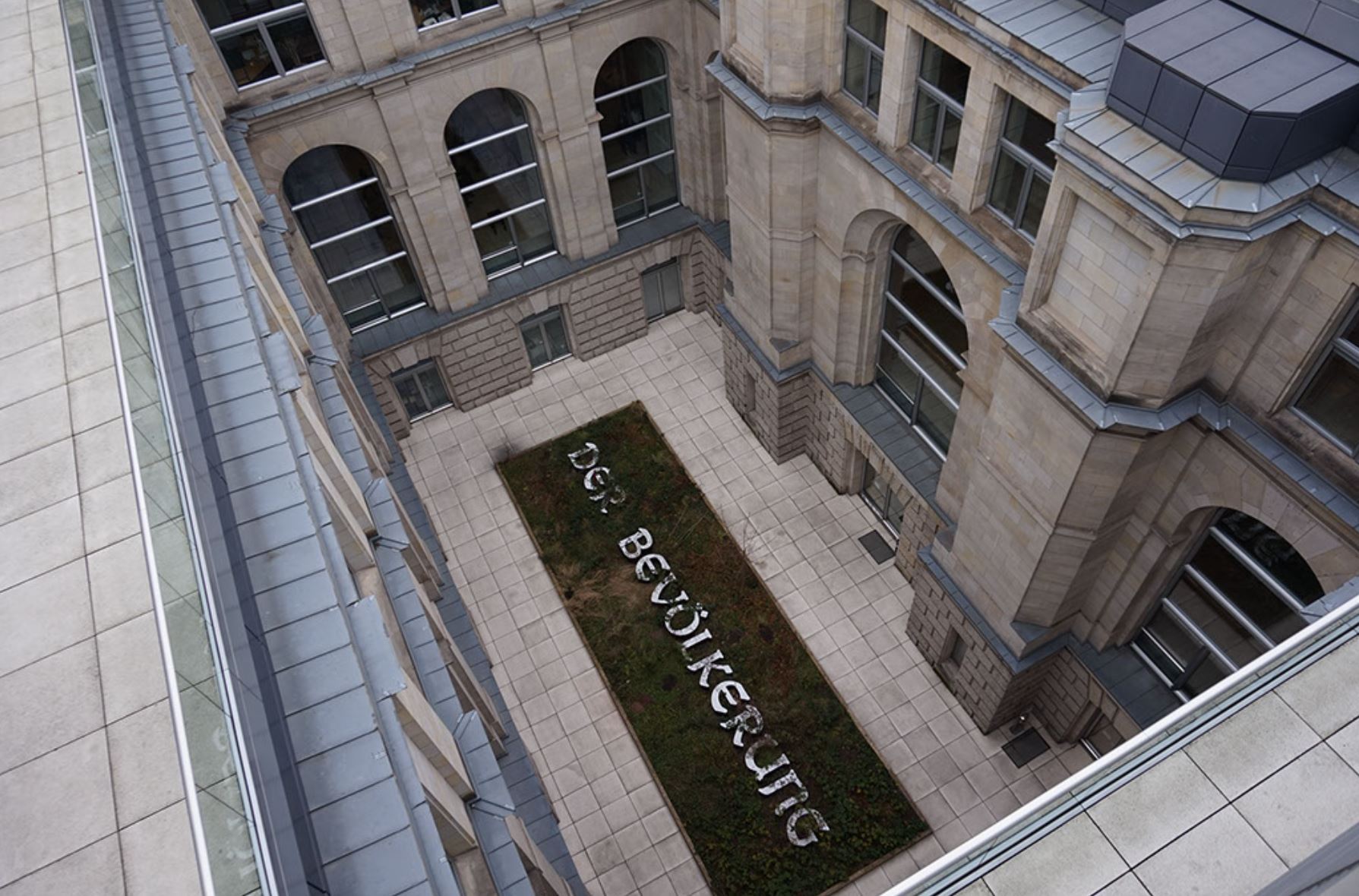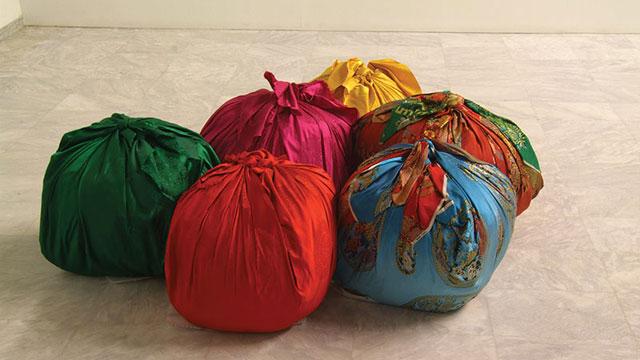Dear user,
This section of our website forms the heart of the EVC project. Here you find a collection of images of objects from different ‘visual cultures’. Our contributors selected and interpreted them in their respective contexts believing that these objects are particularly important for intercultural understanding across boundaries. Each time a user opens this page, the order in which the objects appear changes. In this way we hope to avoid a hierarchical understanding of the collected objects as their entries continue to be accessed in the long run. The constant changing face of the page also reflects the continuous expansion of the collection. As there are already over more than a hundred entries, users may want to form an overview, or to navigate through the growing collection according to their interests. For this purpose, we offer the following search options:

Filter: This enables you to search for objects according to time, place, keywords, etc. / Free title search: If you know the title of an object, you can find it in the free search field. / Lab: In the lab section, objects from the database are grouped under overarching themes. This is an ongoing project and about to be expanded extensively.
Enjoy exploring our database!
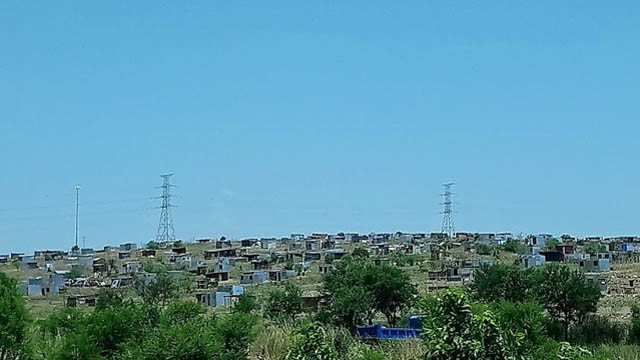
-
 Esther Kibuka-Sebitosi
Esther Kibuka-SebitosiIt is 25 years since South Africa achieved a democratically elected government in 1994. Nelson Mandela, who was imprisoned for 27 years, became the first black president after years of apartheid system governing the Republic. What is apartheid and what were some of the effects on housing? The Sustainable Development Goal 11 aims to make cities safe and sustainable; ensuring access to safe and affordable housing and building slum settlements into decent houses. It also calls for investment in roads, transport, creating green spaces and improving urban planning. This would envisage participatory planning and inclusive development. The image demonstrates the complexities of participatory planning and urban development in previously divided societies.
Historical perspectives
South African history can be divided into distinct phases: pre-colonial era, colonial era, post-colonial era, apartheid era and the post-apartheid era. During these periods, many different historic events characterised by violent clashes between the indigenous people and european settlers forcefully displacing them from their land occurred. The cultural differences were used to oppress and marginalise the people while racial tensions underlying the political oppressions were extensive. The shack is an object that symbolyses not only the oppression in living conditions, but also inequalities in economics and infrastructure.
Apartheid systems created shacks
Between 1948 and 1991, the system of administration in South Africa was apartheid. It was a National party system of racial discrimination and human rights violation. Fundamental to it was the Homeland Citizens Act of 1970, which augmented the Native Land Act of 1931 through the establishment of the so-called Homelands or reservations. The Act authorised the forceful removal of black people from urban centres to “Bantustans”. Surprisingly the apartheid perpetrators and sympathizers quoted a similar act in India where the British had done similar things without backlash from international community.
The typical Township in South Africa refers to underdeveloped segregated areas established from the 19th century until the end of the apartheid era to cater for non-whites namely Indians, “Africans” (meaning black) and people of colour. The Townships were located on the periphery of towns and cities. The Diepsloot Township in the image above therefore fits its purpose to serve the affluent towns because of its location along the highway.
The images show the shacks in Diepsloot Township. Close to 1.4 million people live in Diepsloot Township. Characteristically, such areas abound with crime, violent protests due to lack of basic services and overcrowding. The township is also full of diversity of culture, tribes, tradition and many nationalities, due to rural to urban migration. The major problems include unemployment, poverty and lack of basic services which result from lack of education and skills. Coupled with deprivation of water, sanitation and basic infrastructure, shack living environments are unsustainable and challenging sustainable cities.
In South Africa, the term “township” and “location” refers to segregated urban areas that arose from the late 19th century that were reserved for non-whites (Indians, blacks and people of colour). Built on the periphery of towns and cities, townships integrated the roots and systems of apartheid so deeply that they are almost difficult to eradicate. Despite strides made over the past twenty five years to provide decent housing for the majority of the population, Townships and shacks in particular still exist. As part of the mining industry, the black population comprising men lived in hostels and servants' accommodations. With increasing urbanization, the rapid urban expansion could not keep up with the influx of people which led to overcrowding. In the 1950s, townships in the Witwatersrand areas grew exponentially as the gold rush expanded. The shack township settlements were of poor quality but provided advantage over the hostels in more established areas as they were cheaper and not regulated by the apartheid government. With increasing eviction of black people from “white” areas, the forced removals resulted into a broad movement into segregated townships creating the designated race groups - black, coloured and Indians per the Population Registration Act of 1950 and the Group Areas Act.
With the fall of apartheid in 1994, the townships still persisted because it was a systemic problem that can only be solved in a multi-sectoral way. Typically, most towns in South Africa have a township associated with them. The New Democracy has created modern developments in townships since 1994 for example building wealthy homes and middle class income homes. In Soweto for instance there are many new developments. Hence "township" is changing its meaning and ways as it no longer means the original apartheid low income location but a home for the growing middle class. This has resulted in properties and real estate development in the townships. Although many houses were built inofficially, the government has improved the access to water, electricity and roads that impact on the quality of life. The biggest challenge is to make the progress sustainable. With plans to build the sewage system, water and electricity, townships are increasingly attract young people. As they belong to the generation of millennials, who want to stay connected globally, it is not surprising that the shacks in townships have connected to digital devices and satellite television, after all, the people have to live their life. A study in Diepsloot showed that 24% of the residents lived in brick structures, 43% in shacks and 27% in backyard shacks (additional units build on a plot of land by the landlord to get extra income (Harber, 2011).
Summary
The shacks are small constructions built on the periphery of towns and cities to provide cheap accommodation to the growing number of people working in towns or cities. The discovery of diamonds and gold in the 19th century in South Africa had a profound impact on the wealth of the region, propelling it into world stage competition for industrialisation. This was a fundamental shift from an agrarian-based economy with effects on the people and society. Not only were conflicts between the “Boer” farmers and the British Empire created, but also conflicts among the black natives as the groups fought for control over resources of the mining industry. These fights continued to define the mining industry for years and years. One sphere impacted was the human settlements. Between 1948 to 1994, the country was dominated by Afrikaner nationalism led by systems of racial segregation and a white minority rule called the apartheid, an Afrikaans word meaning “separateness”. The blacks, Indians and people of colour were forcibly removed from their land into Homelands or townships. With increasing demand for housing, shacks provided a cheaper option close to towns and cities. With no basic services, the areas continue to challenge governments as they are in need of building sustainable cities and sustainable solutions.
Shacks remind us of the lived experiences of people wanting to create sustainable livelihood in the economy. Given the opportunity of a job in a town or city, the viable option would be to live in a shack that is cheaper than brick construction. The downside is the lack of basic infrastructure and basic services for the population who want to participate in the economy. The dual economy in South Africa comprises the affluent businesses listed on the Johannesburg stock exchange and the basic township economy. People who want to participate have to choose between living in a shack or to be excluded from economy. The contradictions of the creation of jobs without viable sustainable housing options leads to the perpetuation to the segregation. An extension of two cities - two economies. Shacks on one side of the highways and the affluent middle class on the other side. The images show the contradictions and frustrations of moving towards sustainable cities in a country divided by inequalities.
This phenomenon is not only a South African one, but known worldwide: In Brazil and Mexico there are also areas divided by inequalities of social, economical and recently technological divide.
References:
- Harber, A. (2011) Diepsloot, Jeppestown: Jonathan Ball Publishers LTD, 2011. 2011. 1-226. Print.
- Tinashe, P. (2014). We have a story to tell — Diepsloot youth: A quest for safe space and opportunities to earn a living. (PDF).
- Rosa Luxemburg Stating. p. 2. Retrieved 9 November 2018.
- Foster, D. (2012): After Mandela: The Struggle for Freedom in Post-Apartheid South Africa
- https://unequalscenes.com/alexandra-sandton Retrieved 22 Jan 2019
- https://www.google.com/search?rlz=1C1EODB_enZA550ZA550&tbm=isch&q=shacks+in+Townships+near+Lanseria+Airport&chips=q:shacks+in+townships+near+lanseria+airport,online_chips:apartheid,online_chips:gauteng,online_chips:apartheid+museum&usg=AI4_-kTUvSb-CcNIqEavZu8utwO5g7HbUg&sa=X&ved=0ahUKEwislenZooLgAhXUQxUIHeIRDOYQ4lYILSgC&biw=1025&bih=587&dpr=1, Retrieved 25 January, 2019.
published April 2020

-
 Stefan Eisenhofer
Stefan EisenhoferGodfried Donkor is now considered one of the most renowned British artists with numerous acclaimed solo and group exhibitions in Africa, Europe, North and Latin America, including "Around the world in 80 Days" at the ICA (London), "Pin Up" at the Tate Modern (London) and "Authentic/ Excentric" at the Venice Biennale 2001. His multimedia visual art practice incorporates collage, printmaking, photography, film and performance. He is joint founder of "AISS-Art in Social Structures" and has participated in a number of residency programs in Africa, Europe, the US, and the Caribbean. In his works, Donkor creates visual references to the buried and repressed relationships between "black and white", between the upper and lower classes.
Based on profound research, he tells multifaceted counter-histories that reveal the hidden principles of production and exchange in historical and modern societies. At the core of his work are questions about the stereotyping of black people and their reduction to their physicality - firstly in slavery, then in sport, in the fashion- as as well as in the sex industry. In his work "From Slave Ship to Champ" (1992), for example, the slave ship, contrasted with images of black boxers in classic prizefighter poses, becomes a kind of "womb" and „uterus“ of particular types of racism. In Donkor's work, the historical slave trade also becomes a metaphor for current degrading mechanisms of the globalised world and leads to the question: How far is it from slave ship to champion - is it very far, or not far enough?
He questions the supposed "neutrality" of stock market prices and statistics in his series "Financial Times", in which he uses the serious-looking stock market pages of this newspaper as a background and alienates them collage-like with black and white images or full-colour glossy magazine figures of boxers and African women.
"The black body“ as a commodity in Western culture is also the focus of his "Southern Vogue" series. He traces the ways in which women's bodies, in particular, were and are degraded into marketable commodities and how people were and are degraded into financial objects. Donkor's work has much to do with the fragile and ever-threatened dignity of human beings. He asks questions about victimisation and innocence, about the balances and imbalances of the world, but does not allow for one-dimensional quick answers. Rather, he creates not only alternative histories, but also alternative icons. In his "Browning Madonna", "Black Madonna" (2002/6) and "Birth of Venus" series, for example, he takes up Western pictorial motifs, "africanises" them and thus creates a field of tension between the elevation and exploitation of - not only black - women and men.
Donkor's conceptually multilayered works are often inspired by places that played an important role in the historical slave trade. The artist uses the architecture of these places and the goods that were and are produced there to refer to the social conditions and interactions that lie behind them. This is exemplified by "Once upon a time in the West there was lace" (2007), with which Donkor reflects parallels between modern day and historical slavery through cotton and lace in Nottingham (UK). The luxury good lace, that is still synomymous with this English city, stands for the lavish lifestyle of the elites of the 18th and 19th centuries and at the same time for the exploited manufacturers who were often forced to live in great poverty. Donkor links this status symbol with his horrific history, and at the same time refers to the exploitative mechanisms of the current economic world.
The location also plays a leading role in the performance/fashion/video installation "Jamestown Masquerade" (2004). The Ghanaian coastal town of Jamestown is one of the first communities to make contact with Europeans in the 18th century. In Donkor's work, this place now becomes an archetypal city for commerce exchange and a symbol of the cultural interplay between Europe and West Africa from the 18th century to the present. In this performance, Present day Jamestown becomes the setting for a masquerade of fashion and memory in which African performers wear English costumes from the 18th century and are accompanied by music by Handel and Mozart. In this way, Donkor also points out that the meeting of two cultures does not necessarily have to be destructive, but can also offer a great deal of creative scope for both sides.
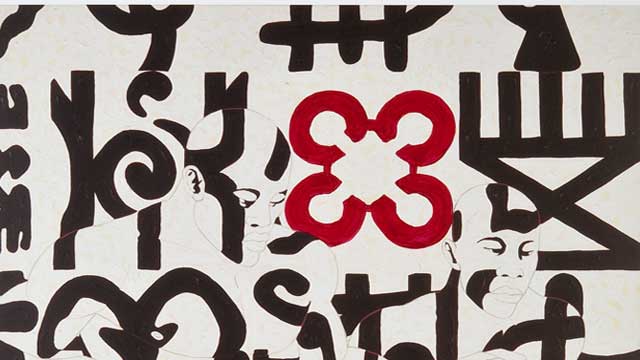
-
 Stefan Eisenhofer
Stefan EisenhoferOwusu-Ankomah received his basic training at Ghanatta College of Art in Accra. He was thirty years old when he moved to Bremen in Germany, where he still lives and works today. Characteristic of Owusu-Ankomah is his devotion to painting. For him the act of painting is a kind of highly concentrated ritual in which the medial properties of his body are used as memory store and energy-field generator, rather in the manner of an action artist.
In the course of his life, Owusu-Ankomah's artistic work has passed through several distinct phases. From an iconographic point of view, his early work is strongly influenced by mask and rock painting traditions from all over the African continent. But it was not long before human bodies, especially his own, became the dominant subject of his work. Naked bodies in his paintings, represented in idealized and naturalistic perfection, demonstrate a shameless and very close physicalness and often seem to radiate superhuman energy. Owusu-Ankomah plays here with the beauty of the human male body and with the harmony of flowing, clear lines. These works also evoke a range of ideas inspired by the human body – the body as instrument of the soul and instrument of communication, as a universal symbol and point of intersection between the physical and the metaphysical, and as a means by which the individual constructs himself, presents himself to others, and negotiates the conditions of his belonging to the world.
In his recent works up to 2008, the figures are covered with markings and signs. They originate from a variety of sources: the artist has combined traditional West African symbols, such as adinkra cloth signs, with symbols from China, America and Oceania, well-known popular logos, and symbols of his own invention. The figures melt into the backgound which consists of the same symbols, and thus become almost invisible.
With these symbols and human figures that compete for space on the canvas and for the attention of the viewer, Owusu-Ankomah has created some highly dynamic and truly pulsating compositions. The works also raise questions concerning self-determination and heteronomy, the tension between the wisdom of collective worldviews and individual creativity, and the personal potential of the individual. This is particularly striking in works showing the Sankofa bird. This mythical bird is well known in large parts of West Africa and embodies the concept of "flying forward while looking back". It symbolizes the idea that one should remember the past in order to shape one's life positively in the present and the future. With its name meaning "go back and pick", the bird also stands for one of Owusu-Ankomah's guiding principles: to look for useful traditions in all parts of the world. Accordingly, Owusu-Ankomah borrows a great variety of elements from very different cultures and periods in his works. He is influenced by adinkra symbols, together with their worldviews and philosophies, but also by Michelangelo, video games and designs by popular contemporary graphic artists. In his ambition to unite elements from very different regions in one great human universal, his works become something that overcomes the borders separating individual cultures. In his search for an existential utopia, he creates a symbiosis out of these heterogeneous elements in fantastic and futuristic spaces. Thus he aims at a common "world consciousness" and global visions of the establishment of universally longed-for values, such as harmony, solidarity and non-violence.
An interpretation of an early work by the artist from 1975, "Deer Hunt", can be found under the following link.
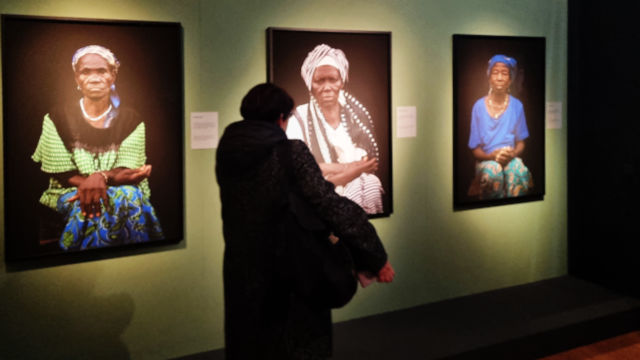
-
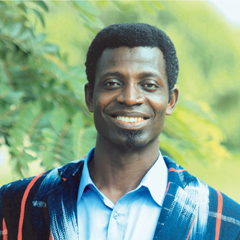 Osuanyi Quaicoo Essel
Osuanyi Quaicoo Essel‘Witches in Exile’ Exhibition at Museum Fünf Kontinente: Advocacy or cultural exploitation?
In June 2024, Museum Fünf Kontinente, located at the heart of Munich, held an exhibition themed “Witches in Exile.” This exhibition dwelled on the photodocumentary of German-French artist Ann-Christine Woehrl and her African collaborator Senam Okudzeto. The duo visited Gushiegu and Gambaga townships in North East, and Northern regions, respectively, and other parts of Ghana between 2009 and 2013 for the said portraits of women alleged to be witches. The exhibition attracted approximately 12,000 visitors during its run and extended its original closing date due to public interest. This article analyses the cultural and ethical issues the exhibition raises and questions the motives behind it.
In some Ghanaian communities, the accusation of witchcraft is rooted in certain cultural beliefs and practices. The practice of witchcraft and sorcery is part of indigenous Ghanaian customary practices. Article 26(1) of the 1992 constitution provides that ‘Every person is entitled to enjoy, practice, profess, maintain, and promote any culture, language, tradition, or religion subject to the provisions of this Constitution.’ This clause implies that Ghana has cultural pluralism and does not suppress any indigenous culture. However, the constitution disapproves of any cultural practices that diminish people's dignity and dehumanise them. With regard to the practice of witchcraft, there are reports of people accused of witchcraft across Ghana who have experienced witchcraft-related violent attacks, stigmatisation, banishment, and in some cases threats to their lives (Actionaid International, 2012; Musah, 2013; Roxburgh, 2016; Badoe, n.d.). Some communities in northern Ghana have established safe havens for individuals accused of witchcraft. Scholars and actors have found that the witch camps are not ‘prisons’ but rather served as refuge for the alleged witches and wizards (Mutaru, 2018; Musah, 2013; Actionaid International, 2012).
Subsequently, there have been governmental efforts to legislate against the practice. Article 26(2) of the 1992 constitution of Ghana provides that ‘All customary practices which dehumanise or are injurious to the physical and mental well-being of a person are prohibited.’ In line with this constitutional provision, there is a bill in parliament under consideration. Apart from that, the Ghanaian society largely condemns instant justice and frequently calls on security agencies to bring culprits of violence against people on the basis of alleged witchcraft to book.
The Museum Fünf Kontinente disclosed on its website that showing the ‘Witches in Exile’ Exhibition was based on the political brisance of the topic in Ghana and the critical discourse in the country about witch hunts and the closure of the ‘witch camps’ (Museum Fünf Kontinente, 2024). On the contrary, the exhibition seems to have an ulterior motive of perpetuating the neocolonialist agenda of painting a grotesque image of Africa’s Ghana to prolong its imperialist and neocolonial domination. This has been the colonialists’ style of framing Africa to a global audience (Nkrumah, 1963). There are ethical contradictions that reveal the negative intent of the museum in showcasing this exhibition. Both the artists (Ann-Christine Woehrl and Senam Okudzeto) and the museum, in my view, flouted ethical standards and made the alleged women witches less dignified in the eyes of right-thinking people in the society. The way the exhibition was framed ran the risk of sustaining the very injustices it was claiming to eradicate. The photographs reduced complex socio-political crises, which have their roots in poverty, gender violence, and colonial legacies, to personal spectacles of suffering by isolating the women as symbols of "resilience." Instead of placing the structural factors that allowed their persecution in context, this strategy strengthened the stigma associated with being a "witch," enshrining their identities within a victim narrative. Under Ghanaian law, such an exhibition frowns upon the dignity of the women. It would not be tolerated, most especially for an educative institution such as a museum charged with the mandate of educating the people in a constructive way. Showing such an exhibition would be an affront to Ghanaian cultural standards.
Woehrl experienced trust with those women who participated, transitioning from "stranger to confidante"; nonetheless, there was a lack of proof of sustained consent for the worldwide museum exhibition. A question that begs for a response is: Were the women informed that their photographs taken under the guise of NGO work and support were going to be exhibited in a European museum? Since they are not illiterates, was it explained to them in the language they understand? Once the women's photographs were turned into art, they were curated by Europeans. This is similar to how colonial powers objectified marginalised bodies for Western viewers, depriving the women of control over their portrayal. Showing the women's photos in Munich, which is far from Ghana's legislative battlegrounds, turned their suffering into an exhibit that others could buy. The museum's focus on their "isolation" and "pride" ironically made them more likely to be accused of witchcraft.
The artists' claim to "give voice" conflicted with its power disparity, with a European photographer and a diaspora artist (Okudzeto) articulating African suffering for mostly White audiences. The museum's past as an ethnological institution that helped with colonial objectification made this situation even more awkward. Although the museum included West African perspectives, the primary location of the exhibition in Europe emphasised a Western viewpoint, transforming injustice into an artistic experience.
When you think about whether the photographers would put their families through the same thing, their humanitarian rhetoric does not hold up. It would be difficult to imagine showing a mother's anguish to people across the world without knowing that she would be able to go back to society or have influence over how she is seen. This contradiction highlights a more serious moral failure; the women have less freedom in the name of "awareness." The exhibition's legacy is yet unclear. Did it provide the women more authority, or did it make them feel like they were always exiles, stuck in Munich's galleries as symbols of "woe"?
Understanding the customary practices helps us understand the cultural and social contexts and the efforts of Ghana’s government to curb them through legislation. The practice of witchcraft and sorcery remains one of the cultural beliefs in Ghana. The phenomenon has attracted increased research interest in the quest to understand, reinterpret, and question the practice of keeping ‘witchcraft camps’ for alleged witches and wizards. Musah (2013) explored the experiences of the fifteen alleged witches, comprising thirteen women and two men resident in the Gnani witch’s camp in the northern sector of Ghana. The study revealed that the camp serves as a refuge for the alleged witches and wizards and not a ‘prison’ as perceived by the public. Their thoughts of the witch camp as a haven of refuge are owing to the fact that they face being stigmatised and attacked, which puts their lives in danger even after being exorcised and cleansed from alleged witchcraft as demanded by indigenous cleansing and ritual. For these reasons they remain in the camp instead of going back to their original communities.
Yaba Badoe (n.d., p. 95) shared the obstacles encountered in the documentary film The Witches of Gambaga. Badoe questioned the ulterior motive of some Western broadcasters and scholars in portraying issues of fighting alleged women’s witchcraft issues in Ghana, saying that though their Witches of Gambaga documentary was situated in the broader context of the women’s movement in Ghana and its ongoing campaigns to expose and stop all forms of violence against women, Western-based broadcasters had negative agendas and priorities. The obstacles included the complicated politics of representation in and beyond contemporary Ghana in the context of reproduced images that were given currency by ‘Western-based broadcasters, who operate according to their priorities and agendas, not those of African feminists experimenting with the media they have dominated for so long.’
"Witches in Exile" effectively illustrates the delicate balance between documentary art and ethical infringement. It by no means mobilised people to support Ghanaian women and for legislative purposes as it claims; rather, its techniques have made the dehumanisation it spoke out against worse. The photographers' insistence on "resilience" did not address the fundamental injustice of converting real individuals into artefacts for European consumption, so perpetuating their marginalisation under the pretence of solidarity. In addition, the bodies of the women with exploited in the name of exhibition for financial gains. As the pictures grace the museum, the women's consent, dignity, and healing remain in the shadows.
Published August 2025
References
- Actionaid International. (2012). Condemned without trial: Women and witchcraft in Ghana. Actionaid.
- Amuzuh, J. (2021). Report on alleged witches’ camp in Ghana – June 2021. The Sanneh Institute.
- Badoe, Y. (n.d). Representing Witches in contemporary Ghana: challenges and reflections on making the ‘Witches of Gambaga’. Feminist Africa, 16, 82-97.
- Mutaru, S. (2018). An anthropological study of ‘witch camps’ and human rights in Northern Ghana. In Green MC, Gunn TJ & Hill M (eds), Religion, Law and Security in Africa. Stellenbosch: Conf-RAP.
- Museum Fünf Kontinente (2024). Witches in Exile. Photographs Ann-Christine Woehrl.
- Installation Senam Okudzeto. https://www.museum-fuenf-kontinente.de/ausstellungen/r%C3%BCckblick-auf-unsere-sonderausstellungen/witches-in-exile-english/
- Musah, B. I. (2013). Life in a witch camp: Experience of residents in the Gnani witch camp in Ghana. (Mphil Dissertation). Universitas Bergensis.
- Pierre, S. (2018). Human rights violations and accusations of witchcraft in Ghana. 6(1). McGill Centre for Human Rights and Legal Pluralism.
- Roxburgh, S. (2016). Witchcraft and violence in Ghana: An assessment of contemporary mediation efforts. Cahiers d’Études africaines, LVI (4), 224, 891-914.
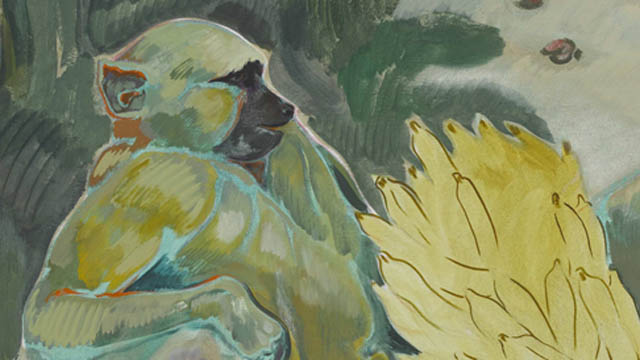
-
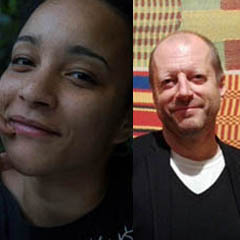 Leonie Chima Emeka & Stefan Eisenhofer
Leonie Chima Emeka & Stefan EisenhoferBorn 1984 in Nairobi (Kenya), Armitage received his artistic training in London (UK). Living and working in both places today, he praises each of these cities as substantial to his creative practice. His inspirations spring from many different sources – from political events, mass media affairs and pop culture to personal memories and experiences as well as from Eastern African and European folklore. He merges together the stories and experiences of two cities and weaves them into a narrative of interregional interest. Often starting with Kenyan local myth he is developing global tales of political critique and rebellion concerning global demands on democracy, data protection, ecological and human rights — always overlaid by the meaning of the break between the “West and the Rest”, between human and un-human, between the exploitation of life and its inviolable dignity. In his work, Armitage investigates the idea of Africa as a mirror for Western phantasies and success stories of the Global North: the wild and untamed nature on the one side and the violated racialized bodies and political and ecological catastrophes on the other.
The painting “Baboon” was on view in the exhibition "The Paradise Edict“ at Haus der Kunst in 2020 as part of a series of five oil paintings depicting tropical animals. On tropical background various monkeys in erotic posture invite the viewer to an examination of sexuality at the boundaries between animality and humanity, erotics and exotics. Also the “Baboon” strikes the eye with its suggestive sexuality. In the clearing of an overgrown rainforest, the monkey lies on the ground in a very human attitude. A bare stone supports its right arm as if the ape was resting on a natural chaiselongue. Within the apparently wild environment, the animal seems rather cultivated.
The baboon oscillates between human and animal; not only in its posture but also in its physique: Feet and face are animal, while the rest of its body looks almost human; it has no fur or hair but pronounced muscles on his bare chest. Despite its muscles the ape’s body looks youthful and slightly lanky. It reminds to Michelangelo’s David for which it is commonly known that the legs and arms are extra-long compared to his body in order to mark his youth. Like a juvenile not yet fully grown the baboon, too, has long arms and legs. Neither a child nor yet a man, both an ape and a human body, the baboon hovers between child and man, between man and animal, between innocence and animal sexuality.
Instead of the characteristic fig leaf of early modern European sculpture, there is a large bundle of bananas between the monkey's legs. The individual bananas, sketched on the yellow surface, are quite phallic in shape and the banana bundle tends to overemphasise the male sexual organ, while the ape’s physical penis is hidden behind it. The banana is probably the most common fruit in the Global North that still bears the tag ‚exotic‘. It is not the monkey’s body, that is sexual; but the bundle of bananas both hides and emphasises the phallic and states an allegory for the conceptual connection between exotic and phallic.
Its absence makes it ever more present, as its leaves the concretisation of sexuality to the viewer’s imagination. In fact the image could be both innocent or sexual, as not only the penis is hidden behind the bundle, but also the ape’s left hand that reaches out to his underbelly. We can not see, but only guess where it rests, and what it is doing there. In his suggestiveness Armitage opens a space of confusing erotic tension and a critique of the sexualisation of race. With the figure that hovers between youth, man and animal, Armitage challenges the relations between black masculinity and sexuality in the Global North. It was Franz Fanon in "Black Skin-White Masks“ (1952), who once posited, that in European Subconscious "the Negro“ is the genitals par exellence, reduced to a giant penis. In this painting Armitage investigates the complex relations between blackness and phallus in Western concepts of masculinity.
Like many of Armitage’s paintings also the “Baboon” presents an overlay of heaven and hell and is taking up the title of the exhibition “Paradise Edict”. They are referring to African and European as well as global paradise fantasies and hopes. They are aiming often at an ordered, decreed and prescribed paradise. They reveal the mandatory and obsessive aspects of these Garden of Eden-Imaginations, disillusioning global Out-of-Africa-fantasies, distorting eternal and natural laws to man made illusionistic laws.
Armitage uses lubugo, a fabric made from fig-tree bark, in lieu of canvas for his paintings. This cloth is Ugandan in origin and has a long history of social, religious and political meaning and use there. Armitage first came across lubugo in 2010 on a Nairobi tourist market. The use of this now somewhat Pan-East-African-material corresponds with his visual vocabulary. Armitage combines European with Eastern-African materials, forms and strategies and waves them into complex, yet alluring compositions that remember the entangled history of painting through the ages and continents and rewrites new relations in between.
published January 2021
About Michael Armitage's initiative in Nairobi "Nairobi Contemporary Art Institute (NCAI)" see Link.
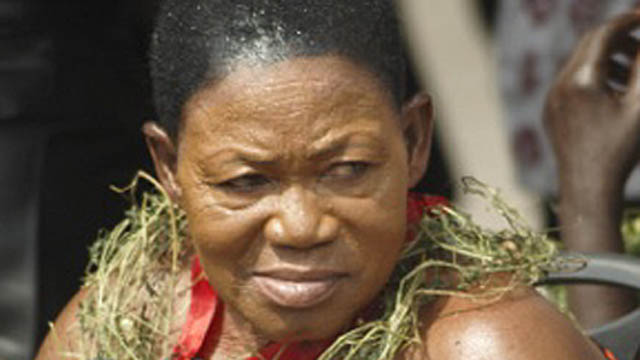
-
 Osuanyi Quaicoo Essel
Osuanyi Quaicoo Essel
Africans, including Ghanaians, had their peculiar way of life long before they encountered the colonialists. They had a robust governance structure (kinship system), laws and standards of beauty inherent in their beauty culture practices. The African society was orderly organised to the extent that there were minimal deviants. They had built no prisons for offenders, rather, their sense of communalistic living and religious practices shaped their modest way of life. Based on their customary laws and taboos, offenders atoned for their wrongdoings through rites and rituals which were enough corrective measures. In some cases, the corrective stigma associated with particular wrongdoing was enough deterrent to possible offenders. For example, someone who stole a bunch of plantains was made to carry the plantain on the head, and matched by multitudes through the streets of the community, announcing the offenses s/he has committed. Sometimes, offenders were sent to the chief palace for settlement of the case. The society was so organised and cultured to the extent that when the community became aware of the wrongdoing of an offender, s/he may not find a spouse or suitor in that community. Before arranging for marriage, the families of both parties engaged in serious investigation about the socio-moral backgrounds of both suitors regarding their behaviours in and outside the community. When a suitor had criminal records, the family of the suitors disallowed such a marriage. In personal communication with M. Opoku-Mensah (12th June 2020), he referred to a purported address of Lord Macaulay to the British Parliament on 2nd February 1835 which confirmed what pertained in precolonial Africa. Lord Macaulay reportedly said:
“I have travelled across the length and breadth of Africa and I have not seen one person who is a beggar, who is a thief such wealth I have seen in this country, such high moral values, people of such calibre, that I do not think we would ever conquer this country, unless we break the very backbone of this nation, which is her spiritual and cultural heritage…”
Just as any society, this statement suggests that Africans also had the way of life, including the standard of beauty and makeover practices.
Precolonial Ghana, as in the case of other Africans, held in high esteem their indigenous beauty culture standards. They held a complex standard of beauty embodied in their ‘Afrocultural aesthetics’ (Essel, 2017, p.25). Afrocultural aesthetics has to do with the conceptual and contextual hybridity of aesthetics that celebrate ideas expressed in artworks (Essel & Acquah, 2016) and the intended purpose of art, be it functional, symbolic or decorative. A work of art is considered good or beautiful once it served the purpose for which it was done. This implies that beauty is judged in context as well as the concept. The Afrocultural aesthetics also apply to the beauty culture practices of the people. One of the beautyculture practices precolonial Ghana held high was hair grooming aesthetic ideals. Hair occupied a central position in the scheme of social standing to the extent that it sent a message about the status of its wearer to the audience who understand such a language. One could differentiate a married woman from the others based on her hairdo in Ghanaian society. Hair was treated with natural hair softeners, conditioners, colourants, and accessories such as comb. Special combs that helped the people to keep the hair in good shape were fashioned by sculptors from wood, bones and metal. The combs were artistically shaped with symbolical essence just as the hair itself. What the precolonial African society did not do was to stigmatise the hair type and texture of their fellow Blacks.
The advent of the slave trade, colonialism and Western education began to sew the inferior seed of black hair stigmatisation and discrimination. Gradually, this ‘inferior seed’ (Morrow, 2014) sewn has entered the educational institutions which should be the agent of change, centre of Black consciousness, character reformation centre and panacea of pan-Africanism has rather turned into Afrosaxons colonialist surrogates perpetuating Afrocentric hair stigmatisation against their educands (Essel, in press). In the effort to decolonise the bastadised and proscribed Afrocentric hairstyle practices in Ghanaian schools, this article explores the conflicting tensions in the process on the part of the school authorities, students and the parents.
Decolonisation theories is central to this study. There exists different perspective on the subject matter of decolonisation. Some have looked at it from Euro-American perspective while others argued that the process remains incomplete when it is one-sided instead of two-sided, that is, looking at it from the perspective of the colonised and the coloniser. On this path, Wenzel (2017) examined the multiple objects and aspects of decolonisation namely, political economy, epistemology, culture, language and nature, and theorised that there exists unevenness and incompletion of the decolonisation process. By studying the various roles played by the colonisers, anti‐colonial nationalists, and Cold War superpowers in decolonisation, Wenzel (2017) observed that postcolonial independence did not necessarily bring national liberation. This liberation in my view includes mental emancipation, and redefinition of Africanness, believing in
ourselves.
In the encounter of the colonialists with the colonised, the former has painted monstrous and negative perceptual image about the latter which has affected the way of life of the latter.The colonialist projected their standards of beauty and art to the colonised and spoke ill of that the colonised to retard social progress and prolong colonial domination of the latter (Nkrumah, 1963).By so doing the colonialists’ beauty culture standards have been ingrained and practised in academic institutions and everyday life and has seeming override indigenous beauty culture standard of the colonised. In line with this, the decolonisation concepts that guides this study is that, the African needs to be measured by his/her cultural beauty standards that does not breach the fundamental laws of his nation or state. The African must gain national cultural consciousness and must not be necessarily be measured with the standards of the colonialist (Nkrumah,1963; 1964). Before the Black Hair Stigma in Precolonial Ghana There are different types of hair ranging from type 1(a, b, c), 2(a,b,c), 3 (a, b, c) and 4 (a, b, c). The types were classified according to the straightness, waviness, curl patterns and kinky look. Hair may also be described in terms of its texture, density, porosity and colour. These characteristics of hair
differences may manifest in individuals, groups, society or race. Despite the differences in hair type, all people of the world belong to one race, that is the human race (Elliot, 2016). Even among Blacks, there are differences in hair type. Precolonial Ghana was made of different ethnic groups of which the Akan were the majority. Though they were of different ethnicities, they did not discriminate against each other on the basis of their hair type or hairstyle. The people wore different hairstyles based on their ethnic affiliations, beliefs and practices, social status, and to celebrate events such as festivities and or funerals. Sometimes the hairstyles were worn for art sake. The hairdos had performative importance, semiotic power, and engendered identity. For
example, queen mothers wore a kind of hairdo named dansinkran (Figure 1) known for its iconic stature amongst the chiefdom.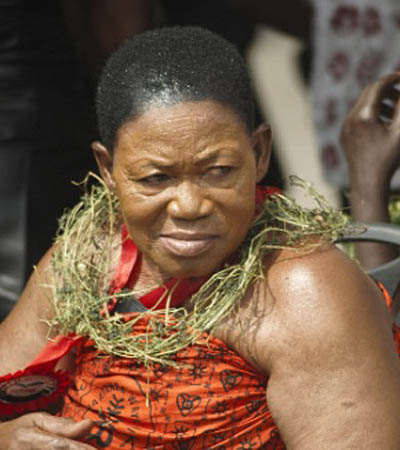
Figure 1: A woman wearing the dansinkran hairstyle. (Image courtesy: Godhit, 2017).
The hairstyles of the people ranged from natural dreadlocks popularly called rasta (known in Akan language as mpɛsɛmpɛsɛ), Afro, braiding, plaiting, shaving and African wigs. Though the word rasta is regarded more as a Jamaican phenomenon, mpɛsɛmpɛsɛ (which was named rasta) existed in some parts of Africa including Ghana in precolonial times. Some were born with the rasta. People born with rasta were considered by society as special beings, for that matter sacred. Apart from that, some priests and priestesses wore dreadlocks or afro. Cowries were placed in the rasta or afro hair of some priests and priestesses for symbolic, decorative, religious and ritual purposes. In this article, the term rasta is used in the context of both natural and artificial dreadlocks in precolonial, colonial, postcolonial and contemporary times. Again, the term Afro was introduced in the 1960s in reference to African American grown hair. From this word came Afrocentric. It is worthy of note that the enslaved Africans who were taken ashore had relatively long and grown hair. This was one of the hairstyles associated with males in precolonial Africa. The colonialists negatively described that hairstyle as bushy. Meanwhile,the long hair of the colonialists did not merit such a negative description. Till now, the term bushy hair connotes an offensive description of overgrown African hair. Many young Ghanaian people would prefer the term Afro to mean fully-grown hair than to describe their hair as bushy. Though the term Afro emanated from the US, the hairstyle was long in practice in many parts of Africa.One could differentiate between a maiden and a married woman just by looking at the hairstyles they wore. The people also used natural hair treatments that conditioned and softened it to keep it in good shape. The Akan often said ɔbaa n’enyimyam nye ne tsirhwin which literally means ‘The glory of a woman is her hair.’ This expression underscored why women in precolonial Ghana cared so much about their hair. They spent a great deal of their time in pursuance of their hair beauty culture practices. During puberty rites, female adolescents are given special education on hygiene, good grooming and hair beauty culture practices and treatments because of the premium society placed on the hair. Consequently, hair became a significant communicative symbol used to express moods such as bereavement, joy; and in some cases, power and authority. For example, a male child who lost his father, mother or close relation cut the hair down to the skin (Figure 2). He appeared hairless on the head as a sign of bereavement. Some Akan female adults wore a hairstyle called takua, done by holding the hairs together atop the head and with thread to stand upright. To them, such a hairstyle is design-less and simple in paying homage to the dead.
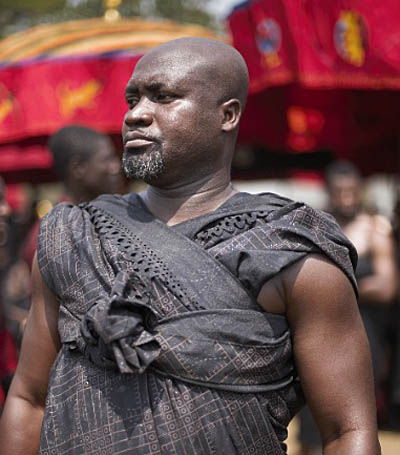 Figure 2: Man with hair cut to the skin as a signal of bereavement. (Image courtesy: Godhit, 2017).
Figure 2: Man with hair cut to the skin as a signal of bereavement. (Image courtesy: Godhit, 2017).Slave Trade, Colonialism and Western Education in Black Hair Stigmatisation
Precolonial Ghana had its own well-established form of education, evolved by the people themselves (Sampson, 1932; Essel, 2019) before their encounter with the colonialists. They trained the young ones through a rigorous enculturation process and apprenticeship system. They passed on the artistic culture and way of life from generation to generation through the robust apprenticeship system which is formal education and training (Essel, 2019). Training of the young ones was the duty of the immediate and extended families as well as other people in the community. It was for this reason that the precolonial society was described as living a communalistic life. In personal communication with M. Opoku-Mensah (12th June 2020), he referred to a purported address by Lord Macaulay’s to the British Parliament on 2nd February 1835. Macaulay had found that the people had strong cultural institutions that rule their socio-moral lives. In the said statement as pointed out by M. Opoku-Mensah (12th June 2020, personal communication), Lord Macaulay said to the British parliament:
"I propose that we replace her [Africa’s] old and ancient education system, her culture, for if the Africans think that all that is foreign and English is good and greater than their own, they will lose self-esteem, their native culture and they will become what we want them, a truly dominated nation."
Macaulay’s statement was recognition of the plausibility and relevance of the precolonial form of education that catered for the good socio-moral upbringing of the people which seemed impervious. As he suggested, the way forward was to introduce their culture including the language and beauty standards which they did, and used the slave trade, colonialism and Western education as a weapon to achieve their malevolent ideological and social-imperialism agenda. With the advent of Western education in the 1500s, learners with afro and rasta were asked to cut their hair before they were permitted to enrol. Afro and rasta hairstyles were considered unkempt and cutting them signalled cleanliness. The Euro-Christian churches planted in precolonial Ghana also asked new Black converts with rasta or afro to cut them as a sign of born again. The mission schools also proscribed
these hairstyles. In the name of religion, this practice continuously ate into the social-moral fabric of the society, especially, amongst the so-called Christian elite. In effect, this gradually contributed to afro and rasta hairstyles’ stigmatisation (Alhassan, 2020; Whiteman, 2010, Whiteman, 2007)). Those who wore these hairstyles, especially, the middle-class males and adolescents, were perceived as rascals, vagabonds, smokers, and unclean.
Based on rereading of scholarly information and archival sources on Black hair, interviews and focus group discussion as a method of data collection, the study provided insight into the hair decolonisation process in Ghanaian Senior High Schools and the conflicting tensions associated with the process. The focus group consisted of Senior High School teachers with more than five years of teaching experience at that Senior High School level. Descriptive and explanatory case study designs constituted the research design for the study. The descriptive aspect was for the purpose of describingthe phenomenon (the ‘case’) in its real-world context while the explanatory case study aimed at explaining how or why some condition came to be (Yin, 2018).A sample of twenty-eight (28) participants consisting of heads (2), teachers (20), and students (6) were purposively sampled from the accessible population of fifty (50). Simple descriptive analysis formed the method of analysis. To ensure the confidentiality of participants, pseudonyms were used to conceal their identity.
Conflicting Tensions in Black Hairstyles Decolonisation There have been reports of discrimination against the hairstyle of Black students in and outside Africa. During the 2015 West African Senior Secondary School Certificate Examination (WASSCE), three students of the St John’s Wesley Grammar School, Accra, Ghana were disallowed to write because they were wearing afro hair (Citifmonline.com 2015). In 2016, there were students protest in South Africa that questioned discrimination against African natural hair in class (Mwaura, 2016). Perry (2019) also reported Black hair stigmatisation which she sees as a vestige of segregated past that deemed blackness inferior and the emulation of whites as the route towards assimilation. This discriminative happening tells that black hair stigma persists in Africa even after colonialism. With the school as an agent of enforcing colonialists’ legacy of anti-Afrocentric hairstyle practices in primary, junior and senior high schools, specifically, rasta and afro, the practice
has become deep-rooted to the extent that attempt by parents and learners to question it proves futile. Students are not happy with the enforcement, and at some point in time prove adamant to school authorities. Mirekua narrated her story:‘I attended primary and Junior High School at Opah Municipal Assembly School from 2009 to 2012. There was a time I had to hide under my desk to avoid being sacked by the headmistress. I was given a warning at the assembly grounds to go and barb my entire hair. In my second year in Junior High School, I was told to go home and barb my hair because it would hinder me from taking part in the Basic Education Certificate Examination. I stayed home for a week because [after I cut my hair for] the fear of being mocked by friends seeing, as it was my first time of having a down cut.’
Mirekua’s accounts reveal the feeling of uneasiness and low self-esteem she developed as a result of being reprimanded to cut her long hair. Her hair was cut because she must be in school or face sacking sanctions. Students who go contrary were labelled as bad or stubborn. Maame Esi, was a student in a Senior High School in the Western Region of Ghana. She completed in 2014. She confessed that she complied with the rules and regulations governing hair beauty practices in her school because she feared being suspended, sacked or disgraced at the assembly grounds of the school. Not complying with the dictates of school authorities on hair in itself is a stigma. The enforcement of these anti-Afrocentric hairstyles has been internalised to the extent that some members of the society may cast aspersion on those who wear such hairstyles. A male participant said his best friend was
advised by the parent to Part Company with him because he left his hair to grow long. ‘My grandmum told me to keep my hair… One of my friends developed a cold attitude towards me afterward. When I asked, he told me that the parents have asked him to keep his distance from me because… I have become a bad boy. Only bad boys leave their hair without cutting it’, he said.
These vignettes of the students revealed that students kowtow to the hairstyle enforcement to avoid negative labelling by the school authorities and their own colleagues. There were others who also left the public school to attend a private school who were lenient with Afrocentric hairstyle restrictions. In a focus group discussion among 20 Senior High School teachers drawn across eight regions of Ghana, the issues that emerged were that students who wore afro and rasta are perceived as deviants and ill-mannered people who do not abide by the rules and regulations of the school. This is because the school proscribes wearing of these hairstyles. To
the teachers, students appear as adults when they wear afro and rasta hairstyles which do not distinguish them from the teachers. Succinctly put, ‘They appear like mothers and fathers’ than students in those hairstyles. In addition, they argued that wearing such hairstyles in school generates competition amongst the students as they may strive to put up flashy hairstyles and put little or no concentration on their academic work. As a result, they only permit students to wear rasta or afro on health and religious grounds. As explained earlier, hairstyles have religious implications in Ghanaian society. For example, afro and rasta have a strong affinity with African Traditional Religion, which is the authentic religion in precolonial Africa. A teacher explained that: Well, from my little knowledge, I know that … priest and priestesses do not barber. Secondly, some students have soft scalps making it easy for them to catch cold anytime their hair is down. These categories of students could be allowed to wear dreadlocks or afro to school. A teacher who aligned to the Christian faith perceived these hairstyles as unacceptable. He said, ‘My religious background wants us to have a close [hair] cut as a Christian man.’ The teachers said the culture of the school does not allow afro and rasta. So, they normally use scissors on students’ hair. They also admitted asking students to go and shave their hair but when the students refuse, they sacked them from the examination hall or class, since they were not ready to shave their hair without any tangible reason. Students who wear afro are perceived as ‘weed smokers’. On the contrary, four of the teachers argued that wearing afro or rasta is normal since it
borders on individual differences, and generally accepted in Ghanaian society. The issue is that these hairstyles become unacceptable when worn by students at the primary, junior and high school levels.
In response to the question of rules and regulations regarding hair beauty culture standards of students in public schools, a teacher said:What happens is that the housemasters, housemistresses, and some teachers on duty often send scissors to the various classes or examination halls to give students awkward hair cut against the will of the students to force them to shave their grown hair. This is
a kind of punishment given to the students for leaving their hair to grow. Some students, out of pain and dislike for such treatment, leave their hair in its awkward form as done by the teachers. Such students are often refused access to classes or examination
halls; canned, suspended or asked to weed as punishment. Students comply in order to take classes or
examinations.One of the participants has taught in five schools covering primary, Junior High School and Senior High Schools, with twenty-four years of teaching experience. She has taught in Ashanti and Central regions of Ghana, and currently a headmistress of a Senior High School. She opined that:
With twenty-four years of teaching, what the schools consider a neat haircut is down cut. Rasta isn’t allowed. Any child who came to school with grown hair is either driven home or the parents are invited to the school and advised to shave the hair of the ward. Some
parents come to explain to the school authorities that cutting the hair of their children has spiritual implications that may cause sickness to the child, so, the hair should not be cut. If the authorities disagree with them, it occasionally brings quarrels. Parents who
disagree are told that their children could not fit in the school... Personally, I think those who smoke marijuana wear rasta [dreadlock]. Once they come into the school with this hairstyle, their mannerism, their characters are influenced. They might not be smoking, but other students, sometimes, see them as marijuana smokers… Actually, for my long years in teaching, most of our recalcitrant students, most of our problematic students, when you look at them from head to toe, you realise that the sort of dressing speaks to their characters too.
The views of the headmistress-participant confirmed the thoughts of the teachers. The school expects learners to wear down-cut hairstyles as institutionalised by the colonialists. The school has done little or nothing to question the etymology of this self discriminating and self-stigmatising act they enforce hook, line and sinker. This negative enforcement has been instituted through a complex network of colonial apparatus namely Euro-Christianity, Slavery, colonialism and Eurocentric education making it difficult in decolonising the process. Any attempts to decolonise are faced with vehement opposition from Blacks to their fellow Blacks. Educated Blacks (Negroes) as pointed out by Woodson (1933, p. 7) ‘hope to make the fellow negroes ‘conform quickly to the standards of the whites and thus remove the pretext for the barriers between the races.’ Caucasians who attend Ghanaian public schools are exempted from this rule. Myjoyonline.com (2019, para 2, line 2 &3) reports of a leading member of a teacher union in Ghana who said: “what I gathered was that when Caucascians [Caucasians] students cut their hair to the level of black ladies, it makes them look very ugly and it can even affect their looks so Caucasian students are not allowed to cut their hair. There is no rule in the Ghana Education Service concerning Caucasians in Ghana because we are not Caucasians, we are negroes.”
Some teachers also argue that when students are allowed to leave the hair to grow long, it attracts lice, eczema and dandruff. These comments demonstrate the anchored conflicting tensions in the decolonising process. Diseases associated with hair are curtailed when students are properly groomed by the school to follow body and hair hygiene protocols. Their hair does not attract hair and skin-related diseases because it is black or not good. Hair and skin diseases are no respecter of colour or race. Good hair has nothing to do with its texture, density, porosity or colour. It is a hair of any type that is well maintained and kept healthy. The position of the school teachers and authorities brings to mind Carter Woodson’s (1933, p. xiii) assertion that:
When you control a man’s thinking you do not have to worry about his actions. You do not have to tell him not to stand here or go yonder. He will find his ‘proper place’ and will stay in it. You do not need to send him to the back door. He will go without being told. In fact, if there is no back door, he will cut one for his special benefit. His education makes it necessary.With this, Woodson looked at how the Negro has been miseducated to the extent that s/he exhibited ‘attitude of contempt to their own people’ (p.1). He also focused on the minds of Black people giving the right kind of education that would contribute to high self-esteem to their people. There are tensions and conflicts that ensue between school authorities and students on one hand, and school authorities and parents on the other hand. Students feel that such negative enforcement deprives them of their self-esteem, selfconfidence and uniqueness as individuals. Yet, they must abide by the colonialist monolithic mentality of wearing down-cut hair as a signal for obedience, neatness and smartness as required by the school to have access to education since noncompliance attracts harsh sanctions. Some parents who disagreed with the school authorities on the position of hairstyles, pick quarrels with the school authorities. Parents have the option of kowtowing or taking their wards from the school. One particular instance of a parent taking the school on is what happened in Achimota School on March 19, 2021, which became a national debate for more two weeks, and took a centre stage on social media, Ghanaian print (newspapers) and electronic media (radio, television, internet). One parent named Raswad Menkrabea took to his Facebook page to pour out his frustration about his son being denied admission on the basis of his rasta hairstyle. Raswad Menkrabea wrote:
This morning, the school authorities of Achimota School claimed that their rules do not allow students with dreadlocks to be admitted. The school authorities denied two brilliant dreadlock students from being admitted after having been posted there by the Computer School Placement System [Computerised School Selection & Placement System]. My son was one of the affected children and the other student was also refused on the same grounds. We have no option but to battle against this gross human right violation. As a child he has every right to his culture in so far as such culture do not breach the 1992 Constitution. He equally deserves the right to access education within his culture just like other cultural believers. As a Rastafarian, I think that dreadlock do no way cause any
harm which should even be a basis to be asserted by the school authorities. The fundamental questions to ask is what does our law
say about right to one’s culture? Do you deny a child access to education based on his/her culture? Do public school rules override the supreme law of the land?
This issue, which became a national debate in public transports and markets, attracted the attention of Ghana’s parliament in March 25 2021, based on which the Education Minister, Dr Yaw Osei Adutwum assured the house that the Ghana Education Service (GES) will soon issue policy guidelines on students’ admission to all Heads of Senior High Schools in Ghana to bring finality to the issue.
Wearing long or short hair plays no role in distracting students to focus on their academics. There are many renowned private schools in Ghana that do not proscribe students from wearing rasta or Afrocentric hairstyles. The school whether public or private has the primary role of grooming students to be creative thinkers with good time management skills. The hair students keep has nothing to do with their academic performance and socio-moral conduct.
From the discussion, it has emerged that the public schools proscribe Afrocentric hairstyles with no substantial scientific evidence that wearing afro and rasta inhibits the acquisition of creative and innovative thinking, and academic performance or progress of the students. Neither have the schools established from their arguments that wearing Afrocentric hairstyles negatively impacts the socio-moral and cultural wellbeing of the Ghanaian society or indigenous culture. They point to no sound research that establishes the relationship between academic performance and hairstyle worn, and the relationship between hairstyle and social conducts of students. The conflicting tensions around the hairstyles cut across precolonial, colonial and part of global fashion, and create multiple conflicting meanings within the many-sided existence of Ghanaian hairstyles. This helps to show how unstable, changing, and multiple the meanings of the hairstyles can be. Yet the Ghanaian public schools enforce the colonialists’ discriminative legacy of stigmatising Afrocentric hairstyles in Ghanaian schools with monolithic mentality without questioning the roots of such segregative practices. Teachers have challenges with students because when they wear rasta, afro and other Afrocentric hairstyles, they do so to show seniority. In other words, do so to signal that they have come of age. Therefore, wearing afro or rasta by the public school
students becomes a sign of rebellion and badness, while for the teachers they are signs of authority and respectability while this is not the case in the private school students. The difference between the public and private school policies creates a class division in the meaning of the hairstyles, where the Rasta and Afro styles become a sign of privilege.
Again, the teachers also deprived students of their Afrocentric hairstyles because they think it makes students susceptible to skin and hair diseases. These reasons deduced from the argument of the teachers and school authorities are not convincing to parents and students which leads to student-teacher and parent-teacher conflicts. Students gained continued access to education only when they shave their hair. Their education is threatened when they refuse to conform to the rules and regulations on hair. Students wear rasta, afro or long hair for several different reasons. Some wear it for spiritual/religious obligations, aesthetics and for fashionability purposes. This interesting practice challenges the so-called tradition and modernity opposition since a pre-colonial religious meaning and a fashion meaning can coexist in the same style and space. It is discouraging that six decades after independence from the colonialists, there are pitfalls in an attempt to decolonise the Afrocentric hair stigma created by the colonialists through the churches and schools they established. Surprisingly, the public-school authorities in Ghana have tended to be colonialists’ agents enforcing the discriminative Afrocentric hairstyles in schools. It is recommended that the Ghana Education Service and the Conference of Heads of Assisted Senior High Schools (CHASS) must work together to review the hair policies for students, so that it will not be a bottleneck for students to have access to education, which is their fundamental right enshrined in the 1992 constitution of Ghana.References
- Alhassan, S. W. (2020). “We Stand for Black Livity!”: Trodding the Path of Rastafari in Ghana. Religions, 11, 374, 1-10. doi:10.3390/rel11070374
- Citifmonline.com. (2015). School bans students with ‘unkempt’ hair from writing WASSCE. http://citifmonline.com/2015/04/22/school-bans-students-withunkempt-hair-from-writing-wassce/
- Essel, O. Q. & Acquah, E. K. (2016). Conceptual art: The untold story of African art. Journal of Literature and Art Studies, 6(10),
1203 – 1220. - Essel, O. Q. (2017). Searchlight on Ghanaian iconic hands in the world of dress fashion design culture (Unpublished Thesis).
University of Education, Winneba. - Essel, O. Q. (2019). Decolonising Ghana fashion education and training history. International Journal of Humanities & Social
Studies. 7(7), 381 – 392. - Essel, O. Q. (In press). Hair and body fashion identity narratives in ‘the Return of the Slaves’ exhibition.
- Elliot, J. (2016, May 26). Elliot Jane on the Rock Newman show. https://www.youtube.com/watch?v=fF9s0as_d_4
- Morrow, W. (2014). 400 years without the comb: Sewing the inferior seed. https://www.youtube.com/watch?v=SH7nNdz3ImY
- Mwaura, W. (2016). South African schools under attack over Afro hairstyles ban. https://www.dw.com/en/south-african-schoolsunder-attack-over-afro-hairstyles-ban/a-19513159
- Myjoyonline.com. (2019). Let it grow: Why the policy against long hair in schools must beabolished. https://www.myjoyonline.com/opinion/let-it-grow-why-the-policyagainst-long-hair-in-schools-must-be-abolished/
- Nkrumah, K. (1963). The African genius. Speech delivered by Osagyefo
Dr. Kwame Nkrumah, President of the Republic of Ghana, at the Opening of the Institute of African Studies on 25th October, 1963 - .Nkrumah, K. (1964). Consciencism. Panaf Books Ltd.
- Perry, A. (2019). “Stay out of my hair”: Black students need the federal government to tell schools to leave their hair alone.
https://hechingerreport.org/stay-out-of-my-hair/ - Sampson, M. (1932). Gold Coast men of affairs.
- Wenzel, J. (2017). Decolonization. In I. Szeman, S. Blacker, & J. Sully(Eds.), A Comparison to Critical and CulturalTheory.
https://doi.org/10.1002/9781118472262.ch28 - White, C. M. (2010). Rastafarian repatriates and the negotiation of
place in Ghana. Ethnology, 49(4), 303 – 320 - White, C. M. (2007). Living in Zion: Rastafarian Repatriates in Ghana,West Africa. Journal of Black Studies, 37(5),677-709.
- Woodson, C. (1933). The mis-education of the negro. Khalifah’s Booksellers & Associates.
Yin, R. K. (2018). Case
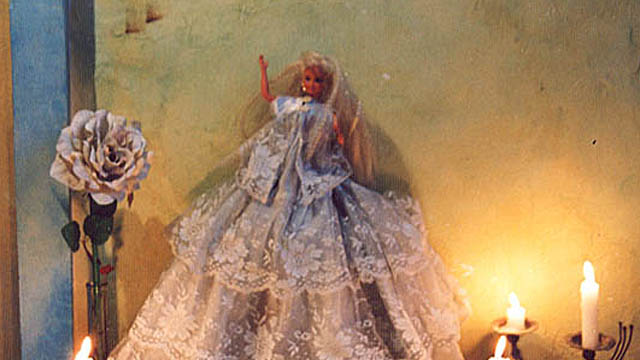
-
 Natalie Göltenboth
Natalie GöltenbothWhen I first entered Anna’s house1, I was surprised to hear that it was a temple of the Afro-Cuban Santería religion, a place determined by the presence of the orichas – the sacred beings of Santería. The objects of the interior did not reveal but seemed to hide their sacred meaning for the uninitiated viewer.
On our way through the house, Anna introduced me to a doll dressed up in white: Obatalá, the paternal oricha of wisdom and justice, with a cream cake on his right and a wide-eyed Bambi on his left. On the sideboard in the corner we greeted Yemayá, the maternal oricha of the sea, represented by a plastic bowl filled with water in which various floating animals swung and a Barbie, whose light blue lace dress complemented the turquoise colored water of the bowl. Finally, in a small wardrobe, the soup tureen of the goddess Ochún was decorated with two elegant Barbies in golden outfits, staring out of the darkness with their always flawless smiles. Two foreigners, charged with western ideals of beauty, who, in this context, had been commissioned with representing Ochún, the oricha of femininity, love and freshwater.
The representation or illustration of sacred powers through everyday objects, such as toys, dolls and knickknacks, have held a strong fascination for me since I literally stumbled upon them in Santero households, and, thus, the question of how this transference of powers and meanings to ultimately mundane objects could occur has long accompanied me on my fieldwork.
How can we interpret the fact that Ochún, the Afro-Cuban goddess of love and freshwater is visualized by a glittering Barbie doll sent to Cuba by Cuban family members living in the USA.
We should take a look back to the beginnings of the history of this religion for a better understanding of these dolls on the altars of Afro-Cuban Santería. Between the 16th and the 19th century, people were moved from one world to another on the sea routes of the transatlantic slave trade, which connected West Africa with the Caribbean (and this, in turn, with Europe), where they would henceforth work as slaves on the plantations of white landowners.
We should consider that people from Nigeria, Togo and Benin who had been deported to Cuba arrived in the New World without any luggage. The carved wooden sculptures of their gods, power objects, masks or costumes were left behind together with the African coastline. The transfer of religious concepts from Africa to Cuba, the Caribbean or Brazil, therefore, took place primarily in the minds of these people and remained dependent on this imaginative reservoir for long periods of time.
Despite the fact that the Cuban social anthropologist Don Fernando Ortiz2 still managed to collect some old carved wood oricha representations which had been produced during the colonial period in the 1930s to 1950s, the tradition of carving sculptures had not been resumed in the new situation in Cuba. The wooden oricha representations of Nigeria and Benin were replaced by smooth porcelain Madonna statues and the serious looking saints of Spanish folk Catholicism. Slaves from West Africa who were forced to worship the statue of Santa Barbara reacted with a phenomenon known as the syncretism of the Caribbean: statues of the Madonna and saints were interpreted as “reservoirs” of African deities and treated as such.
In the course of these syntheses, Santa Barbara is venerated as a representation of the virile oricha Changó, ruler of fire, thunderstorms and lightning. The Virgin of Regla, with her blue and white Madonna robe, is associated with Yemayá, the maternal oricha of the sea, and the Virgen de la Caridad del Cobre, in her church near Santiago de Cuba, is worshipped as Ochún, the oricha of love, creativity and sexuality. This possibility of reinterpretation, of “declaring something to be something else,” is tantamount to breaking the link between form and content and is the precondition for the unusual appearance of Barbies on the Santería altars.
As the colonial supplies in holy figurines diminished, colorful multiples of saints from Cuban mass production are found nowadays instead of the statues. Together with plastic dolls, Barbies or everyday objects, these new assemblages bear witness to the change of time and values, of new desires and new myths that move the people of Cuba today and are visualized on the altars.
Despite the fact that the connection of object and meaning has been blown up in modern Santería arrangements, it remains unclear to what extent new narratives are woven into the conception of the orichas when they are represented by new material objects: how much Madonna can one find in Yemayá, the oricha of the sea, and what is the relationship between a Barbie and an oricha? Referring to Marshall McLuhan’s3 famous statement that the medium is a significant part of the message, we can try a more specific interpretation of Barbies on Santería altars.
Original Barbie dolls are commodities acquired in stores in the USA and sent as gifts by relatives. As commodities and gifts, they mirror family ties that have continued over decades connecting Cuba and the USA, countries that have been politically separated since the Cuban revolution in 1959. In addition, Barbie dolls are not only saturated with the sacred aura of the orichas, they are also simultaneously encrusted with a fine texture of Cuban dreams of consumption and the feverish delirium of departure. Like Catholic saints, Barbies are figurines which are highly charged with their own narrative: the story of Ken and Barbie in the US American glamour world is a story of success, power and consumption. In this sense, Barbies on Afro-Cuban altars represent the fusion of idealized body and lifestyle imaginaries with sacred Afro-Cuban entities and deified ancestors. And, in the end, the forces of the orichas are conjured for reaching exactly these reasons: to provide their adepts with power that enables them to achieve their goals and realize their dreams – be they capitalistic or of another sort.
The reclassification of the Barbie doll from toy to altar object does not happen suddenly. The dolls have to undergo a transition process to become part of an altar installation. The dolls that appear on altars have been subjected to a ritual cleansing ceremony using decoctions of herbs associated with a particular oricha, which allows them to bear the vital power “Aché” of the sacred being. A bundle of herbs and other substances have been placed inside their bodies. Throughout these preparations, nothing has changed the appearance of the doll, which preserves its fashionable style and smile. What has changed is the idea about the object and hence its place – the Barbie is now part of a sacred altar installation.
Barbie dolls watch the strollers from the illuminated doorways that line the dark streets of Havana. Powerful representations of forces, imaginations, places and practices, connecting Africa and Cuba as well as Cuba and the USA, blending boundaries between dolls and gods, toys and power objects, commodities and sacred beings. They connect long-separated families and fragmented religious concepts. They guard the entrances of homes and watch over the desires of their inhabitants, who rely on the power of their Barbie goddesses.
Footnotes
1) Natalie Göltenboth. “Yemayá und der Spielzeugdampfer – Zur Sakralität der Ready-mades auf afrokubanischen Altären.” In Ideen über Afroamerikaner – Afroamerikaner und ihre Ideen. Beiträge der Regionalgruppe Afroamerika auf der Tagung der Deutschen Gesellschaft für Völkerkunde in Göttingen 2001, edited by Lioba Rossbach de Olmos & Bettina Schmidt. Marburg: Curupira, 2003, pp. 107-127.
2) Fernando Ortiz. Hampa Afrocubana: Los Negros Brujos. Miami. Universal, 1973.
3) Marshall McLuhan. Understanding Media: The Extensions of Men. 1st Ed. New York: Mc Graw Hill, 1964
References
- Brown, David H. “Thrones of the Orichas. Afro-Cuban Altars in New Jersey, New York and Havana”, African Arts, Oct. (1993) 44-87.
- Danto, Arthur C. Transfiguration of the Commonplace. A Philosophy of Art. Cambridge, Massachusetts: Harvard University Press, 1981.
- Göltenboth, Natalie.2020. „Invoking the gods – or the apotheosis oft he Barbie doll“ IN: Philipp Schorch, Martin Saxer et al. Exploring Materiality and Connectivity in Anthropology and Beyond. London: UCL
- Göltenboth, Natalie. “Yemayá und der Spielzeugdampfer – Zur Sakralität der Ready-mades auf afrokubanischen Altären.” IN: Ideen über Afroamerikaner – Afroamerikaner und ihre Ideen. Beiträge der Regionalgruppe Afroamerika auf der Tagung der Deutschen Gesellschaft für Völkerkunde in Göttingen 2001, edited by Lioba Rossbach de Olmos and Bettina Schmidt. Marburg: Curupira, 2003, pp. 107-127.
- Holbraad, Martin, and Morten Axel Pedersen. “Things as Concepts.” In The Ontological Turn. An Anthropological Exposition. Cambridge: Cambridge Univ. Press, 2017, pp. 199-238.
- Willie Ramos, Miguel. “Afro-Cuban Orisha Worship.” In Santería Aesthetics in Contemporary Latin Art, edited by Arthuro Lindsay. Washington: Smithsonian Press, 1996, pp. 51-76.
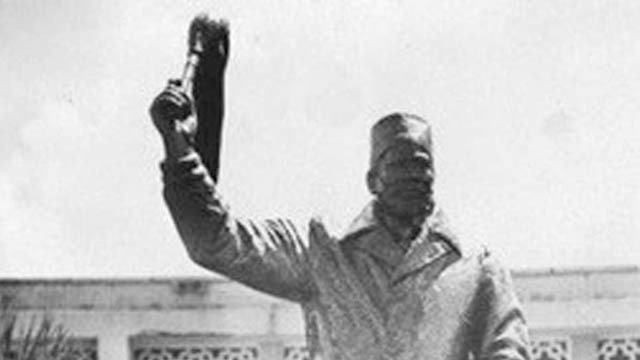
-
 Lydia Waithira Muthuma
Lydia Waithira MuthumaThe two statues
Walking around the rest of Nairobi’s city centre one comes across other statues that have no viewing restrictions. I comment on two of these that resonate, in a particular way, with the narrative of founding postcolonial Kenya: Kenyatta’s 1973 and Kimathi’s 2007 statues.
Kenyatta (c.1894-1978) the first president and founding father of postcolonial Kenya, had a second statue made out of cast iron, by James Butler, a British national. It was finished in 1969, shipped to Kenya and unveiled in 1973. It depicts Kenyatta wearing the robes of a university chancellor –he was the chancellor of University of Nairobi from 1970 to 1978. It stands in City Square.
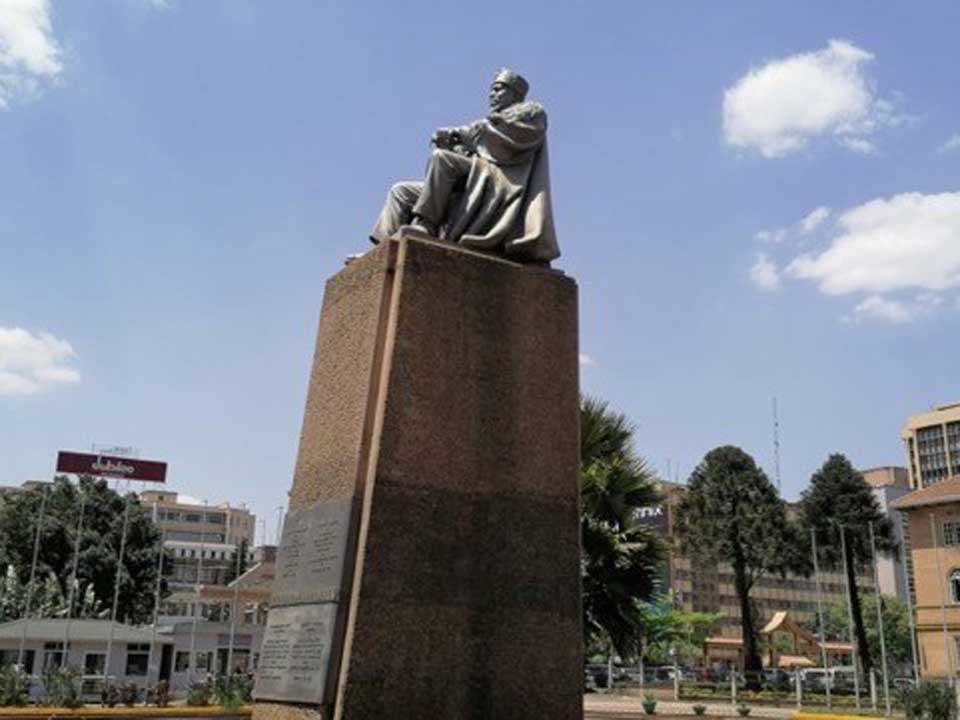
Figure 2. James Butler, Jomo Kenyatta, Nairobi, City Square, 1969 (unveiled in 1973), Bronze, 750 cm © Lydia Muthuma
Kimathi (1920-1957) also has a statue installed along Kimathi Street. He is the self proclaimed Field Marshal of the anti colonial Kenya Land and Freedom Army (KLFA) colloquially known as the Mau Mau. This movement was proscribed in colonial times and during the era of the first and second presidents of Kenya (1952-2003). But in 2003, Kenya’s third president, Mwai Kibaki, eventually unbanned Mau Mau and commisioned a statue in honour of Kimathi. The sculptor, Kevin Oduor, at the invitation of Kenyatta University's Department of Fine Art, made this statue.

Figure 3. Kevin Oduor, Dedan Kimathi, 2006 (unveiled in 2007), Bronze, 450 cm © Lydia Muthuma
The two statues (excluding the 1964 one) have similarities and differences that can be considered within the context of political history or through the artistic lens since they form part of Nairobi’s visual urban landscape. These statues represent two political figures, considered national heroes and therefore meriting public showing. Mass and volume, employed as the basic building blocks, are used to express emotional energy in a bid to engage the viewer’s affects. The chosen site of each statue (the situ) mediates the public’s affects.
Siting the statues
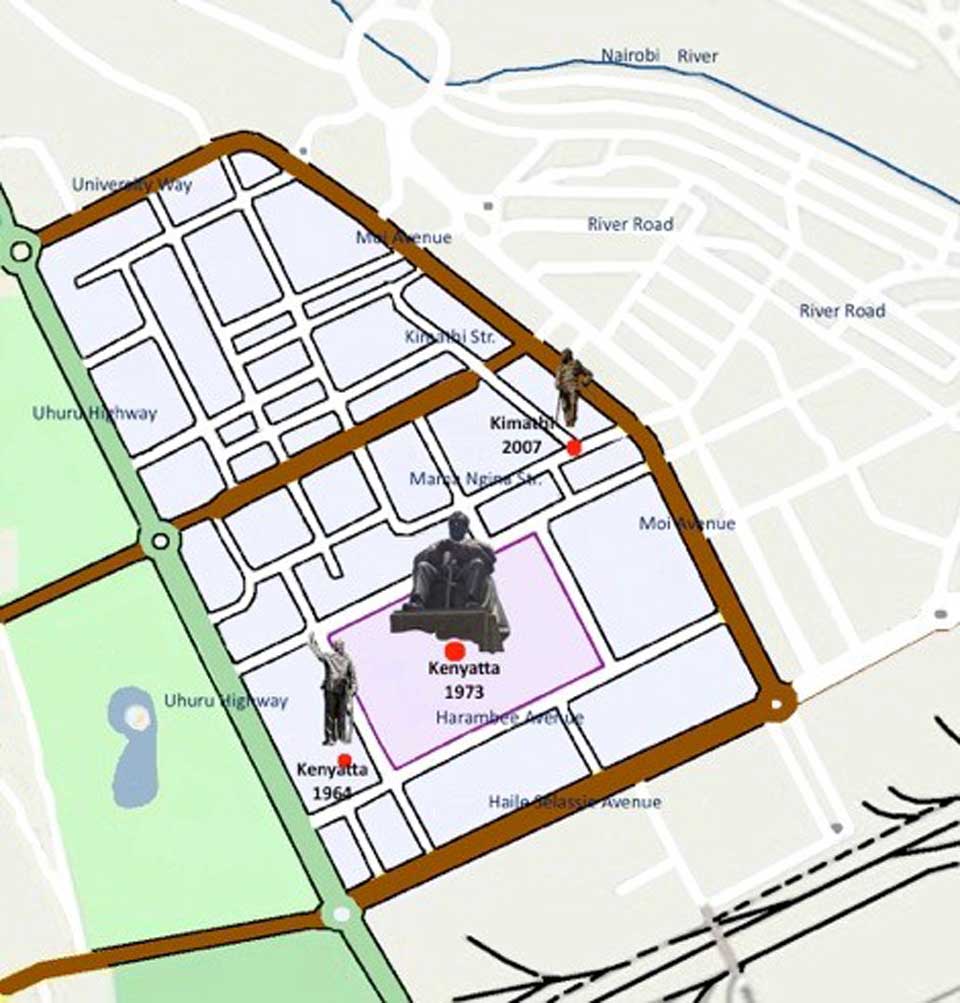
Figure 4. Location of the different statues © Lydia Muthuma
Jomo Kenyatta’s 1973 statue is placed in City Square with about one acre of land setting him apart from the surrounding buildings. Anyone walking into City Square, walks into this statue because it is the focal point. In traversing the square or accessing nearby buildings, one must pay visual homage to Kenyatta’s 1973 statue because of its setting; the geographical centre of the square (cf. figure 4 & 5).
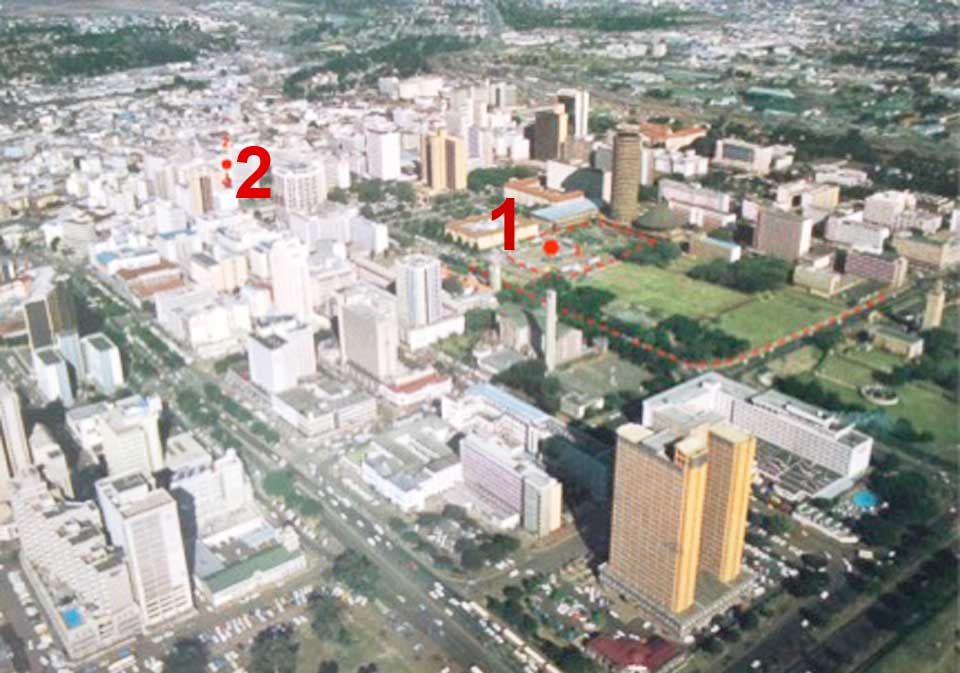
Fig. 5 City Square
Kimathi’s statue is set in different surroundings. By the year 2007 when Kimathi’s statue was installed, empty 1-acre plots, other than City Square, were not to be had in Nairobi’s centre. In fact a heroes' corner was designated about 5 km due west, in 2006, but was deemed unsuitable for Kimathi's statue. The street named for him, right in the middle of the city, was the preferred site. So on a tall plinth, Kimathi stands at the southern end of Kimathi Street. (cf. figure 4 & 5) There is hardly any viewing distance because Kimathi’s statue stands on a tiny traffic island, amidst tall buildings like Corner House (15 stories) and the Hilton Hotel (20 stories). The statue is in the middle of a busy traffic junction – where Mama Ngina Street meets Kimathi Street. And because it is immersed in both vehicular and pedestrian traffic, viewers are treated to short interrupted glances of Kimathi, atop a pyramid-like plinth that was designed by members of Kenyatta University’s Department of Fine Art. Fleeting, staccato snap shots that punctuate the flowing vehicular traffic comprise the everyday viewing experience. Lack of space, attendant hubbub and noise are inextricably bound up with Kimathi’s statue.
Meanwhile ample space and limited, if any, vehicular or pedestrian traffic, are the elements surrounding Jomo Kenyatta’s 1973 statue. He is represented twice life size to Kimathi’s mere life size. Unlike Kimathi, Kenyatta sits comfortably on a tall rectangular plinth. No wonder some say of Kenyatta's 1973 statue, “he is majestic, aloof...”, they are responding to—among other factors— the viewing experience, the physical placement and context of this sculpture. (cf. Figure 4 & 5)
Through the artistic lens
Statues of great men are often linked to significant historical happenings. Investigating their historical context is one way of ‘reading’ them. But it is not the only one. They can also be viewed as artistic components of the landscape they inhabit.
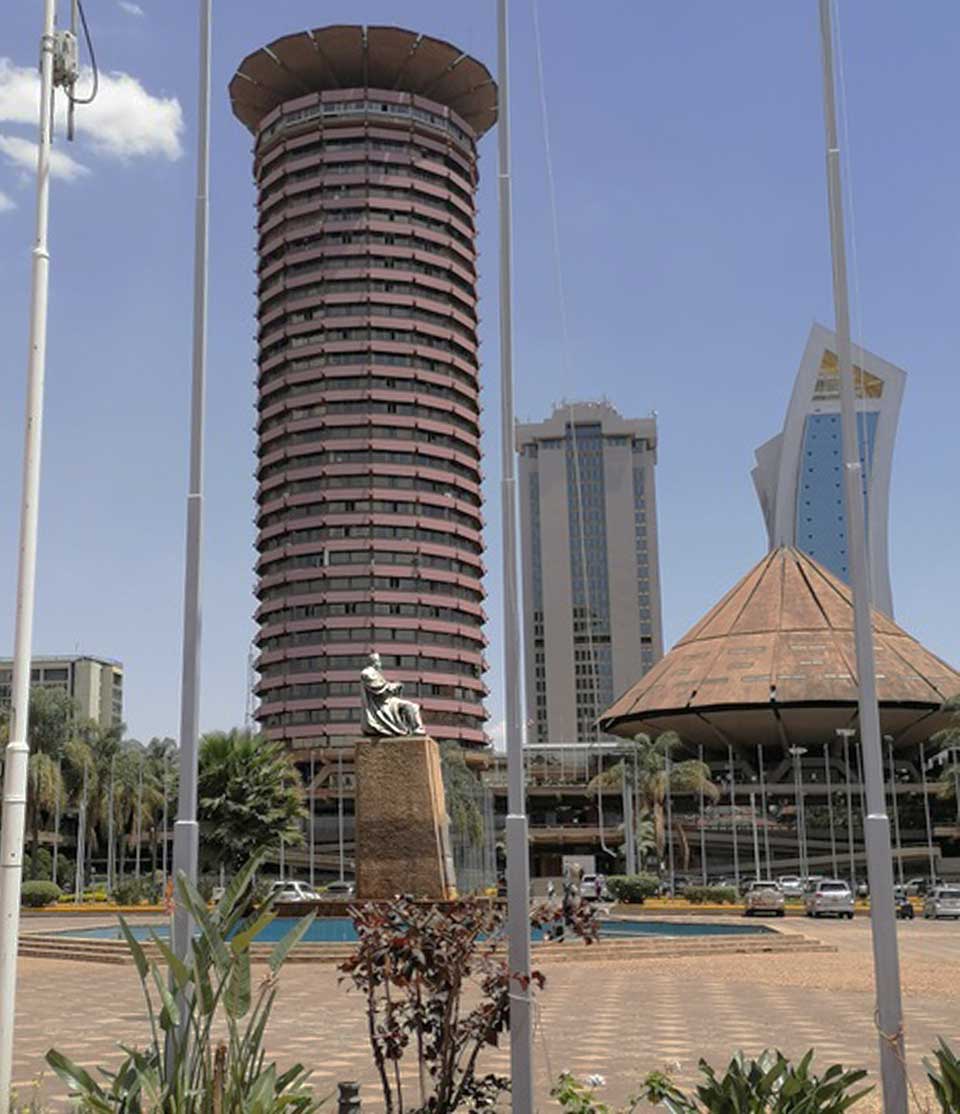
Figure 6 Kenyatta’s 1973 statue surrounded by the iconic Kenyatta International Convention Centre and Times Tower. © Lydia Muthuma
While the 1964 statue of Kenyatta was installed to mark the attainment of the country’s Republic status, (cf. figure 1.) it does not form the main subject of this article because of its inaccessibility to the ordinary Kenyan.The second statue of Jomo Kenyatta, which is the subject of this paper, was installed in City Square in 1973. Its situ (the 1973 statue) is about half a kilometer away from the Parliament buildings as shown in figure 4. It is curious that ten years after unveiling the first statue of Kenyatta (1964 to 1973) a second statue of the very same president was installed in City Square, near the first one. One wonders what prompted the erection of this second statue. Was the first lacking in any way? Because contemporaneous historical happenings do not supply a plausible answer, I turn to reasons artistic to account for the ‘double representation’ of Jomo Kenyatta.
City Square was designed in the 1930s as Nairobi’s most central public space. During this era, the colonial government was working hard to convince London that Nairobi could become the capital of a ‘federated’ East Africa with internal self rule. Kenya was to go the way of Australia or Canada within the British Empire. Nairobi Town Square (now City Square) was designed to show off the High Court (now Supreme Court). The visual focal point of Town Square was a statue of the then reigning monarch, King George V of Britain. But when the second world war signaled the beginning of the end of the British Empire, and the Mau Mau rebellion, similarly signaled the end of colonial rule in Kenya, the statue of King George V had to come down. Change in political leadership caused change in displaying of statues. Therefore from 1964, when this statue was dethroned, City Square was without a focal point – visually.
Even with the addition of the Kenyatta International Convention Centre (KICC) building, as a visual extension of the Supreme Court, the square still lacked visual balance and focal point. Thus in 1973, a second statue of Jomo Kenyatta was installed in order to solve this aesthetic problem. It took up the place that had borne King George V. The sculptor of this second statue, James Butler, was to fabricate work for a given site.It is in this sense that Kenyatta’s 1973 statue is considered site specific –the site was incomplete without the statue because previously it had held the statue of King George V, which was removed in c. 1963. Between 1963 and 1973, this spot was without a statue. Re-filling the gap, in this site, supplies a rationale for the repeated representation of Jomo Kenyatta –outside parliament in 1964 and in City Square in 1973; same person in the two statues.
Dedan Kimathi’s statue is not site specific: it was first fabricated then a site decided upon –later. In comparison to Kenyatta’s 1973 statue, Kimathi’s, while smaller in size, is provided with little, if any, viewing distance. It is placed amongst tall buildings at the intersection of two busy thoroughfares. However, whatever its artistic (de)merit, it comes with a wealth of historical re-imagining. Kimathi’s statue is considered an active element in the processes of decolonisation today. (Mwangi, E. 2010)
Again, unlike Kenyatta’s 1973 statue, Kimathi’s was not fashioned during his life time. It is posthumous since Kimathi was condemned to death by hanging, in 1956, for the crime of unlawful possession of a firearm. In reality though, his crime was rebelling against colonial rule as leader of the KLFA also known as the Mau Mau. The sentence was carried out in 1957 and his body deposited in an unmarked grave.Fifty years later – 1957 to 2007 – Kimathi’s statue was unveiled. The time lapse calls for a scrutiny and rationalization of ‘re-calling’ him from the dead. Why the need to represent him, by installing a statue, 50 years after his death? Political history is rife with explanations that are still on-going. (Julie MacArthur, 2019)
An artistic probing of Kimathi’s statue; if it brings back this Mau Mau hero to life and whether it was meant to, presents several challenges because the statue appears more symbolic than an actual re-presention of Kimathi. This is because of its size and situ. Its scale, in comparison to the adjacent built environment, is miniscule. It does not command viewership although it is right in the middle of the public. Its size renders it pedestrian and somewhat not worth more than a passing glance. There is little about it to catch the eye of a passerby. It can be mistaken for one more ‘live’ pedestrian attempting to cross the street. It is ‘camouflaged’ by its size which makes it blend into the pedestrian traffic. Its success, in engaging the viewer’s affects, is debatable. And a significant contributor is the statue’s site.Once Kimathi’s statue was completed, a decision was arrived at to install it at the junction of Kimathi and Mama Ngina Street, within busy vehicular and pedestrian traffic. Viewers are treated to snap shot sights of it amid the unending caravan of commuter buses. This style of ‘seeing’ is easily translated into a similar mode of remembering; snap shot, unclear memories of Kimathi – who was he again?
Conversely, in City Square, Jomo Kenyatta sits in the absence of interfering traffic; in the absence of impinging tall buildings and with ample viewing distance. Commendations like: “the statue (Kenyatta’s 1973) is an island by itself and can be approached from multiple areas both visually and physically which is a valuable status within space defining elements (…) It has the unmistakable character of an icon and can easily be the best defined statue in the country (Kenya),” are not unusual. Truly, the site of a statue influences the viewer’s response. http://www.archidatum.com/projects/jomo-kenyatta-statue-james-butler/
Conclusion
Perhaps because of the historical circumstances the two statues –Kenyatta’s 1973 and Kimathi’s 2007 are viewed differently. They also evoke varied responses. What cannot be overlooked is that their siting (situ) contributes to their visual perception, which in turn influences the remembrance and mental picture retained by the public.
The siting of both statues corresponds with Kenyatta being the central character in Kenya’s decolonisation narrative while Kimathi occupies the more peripheral position. Kenyatta (1973) sits in City Square while Kimathi is amid the hubbub of downtown Nairobi.
References
- http://www.archidatum.com/projects/jomo-kenyatta-statue-james-butler/
- Mwangi, E. (2010). The incomplete rebellion: Mau Mau movement in twenty-first-century Kenyan popular culture. Africa Today, 57(2), 86-113.
- Shanguhyia, M. S. (2019). Julie MacArthur, ed. Dedan Kimathi on Trial: Colonial and Popular Memory in Kenya’s Mau Mau Rebellion. Athens: Ohio University Press, 2017. xxvi+ 406 pp. Bibliography. Index. Paper. ISBN: 978-0896-803176. African Studies Review, 62(2), E12-E15.
published October 2020
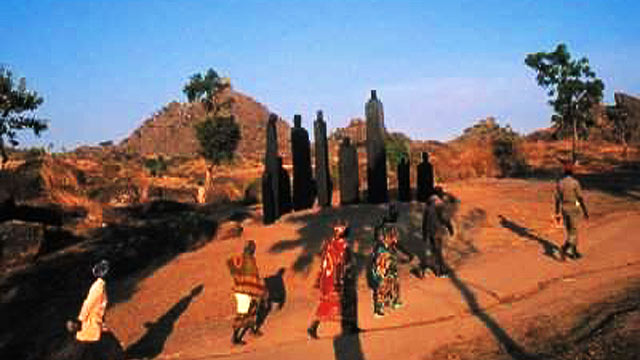
-
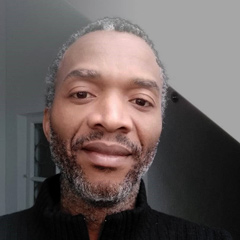 Paul-Henri Souvenir ASSAKO ASSAKO
Paul-Henri Souvenir ASSAKO ASSAKOThe image is a photograph showing details of the French artist Christian Lapie’s public installations in 2001 in the city of Ngaoundéré, capital of the Adamawa Region in Cameroon. The work consists of five modules composed of nine figures, ranging between 150 and 450cm each and laid in a semi-circular radius of 1000 cm. The pieces are made of wood and placed vertically in an upright position. The upper end is shaped like a head, giving each piece the appearance of a human silhouette. Arranged like a gathering of people dressed in local traditional attire, called boubou (a long, loose-fitting garment worn by both sexes in parts of Africa), the works are aligned in a semi-circular arc.
The work’s detailed structure is closely linked to its title Djaoulérou, which means "traditional space, place of meeting and reception". The artist echoes customs in a context where the relationship between traditional practices and Islam remains ambiguous. Islam provides an opportunity for certain members of local society to acquire privileged positions under the auspices of religion. Religion’s role in the political game has proven to be so important that post-colonial politicians have laboured to maintain control of the religious sphere in every region. Religion presents challenges for politicians in terms of governance and control. Maud Lasseur (2005, 95), echoing this sentiment, maintains that: “During the colonial period and under the regime of President Ahidjo (1960–1982), Christian missions were thus contained to the south of Cameroon so as not to hinder the Muslim aristocracy of the Far North or thwart the unifying political project of the first Cameroonian president”.
The monumental character of the work, the rhythm and movement suggested by forms treated with little attention to detail, the variations in volume and the different dimensions of each silhouette make the installation look both impressive and expressive. Each individual group of statues, displayed at the same time in different places in the city, shows how the "mysterious objects" made by a foreign artist present unfamiliar traits regarding the city’s socio-cultural imagination. The work breaks taboos: an unusual appearance that creates artistic experience, tradition and beliefs, which have become subject to manipulation and political propaganda within the society.
The work’s destruction reflects the fragility of a slavish society instrumentalized by politically motivated religious arguments in the 2002 legislative elections in Cameroon. The fact that a French artist has carried out an unusual and iconoclastic installation project in this city is seen as a provocation, particularly by the Muslim cultural authority. This religious and political authority occupies a very influential social position as "guardian of the temple" (custodian of traditions) and is in a position to incite people to commit acts of such magnitude. In addition to setting fire to the works and proceeding to uninstall them, public authorities definitively closed down the Franco-Cameroonian alliance of Ngaoundéré because of the social unrest the works provoked. This cultural centre for Franco-Cameroonian cooperation had supported the artist's installation project.
The act of vandalism perpetrated on Christian Lapie’s work exposes Cameroon’s national society in search of landmarks. Art, and particularly sculpture, has played an important role in expressing belief systems. The cosmogonic universe and the world view of the populations that have succeeded one another in this territory have been revealed through artistic representation. The bold production and reproduction of anthropomorphic, zoomorphic, geometric and imaginary forms is typical of these societies. As in many countries in sub-Saharan Africa, art has helped what people see, think, imagine and believe (J.P. Notué, 2005). Because of the lack of critical understanding of their history and the changes they experienced, societies are confronted with major shocks that have an impact on their development. Among these shocks are an ambiguous relationship to religion. Its consequences are the religious and political manipulation that societies are sometimes subjected to. One historical reason for this is the attitude of missionaries who made no discernment in the positive values of the tradition and the absence of doctrine and deep convictions of these values (E. Mveng, 1985).
Cameroon’s colonial religious legacy is one of the most important sources of the ethical foundation of its society in the 21st century. The generalization of the religious profession of faith/conversion seems to have fostered a latent form of "alienation" among the urban society. There is a superficial knowledge of both the principles of modern culture and the traditional environment, two references whose slavish play of opposites have political stakes. In Cameroon, the policy of conviviality between Islam, other religions and local cultural practices implemented by Sultan Njoya in the Kingdom of Bamum presents elements of inspiration for a compelling form of social emancipation. The policy of inculturation and multi-confessionalism has favoured the cultural openness of society and preserved, for example, the sustainability of the region’s remarkable creative industry. Art, belief systems and politics are all values of cultural expression fundamental to society.
The work breaks taboos: the artistic experience created by its unusual appearance calls upon traditions and beliefs that have become subject to manipulation and political propaganda within the society.
References
- Mveng Engelbert. 1985, Histoire du Cameroun, tom 2, Yaoundé, Ed. CEPER.
- NOTUE Jean-Paul, TRIACA Bianca, 2005, Bandjoun, Trésors royaux du Cameroun, Milan, Ed. 5 continents.
- Maud Lasseur. 2005, in « www.cairn.info/revue-afrique-contemporaine-2005 ».
- Assako Assako PH.S. 2011, l’art au cameroun du XXe au début du XXIe siècle : étude des expressions sculpturales en milieu urbain, thèse de Doctorat/Ph.D. en histoire de l’art, Université de Yaoundé 1.
- www.christianlapie.net/oeuvres/16/djaoulerou
- www.christianlapie.net/mobile/news/326/.%20http:#news
- www.christianlapie.net
published February 2020

-
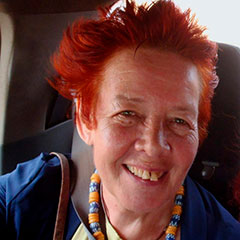 Bea Lundt
Bea LundtLouis XIV (1638-1715), King of France, was painted by Hyacinthe Rigaud (1659-1743) in his palace in Versailles near Paris in 1701. The oil painting was larger than life: 277 cm in height and 194 cm in width. The official title reads: Portrait de Louis XIV en costume de sacre. The painting is exhibited at the Louvre in Paris (INV 7492, open access), and a copy is in the Bavarian State Painting Collection in Munich.
In this portrait, the king is shown dressed in the official royal robes of the monarch, posing magnificently in front of his throne, which is placed in the background. In the painting are gathered together all of the traditional symbols of a ruler: the crown, the sword, and the ermine cloak, which uses the fur of this most precious animal.
Hyacinthe Rigaud was a famous and experienced court painter and had many assistants in his big atelier, so we do not know which parts of the picture are actually done by him. Since photography was not yet established at the beginning of the 18th century, every court employed artists specialising in portraiture to show people what their ruler looked like, or rather how he was expected to look or wanted to be seen in order to legitimise a political programme of monarchy. Specific iconographic symbols and accoutrements were used to demonstrate the tradition of rulership, which was thought to be bestowed by divine right. Rigaud fulfilled the wishes and orders of his patrons, but he also showed subtle characteristics of the people he painted.
‘Absolutism’: Paradigm of a ruling structure that today is considered a myth
Nowadays, the portrait is often used for educational purposes to visually substantialise Louis XIV as the most important representative of ‘Absolutism’ in Europe, the regime of direct rule with no control by a parliament or council: ‘L’etat c’est moi’ (‘I am the state’), he is said to have described his understanding of his place in the world. Research has discovered that he never really defined his role in this way (first in Bernier, 1988, p. 110). However, it is true that he was attributed with the image of being the central part of nature and the cosmos: as the ‘Sun King’, he was staged as the genesis and focus of all energy whence all life originates.
Scholars of the early modern era (Henshall, Wrede, Reinhard) consider ‘Absolutism’ to be a myth constructed in the 19th century. Since Gerhard Oestreich observed the ‘non-absolutistic elements in absolutism’ in 1969, many studies have pointed out that the king depended on an influential elite as well as a number of committees. A complex and effective network of groups existed as the executive authority controlling the political system, as Althoff and Stollberg-Rilinger have shown in their groundbreaking books on the political organisation of the late medieval and early modern states in Europe. In their publications, they describe the ritualised methods used in communication between the influential groups in order to find a consensus. As result of that scholarly discussion of the topos of ‘Absolutism’, Wolfgang Reinhard, like other scholars, recommends, ‘that one should abandon the term’ (p. 40). But, as it is rooted quite deeply in the historical consciousness, this does not seem so simple. Martin Wrede complains in his article ‘Absolutismus’ in the handbook Enzyklopädie der Neuzeit of the continuation of the topos, namely ‘the cliché, still firmly anchored in popular views of history as well as in textbooks, of the all-dominant, all-regulating, arbitrary state built on princely power and with a splendid façade’ [‘das in populärem Geschichtsbild wie Schulbuch nach wie vor fest verankerte Klischee des alles beherrschenden, alles reglementierenden, auf fürstliche Macht gebauten Willkürstaates mit prachtvoller Fassade’] (p. 33).
The portraits of Louis XIV and other kings are used to prove the existence of this colourful glory, whilst in reality, the monarchs were representative figures and personal symbols. During Louis’s lifetime, France expanded its territory in Europe and overseas, which brought extreme losses and financial burdens to the people. Because of that disaster, it was necessary to produce a reputation of honour for the king.
Interpreting the portrait
The portrait shows Louis XIV at the age of 63, at the height of his success. But he does not appear as a strong and resolute ruler who travels around in his country, nor an active fighter who leads battles to defend his people. Pupils today always miss a specific physical ‘masculinity’ that they expect from a king They fault this person for not being able to move, run, or ride in his heavy clothes, high heels and white tights. He is forced to stay indoors, surrounded with sumptuousness. They perceive him as ‘feminine’, as the only part of his body he is presenting is his legs, much like a young woman in a miniskirt, and the grandiose wig with its long hair hinders many activities. The entire image seems ridiculous to today’s pupils. What we see here is an old, ill, vain man who is dressing up to fulfil representative duties. What pupils remark is not just some disrespectful observation but is in line with what we know about reality. Rigaud is a superb artist to show the man in his demonstration of the ritualised courtly pageant of luxury.
There are more paintings showing Louis at different phases of his life. As all royal children, he was kept in the same pretty clothes as girls during the first six years of his life. Portraits show him even at the age of ten with facial features and accessories we perceive as feminine and fanciful, not suited to preparing for the life of a strong ruler. The official regent for Louis until he turned 22 was his mother, Anna of Austria. Louis strengthened the Catholic church but did not follow her order of monogamy: besides his six legal children, he had eleven illegitimate ones, all of whom he cared for (Bernier, Tischer, Wrede).
The ideal of masculinity during this time was the mixed one of early modern times, when gender was more hybrid than in the 19th/20th centuries, and life concepts were not sharply polarised between men and women in different spaces, placing men in the public sphere (Dinges, Lundt). Also, the central symbolic figure for the state was not necessarily masculine; there were very influential wives, concubines, and even female rulers.
Conclusion
In the educational process, it is important to dismantle prejudices about past ideals for masculinity as being strong, powerful and heroic. The historic examples of individual men’s glorious performances on European thrones need to be questioned. Pictures like the one of Louis XIV can help to construct a different understanding of courtly life. If it is understood against the background of a plurality of life concepts for ruling men and women, it can help us to see the limitations of their power.
References
- Gerd Althoff: Rules and Rituals in Medieval Power Games, Brill Academic Publ. 2019.
- Olivier Bernier: Ludwig XIV Die Biographie, Albatros Verlag 1988. English edition: Louis XIV, New Word City 2018.
- Ida Blom, Catherine Hall, Karen Hagemann: Gendered Nations. Nationalisms and Gender Order in the Long Nineteenth Century, Bloomsbury 2000.
- Martin Dinges (ed.): Männer-Macht-Körper. Hegemoniale Männlichkeiten vom Mittelalter bis heute, Frankfurt am Main 2005.
- Karen Hagemann: Gender, War, and Politics: Transatlantic Perspectives 1775-1830, Palgrave Macmillan 2020.
- Nicholas Henshall: The Myth of Absolutism. Change and Continuity in Early Modern European Monarchy, London 1993 (first published in 1992).
- Bea Lundt: Die Grenzen des Heros. Vielfältige Männlichkeiten in Mittelalter und Früher Neuzeit. In: Martin Lücke (ed.): Helden in der Krise. Didaktische Blicke auf die Geschichte der Männlichkeiten, Berlin 2013, pp. 67-102.
- Gerhard Oestreich: Geist und Gestalt des Frühmodernen Staates, Duncker & Humblot-Verlag 1969.
- Wolfgang Reinhard: Geschichte des Modernen Staates, München 2007 (and elsewhere).
- Barbara Stollberg-Rilinger: Des Kaisers alte Kleider. Verfassungsgeschichte und Symbolsprache des Alten Reiches, C.H. Beck Verlag 2nd edition 2013.
- Anuschka Tischer: Ludwig XIV, Stuttgart 2016.
- Martin Wrede: Absolutismus. In: Enzyklopädie der Neuzeit vol. 1, Stuttgart 2005, cols. 24 -34.
- Martin Wrede: Ludwig XIV. Der Kriegsherr aus Versailles, Darmstadt 2015.
Translated from German by Kelly Thompson.
published September 2020
 Bea Lundt
Bea Lundt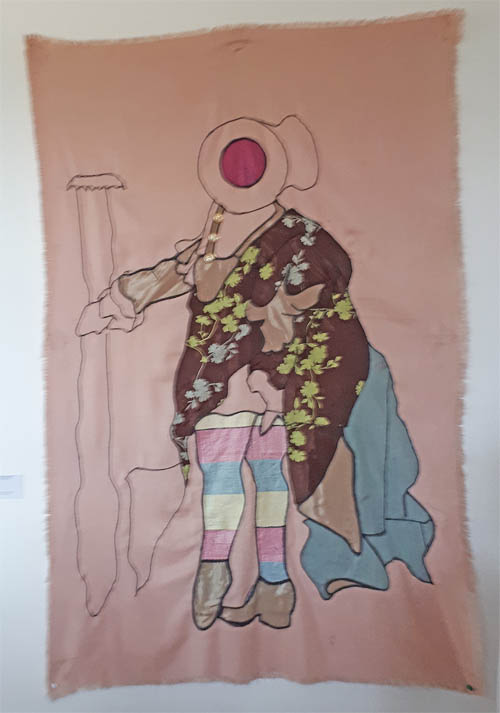 Prince Osei Owusu Bempah, from the exhibition "Orderly Disorderly" - End of Year Exhibition, KNUST (Kwame Nkrumah University of Science and Technology) in Kumasi, Ghana, Museum of Science and Technology in Accra, 2017, © Prince Osei Owusu Bempah
Prince Osei Owusu Bempah, from the exhibition "Orderly Disorderly" - End of Year Exhibition, KNUST (Kwame Nkrumah University of Science and Technology) in Kumasi, Ghana, Museum of Science and Technology in Accra, 2017, © Prince Osei Owusu BempahThe artist Prince Osei Owusu Bempah from Ghana artistically examines in two art works the portraits of Louis XIV (and below a typical European equestrian portrait of a ruler, like e.g. Charles V, painted by Titian 1548, today at the Prado Museum in Madrid). "Bempah appropriates historical images in the form of painting, sculpture and photography. Considering images as a multiplicity, he is now drawn to news from social media, television, radio and newspaper. Information is crucial to the making of his works which extends beyond the visual representations. He reinterprets them in tapestry, embroidery, banners and uses plastic sacks, curtain accessories, second hand table cloths and silk in different configurations. He substitutes certain elements of the original images with mortars and pestles" (leaflet of the exhibition).
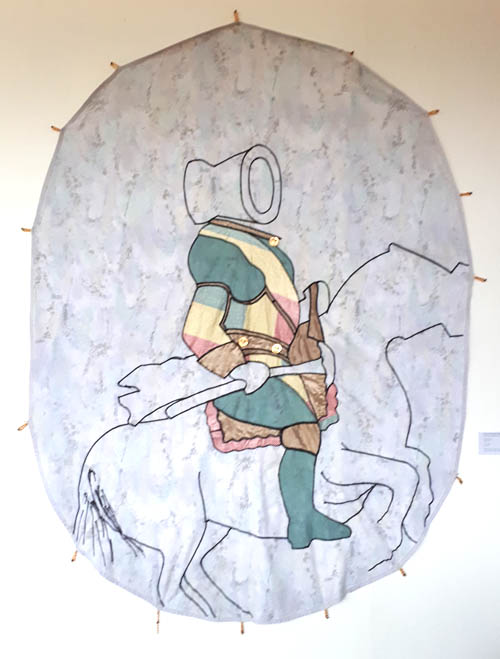
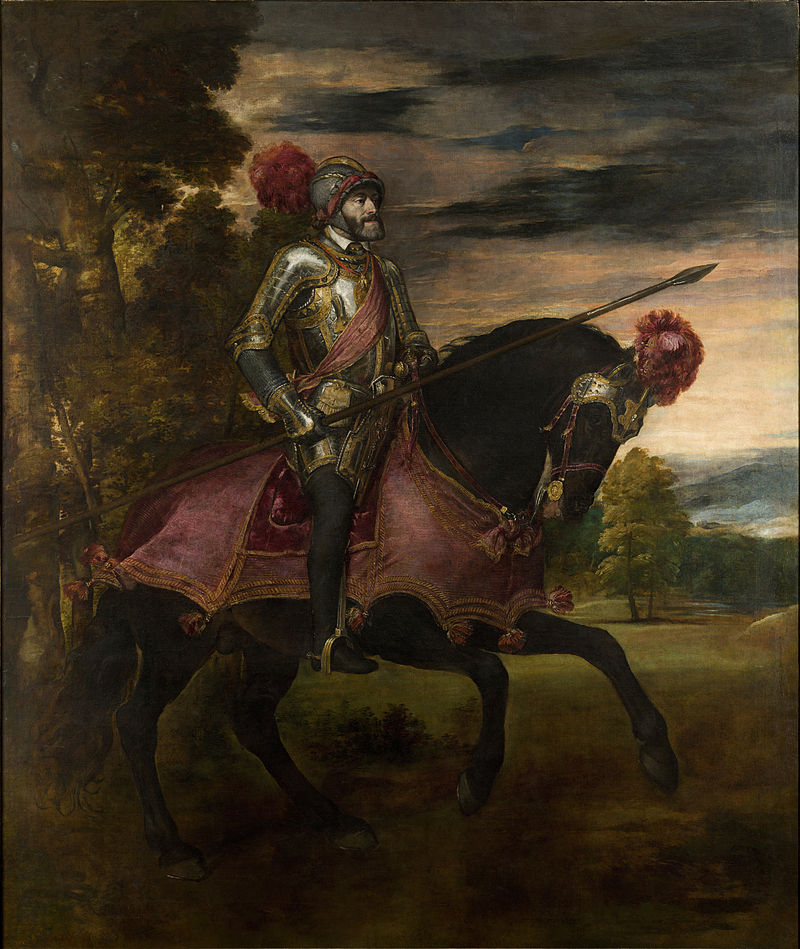
Image 1:Prince Osei Owusu Bempah, from the exhibition "Orderly Disorderly" - End of Year Exhibition, KNUST (Kwame Nkrumah University of Science and Technology) in Kumasi, Ghana, Museum of Science and Technology in Accra, 2017, © Prince Osei Owusu Bempah. (left)
Image 2: Tizian, Carlos V en Mühlberg, 1548, H: 335 cm, W: 283 cm, Oil on Canvas, Museo del Prade. (right)
published November 2020
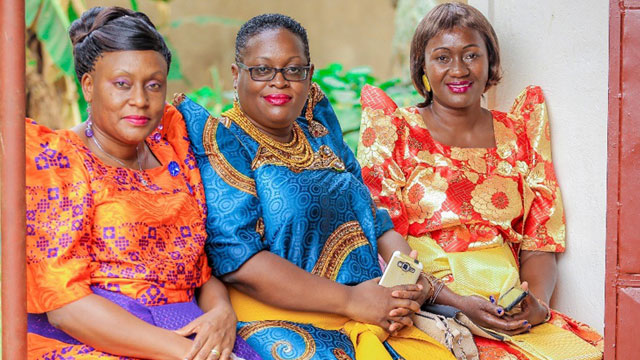
-
 Esther Kibuka-Sebitosi
Esther Kibuka-Sebitosi“Decolonizing self” is a photo demonstrating the complexity of cultures and how inter twinned African and western cultures have become. The photo was taken at a traditional wedding in Kanyanya village, where African cultural practices like sitting down on the mat are proudly demonstrated. Paradoxically, decolonizing the self-starting with the dress, is not an easy process as pieces of the western culture are clearly visible, for example the sunglasses, the necklace and ear rings all show the interlinkages between cultures. The example is excellent in showing culture, history and evolution of the traditional dress and political economy for educators. The mood of the gaze is best described by former President Thabo Mbeki in his poem,” I am an African” as he proudly says, “ “Today I feel good to be an African”.
In unravelling decolonizing self, I want to start with explaining colonialism; Torres (2007) refers to colonialism as, “ a political and economic relation in which the sovereignty of a nation or people rests on the power of another nation”. He refers to coloniality as a long-standing patterns of power that emerged as a result of colonialism but that define “culture, labour, intersubjective relations and knowledge production well beyond the duration of colonial administration”. Hence, coloniality, he argues, survives colonialism and is maintained through books, music, academic performance, cultural patterns, in self-image and aspirations of self and is lived every day. It follows therefore that decolonizing self would have aspects of culture, language and daily practices that one has to get rid of. Taking an example of cultural dress, I dress in my traditional dress called the busuti or Gomesi. The image shows the dress and the Shaath (cream colour that is used to tie it). The necklace is modern shining with stones. The accessories are also western. I am sitting down on a mat made out of sisal and “nsansa- palm tree leaves. Sitting down is a cultural tradition and practice that dates back for generations. This is also a gender demonstration of roles of women who would sit on the mat to greet visitors who had come to be introduced. The practice of paying lobola (bride price) is common in Southern Africa and traverses the African continent. In the photograph, everybody dresses in the traditional dresses. It is a way of saying “I am an African” and I dress like this, “Look how smart my dress is lovely”.
Ironically, long ago, the traditional dress was made of out of the Mutuba tree- Fig tree Ficus species. They got it from the bark of the tree, which they smashed until it became flat. It was dried and then rolled out. The cloth (Kikunta or Lubugo) comprised only of a sheet, which was wrapped around, the shoulders. Over the years, the Kikoyi replaced the kikunta as it was made out of cloth- cotton. Linked to the traditional dress, is the decorative materials from India. Inside the dress is another wraparound Kikoyi that together with decorations were also from India. The image shows the material of the dress- silk with beads. This material is from India or Dubai. The modern materials are no longer traditional (Kikunta and kikoyi). The local industry has adapted to make traditional dresses out of new materials linen, nylon, chiffon or a mixture instead of cotton or Lubugo from the Mutuba tree back.
The image also demonstrates the mostly western sunglasses or gaggles. The sunglasses show the western culture I have adopted over the years. The Europeans normally put on sunglasses to protect their eyes from the sun. The occasion was held during the day as the sun was shining. It is not traditional practice to wear sunglasses. However, they help protect the shy people, as they do not have to look at all the guests. The gaze in the image is that of a woman comfortable in her body, sitting down with pride and taking pride in her tradition. This particular image was selected because it reveals the culture in transition. It is contemporary culture- a traditional wedding- a place where African Culture is luxuriously displayed. Paradoxically, the dress is traditional but the accessories are western showing the entangled nature of coloniality- the tradition African culture and the western culture, practices, all intertwined in intercultural interactions. The sunglasses may also demonstrate the cover up- hiding of self in the modern practices. Based on the above, it is not surprising that Decolonization is a layered process, which takes time and patience.
Thabo Mbeki wrote a poem, “I am an African” expresses the objective of the constitution, “It is a firm assertion made by ourselves that South Africa belongs to all who live in it, Black and White”.
As I sit on the mat and watch the bride and groom give gifts to each other, I remember the words of the former President of South Africa, “Today I feel good to be an African”.
In decolonizing self, “decolonization” that has become the rallying cry for those trying to undo the racist legacies of the past, according to Achille Mbembe. Starting with cultural dressing is the first form of decolonizing self. Other forms include decolonizing power and decolonizing knowledge.
published January 2020
 Katharina Knaus
Katharina KnausBeyoncé’s and Jay-Z´s Video „Apeshit“ discusses post-colonial exhibition art
My first contact with art history was by reading E.H.Gombrich „The Story of art.“ (1909-2001). When starting my studies of art history in Munich, this was the book they recommended as standard literature. The cover text describes it as „the most famous and popular book on art ever published“. Although it claimes to be an introduction in art „for reader of all ages and backgrounds“ Gombrich tells a very one-sided story. Beyoncé’s and Jay-Z´s Video „Apeshit“ discusses post-colonial art historiography by exposing the Louvre as a white – dominated space.
„Two black women are sitting on the floor wearing light brown tights and body-hugging beige vests. They are in profile, facing away from each other, and positioned at either side of David’s painting of the famous 19th Century French socialite. Linking the two women together is a flowing piece of white material, each end of which they wear on their heads like a turban.
Above them, Madame Récamier reclines on her antique sofa, dressed in a simple sleeveless white dress, her head turned towards the viewer. The design of the sofa is similar to that of a sleigh-bed, with rising wooden ends. It is these bed ends that the women on the floor echo, the variance in the darkness of their skin matching the different tones of the wood in the painting.
The cloth that links them represents the dress worn by the painting’s subject. The message is clear: It was on the backs of subjugated black people from the French colonies that Madame Récamier was able to enjoy her life of leisure and pleasure.“ (Will Gompertz)
The Carters’ Louvre takeover isn’t just about protest; it is about power too. But the overall point is powerfully put. The game is up for those institutions – be it Hollywood, Broadway or the Louvre – which have ignored black artists, refused them a voice, or a seat at the top table.
published January 2020
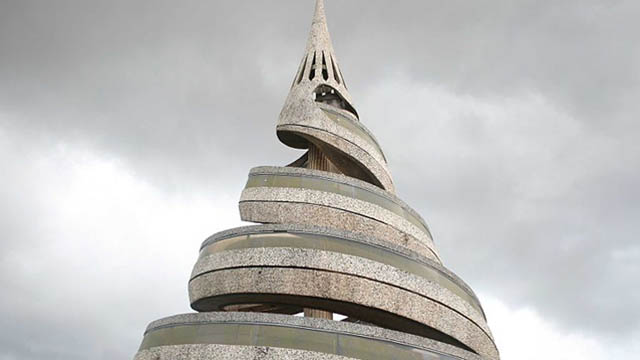
-
 Paul-Henri Souvenir ASSAKO ASSAKO
Paul-Henri Souvenir ASSAKO ASSAKOThe "reunification" is the result of a synergy of different societies willing to modify their way of life and the principles of their socio-cultural organization in order to cope with the vicissitudes of the colonial yoke. These societies are based in the Great West, the Coastline, the Southern Forest, the East and Lake Tchad, the regions that mark Cameroon’s geography. Each of these regions is home to a large number of ethnic groups such as the Bamileké, the Bamun, the Akunakuna, the Babungu, the Duala,the Beti, the Fang, the Peul, the Kirdi, the Fula, the Dourou, the Fali, etc. The date of May 20th, 1972 marks Cameroon’s passage from Federal Republic to United Republic by referendum. This date can be said to be the culmination of the political commitment initiated on the 1st of October 1961 with the reunification. Based on this commitment of 1961, Cameroon continued the construction of a unitary state and the consolidation of national unity encompassing the country's entire population. It can be argued that this unitary state was the only way to protect Cameroon’s sovereignty after Independence and to implement projects of prosperity. In President Ahidjo’s words of 1961: "It is together that we will make our Cameroon finally returned to the borders of our ancestors1, a modern country where it will be good to live in a climate of freedom, fraternity and prosperity." (Mveng 1985, 262).
The Reunification Monument is situated on "Plateau Atemengue", Yaoundé’s political and administrative centre. In this area, the colonial administration had placed institutions for education and administration that were crucial constituents of the new country: the National Assembly, the school of administration and the judiciary, the military headquarters, the Leclerc High School and the University of Yaoundé, to only name a few examples. The large boulevard initially used for the parades commemorating the celebration of the feast of national unity is located on this plateau as well. Placed on top of the city, amongst the republic’s essential institutions the Reunification Monument was obviously meant to become a reminder of the sense of unity amongst the initiatives engaging the Cameroonian republic.
The ensemble of the Reunification Monument consists of an architectural structure and a sculpture. According to Noé Tonye2, its shape emerged from sketches selected by the public authorities following a national and international competition on the theme of reunification launched by the Cameroonian Head of State. However, the identity of the authors of this monument suggests that they might also have been directly commissioned because they appeared qualified for the job due to their previous projects. These artists are Gédéon Mpando and Engelbert Mveng with his “Art Nègre Workshop”, who both used to receive public commissioned in Yaoundé at that time. Annette Schemmel (2015, 66) points out with regard to Engelbert Mveng: “As the author of Cameroon’s first national history, a contributor to ABBIA {Revue}, and a politician in Ahidjo’s service, Mveng enjoyed an excellent reputation among Cameroon’s élites. His social standing also led to secular commissions ». A third partner was the French architect Armand Salomon. His involvement in the realisation of this monument is due to his proximity to the French government, who probably recommended him to the Cameroonian government, according to Noé Tonye.
Although the conditions of the commission are somewhat obscure, Engelbert Mveng is known to be the designer of the spiral tower as well as of the representation of the cultural areas of the new state, while Gédéon Mpando created the monumental statue and Armand Salomon was in charge of the realization of the spiral-shaped building. Arguably, the teaming up of three professionals had a symbolic dimension because building a "merged" nation called for the commitment of society as a whole. Such a vast project required an explosion of research and creative initiatives towards a culture of common values driven by teaching and education. The involvement of several Cameroonian artists and a French architect in the design and the construction of this monument reflects the political will to involve different parts of society and to create mechanisms that are operational and serving the interests of national unity.
The architectural component of the monument to the reunification of Yaoundé has the appearance of a giant cone built of concrete. This cone consists of two spirals which describe a sinusoidal movement, and which unite on the top. The basis of this architecture is a circular structure and each spiral is a form of concrete slide made up of stairs to the top. A high column in the centre and four parallel pillars support the structure as a whole. For these four main pillars, the Art Nègre Workshop has designed reliefs showcasing characteristics of lifestyles, landscapes, cultural and artistic elements from the North, South, East and West of Cameroon. In a similar style, the team has pictured school scenes, construction scenes of modern architecture, scenes of farming, etc. for the decoration of the underground part of the building, thus celebrating the process of transformation and development of both society and land.
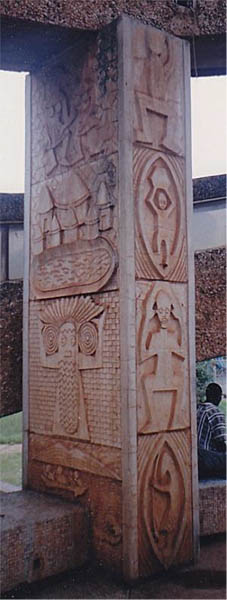
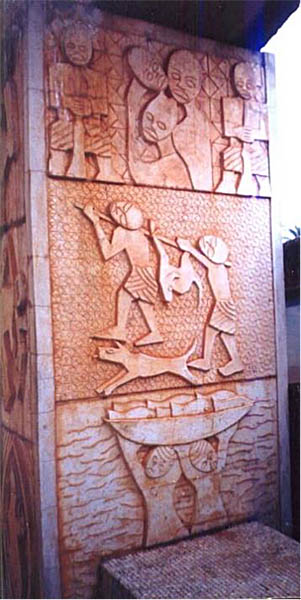
Images: ASSAKO ASSAKO Paul-Henri. 2014. L’art au Cameroun du XXe au début du XXIe siècle : étude des expressions sculpturales en milieu urbain, thèse présentée et soutenue en vue de l’obtention d’un doctorat/Ph.D en Histoire de l’Art, UY1-Cameroun, p. 571.
Details of a pillar cladding representing the diversity in the Cameroonian regions: the cone-shaped architecture and an initiation mask of the Kounga from Cameroon’s West; the abbia motifs and the hunting scene characteristic of the forests on the South Cameroonian plateau and finally the fishing scene which recall the Littoral region.3
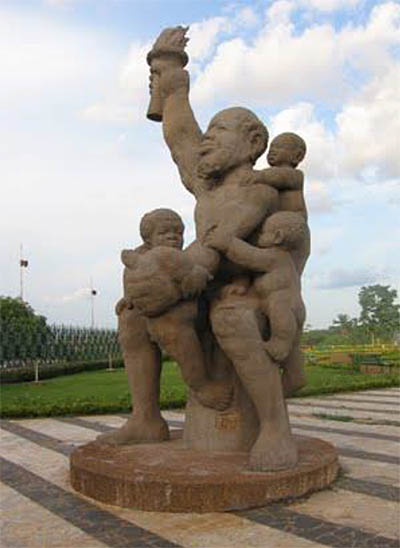
Engelbert Mveng and Atelier Arts Nègre (design, decoration in relief on the architectural structure), Armand Salomon (architecture), Mpando Gédéon (sculpture), 1973 -1976, concrete, H: 7m, Atemengue Plateau Yaoundé, Cameroon. Photo: Paul-Henri Souvenir ASSAKO ASSAKO
The sculpture by Gédéon Mpando that is situated in front of the spiral architecture reinforces the idea of a united nation as a foundation for development, fulfilment and prosperity in its own way. The artist has personified the nation in a figurative sculpture. The composition represents a stocky colossus (53 tons, height of 7m) in a seated posture of great stability. He holds a torch in his right arm while his left hand serves to support the four children who are clutched to him. The children’s visible efforts to climb up the colossus make for a strong vertical tension, echoing the cone-shaped architecture in the background. Mpando’s sculpture reveals a kind of serenity. Its strong expressiveness is due to a harmonious play of masses and volumes in the treatment of forms. Both artists’ contributions translate a vision of the nation that is both poetic and critical and as such essential to the development of a national society. Both components of the monument incorporate the idea of belonging to a nation that is united and hence display the most universal property that an image can acquire in such a context: its true ontological significance (H. Belting, 2004).
Let us come back to the relevance of this monument’s imagery. The inhabitants of the territory of Cameroon have inherited a common history of colonization. This history has forged socio-cultural, symbolic, emotional and political ties between ethnic groups. E. Renam speaks of these ties as the “fusion of populations” (1882). These links constitute the raw material of the national collective memory. It can be argued that it is worthwhile to overcome the obstacles to the consolidation of this nation due to the socio-cultural sedimentation of these ties. Disappointment with the promises of prosperity have resulted in calls to return to regional autonomy, be it in the form of a federal state or in the form of secession. Precaution needs to be preserved, however, because deconstructing the Cameroonian Republic constituted in the 1960s and 70s would imply calling into question the historical heritage, that Cameroon was born from the colonial system developed at the African conference in Berlin in 1884. The consequence would be the restoration of a precolonial environment. Instead, it seems more productive to critically analyse the historical stakes in favour of the development of today’s society.
Overview report on the current political situation in Cameroon (April 2021) - in German: Link https://www.bpb.de/internationales/weltweit/innerstaatliche-konflikte/327306/kamerun?pk_campaign=nl2021-04-07&pk_kwd=327306
References
- RENAN Ernest. “Qu’est-ce qu’une nation?” Bulletin de l’Association Scientifique de France. 26 March 1882.
- BELTING Hans. 2004. Pour une anthropologie des images, Ed. Gallimard
- BAHOKEN J.C. et ATANGANA Engelbert. 1975. La politique culturelle en République unie du Cameroun. Éditions Les Presses de l’Unesco.
- MVENG Engelbert. 1985., Histoire du Cameroun. tom 2. Yaoundé. Ed. CEPER.
- CHEICKH ANTA DIOP. 1079. nations nègres et culture, Ed. Présence Africaine
- SCHEMMEL ANNETTE. 2015. Visual arts in Cameroon - A Genealogy of Non-formal Training 1976-2014, Langaa Research & Publishing CIG, Mankon.
- ASSAKO ASSAKO Paul-Henri.2014. L’art au Cameroun du XXe au début du XXIe siècle: étude des expressions sculpturales en milieu urbain, thèse présentée et soutenue en vue de l’obtention d’un doctorat/Ph.D en Histoire de l’Art. UY1-Cameroun. p. 571.
- https://www.osidimbea.cm/collectivites/centre/monument-reunification/
- www.mbogliaa.com
Footnotes
1) The expression ‘boundaries of ancestors’ refers primarily to the idea of traditional cultural heritage and its appropriation for planning the prosperity of the nation.
2) https://www.osidimbea.cm/collectivites/centre/monument-reunification/
3) Source of images: ASSAKO ASSAKO Paul-Henri. 2014. L’art au Cameroun du XXe au début du XXIe siècle : étude des expressions sculpturales en milieu urbain, thèse présentée et soutenue en vue de l’obtention d’un doctorat/Ph.D en Histoire de l’Art, UY1-Cameroun, p. 571
published February 2021
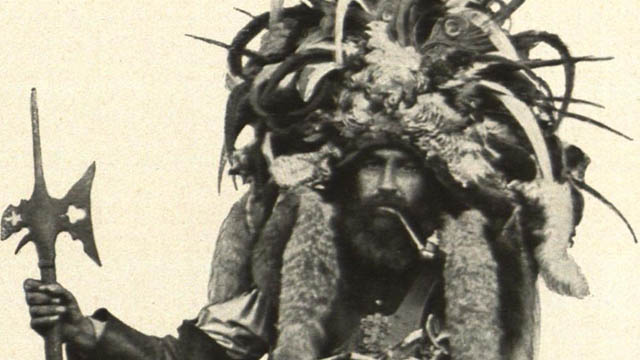
-
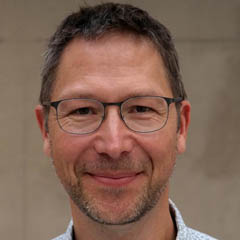 Werner Bloß
Werner BloßAdministrative, esoteric and patriotic purposes until the first half of the 19th century
After an initial sighting the clothing can still prove to be expectable in the context of its time and regionality. While the medieval weapon seems useful for the guard's task, the hat's purpose can be seriously doubted. But peculiar as the outfit might be, it must have identified its possible former wearer as a civil servant, who was authorized, e.g. to punish violations of the rules. To protect the vineyard, a Saltner had to be reliable, vigilant, fearless, persuasive and loud. In addition to this executive function, there was also an esoteric one: Myths have developed claiming that a Saltner is able to defend himself successfully not only against thieves and ravenous animals, but also against attacks from the otherworld. Thus, the formerly more modest hat might have taken on a fetish-like function as well, alongside an expectedly Christian context — similar to the magic „Hexenkreuz“ (a shoe-length iron forged in the shape of a cross, von Hörmann 1872, p. 41-47) which should be part of the equipment of a Saltner too.
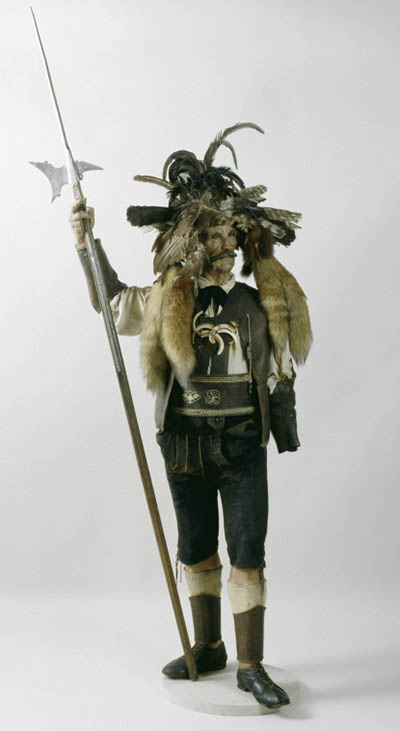
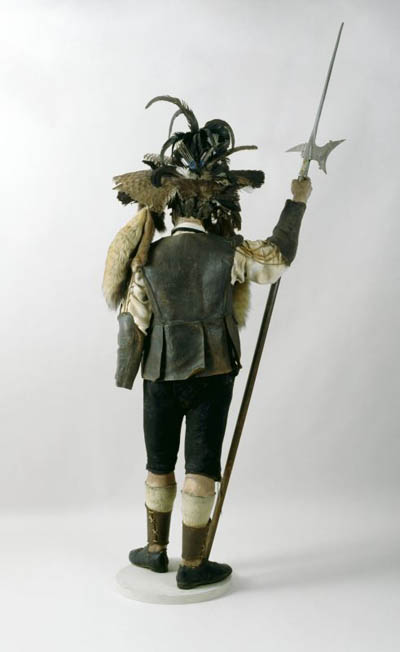
Fig. 1, 2: Meraner Saltner, Germanisches Nationalmuseum, 1875/1899 © Germanisches Nationalmuseum
In addition, there are other striking features of the costume. Apart from the hat, many handed down costumes of vineyard keepers look very similar to that of an outstanding Tyrolean folk hero. As to the beard, most vineyard keepers on contemporary pictures also come very close to Andreas Hofer, the leader of the Tyrolean popular uprising of 1809 (fig. 3). Thus, two hero constructions could be woven into the image of these objects: the brave guardian with supernatural powers and the defiant folk hero who successfully defended his country against the Bavarian occupiers (at least for a short time).
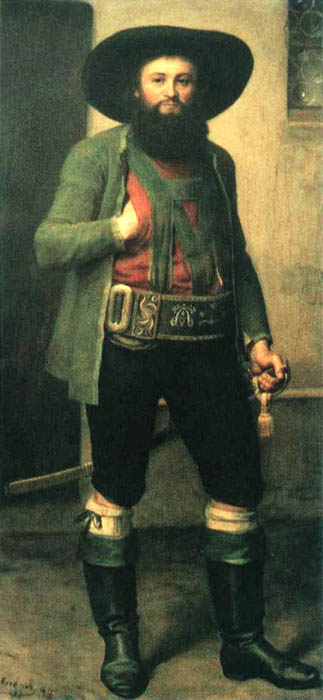
Fig. 3: Franz Defregger: Andreas Hofer, 1894, oil on canvas, Tiroler Kaiserjägermuseum, Innsbruck (© CC-BY-4.0 CC)
Tourist purposes in the course of 19th century
A steady evolution of this appearance towards hypertrophic splendor (cf. Ramming 1997, p. 119) could be observed. Whom did the vineyard keepers want to impress? Did the scary outfit or its models also have the function of a lure, even a courtship dress? One could speculate a lot about this, as well as the question of the addressees and the success of this posing in the rural environment. Indeed, there were harsh rules that state how vineyard keepers had to behave towards women (cf. von Hörmann 1872). Like the myths of nocturnal seduction attempts by witches in the vineyard, they also point to the possibility of their transgression (Matscher 1933, p. 217). The clearest indications of courtship even in the sexual are found indirectly where the vineyard keepers discovered their tourist attractiveness in the later 19th century. Here it was not only a matter of inspiring the exoticism expected from the outside. The Saltner in the role of „Papageno“ (Halbritter 2005, p. 88) offered a masculine performance to a changing — even female — audience, too. And the public, frightened by the wild man in the vineyard, gladly paid for this thrill with the usual, officially regulated tax for trespassing — and then sent a postcard with a picture of such a strange imposing guy out into the world (op. cit. p. 88-104, fig. 4).
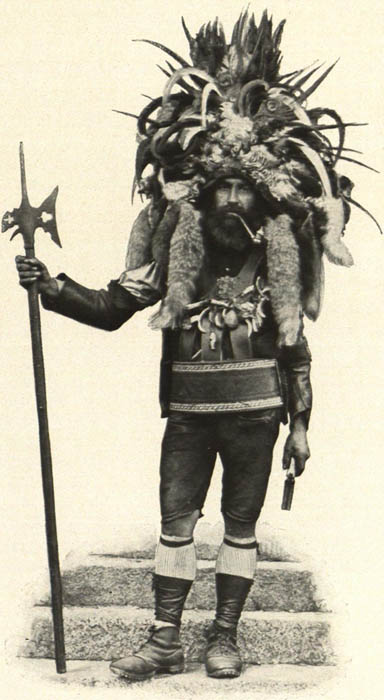
Fig. 4: Meraner Saltner. Postcard sent 1907. © CC-BY-4.0 austria-forum.org
Use in the attempt of nation building until after 1900
The emergence of traditional costumes in the 19th century was due to an increased interest in regional distinctiveness. The dependence on supra-regional trade, a corresponding desire for a special appearance and the burgeoning tourism in picturesque South Tyrol drove this development further. The purchase of the object by the GNM in 1899 was completely in line with the museum's historistic concept. Unique characteristics were to be collected to support the idea of nation-building in the German-speaking area which includes parts of South Tyrol (Austria till 1918, then Italy) too. The interest in the costume can thus be attributed to an implicit concept of „Großdeutschland“, the desire for identification even far beyond the national borders of that time (and also today). In 1905 the Saltner-figurine became a part of a multi-figure panorama of German traditional costumes in the museum. But 100 years later Jutta Zander-Seidel, curator of the exhibition „Kleiderwechsel“ (that means "change of clothes") at the GNM judged harshly about the former exhibition practice: Neither does the object represent the peasant costume of the past in its historical authenticity, nor does it reach beyond documents of historicized festive culture at that time (cf. Zander-Seidel 2002, p. 76).
From carnival use to cultural appropriation and appreciation
On top of that, the object wasn't even bought in South Tyrol at all, but from a Munich costume fund. The painter Franz Defregger is said to have worn it at a Munich artists' masked ball in 1883 (Ramming 1997, p. 16-18). Was it merely a product of his imagination, made to poke fun at the strangers across the near borders, at those archaic mountain people with their culture, which at the time was perceived as weird, backward, even exotic? There is evidence that Defregger designed costumes too (Irgens 2010, p. 14).
Then it would also be possible that parts of the costume were actually copied, e.g. by using early photographs of Native Americans, perhaps to make the appearance seem even more exotic. The foxtails hanging down on both sides of the face, the necklace of wild animal teeth or the splendor of the feathers come quite close to such cliché images. And Franz Defregger showed great interest in Chief Rocky Bear, for example, whom he met and portrayed in 1890. Rocky Bear had come to Munich (Bavaria) with Buffalo Bills' Wild West Show as a living exhibit (Assmann e.a. 2020, p. 123). But this was seven years after the masked ball. In addition, the object at the GNM is said to have been touched up in the early 20th century, so that it could fit the cliché of the pictorial and written sources of the 19th century even better (Selheim 2005, p. 274).
In the same supposedly colonialist view, Defregger made a painting for an Austrian encyclopedia called „Kronprinzenwerk“ (1885-1902, fig. 5). In this illustration, the figure of the Saltner is used just as clichéd and exoticizing for his country, Tyrol, as we know it, e.g. from images of snake charmers and the Indian subcontinent. But the picture shows a man who looks much like both the Nuremberg specimen – and the artist himself. Could this still be a form of self-exaltation, an act of othering (Said 1985)? If we take into account that Defregger himself was a native Tyrolean, this perspective escapes its chauvinistic dress and shows us a completely opposite form of individual expression and a corresponding search for identification: When abroad, the successful painter dressed like a person of status in his native country.
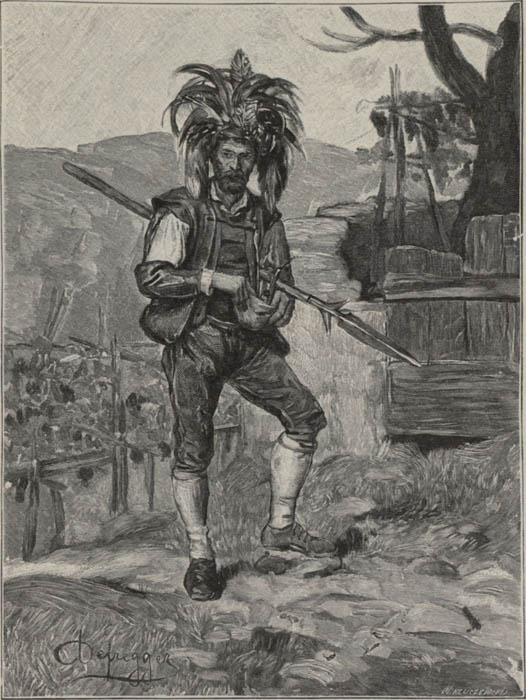
Fig. 5: Franz Defregger: Ein Saltner bei Meran. 1890, Xylography by M. Kluszewski. © CC-BY-4.0 austria-forum.org
Conclusion
It has taken one century for this change in function to be clearly named in the GNM (cf. Zander-Seidel 2002, p. 148): from an uncertain practical object of use to a product of tourist expectations, from a carnival costume to a decided construction of national identification and back again. The outfit of the vineyard keeper is neither particularly artistic nor valuable. But the questions it is able to generate lead far into a dense field of visual communication across times, national borders and continents, to ideas of foreignness and (self-) exoticization and ultimately to the question of how we deal with them today. The costume of the Saltner and its related outfits seem to come from the supposedly “good old time“. But they illuminate a rather fleeting moment in which historical upheavals in Europe (e.g. early globalization, increased emigration, advanced secularization, consequences of colonialism, desperate search for identity and nation building) are reflected in a peculiar object. They can lead to the question of how to deal with other traditions on the one hand or with the individualization of (male) appearance (e.g. in the later star cult) on the other. The fact that a whimsical hat can still serve an extremely dubious yet visually powerful purpose today was demonstrated by the million-fold shared footage of the self-proclaimed "shaman" storming the Washington Capitol in early 2021.
Special thanks to my students at Gymnasium Wendelstein who enriched this analysis with plenty of valuable questions and discoveries.
References
- Assmann, Peter/Irgens-Defregger, Angelika/Hess, Helmut. 2020. Defregger. Mythos — Missbrauch — Moderne. Innsbruck, München: Hirmer.
- Ramming, Jochen. 1997. Weinberghüter und Heimatwächter. Der ‚Meraner Saltner‘ zwischen Amt und Emblem. In: Jahrbuch für Volkskunde 20. Paderborn. München. Wien. Zürich: Schöningh. p. 116-141.
- Halbritter, Roland. 2005. Saltner – Weinberghüter – Touristenschreck – Vogelscheuche – Papageno – Alpenindianer. „Ihm gebe Kreizer a comprar tabacco; dann still sein gut Freund“. In: Der Schlern, Bozen. August edition 2005, p. 88-104.
- Irgens, Angelika. 2010. Was Tiroler und Indianer im Herzen verbindet, Bayerische Staatszeitung (BSZ). 23.04.2010 (ePaper) and: Unser Bayern 4/2010, München (Verlag Bayerische Staatszeitung)
- von Hörmann, Ludwig. 1872. Die Saltner. In: Der Alpenfreund, Monatshefte für Verbreitung von Alpenkunde unter Jung und Alt in populären Schilderungen aus dem Gesammtgebiet der Alpenwelt und mit praktischen Winken zur genußvollen Bereisung derselben. Dr. Eduard Amthor (ed.), Volume 5, Gera, p. 41-47, proofread for SAGEN.at by Mag. Renate Erhart, august 2005. Spelling carefully reworked and brought up to date: http://www.sagen.at/doku/hoermann_beitraege/saltner.html. Called on 7.02.2021
- Matscher, Hans. 1933. Der Burggräfler in Glaube und Sage. Bozen 1933. Found at sagen.at and carefully reworked by Leoni Wallner. December 2005. http://www.sagen.at/texte/sagen/italien/meran/burggraefler_matscher/wimmetzeit.htm. Called on 7.02.2021.
- Said, Edward. 1985. Orientalism: Western Conceptions of the Orient. London: Penguin Books.
- Selheim, Claudia. 2005. Die Entdeckung der Tracht um 1900. Die Sammlung Oskar Kling zur ländlichen Kleidung im Germanischen Nationalmuseum. Published by Germanisches Nationalmuseum Nürnberg.
- Zander-Seidel, Jutta (ed.). 2002. Kleiderwechsel. Frauen-, Männer- und Kinderkleidung des 18. bis 20. Jahrhunderts (Die Schausammlungen des Germanischen Nationalmuseums). Published by Germanisches Nationalmuseum Nürnberg.
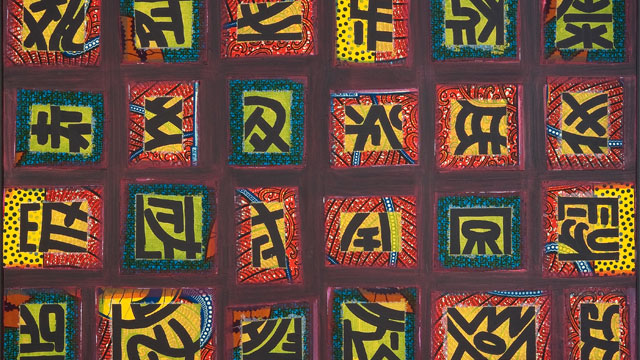
-
 Stefan Eisenhofer
Stefan EisenhoferIn 1971, El Loko moved to Germany to study sculpture, painting and graphics with Joseph Beuys, Rolf Crummenauer and Erwin Heerich at the Staatliche Kunstakademie Düsseldorf, where he graduated as a master student in 1977. He created woodblock prints, sculptures, installations, drawings, graphics, photographs, paintings and performances in almost four decades, using an extremely wide range of working techniques and forms of expression. El Loko participated in numerous solo and group exhibitions on several continents and his work has been widely published. In addition, he repeatedly organised workshops for artistic and intercultural exchange in Europe and Africa.
El Loko, who lived and worked in Cologne (Germany) until his death in 2016, was one of the first African artists to venture into the art worlds of the West. His autobiographical book "Der Blues in mir" (The Blues in Me) - published in 1986, written in German and illustrated with woodcuts by the author - vividly recounts how he had to fight for and invent his identity and his path as a human being and artist at that time.
In Germany, El Loko experimented from 1972 onwards primarily with woodcuts before turning to painting in the mid-1980s. His series "Landschaften" (Landscapes), which interspersed colourful architectural elements with human faces, bodies and body parts and aesthetically dealt with the theme of threat, confusion and alienation in an urban context and how to overcome them, subsequently gained great popularity.
Subsequently, it became characteristic of El Loko that, for all the diversity of his work, he took up certain themes almost cyclically. His series of works "World Faces", "Cosmic Letters" and "Figure Landscapes" played a special role here, which he reinterprets again and again, seeking different perspectives and positions. Through a non-hierarchical treatment of the face or the bust portrait, the "World Faces" convey the vision's striving to abolish the differences between people of different origins, world views and gender. A utopian striving for a universal language and a global identity manifests itself in his series of works "Cosmic Letters", in a sense an alphabet of his own characteristic visual language. In paintings and pigmented steles made of wood and steel, El Loko combines ornaments, figurations, signs and ciphers of different origins and strives, by means of this symbolic sign language, for an art language that can be understood worldwide and for the construction of a meaningful world of his own.
Inspired by Joseph Beuys and the dissolution of the conventional bourgeois concept of art, El Loko also turned to temporary art actions from 1976 onwards. He developed his "duel performances", which combined poetry, song and drum rhythms and were characterised by the principle of rhetorical surprise and immediate reaction to each other.
In his installations, El Loko deals primarily with Western images of Africa and clichés in an often provocative manner. In his popular work "How to explain pictures to a pack" (1995), he ironically takes up Joseph Beuys' action "How to explain pictures to a dead hare" (1965): A gathered pack of 70 animals stands in front of a map of Africa hanging on the wall, composed of various elements and symbols like a puzzle. With this installation, El Loko not only posed questions about images of Africa, but also traced his own situation at the same time: The pack as the world that lies outside of him looks on the one hand expectantly, on the other hand more or less uncomprehendingly at him as an artist. In "The eternal mask" (2006), the artist painted 50 portrait photos of Africans with acrylic, alluding to Western views of African people: Through the disfiguring colour, the faces lose their individuality, become anonymous and frightening. In his work "Africa down", partly done in Cologne (Germany) and finished in Cape Town (South Africa), El Loko addresses the positions of Africans in the world. The visitors to the exhibition were forced to walk on 256 photos of Africans and 53 African national flags lying on the floor, through which the artist makes the oppression and devaluation of Africa and its people through colonialism and through corrupt, selfish and ignorant African rulers almost physically comprehensible. His provocative installation "Mohrenköpfe - Hohlköpfe" (2005), which questions the role of kleptomaniac politicians of black skin colour who systematically ruin their own continent and do not care about cultural matters or the economic or social development of their countries, aims in a similar direction. As in all his works, El Loko was not interested in simplistic answers or accusations, but in a serious examination of painful and uncomfortable topics as well.

Image 1: Vogelakrobatik, 1996, 250x30x20 cm // Image 2: PE.VO.TO.7, EL Loko, 2017, 135x99 cm // Image 3: El Loko at Museum Fünf Kontinente (Karin Guggeis, El Loko, Stefan Eisenhofer) // Image 4: Dokponou (Der Gescheiterte - The failed), El Loko, 2013, Acrylic on canvas, 80x120 cm. // Image 5: Vogelakrobatik, 1996, 250x30x20, Museum Fünf Koninente, Munich. All images: Copyright Museum Fünf Kontinente, Munich.
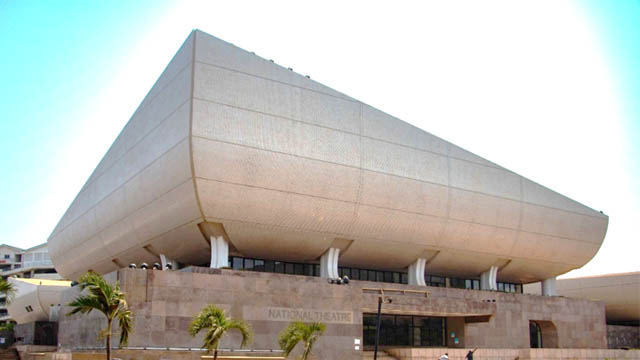
-
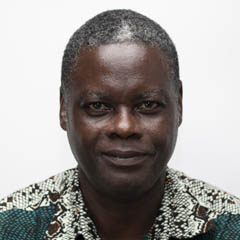 Ebenezer Kwabena Acquah
Ebenezer Kwabena AcquahThis essay seeks to draw readers’ attention to the National Theatre of Ghana in order to recognize its relevance within the country’s visual cultural landscape. The National Theatre is a monumental edifice situated in the nation’s capital, Accra. It is supported by the government, and largely devoted to musical performances and stage productions, among others (Wilson, 1988). Theatrical performances in the National Theatre are part of the nation’s cultural heritage and present the people with creative thoughts and reflections on life. The establishment of the National Theatre of Ghana was, to a large extent, largely supported by the National Theatre Movement of the 1950s by cultural experts like Efua Sutherland and Professor J. H. Kwabena Nketia (Agovi, 1990).
The National Theatre was completed on December 16, 1992, commissioned and handed over by the Peoples Republic of China to the Government of Ghana on December 30, 1992 (www.nationaltheatre.gov.gh/history/ retrieved 2020, August 7). The Theatre was designed to be used by people from all walks of life and diverse age groups. Since its inception, the National Theatre has hosted a number of performances and exhibitions from both local and international communities with the intention of promoting visual culture in a heterogeneous global landscape.
Location, Structure, and Artistic Appreciation
The boat-like building is located near the junction of Liberia Road and Independence Avenue, adjacent to Efua Sutherland Children’s Park, in Accra’s central district.
Three distinct structural forms comprise The National Theatre building, with each structure housing its own performance group/company: the National Theatre Players, National Dance Company, and the National Symphony Orchestra. A closer look at the entire structure reveals three distinct parts aside from the structural forms mentioned earlier. The upper part portrays three boats joined together, supported by rectangular piers with curved outward projections, and a rectangular base with entrance and exit openings. In fact, the entrances and windows seem to be carved out of the rectangular base. All of the entrances are elevated from the ground level with a staircase, which leads up to the glass entrances and into the building (https://3rdworldarchitecture.wordpress.com/2018/02/04/national-theatre-of-ghana/ retrieved 2020, August 7). The base is designed to create a projection at the entrance that provides visitors with the necessary protection from inclement weather.

National Theatre. Aerial view over National Theatre. Photo: Cheng Taining, 1997, link: https://archnet.org/sites/1413/media_contents/15315.
Above the base, there are distinct white forms. They taper upwards from the centre and meet towards the outside of the base. The walls curve inwards and are lifted just above the solid base, with glass in between them, making the base and white forms more distinct and thereby reinforcing the differences between them. Small white tiles cover these forms, giving the building its shape and colour. A closer look at the shape of the National Theatre reveals a display of three boats/canoes or fishing vessels that meet at a central point, which takes the form of a captain's bridge. The entire structure is supported by curvy piers and rests on a rectangular base as presented in the image above.
A careful study of the architectural ‘language’ of the National Theatre reveals a combination of interior and exterior Asian architecture, symbolic Ghanaian forms and boat construction. Generally, Chinese architecture is based on the relevance of influential local cultural traditions and adherence to hierarchy (Lianto, 2020). It prioritizes spatial designs with balanced symmetrical central pivots and a reverence for nature and aesthetics. Additionally, the dominant use of red represents happiness, which is also found throughout the interior of the National Theatre.
The curvy structure of the theatre in general nods towards Asian architecture. The seating space is segmented along stepped floors and the undulating structured ceiling is reminiscent of waves with openings defined by lighting systems. In fact, the use of sculptural forms and other Ghanaian art works effectively combine with the architectural structure to convey the visual cultural landscape of the National Theatre.
Sculptures in Public Space
Sculptural forms executed by Ghanaian artists are carefully displayed outside the National Theatre. The following image shows a sculptural work that depicts a Sankofa, a traditional Ghanaian symbol.
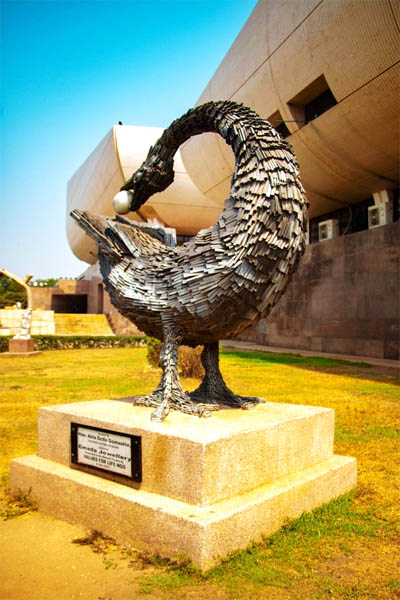
Emefa Jewellery, Sankofa, 2015, H: 11ft., Presented by Values for Life NGO to the National Theatre, Photo: Wisdom Dzigbordi.
The Sankofa represents taking the opportunity to reflect upon the past and applying significant and relevant ideas to current developments. Thus, the past has something relevant that must be considered and utilized as part of contemporary practice.
Education and Cultural Relevance
The National Theatre of Ghana is a significant cultural centre in Accra, Ghana and the entire form of this visual cultural structure provides people from diverse walks of life a place for entertainment and relaxation. The building is a visual architectural icon for the city and is an influential hub for creative art performances. It therefore serves as an important edifice to promote the arts, offering both Ghanaian and foreign artists a place to express their creativity.
In addition to providing entertainment and relaxation, the theatre seeks to educate people and stakeholders (who periodically use the place) on the responsibility of the National Theatre of Ghana as a strong cultural institution that ensures the development of culture, including the performing arts, and the need to respect cultural values. Through this education, the activities of the theatre are brought into focus, preserved, promoted and transmitted to the next generation for posterity and the promotion of visual culture across the world.
References
- Agovi, K. E. (1990). The origin of literary theatre in colonial Ghana, 1920-1957. Research Review, 6(1), 1-22.
- Frimpong, M. (2015). Towards an audience development plan for the National Theatre of Ghana. Unpublished Thesis. University of Ghana, Legon.
- Lianto, F. (2020, August 9). Building structure system of Chinese architecture, past and present. Retrieved from https://www.academia.edu/33602498/BUILDING_STRUCTURE_SYSTEM_OF_CHINESE_ARCHITECTURE_PAST_AND_PRESENT
- National Theatre of Ghana (2020). History of the National Theatre of Ghana. Retrieved on January 10, 2020 from http://www.nationaltheatre.gov.gh/history
- Wilson, E. (1988). The theatre experience (4th ed.). New York: McGraw-Hill Book Company.
- 3rdworldarchitecture.wordpress.com (2018, January 4). National Theatre of Ghana. Retrieved from https://3rdworldarchitecture.wordpress.com/2018/02/04/national-theatre-of-ghana/
published August 2020
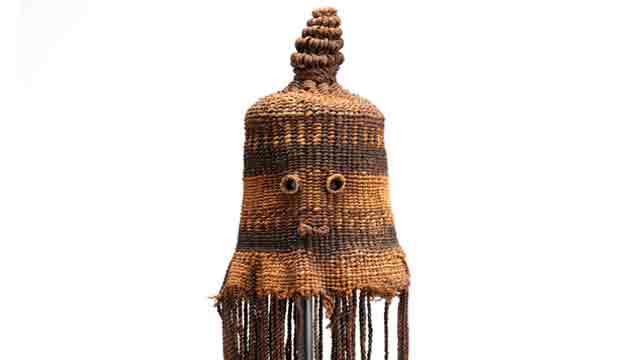
-
 Njeri Gachihi
Njeri GachihiMeaning
Ingolole serves several purposes in the circumcision ritual. It serves to mystify the ritual and more so the initiate. While wearing almost identical masks, the initiates become undisguisable in this full seclusion regalia. It is believed that even evil spirit sent would have a problem identifying the target and hence revert to sender. On the other hand, the masks also serve to wade off and scare women and children who are not supposed to interact with them during the seclusion. Even when they go out of the forest and make processions on major roads singing and dancing, the women and children should stay away. Part of the chants, dance and singing done is meant to break loose ‘childhood/boyhood’ which is symbolized by the breaking of the crown - palm reeds attached on the ingolole. Some do manage to break it which is a sign of physical strength and masculinity as well as spiritual and ritual wellbeing.
The dance that the initiates perform is know as bukhulu/bakhulu which means elder. Bukhulu henceforth, cosmologically viewed, means unity with the ancestors and is also used to symbolize fertility or the life-giving seed (seminal fluid). The effort of breaking the reed henceforth translates into becoming an adult and gaining all the permission to undertake the adult roles and the responsibilities associated with it. This means that this right gives the initiate the ability and power to engage in full conjugal and social responsibility. Last but not least, the initiates spend a lot of time in the open. Ingolole then serves to protect them from the scorching rays of the sun, protect them from sweating too much when dancing and at night serves to protect them from biting cold, wild animals and insects.
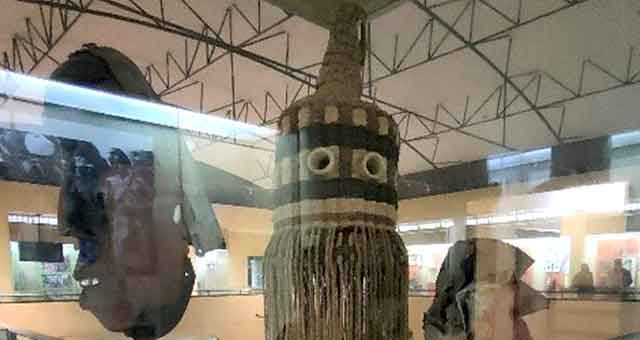 Cutout: Presentation at Nairobi National Museum, Ingolole (Circumcision Mask), Museum Fünf Kontinente and Nairobi National Museum. Photo: Njeri Gachihi.
Cutout: Presentation at Nairobi National Museum, Ingolole (Circumcision Mask), Museum Fünf Kontinente and Nairobi National Museum. Photo: Njeri Gachihi.Is Ingolole an Artwork or a Ritual Object?
The ingolole as a form of ritual art, seems to bear witness to the resilience of the Tiriki culture; what Bakhtin might have called the 'carnivalization of the social order'. A central reason for using this mask, it seems, is to affirm the Africanization of the arena, both public and private, where a culturally appropriate image reigns. The mask usually invests the wearer with signs of power over evil, while modelling him on the norms of masculinity and respectability. The ingolole is one item of art that is yet to be transformed from artefact to curio (or momento). This is apparently so because its mechanism of distinction is yet to mobilize political as well as economic categories. This mask resonates well with the notion that visual art communicates cultural values. It is a complex ideological communication that derives its symbolism and references from culture. Yet it also draws its form and content from the fundamental tenets of the magical appropriation of power through the manipulation of depiction and elucidation.
Therefore, the Tiriki Circumcision mask, Ingolole is not only an artistic representation. It is a ritualistic object that embodies several meanings. It is known to invest the wearer with signs of power over evil - in that the wearer is set apart from his enemies that would intend to inflict harm. It is believed that the evil spirits sent to cause harm on the initiate would find it difficult to positively identify the initiate. At the same time, it causes mystery around the initiates making their looks terrifying and hence keeping off those who are not permitted to come near newly initiates. Physically, it protects the young boys from scorching sun, biting cold and insects while in seclusion. Once ingolole is used, it is kept and passed on from generation to generation. A used one is still valuable to the family and must be kept safely to avoid causing harm to the members of the family. Hence, this is an item of art that cannot be easily transformed from a ritualistic artefact to a simple curio craft.
There are not many Ingolole’s in our Museum in Nairobi. Two are however exhibited in the permanent exhibition, Cycles of life, at the Nairobi National Museum.
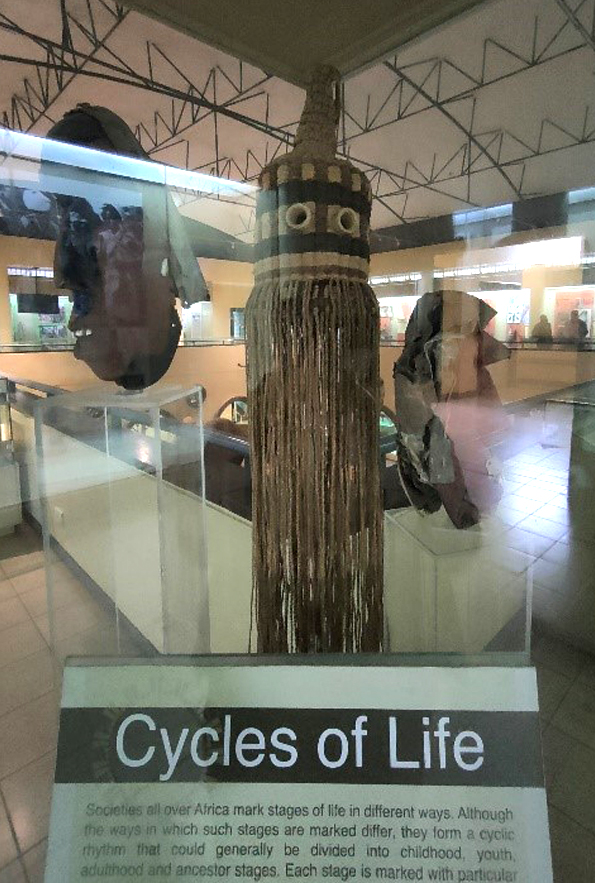 Presentation at Nairobi National Museum, Ingolole (Circumcision Mask), Museum Fünf Kontinente and Nairobi National Museum. Photo: Njeri Gachihi.
Presentation at Nairobi National Museum, Ingolole (Circumcision Mask), Museum Fünf Kontinente and Nairobi National Museum. Photo: Njeri Gachihi.
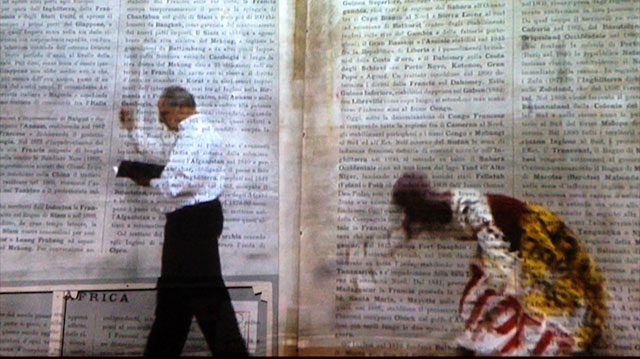
-
 Elfriede Dreyer
Elfriede DreyerOriginally, South Africa was discovered by the Portuguese in 1488, but this was not permanent, just like the Dutch settlement in 1652 that is generally viewed as the birth date of the country. In 1795 the Cape Colony fell under British rule again; it reverted back to Dutch rule in 1803; and again to the British in 1806. From the onset of colonisation, the transatlantic slave trade was immense and especially South-East Africa was a main source of slaves. The colonisation of Southern Africa had as main purposes the setting up of refreshment posts where food and other essential stock could be collected, as well as the trading of slaves. The indigenous nations were subject to the whims and fancies of the colonisers, and they were sexually and labour-wise exploited; families were broken up and those who resisted were punished and often killed by whipping, shackling, hanging, beating, burning, mutilation, branding and rape. In many cases the slave ships themselves were killer machines since the slaves were packed into the haul like sardines with little attention to hygiene.
In addition, South Africa is extraordinarily rich in mineral resources and gold, which has brought about massive wealth, but also instability. Johannesburg was established in 1886, due to the so-called gold rush, with fortune seekers and diggers flooding to it from all over the world to the country. Since then the gold mines have attracted an influx of locals as workers, which contributed to much nomadism, but especially since 1948 during apartheid, such mine workers were ironically allowed to work underground but once aboveground they had to return to townships outside the large city.
Since 1948 when the country became locally governed by the Afrikaner-dominated right-wing National Party, whilst still regarding Queen Elizabeth II as head of state as a relic of British imperialism, attempts were made to throw off the colonial yoke permanently, and on 5 October 1960 the country became an independent Republic. At all times there have been resistance to the ruling governments by groups of all cultural origin, but especially during the 1980s and early 1990s there was severe resistance to the ruling policy of segregation: a period that saw much abuse, violence and many incarcerations. In 1990 Nelson Mandela as leader of the oppositionist African National Party was released from prison and in 1994, as part of a peaceful handover, he was inaugurated as the new president of the country with the ANC as government.
It is clear that, as a country, South Africa has been torn apart by politics, and especially by the impact of colonisation. The postcolonial impulse is therefore inordinately robust in this part of the world. The notion of the postcolonial is closely linked to that of the postmodern, and according to Gen Doy (2000:204), author of Black Visual Culture: Modernity and Postmodernity, much of current art practice is “often relating to issues discussed in postcolonial theory such as identity, displacement, mixing of cultures and peoples (hybridity) and indeterminancy.” Post-colonialism could be viewed as a response as well as a resistance to colonialism, whereby issues such as historical events, beliefs, traditions, conventions and languages are evaluated and critiqued in an attempt to uncover the superiority and centrality of certain systems of thinking. Ideas of superiority and power relations play a core role in postcolonial investigations, but a main problem in much postcolonial theory is to nurture the idea of static black culture, which in reality is constantly changing and adapting to new developments and ideas. Decoloniality or decolonialism originated as a Latin American movement which focuses on understanding modernity in the context of a form of critical theory applied to ethnic studies. Similarly it is a response to colonialism. It seems to be more radically critical than postcolonialism which indicates more of a general resistance. Coloniality is generally understood as the sentiment and logic essential to the evolvement of Western civilisation from the Renaissance to today. Foundational to decoloniality is the deconstruction or decoding of the coloniality of power. This logic is commonly referred to as the colonial matrix of power and has its own set of theories and methodologies.
Since the 1980s, the work of internationally renowned South African artist William Kentridge (b. 1955, Johannesburg) has mainly served the purpose of commenting on socio-political issues in the country. He is best known for his prints, drawings, operas and animated films. A work of special interest is his The refusal of time of 2012 (hereafter referred to as ‘TRT’), since it presents a clear image of postcolonial legacies and decolonial sentiments that have resulted in an eclectic mélange of narratives, experiences and events. Particularly interesting is also how the artist mixes various kinds of technologies in sophisticated way.
TRT premiered at Documenta 13 (2012) in Kassel, Germany, specially commissioned by the curator of Documenta 13, Carolyn Christov-Bakargiev, and since then it has been exhibited at various other venues in Japan, Italy, Australia, the United States, Brazil, Holland and Finland. The work was produced in the artist’s studio in the Maboneng district in downtown Johannesburg and as a prelude to Documenta 13, a series of notebooks entitled 100 notes – 100 thoughts was published by Hanje Katz in 2011. In South Africa, the artistic production was shown first from November to December 2014 at the Johannesburg Art Gallery and then at the National Gallery in Cape Town in 2015. A collaborative piece, the artwork entails teamwork with Peter L. Galison, Philip Miller and Catherine Meyburgh. The chamber opera, Refuse the Hour (made in collaboration with Miller, Meyburgh, Dada Masilo and Galison) - with an international cast of eleven, including dancers, musicians, performers and vocalists - is the theatrical accompaniment that laid the groundwork for the artwork and is also an independent production. Prominent in the production is the artist presenting a lecture-performance on productive procrastination, myth, entropy, empire, black holes, the ancient Greek myth of Perseus and Einstein, surrounded by animations, swirling dancers, singers with megaphones, instrumentalists and a solitary physicist (BAM | Refuse the hour 2015).
As an installation, TRT comprises five digital film projections on thirty-minute loops and a large automaton, occupying the entire space of a single, large hall. In the dark enclosed space of TRT, a hive of moving figures and intersecting stop-frame imagery ensues in the five film projections, creating an impression of vibrating energy. The complex imagery includes the artist as one of the performers, walking, reading and performing acts such as changing hats; a female figure, dancing and producing ‘wagon wheels’ and other acts; figures in comical scenes in colonial rooms à la George Méliès; figures in a laboratory-like space, maybe busy with experiments; dispersing and flying anamorphic fragments becoming human figures, representing a kind of chaos rendering; a rhinoceros; silhouettes; ticking metronomes and clocks; and imagery of inter alia megaphones, starry skies, stop-frame animations and drawings. On the other hand, chaotic time is presented as humanly, existentially and imaginatively inferred. Mortal conceptions of the physical body appear in the form of chaos imagery of disintegrating matter; and swirling moving figures, transgressed boundaries, and fleeting script and words render an awareness of temporality and transience in order to defy conceptions of certainty and fixed systems. The moving human agents in TRT ‘transgress’ the confines of the delineated boundaries of each projection by walking across the edges, and by so doing become displaced and emplaced in in-between, liminal zones.
Kentridge positions the human body centrally in TRT. Technically, his scientific and conceptual method levies each projection that transforms intermittently from the graphic, more abstract imagery into the stop-frame animations to human figures (including the artist himself performing), clothed idiosyncratically in contemporary as well as traditional outfits. Other transmutations include a turn to colonial comical scenes with actors performing in rooms with historical architecture; walking and dancing figures; and figures in shadow procession, recalling some of Kentridge’s well-known earlier works. The sculptural automaton and ticking metronomes are given equal presence in the five film projections, which generates the comment that technological development has shown progress from elementary, handmade technologies to advanced digital technologies, but that the embedded techniques and processes are equally relevant.
In TRT, preference is given to a conceptual engagement with the human technological condition instead of a lofty statement about science itself. Kentridge ‘relegates' science to technology and succeeds in generating comment and meaning through the very processes of the techniques used. In the five ancillary virtual ‘rooms’, an artificial environment has been created, entrenched in the technologies of the digital age, which has borne witness to emerging engineerings such as electronic communications, artificial intelligence and biotechnology. Symbolically comment is generated in terms of politics as ‘experimentation’ and human beings as the victims thereof. Set in virtual reality, the rooms in the Méliès-type comical scenes in TRT resemble colonial architecture, but notably these are graphically hand-drawn. Through very technique of the linear and expressive sketching of doors, windows and other paraphernalia, heterotopic ‘frames’ are created that resonate with the racial and gender regimes of the histories of colonial culture in South Africa. Several spaces are represented in the work, but in a dualistic sense they are both material and immaterial, and ambivalently premised.
The flying particles in TRT subtly reveal thin red lines, crossing and indicating geographical points of intersection, but without explanation of what they represent. Metaphorically they could function as boundaries, relational reference points, historical markers, psychographical moments or points of reference wherefrom the ‘walk’ into time takes place or even the liminal ‘place’ where life and death meet. The particles become chaotic and finally disintegrate, almost in reflection of the processes of memory and how everything fades in time.
References
Doy, G. 2000. Black Visual Culture: Modernity and Postmodernity. Gen Doy London: I.B. Tauris.
About the artist
William Kentridge (born 28 April 1955) is a South African artist best known for his prints, drawings, and animated films. His political perspective is expressed in his opera directions, which involves different layers: stage direction, animation movies, influences of the puppet world. He has staged Il retorno d’Ulisse in patria (Monteverdi), Die Zauberflöte (Mozart) and The nose (Shostakovich). Berg's Lulu premièred at the Metropolitan Opera in New York, and in 2017 Wozzeck (Alban Berg) premiered at the Salzburg Festival.
published February 2020
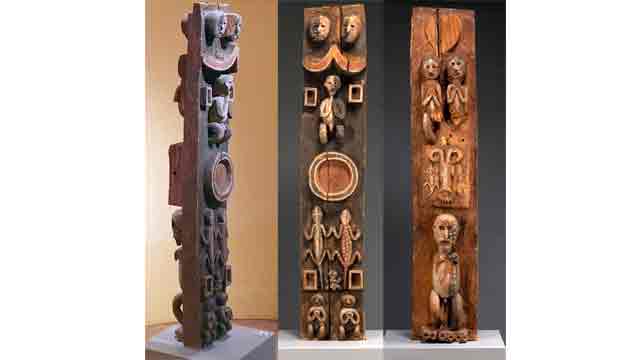
-
 ELVIS NKOME NGOME
ELVIS NKOME NGOMEThe selection of informants was randomly done as we were only interested in identifying the most relevant resource persons within the research areas like members of defunct and existing regulatory societies, traditional rulers, herbalists, and other village notables with measurable experience in material culture and their symbolisms which is the interest of the author in this paper. The paper consists of three parts: an introduction, the background issues or the historical antecedence, and the core, which deals with interpretation of the motifs on the objects, significance and ends with a summary.
African arts and cultures predates the colonial and missionary encounter in Africa. Some of the works provide useful information about indigenous craft industries such as pottery, carvings, iron metallurgy, weaving and much more. This article made use of works of earlier scholars who discussed aspects linked to the current paper. I also exploited some archival records, for example, file No. E.P.4929, entitled “Assessment Report [on] Bali, Bamenda Division- Cameroon Province (1925) by W.E.Hunt, District Officer, National Archives Buea, NAB. The works are framed into three broad thematic: objects made out of clay; objects made out of iron, and those produced out of wood and forest fiber materials.
Wooden Carvings and Clay Objects
Traditionally, the Bamenda grass fields and the Western Grassland regions of Cameroon are known for their mastery in the production and commercialization of various art works. In this region, craftsmanship is believed to be handed down from one generation to the next; from father to son. Grassland traditional architecture, objects, and symbols were unique from the point of view of their aesthetics, decorations and uses. In the 19th Century, a German Military Officer, Hans Glauning’s Official Report of 1906 on the Pre-colonial Nso (Banso) described grasslands houses in the following words:
The Banso houses, some 5-6 meters high to the roof, are [were] roomy and neatly built in Grassland style. The floors are paved with small pebbles. Each village has at least one meeting and drinking hall with carved door posts. Both frontages of the meeting house in Kumba were hung with about 900 skulls of Bamum and Nsungle warriors…[1]
The above extract clearly describes the pre-existing cultural and social institutions the European came across in the Bamenda grassland in early phase of the 19th century. The people were talented carvers, weavers and painters. The most remarkable designs were and are still royal stools, bangles, and door / window frames on houses that helped to show various layers or classes in society. On the door or window frames for example, were carefully carved motifs of animals and other selected creatures. The motifs were interpreted and symbolized cultural and political differenceswhich the society was aptly stratified.
According to Knopfli (1995a, 2000b) the carved posts were sometimes awards from the Fon, Kwifo as gifts to some notables, cult members, or other great men. These sculptures on wooden frames sometimes depicted great societal achievements of fons and great men and women in society. Also, in royal circles, such sculptures bore symbolic representations of warriors, heroes, and royal animals such as buffalo, lion, python, elephant and leopard appeared conspicuously carved on the chosen object. Other creatures like lizards, tortoise, and scorpions were widely engraved on Grass field arts. Besides, inanimate objects like iron gongs and cowries were represented on objects.
The zoomorphic and anthropomorphic Ethno-historical Dimensions of Cameroonian Carvings
To better appreciate the origins and meaning of some of the animal motifs on artistic objects, it would be important to understand the cultural and philosophical dynamics of some of the zoomorphic motifs on the objects and what they represent. There are different animals reproduced in aesthetic designs by the carvers like lion, scorpions, tigers, toads, various species of lizards and a host of other non-living things. However, for the purpose of this paper, we shall focus more on the lizards depicted on the wooden board (the ‘Blue Rider Post’). As far as lizards are concern, Hans Knopfli (1990), studied various kinds of lizards which were/are common in the Western Grasslands of Cameroon. The stylistic motif of lizard is one of the most common designs in wood sculpture in the region, but also in many forest areas of Cameroon such as in Kribi in the South Region, amongst the Ejagham group in Manyu and Meme Divisions in the South-West Region of Cameroon. Generally, lizard motifs, or appear on various works of arts such as royal stools, masks, doorframes, drums, clay pots, title cups, and on embroidered robes and caps.[2]
However, the actual meaning of the lizard symbol is not quite clear. Knopfli noted that lizards are treated with maximum respect in the grassland. The belief about lizards include the idea that twins, chiefs and ancestors can transform themselves into lizards and that lizards have the spiritual ability to drive away witches. These however, does not close the page on their relevance in the cultural settings of different communities. In Africa, different groups perceive lizards differently according to their customs and traditions which have of course redefined their outlook as a people. There are three main types of lizards common to the grassland groups: the rainbow lizard (known in Bafut as kwifongu).[3] Another type of lizard is called the majuku lizard in Bafut language. This lizard is used by witch doctors to send and direct lightning in cases of theft, adultery, land stealing etc. Apart from the majuku, there is also the kukub (Mungaka language) lizard. This is a smooth skinned lizard with a long tail and it is very swift running lizard.
In Mungaka language it is called kukub, in Bafut language it is called akongse and in the Babanki language it is called fekeke, while Bakossi called it ebote-ngule. Worthy to note is the fact that most of the grassland sculptures carried this and other kinds of lizard motifs on door and window frames as well as traditional stools. Such insignia symbolized authority and deity, and life (Knopfli, 1990:58) In recognition of the above notion, one is tempted to argue alongside Knopfli that lizards therefore symbolizes life. He further states that any design of two or three rows of lizards round a stool with interlocking fore and back legs expresses the fullness of life.
Interpretation of the Motifs on the ‘Blue Rider Post’: New Perspectives
The information that follows herein is a fair, reliable and verifiable opinions of our informants who after careful examination of the photographed images gave their interpretations of the motifs on the ‘Blue Rider Post’ in its entirety. It is important to point out that the motifs are zoomorphic (animal), anthropomorphic (human-made) and inanimate gestures in the form of dots and circular/square indications.
The object has two sides which are embellished with similar motifs. The motifs include: dark patches, white dots, red marks, two human-like heads at the top, lizards, squared shape, circular shape in the middle of the object, and at the bottom, two human figures or deities. It is important to look closely at the object in order to have a clear interpretation of its motifs. According to recently collected data, the various marks like red, white and black confer or indicate various meanings according to the customs of the resource persons and sampled communities in Anglophone Cameroon. In this connection, the white colours stands for purification, membership, fertility, peace, prosperity, life, and an ‘eye’ like in the liengu female society.
Similarly, informants in Buea hold that the red colour represents danger, defence, and blood of sacrificed animals, authority and bravery. While, the black colour on the other hand, also represent prestige, authority, danger, and power. All these colours are still used by members of some cult agencies and cultural dance associations in most parts of South-Western Cameroon and the Cameroon-Nigeria Cross River Region. The red colour was extracted from either clay or camwood, while the white dot came from certain milky plants in forest. Existing cultural associations in Meme, Manyu and Kupe Muanenguba make use of these colours. The use of these colours as painting or decorations by associations like the Monikem and Oroko dances depicts closer similarities of the embellished colours used by the originators of the so-called ‘Blaue Reiter Pfosten’.
The upper/top layer with heads represents ancestors who watched over or protected the chief or king on the throne. Lizards on the carved object too represents many aspects or dimensions of community life as messengers, bravery, fertility, protection, and courageousness. On the hand, the square ark and the circular parts depict various things. While the square ark symbolizes the village’s sacred house such as etana, njeb, mbwog, the circle on the contrary represents the village, environment or community. The environment or the village is governed by the king or chief, who derived his authority and spiritual wisdom from the environment which was guided by ancestors.
Lastly, at the bottom side of the object there is a human-like figure, which assumes the status of a village ‘god’ or deity. The two figures at the bottom of the other side are depicted to pay allegiance to their superior king or the hegemonic ruler and played the role of mediator between the spiritual (dead) and the living in society. This is what the two little human-like at the bottom represent. They also played the role of messengers, mediators, seers, defenders, source of fertility and councillors to the reigning kings.
In terms of name, the object was recognized by various informants in areas where the tradition of either its use or production was common like amongst the Bakundu, and Ejaghams of Anglophone – South-West Cameroon. As a spiritual object, some informants called it ndo’obe while others called it nsibiri. According to Ayuk Divine Ndifon and Ernest Effim Lahluh, the object was likely the cult object of the Epke society in Ejagham, and the carvings on its represent a cult writing called nsibiri which could only be read and interpreted by those initiated into the inner core of the secret agency. The nsibiri depiction is used by members of the Epke cult, who opined that the object was probably dismantled from its original structure in a violent context.
By situating the object within the forest regions of Cameroon especially amongst the Ngolo, Bakundu of Ndian and Meme Division, and also the fact that there is cultural legacies that identifies with certain features of the so-called Blaue Reiter Pfosten, convinces the researcher to claim this region and its constituent villages as the likely source communities of the object whose biodata lacks comprehensive information to reconstruct its origins and provenance in recent years in spite of its popularity in the global North than in the Global South where it came from.
Summary
The paper has attempted to deconstruct the so-called Blaue Reiter Pfosten by tracing its seemingly obscured origin, its possible source societies and the meanings attached to its assorted motifs and much more. Based on current data it seems probable that the object was a religious medium of one of the cult agencies or a ritual symbol of some cultural associations or cult that flourished in villages that straddle the Cameroon-Nigerian Cross-River Region, including Ejagham, and Ekoi ethnicities in Manyu and Ndian Divisions of Cameroon. Other possible source villages of origin include Ngolo, Ikiliwindi, Bombe-Bakundu and Ngolo-Bolo. One of the likely reasons for arguing in favour of this assertion is because the above named villages share the same traditional religious, political and cultural beliefs that made used of similar posts for their initiation, divination, protection and other important rituals. It is believed that such an imposing object with impressive characteristics and diverse colorations: red, white and black dots had other uses which only core members of the cult agencies could analyse. This is because the secrets of any cult are kept jealously by its members and non-members are not allowed to know its real meaning. This is another difficulty realized in deconstructing the object.
As earlier mentioned, the object depicts the life of a true traditional African society where there is an inseparable bond between the dead and the living on the one hand, the community leader and his courtiers and deities on the other. However, because of lack sufficient information about this object because failing memories our informants, it seems difficult to ascertain the exact period when the object was made. It is however, true in my humble view that the object was customarily used by the peoples of the originating villages prior to the arrival of European missionaries and German colonial authorities in Cameroon by 1884.
References
Chem-Langhee, Bongfen and Fanso, V.G., eds, “Nso and the Germans: The First Encounters in Contemporary Documents and in Oral Tradition”, 1996,
H, Knopfli. Sculpture and Symbolism. Limbe: Presbook Publication, 1998.
Ngitir,V.B. “Bamenda Grassfields royal collections and museums from ancient times to the beginning of the 21st century: The symbolisms and Conservation of Palace Art,” Yaoundé: thesis, Department of History, Yaoundé I, 2014.
Interviews
Name of Informants
Profession
Age
Date & Place
Language
Interviewer (s)
Ethnic Group
Prince Remigius L. Endeley*
Teaching/Museum manager
47 years old
27/07/2020, Buea.
English
Ngome Elvis N.
Bakweri (SW)
Dr.Venantius Ngwoh Kum
University Lecturer
55 years old
5/08/2020, Buea.
English
Ngome Elvis N.
Esu (Wum) – (SW)
Ekema M. Ahone
Teaching
65 years old
Tombel, 25/07/2020
English Language
Ngome Elvis N.
Bakossi (SW)
Michael Emeh
Retired state Agent
84 years old
17/07/2020, Ngob-Baseng, Tombel
English Language
Ngome Elvis N.
Bakossi (SW)
Prince Nzum’etoe
Researcher/Farming
45 years old
Bakweri-Town-Buea,17/07/2020
English Language
Ngome Elvis N.
Bakossi (SW)
Richard Tarkang
Retired State-Agent
64 years old
Kumba, 1/08/2020
English Lang.
J.B. Ebune
Banyang (Mamfe) –(SW)
Mosses Ebollo
Retired state-agent
84 years old
27/07/2020, at Kumba
English
Lang.
J.B. Ebune
Bakundu –Ibemi (SW)
Pa Esseme
Retired farmer
84 years old
Kumba, 13/07/2020
English Lang.
J.B.
Ebune
Kokobuma-Bafaw (SW)
Moka Williams M.
Farming
40 years old
06/07/2020, Wolikawo-Small Soppo, Buea
English Lang
Ngome Elvis N.
Bakweri (SW)
Prince Kombe David Monono*
Farming/security guard
46 years old
13 October, 2020, Great-Soppo-Buea
English Lang.
Ngome Elvis N.
Bakweri (SW)
Ikome Kingue
Traditional healer
70+ years old
Bonduma, Buea, October 28, 2020
English Lang.
Ngome Elvis N.
Bakweri (SW)
Mathias Nyoki
Retired soldier
55 years old
Great-Soppo, Buea, 2020
English Lang.
Ngome Elvis N.
Bakweri (SW)
Nteh Roland
Teaching
46 years old
28/09/2020, Limbe
English Lang.
Ngome Elvis N.
Bakossi (SW)
Joss Clinton
Security Guard
46 years old
Limbe, 13/09/2020
English Lang./Pidgin
Ngome Elvis N.
Menchum (NW)
Chief Ekumbe Thomson*
Traditional Ruler
74 years old
Bakweri-Town Buea, 16/10/2020
English Lang.
Ngome Elvis N.
Mbonge-Bakundu (SW)
Tita Oliver T.*
Teaching
54 years old
22/09/2020, Limbe
English Lang.
Ngome Elvis N.
Misaje-(Dongamantong) –NW.
Paul Mukete
Retired state-agent
80+
Great-Soppo-Buea, 23/10/2020
English Lang.
Ngome Elvis N.
Bakossi (SW)
Simon Buma*
Church Worker/PCC
61 years old
Great Soppo, 17/10/2020
English Lang.
Ngome Elvis N.
Bali-Nyonga
(NW)
Allen Maimbo B.
Building
58 years old
15/09/2020, Limbe
English Lang.
Ngome Elvis N.
Basum- (NW)
Footnotes
[1] “Nso and the Germans: The First Encounters in contemporary Documents and in Oral Tradition” in Chem-Langhee, Bongfen and V.G.Fanso (eds.), 1996, 123. Quoted in Ngitir (2013): 169. See the entrance to the second Courtyard of the Fon’s Palace, Bali-Nyonga in 1907.
[2] Knopfli (1990), 55.
[3] The word is a combination of the kwifon, the name of the much feared secret society and ngu fowl. Kwifongu then means ‘danger to fowls’.
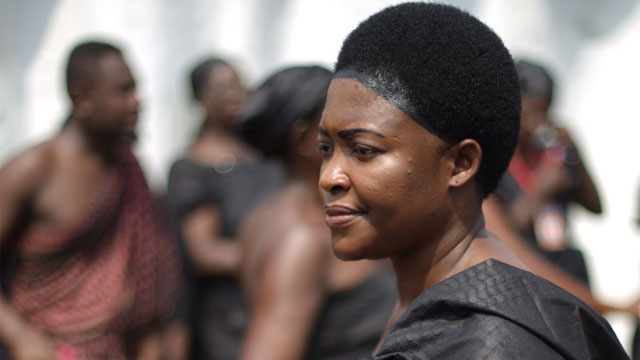
-
 Osuanyi Quaicoo Essel
Osuanyi Quaicoo EsselDifferent cultures may practise different hair beauty culture. Some of the hair beauty cultural practise could be unisex or may distinguish between sexes. In this instance, hair becomes a tool for sexual differentiation and serves as a precursor to one’s gender. It may tell which part of the world a person hails from. That notwithstanding, one may borrow hairstyles from different cultures other than his or her own for fashionable reasons since fashion inspiration is multicultural. Based on the cultural orientation and the role of a particular hairstyle to a group, society or institution, hair aesthetic ideals may be preserved as a tool for identity construction. A typical example of a hairstyle that has remained resilient even in the face of (neo)colonial and imperial hair aesthetic regimentation of the West on Africa is kentenkye hairstyle (Akan Women’s Hairstyle, 2008), popularly renamed as dansikran. Legendary has it that, queen mother Nana Kwaadu Yiadom II, (1917 - 1945), the sister of Nana Prempeh I, of the Asante Kingdom, performed the majestic Adowa dance during the restoration of the Asante Confederacy around 1935 in her kentenkye hairstyle, which inspired the then Governor’s description of her kentenkye hairstyle as a 'dancing crown' (Akrase, 2008) due to its visual effect during the dance. The phrase ‘dancing crown’ was linguistically corrupted as dansinkran which has become the popular name of the hairstyle.
The dansinkran hairstyle is noted for its simple, yet iconic stature in purely indigenous Ghanaian cultural milieu. Its selection was informed by its historical epoch, purely indigenous natural hair beauty care and treatment and socio-political significance in Ghanaian chieftaincy. It has proven to be an unadulterated Ghanaian hair fashion practice necessary in the decolonisation of hair fashion discourse. It is important in the decolonisation of hair discourse in the sense that it is purely Afrocentric which has evolved from its symbolic status to contemporary appropriation. The use of purely natural and sustainable hair treatment cosmetics with little or no harmful effect on the body makes it worthy of handing down to youth. This is because, there has been influx of artificial hair cosmetics with detrimental dermal effects which many youth subscribe to in the name of modernity without recourse to its side effects. The historical significance and interest of this hairstyle for posterity, especially as something of Africa practise, contributes in this regard to the decolonisation process. Dansinkran polity and politics among Akan kings, queens, chiefdom and the society in general reinforced its choice.
This hairstyle is achieved by trimming down the peripheries of the crown of the head almost to the skin while the remaining portions are trimmed to define the oval shape of a wearer’s head. The haircut gives the head a calabash-like shape. A natural black pomade-like colourant mixture composed of powered charcoal, soot and sheabutter, is then applied to the hair to give it intense blackened appearance. Charcoal has been in use for hair treatment in precolonial Ghana for many centuries. Considering the intense heat coupled with dust particle in Ghana and other African countries, the use of charcoal as hair treatment helped to protect their hairs from dust build up, dirt, oil and sebum that settled on scalp and negatively affects hair quality and growth. It implies that charcoal promotes hair growth. The natural hair colourant used in this process armours the hair with lustre and protection against bacteria and fungi. It nourishes the scalp and protects it from dandruff infections and maintains the hair’s natural moisture level. The eye lashes are also darkened to complement the facial look of a wearer.
The haircut helps to focus on the facials of a wearer since the hair receives little or no elaborate ornamentation. Usually, queen mothers who wear this hairstyle are not supposed to wear earrings during possessions or durbars. Judging from the benefits of charcoal in natural hair treatment it is not surprising that it features as essential ingredient in modern cosmetics manufacturing.
The dansinkran hairstyle serves as a socio-cultural barometer, political signifier and as a religious marker. This hairstyle help to identify queen mothers and female kings from other females. It is a symbolic hairstyle that was a preserve of the Akan feminine chiefdom and royals. Some priestesses also wear this hairstyle. Politically, the hairstyle symbolises authority, royalty and power of a female king or queen mother. In this sense, the hairstyle is status-defining in terms of the social rank. It is considered as inevitable lifestyle heritage that needs to be preserved among the chiefdom. When a king or chief passes on, a queen mother who is not wearing that hairstyle is not allowed to pay homage to him/her.
In the case of queen mothers, they complement this hairstyle with a feminine Ghanaian fashion classic named queen mothers’ style. This classic consists of a wraparound fashion of a six-yard fabric that stretches from the chest regions to beyond the knee, which is accentuated by another six-yard fabric draped in toga style. The wearing of this classic in addition to the hairstyle has bestowed onto it, the name dansinkran, hence, both the hairstyle and the classic are named as such. Despite the symbolism of the hairstyle, it now worn by the youth in contemporary times. It has acquired the name sweat. The only difference is that the youth who wear the hairstyle do not apply the charcoal mixture on their hairs. It has become unisex hairstyle among the youth.
The Western hair superiority politics could not erode the many centuries old hair identity visual code and marker that characterised the majority of the chieftaincy institutions in Ghana. As a traditional lifestyle culture that has proved unyielding despite black hair discrimination and politics, it is an important tool in the decolonisation of Afrocentric hair beauty culture practice and education.
References
- Akan Women’s Hairstyle. (2008). Retrieved from https://www.abibitumi.com/community/culture/akan-womens-hairstyles/
- Akrase, N. (2008). Pomp, power and majesty. Retrieved from http://akrase.blogspot.com/2008_01_01_archive.html
published March 2020
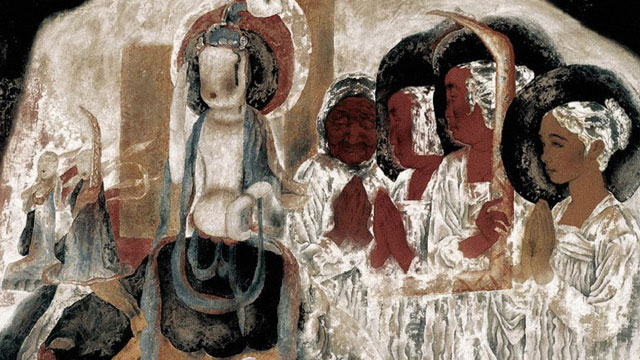
-
 Ming Zhang
Ming ZhangThe importance of the series entitled by "Dream of Dunhuang"
The Dunhuang Dreams series from the 1990s marked the emergence of a new opportunity for meticulous figure painting. After his in-depth study of the Dunhuang murals and his many field trips, Yongli Tang drew inspiration, adhered to the core of traditional painting and incorporated the expressive strengths of Western painting to achieve a bold innovation in artistic expression.
In the creating of meticulous figure paintings, there are three crucial ingredients, including the use of line, modeling and coloring.
Modeling and Line
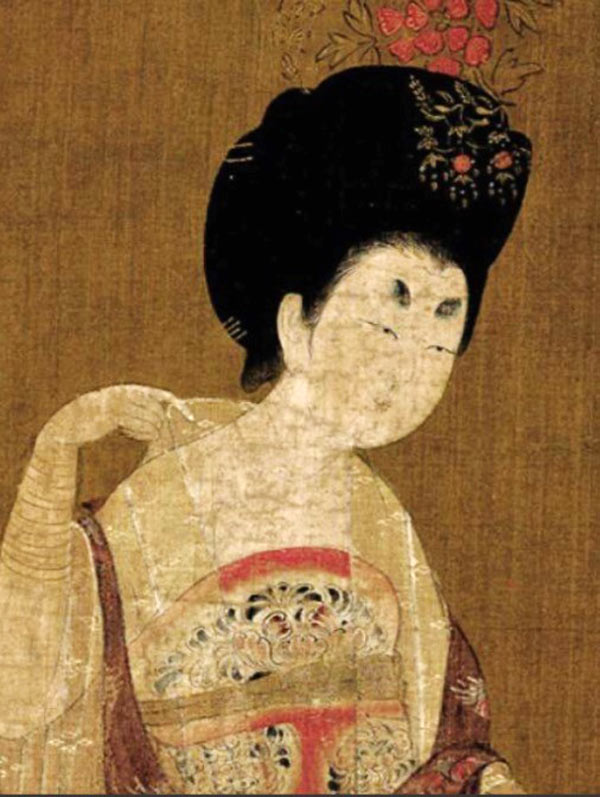
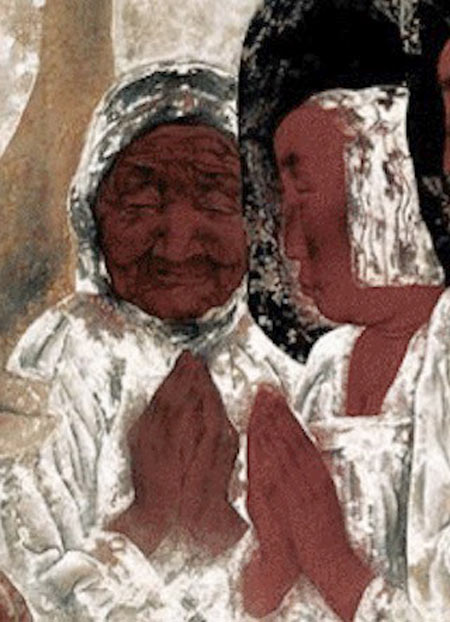
Fig. 2: Part of painting of hairpin ladies in the Tang Dynasty ,Zhou Fang, active late 8th–early 9th century, Ladies Wearing Flowers in Their Hair, handscroll, ink and color on silk, 46 x 180 cm, Liaoning Provincial Museum, Shenyang province, China - copyright: public domain / Wiki Commons.
Fig.3: Part of Memories Of Childhood, Yongli Tang, 1998, Copyright: the artist.Line is the most basic language of Chinese painting, and Chinese painting is concerned with the use of frames and calligraphy and focused on the expression of the structure and rhythm of the object's form, instead of the shading and the in-depth of the object. The series of works is mainly presented by the use of line in the traditional painting while the shading and the linear perspective of the sketch is enlighteningly integrated in the form of relief. The series Dream of Dunhuang innovatively uses linear sketches to portray and shape exaggerated figures, with extreme variations between lines. The spirit of the lines fits the mood created by the picture, while the light and dark faces are integrated to provide a detailed portrayal of the main figure. The juxtaposition of realistic and extracted Dunhuang symbols, modern and ancient figures, temporal and spatial wholeness, and a conceptual form of expression are harmoniously presented in the picture, and the modeling has both traditional cultural roots and modernity.
Coloration
Dunhuang murals have undergone thousands of years of natural and man-made changes in color, with some peeling and mutilating. It looks like a rich, deep, ancient palette that allows the viewer to achieve a secondary aesthetic pleasure. Being in the sacred, quiet rock cave, the soul is purified, and the individual remains in the flow of the years, achieving spiritual transcendence.
In order to pursue the sense of history in Dunhuang murals, Yongli Tang used Black and White as the main colors and interspersed with azurite, stone green, earth red and other traditional colors for embellishment. The color of cooked brown was used to present the figures’ skin. The author could not be confined with the realistic object so that he exaggerated color changes to highlight the subjective emotional orientation of the picture.
In the series of works, virtual dyeing method was innovatively applied to highlight the freehand of the picture. Dyeing high places or low places could be switched freely according to needs, and dyeing is not limited by the line, which presents a vague sense of void. In addition to the traditional color setting techniques, for example, flat painting, rendering and over-dyeing, the author developed the method of shedding. The thick painting and shedding methods set off each other. To be more precise, the author piled up degummed white powder on the base color, then chafed and patted, with some of the white powder falling off naturally. The rest was blended with the base color. The use of large areas of white color does not cause the picture to be chalky. During the painting process the shedding of white color is like the painting of the freehand work. With the controlled brushwork, there are uncontrollable and accidental factors, which gives the mottled and dappled left on the murals by the years. The thickness, light and dark, cold and warm of the white color is presented in an exceptionally subtle way, creating a harmonious and quiet relationship between religious culture and modern beliefs.
Material Texture
Stable social and cultural environment made the painting language of meticulous painting was solely and smoothly developed for quite a long time. In the late 1980s, political, economic and cultural changes leaded to the activation of the painting community and the reflection on tradition. New painting materials were triggered a change in creative thinking.
In his artistic practice, Tang Yongli discovered the texture beauty of the materials and used it in the painting process: mineral colors have a sense of luster, strong covering power, and can be repeatedly modified; the watercolor is rich and delicate; the shedding effect of degummed white powder reproduces the oxidation and wind erosion of mural; the layering of these colors gives the picture a sufficient sense of history and ethereal inspiration. Tang Yongli uses this as an opportunity for a new language, to expand and to strengthen it, as well as to form a new language paradigm. The beauty of the material texture becomes part of the creation and an aspect of the work to be tasted. The author chooses colored silk as the bearer, which is tough and can be used in a variety of techniques such as thick painting, shedding and reverse painting, and pigments such as ink, mineral color, lithopone powder and watercolor are used.
Classical meticulous painting can only do addition, not subtraction. The use of these material techniques breaks the border of the painting on silk. It also allows us to add and subtract freely and to change a single direction to a multi-directional expression (i.e., highly realizing self-consciousness). The expression of the free state of mind, workmanship, painting, color, texture and other factors become a new organism.
Summary
The series of Dunhuang Dream presents the interaction of multiple factors, scholarly artistic interrogation and the creation of diffuse imagery, as well as the attribution and transmission of spirit. It opens artistic horizons for the modern development of meticulous painting. The development of Chinese contemporary art has always been to move forward with the review and inheriting of history. They find visual art resources to reinterpret, redevelop and re-create them with a contemporary view, thinking and aesthetics, which will form a dynamic and growing tradition.
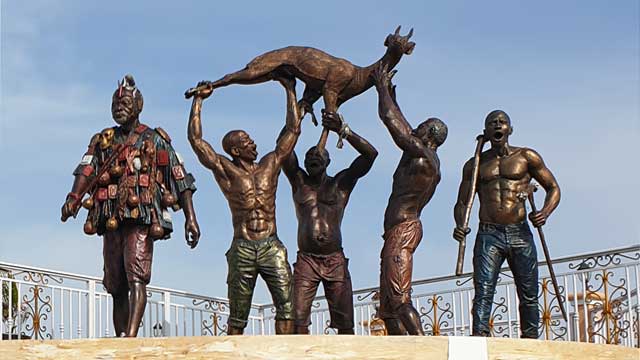
-
 Ebenezer Kow Abraham
Ebenezer Kow AbrahamTheophilus Kwesi Mensah and the Placemaking Paradigm
Within the rebranding and the making of new identity for Winneba as enshrined in the Effutu Dream Project, the name Theophilus Kwesi Mensah cannot be overlooked in this intercourse. This is not only because he engineered the widely talked about installations: the Unity Monument, The Aboakyer Monument, The Fishermen of Akosua Village and the Monument of Ofarnyi Kwegya but the awe-striking aesthetical connotations he incorporated in the aforementioned works. Each of these statues were rendered to mimic the idea of Winneba as a community built on a collective space. Being native of Winneba, heightened his understanding of how the amalgamation of economic, political, and cultural activities in the past, would accord him the impetus to express himself publicly. In so doing, he empowered his sculptures to ventriloquy the unique narratives that define Winneba and redefine this relatively old settlement yet burgeoning municipality as a dwelling place or a place worth visiting.
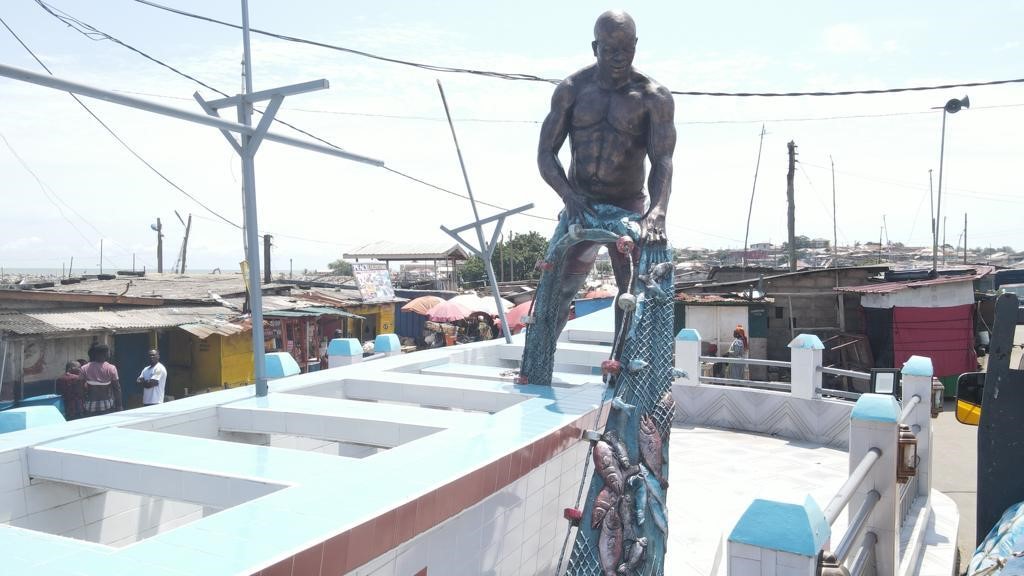
Figure 1: Theophilus Kwesi Mensah, Ofarnyi Kwegya, 2021. Fibre Reinforced Polymer. Yeepimso Community Centre, Winneba. Courtesy of Edem Dedi Photography.
Through the lens of placemaking, Ofarnyi Kwegya (Figure 1) and the Fishermen of Akosua Village (Figure 2) are two typical statues that has beautified the vernacular space of two historical settlements in the older southern half of Winneba.
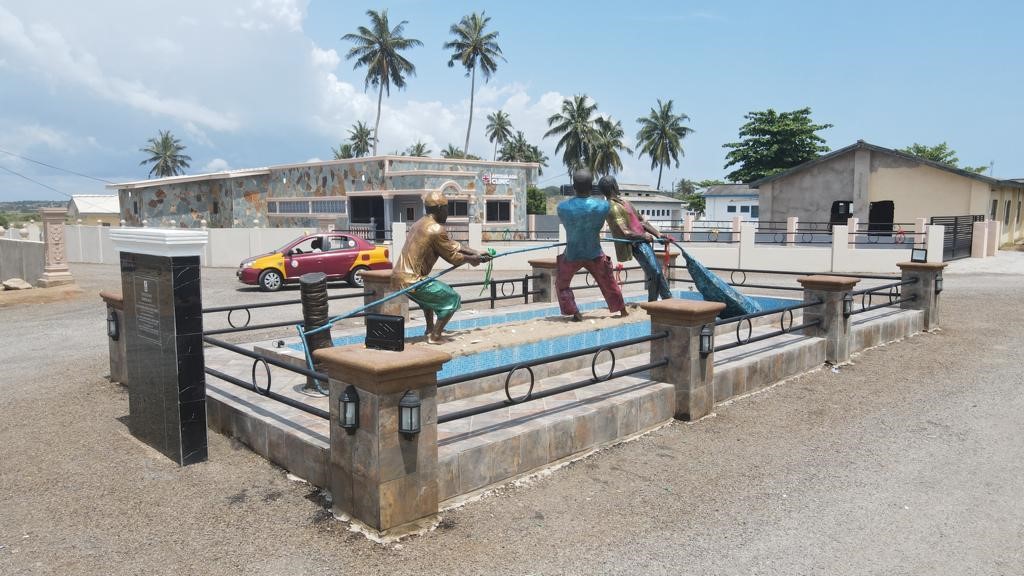
Figure 2: Theophilus Kwesi Mensah, Fishermen of Akosua Village, 2021. Fibre Reinforced Polymer. Akosua Village Community Centre, Winneba. Courtesy of Edem Dedi Photography.
The two statues stand in the middle of Yeepimso and Akosua Village communities respectively as embodiments of vital ingredients helping in creating a sense of community, civic identity, and culture in both spaces. They have both transformed their unique sites as lively and attractive communities with the monumental figures not just becoming legible maps to the sites but turning the spaces into places that support human interactions. The site of the statue has become the most important and attractive places in the two communities. They have become the center of attraction where the community gather for entertainment and trade, especially at night when economic activities in the two communities are at their peak.
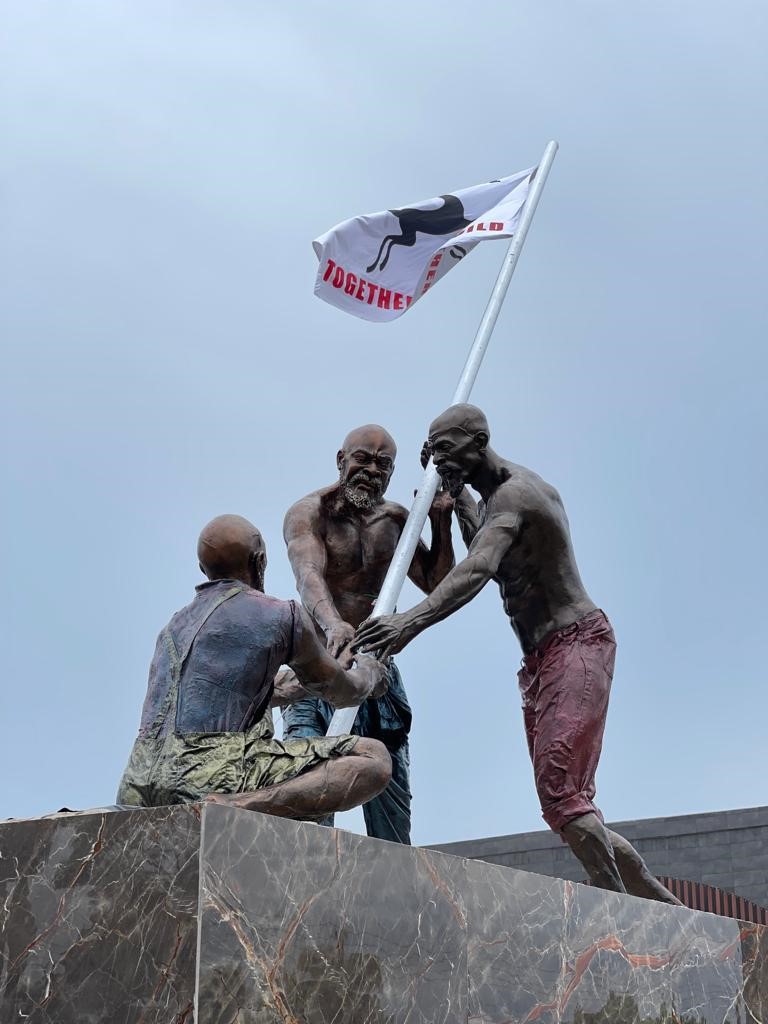
Figure 3: Theophilus Kwesi Mensah, Unity Monument, 2021. Fibre Reinforced Polymer. The Unity Square, Winneba. Courtesy of Edem Dedi Photography.
Another compelling monumental statue that has transformed the landscape of its site is the Unity Monument (Figure 3). Before the advent of the monument, the site of the statue (the Y-intersection – Winneba Traffic Light) was a deserted barricaded mere chaparral which displayed all forms of notices including obituaries and political posters (Mensah & Abraham, 2022). Yet, Theophilus Kwesi Mensah’s statue has transformed the space into an ideologically charged space for a deliberative unity and peace agenda in Winneba. The environment is so aesthetically pleasing that people like to visit the site for selfies and sightseeing thereby generating income for the Municipal Assembly.
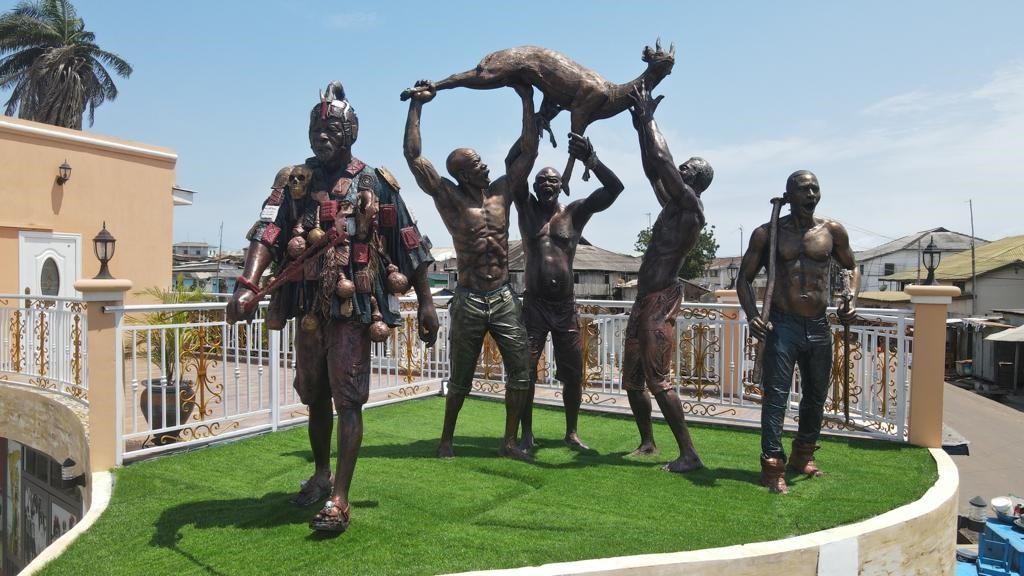
Figure 4: Theophilus Kwesi Mensah, The Aboakyer Monument, 2021. Fibre Reinforced Polymer. Osimpam Museum, Winneba. Courtesy of Edem Dedi Photography.
Theophilus Kwesi Mensah’s ontological orientation of Winneba is multifaceted. Hence, he found significance in the century’s old festival of the people of Winneba, Aboakyer to sculpt a monumental statue to this honour (Figure 4). The Aboakyer Monument mounted on the roof-top of the Osim Pam Museum is at the heart of Winneba as an embodiment of Winneba’s heritage. Owing to the enormous narratives surrounding the Aboakyer Festival, it is seen as one of the most popular and most significant festivals in Ghana (Akyeampong, 2019). The people of Winneba are invariably identified by the Aboakyir Festival. Theophilus Kwesi Mensah captured the very essence of the festival by vividly depicting the most significant characters: the Supi, the Asafo warriors, and their cheer leaders in procession with the catch.
During the 2022 Aboakyer Festival, it was observed that both celebrants and tourist were awe-struck by the aesthetic connotations of the monument. People gathered around the site for various reasons. Whilst some were seen taking tourist photos, others were seen venerating the ancestors who in the past led the festival.
In view of the Effutu Dream Project, Theophilus Kwesi Mensah’s artistic ingenuity to a large extent has contributed to rebranding the Winneba Township by beautifying the place and making it attractive for tourist. However, beyond the beautification agenda, part of the underlining philosophy of the statues was to consciously bring to the fore, some compelling memories of Winneba in relation to the current narratives within the land.
Theophilus Kwesi Mensah and the Collective Memories of Winneba
Theophilus Kwesi Mensah capitalized on his creativity to translate some notable historical events pertaining to his beloved native, Winneba into tangible remnants of the recent past to shape and, indeed, consolidate the Effutu Dream Project. Whilst usurping a storyteller, he equipped his statues to mimic the historiography of Winneba as collective memorials for the publics of Winneba. This is underpinned by his inclination to the truism that cities are built based on their histories and for that matter, Winneba cannot be gentrified without laying claims to the past publicly. Therefore, he ensured that whilst the Effutu Municipal Assembly initiated the Effutu Dream Project, the glorification of the public triumphs of Winneba was not taken for granted. This desire culminated into transforming some important public vernacular spaces into storehouse of memories embedded and inscribed on the landscape of Winneba.
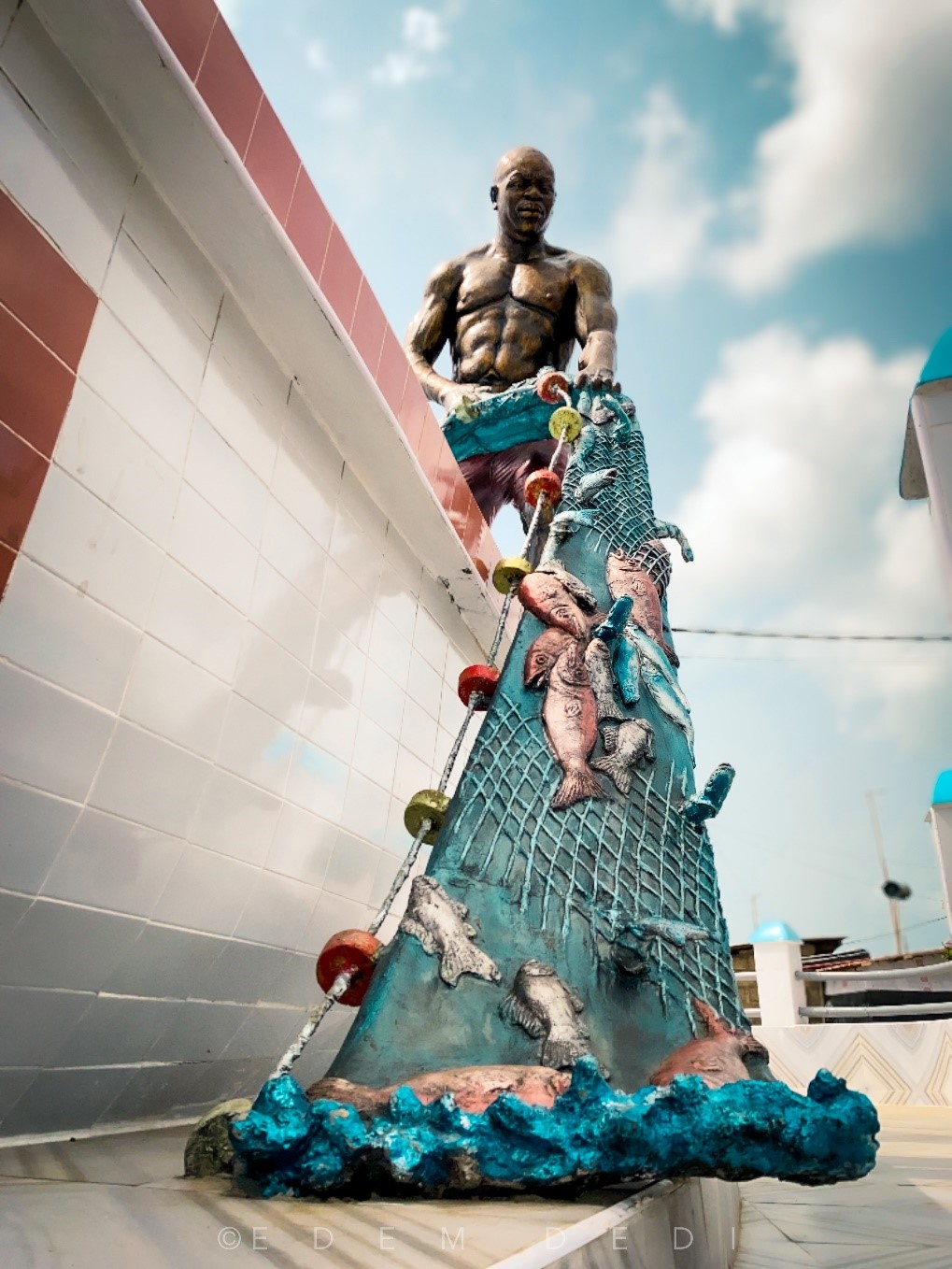
Figure 5: Theophilus Kwesi Mensah, Ofarnyi Kwegya, 2021. Fibre Reinforced Polymer. Yeepimso Community Centre, Winneba. Courtesy of Edem Dedi Photography.
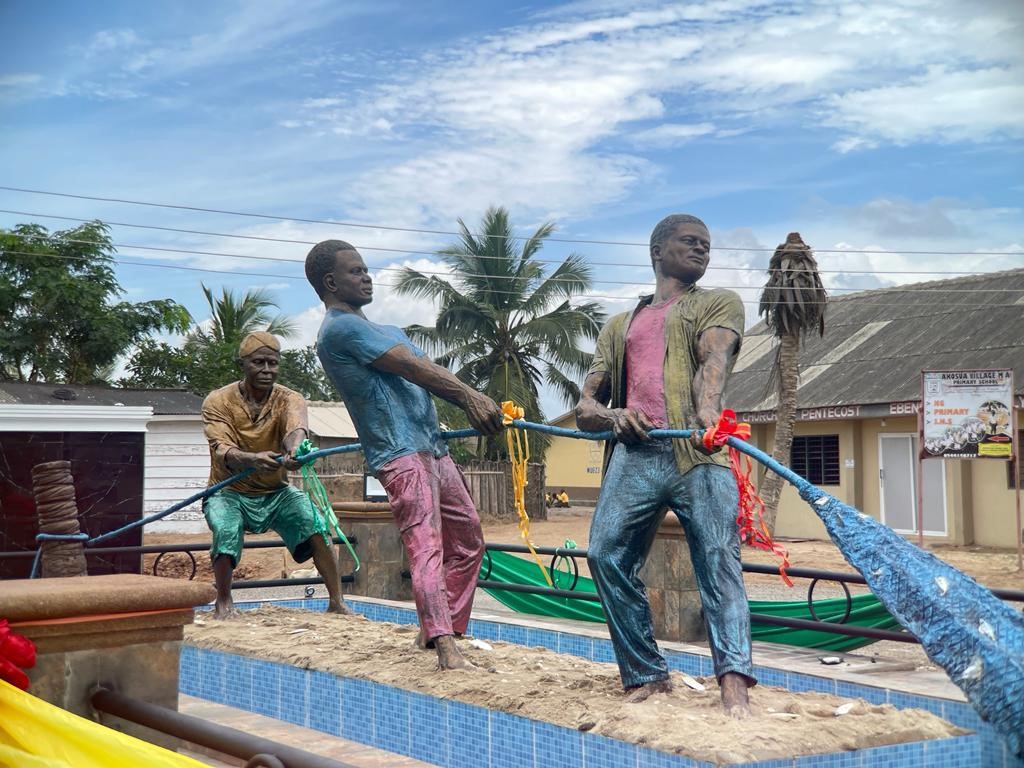
Figure 6: Theophilus Kwesi Mensah, Fishermen of Akosua Village, 2021. Fibre Reinforced Polymer. Akosua Village, Winneba. Courtesy of Edem Dedi Photography.
Knowing Winneba traditionally as a fishing community, Theophilus Kwesi Mensah produced two major monuments, Ofarnyi Kwegya (Figure 5) and the Fishermen of Akosua Village (Figure 6) as a concretized instantiation to the noble trade that has in the past defined what place Winneba is. Ofranyi Kwegya, is the statue of the unheralded giant master fisherman, an exponent of mid water trawling in Winneba who captured huge number of fish whereas the Fishermen of Akosua Village depict the famous trio: Zagada Afadzinu, Kwami Akpade and Sogbka Dagodzo who introduced artisanal fishing or subsistence fishing to Winneba.
Although the fishermen portrayed in these monumental statues have died long ago, they constitute such significant heroes in the historiography of Winneba. In view of their important roles in the socio-economic phenomenology of Winneba, Theophilus Kwesi Mensah aimed at stopping their decay and position them into the realm of the timeless with the erection of their statues as memorials that transmit their archetypal narratives.
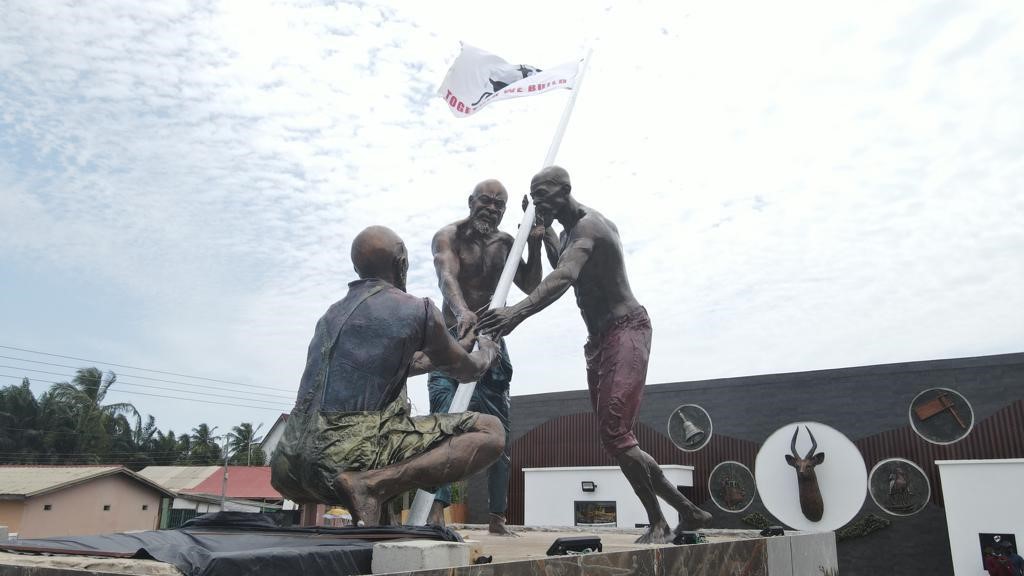
Figure 7: Theophilus Kwesi Mensah, Unity Monument, 2021. Fibre Reinforced Polymer. The Unity Square, Winneba. Courtesy of Edem Dedi Photography.
In view of Theophilus Kwesi Mensah’s understanding of the political and dynastic heritage of Winneba, he engineered the construction of the Unity Monument in commemoration of the end of the protracted chieftaincy feud that had ensued in Winneba in the past. Ephraim-Donkor (2019) recount that since the latter part of the nineteenth century, the people of Winneba have clashed in violent struggle for power until 22nd July, 2015 when the Supreme Court of Ghana, finally intervened. The feud was rooted in an uncanny clash of cultures within the same family three, resulting in a political quagmire as to which succession mode to follow, the male or female model. The people of Winneba traditionally follow the patrilineal line of succession, however the Acquahs who are for the female model, tasted power as caretakers but refused to cede power back to the original benefactors, the Otuano Royal Family (Gyatehs or Gharteys) who are for the male model.
The female model became popular in Winneba because of their hospitality which allowed their Akan neighbours to live with them and rendered Winneba as a cosmopolitan community. Theophilus Kwesi Mensah’ depicted the two families, Gharteys and the Acquahs and a third figure representing the non-natives as a united force in the gentrification of Winneba as they erect a flag as signifier to this commitment. The Unity Monument does not only exhibit an aesthetically astute display of Theophilus Kwesi Mensah’s artistic ingenuity but also, it encapsulates the political and dynastic history of Winneba whilst being a crucible of memory to the unity and peace in Winneba presently.
As part of Theophilus Kwesi Mensah’s memorialization agenda with regards to his statues in Effutu Dream, he produced the iconic Aboakyer Monument as a memorial to the Aboakyer Festival of the Effutus of Winneba. The Aboakyer, known throughout Ghana as the "Winneba Deer Hunting Festival," is held annually in early May. It commemorates the founding of Winneba some three centuries ago, when the Effutu, led by one Osim Pam and accompanied by the god Penkye Otu, settled on the coast at the end of their migratory journey from northern Ghana to the present location.
Pedagogical Connotations of Theophilus Kwesi Mensah’s Statues in Effutu Dream
As artist academic, having been under the tutelage of the Emancipatory Art Teaching Project (EATP) by Professor kąrî’kạchä seid’ou, he is an alley of the blaxTARLINES community in Kumasi. Theophilus Kwesi Mensah’s practice ties in with contemporaneity in the arts. In his teaching, he identifies with the philosophy that trainee art educators ought to think and act creatively. He does this by championing their epiphany in the studio as nexus of exploring emerging issues in art education. Through the studio, his statues in Effutu Dream creatively imparts on his students as agents of transformation in addressing the urgent call for equity, diversity, and inclusion in our educational structure and practices.
Whilst his students have the liberty to choose their own masters, he has been readily available, and the doors of his studio was opened to all students who loved art whilst working on his statues in Effutu Dream. After all, he too has absorbed lessons from legendary Ghanaian Artist Academics such as Benjamin Menya, Kwamevi Zewuze Adzraku and Buckner Komla Dogbe. So, students with varied backgrounds are mainstays in his studio beyond the statues in Effutu Dream. He reckons the studio space as a crucible of intellect and a window to add to knowledge as his students pick his brain as apprentices there.
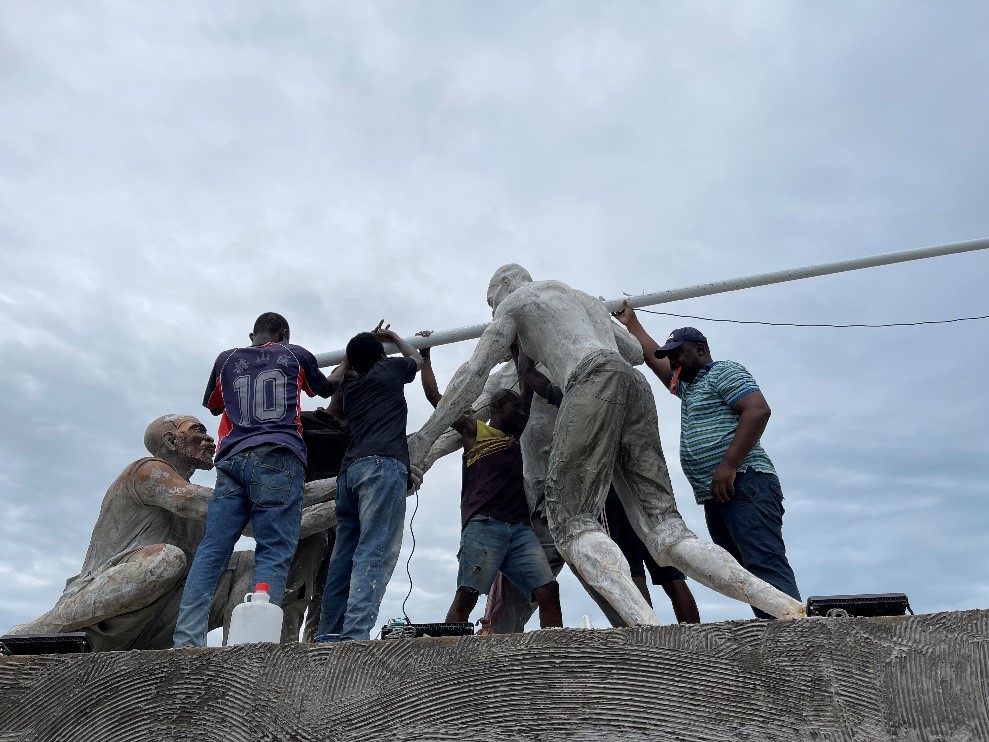
Figure 8: Theophilus Kwesi Mensah working with his students (Courtesy the artist)
Despite his inclination to EATP, he does not sway from being a traditionalist in the sense that he continues to enjoy working from the human figure. His preference to the human figure in his statues in Effutu Dream was informed by the truism that life changes and the language of sculpture evolves. So, it does not really matter if he is being repetitious with a subject that has preoccupied sculptors throughout history. Yet, as didactic symbols, he sought to make explicit what many sculptors make implicit in contemporary memorials in a classical sense with his figurative renditions.
Whilst the public may tend to be passive receptors of his statues in Effutu Dream, his students cannot afford to be indifferent. There are obvious educational imperatives they naturally cannot ignore. As far as they look and see the statues, there are predisposed to learn from them by asking questions. Reis (2010) citing Silva (1984) concerning public art claimed that even if we do not pay any attention to it, daily contact influences our attitude towards the conservation of artworks and our intellectual and sensory appropriation of them. What more do students need to get motivated in their studies aside having the opportunity to see the works of their lecturer installed all over the community? As artist academic, Theophilus Kwesi Mensah thrives to integrate his vast knowledge in the art into the practice of cultivating artistic design talent. His contribution to knowledge is application oriented. His statues in Effutu Dream make meaningful contributions to practical solutions that are at the core of art education. His students garner the nuances of what he says in the classroom when they see his statues in town.
Conclusion
Theophilus Kwesi Mensah’s ingenuity as a sculptor, draftsman and an academician are undeniable, so too is his energy and prolific creative output in the wider Effutu Dream Project. Within a trilogy of paradigms, he displays a profound representation of Winneba as a beautiful place to live and work. He does so by immortalizing four important collective memories of the town whilst using Fibre Reinforced Polymer, a material that stands the test of time and exudes a sense of eternalness. In the process, his students tapped into his creative sense both at his studio and on site.
Whilst Theophilus Kwesi Mensah’s artistic praxis is eclectic, what I have sketched is a heuristic effort to describe his monumental contribution in the Effutu Dream Project in his beloved Winneba where he lives and practice as artist academic. The few details I have carved may at times be minor, but they add up to have a larger impact to his contributions in the effort to redesign and develop Winneba.
References
- Akyeampong, O. A. (2019). Aboakyer: traditional festival in decline. Ghana Social Science Journal, 16(1), 97.
- Farman J (2015). Stories, spaces, and bodies: The production of embodied space through mobile media storytelling. Communication Research and Practice 1(2): 101–116.
- Mensah, T. K. & Abraham, E. K. (2022, June). The unity monument: A hope of the end to the political quagmire in simpa. Paper Presented at The Creative Arts Conference, University of Education, Winneba, Ghana
- Reis, R. (2010). Public art as an educational resource. International Journal of Education through Art, 6(1), 85-96.

-
 Amanda du Preez
Amanda du PreezThe first selfie selected is taken by a reporter Yuzrig Meyer who reported for the Bushradio blog and is taken in Cape Town with students congregating in the background. The second selected image is taken by Michelle Gumede for the student paper Wits Vuvuzela of a student of the University of Witwatersrand (Johannesburg) enrolling in January 2016, while the university campus is locked down by security guards and police officers after bloody clashes between students and police.
The two selfies should be differentiated as the first image is an actual selfie (image maker and taker are the same person) while the second is an image of a selfie-taker (Image maker differs from image taker). In the first image the direction boards towards CPUT CT (Cape Town University of Technology) campus, and the Damelin building (Private Tertiary Training Institution) in the background are clear indicators of its location. The selfie-taker is visible in the righthand side of the image forming a montage by merging his own image with that of the protestors in the background. The second selfie-taker is wearing a T-Shirt with the slogan #FeesMustFall while making a typical selfie ‘duckface’ with the security guards looking on in the background. She is provoking the security guards by asserting her presence as a protestor in their midst.The two images are selected to engage with the growing selfie scholarship also in the field of image studies. The selfie has predecessors in the rich tradition of artists painting portraits and self-portraits, and then democratized further with the invention of photography as a means of self-expression to include a broader audience and artistry. Until finally in the contemporary moment anyone with a smartphone can create a self-portrait or rather, take a selfie. The two images sampled here showcase the expressive and participatory possibilities of selfies as voicing dissent against the powers that be on the one hand, and on the other hand, showing solidarity with those uprising. As such they form part of a new visual activism that is created via online participation and images.
Interpretation(s):
The selfie is notorious for its insertion of the human subject into the digital sphere that appear ubiquitously on social media platforms. More than any other mediating technology the front-facing smartphone has enabled the human subject to create and capture images of the self as never before. The immediacy and the circulation of selfies are extraordinary.
Depictions of the self is however not a new venture within the history of images, in fact, any reflective surface has sufficed as a tool for creating self-images in the past. Most notably the mirror which shares an intimate relationship and history with self-portraiture and self-representation. The progenitor of the selfie can probably be found in Andy Warhol’s self-portraits taken in photo booths (circa 1964-1965). The selfie that became a substantial category on its own since 2012 and 2013 has elevated self-expression to a new level. The two selfies collected here fall within the insertion of agency within the image, as both photographers insert themselves and their subjects within political events. In the first selfie, the creator can only be seen in the bottom half of the image so that the world behind him becomes visible. In the second selfie, the photographer also puts the selfie-taker on display surrounded by an environment of contestation. The images state: look at me but even more importantly, look over my shoulder at the world behind me. I am a witness to these events, and by sharing this image with you, you are also now becoming complicit and a witness to the event. It is a calling forth of a visible agency.
The attempt of the artists to show his or her witnessing of an event – being there – is also not a new endeavour in the history of images. We are reminded of Jan van Eyck’s (1390-1441) signature and presence left in the small mirror in The Arnolfini Portrait (1434), and later Diego Velázquez’s (1599-1660) mocking presence in the company of royalty in Las Meninas (1656). In all these instances, the artists insert or interject themselves into the picture plane. In the case of Ernst Ludwig Kirchner’s (1880–1938) Self-Portrait as Soldier (1915) we see the artist inserting himself into the horrors of war, with an arm lost (although only imaginary), trying to work through the aftermaths of terror. Granted it is not the same interjection we see as in the case of the selfies but one may argue that something of that tradition of witnessing, making present, announcing an event is already born in these earlier examples from Western art history.
The selfies selected here as part of the #FeesMustFall events testify to being present to a historical event and also to being interpellated into the activities. Interpellation as used by the French Marxist philosopher, Louis Althusser shows the status of the individual as always already being a subject subjugated in terms of power and ideology. The selfie makes that power hegemony visible as the subject negotiates his or her status apropos the powerful and ideological hegemony. There is an awareness in the #FeesMustFall selfie that not only bears witness to the riotous event but also positions the self in a particular participatory and supportive position towards what is happening. As Yuzrig Meyer euphorically states about his participatory #FeesMustFall selfie: “I may not have been around in the apartheid era in freedom struggle as an active participator, but from my experience of today I (sic) may have a better understanding to what it was like to be in the atmosphere of passionate comrades and the feeling of camaraderie in the air.” It is both an act of uncovering how power works, by making power visible, especially in the second selfie, and showing solidarity with the riots by inserting the face of selfie-taker as a montage onto the events in the background, as in the case of the first selfie.
These two selfies could also be interpreted as decolonising images as they disrupt what can be considered to be colonizing powers and assert themselves as agents of what Nicholas Mirzoeff (2011) terms “the right to look” and moreover, asserting “the right to be seen”. These two images refuse to look the other way by pretending nothing is happening. Instead, they inject themselves into the event and confront us as viewers with their message.
Discussion of the interpretations:
If we accept the interpretation that these two selected examples of selfies create a new decolonized agency by inserting themselves as both witness and participant of the #FeesMustFall events, it can be suggested that selfies allow for an expansion to the gamut of the traditional self-portrait. The contribution or democratic expansion of the selfie to the history of self-portraiture can be identified in at least the following three categories, namely skills required, immediacy, and generating a broader reach expanding the self-portrait genre. These three categories are not exhaustive but add to the meanings attributed to the two #FeesMustFall selfies.
In the case of skills, one does not require much talent or particular artistic skill to take a selfie. Where the self-portrait traditionally required set skills in the medium utilized for creating the self-portrait, whether painting, sculpture, etching or photography, the artists had to master basic techniques. This is not the case for producing a selfie. One merely requires a front-facing smartphone and the willingness to share in order to create a selfie. In this respect the selfie can be interpreted as a democratizing tool.
Similarly, whereas the creation of a traditional self-portrait mostly implied time (duration) and space for the artwork to be executed and to be exhibited, the selfie can be immediately uploaded online and shared. The selfie also potentially has a far broader reach than the traditional self-portrait as it can be viewed by hundreds (conservatively estimated) of viewers immediately after being shared. The selfie thus further democratizes the self-portrait by being available instantly and anywhere. The selfie is not bounded by time or place and space, as is the traditional self-portrait – it crafts a tele-presence.
Although, like all images the selfie is a complex and multi-layered occurrence and therefore not all selfies produced can be considered as democratizing and destabilizing agents. What is however accurate for most selfies is that they expand the genre of self-portraiture in significant ways.
published November 2019
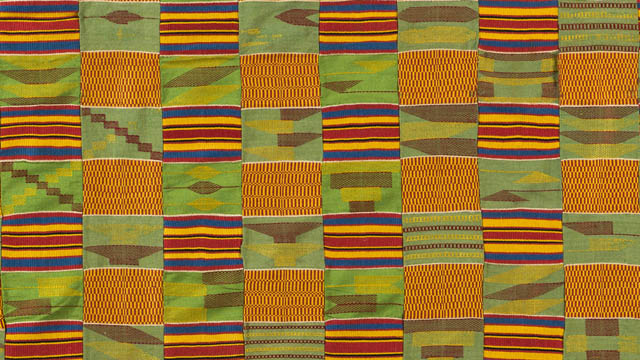
-
 Osuanyi Quaicoo Essel
Osuanyi Quaicoo EsselNoted for its attractive and bright colour schemes, a beautiful kente design is stuck on the walls of the entryway to the Permanent Exhibition of the African Collection at the Museum Fünf Kontinente. Its wide array of colours and strategic placement invites spontaneous spectatorship and captures into consciousness of visitors, the Afrocentric sense of colour use which is a precursor to the continental origin of the fabric. Indeed, kente originate from Ghana located on the African continent. Kente fabric designs have also gained international reputation and attracted considerable amount of research that centre on its historicity, weave structure, symbolic patterns, semiotic power, design structure, and its loom and the corresponding accessories, amongst others. Featuring the kente design in the collection by the curatorial team complements to drawing renewed attention to the indigenous fabric design technology of Africa.
Historically, kente has been known as a cloth which was a preserve for royals (kings and the chiefdom) in the Asante kingdom. It was later produced for use by all in the society. Being a fabric for royals, it signifies pride, wealth, power, authority and status of wearers. Though its usage extends to all, the kente designs worn by the Asante Kings are unique, distintive and of couture standard. The culture of adorning the Asante Kings with the top notch kente designs as in the ancient times has, therefore, not been eroded. In the court of the Kings were seasoned kente designers and weavers carefully selected to produce stunning kente design that are not found on the market. The fabric was woven with variously dyed handspun cotton yarns, in plain and double weave format in the form of stripes usually determined by their design structure. The stripes are joined together with the aid of a needle to form a wide sheet of fabric. The zigzag machine has become a replacement in joining the stripes together.
On the political sence of Ghana, the first president of the country, Osagyefo Dr. Kwame Nkrumah’s introduction of national dress agenda evoked the kingly use of the fabric in presidential inauguration ceremonies which has become a non-statutory policy emulated by six out of eight democratically elected presidents of Ghana from 1960 to present (Essel 2019). Nkrumah was the pacesetter in the use of kente in toga style for presidential inauguration in the history of Ghana. Prior to that he had worn kente fashion to political events and meetings in and outside Ghana before he became the president of the nation. His exemplary use of the Ghanaian fashion classic has been maintained and practised for more than half a century, though it is non-statutory.
Apart from its aesthetic clout, kente comes with symbolic patterns, whose decoding reveal the philosophical message encoded in the woven patterns of the fabric. Structurally, the kente fabric design featured in this exhibition encompasses variations of babadua, kaw, nkyemfre and fa hia kɔtwere Agyeman patterns, amongst others.
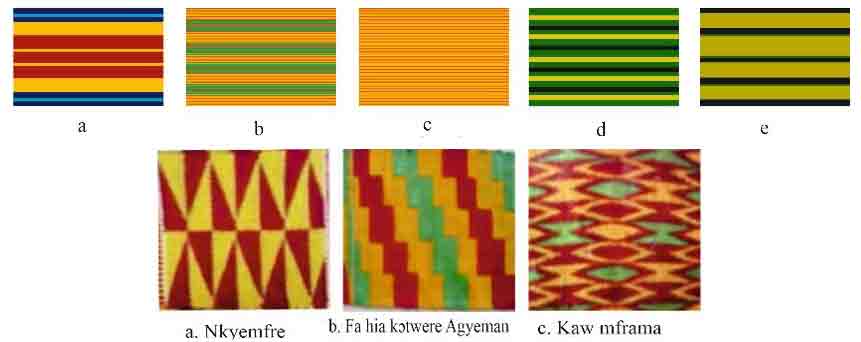
Figure 2: Top row: Variations of Babadua patterns. Bottom row: Names of some identifiable Kente patterns (Photo: the author)
Babadua is a name of a plant based on which the pattern was developed. The plant is noted for its strong look and resilience, perhaps a reason for its choice. Babadua, therefore, signifies strength, resiliency, formidability, firmness, superiority and power. These symbolic attributes of babadua is communicated by its wearer to observers. There are variations of babadua patterns used by kente designers (Figure 2). Some of the variations of babadua patterns are captured in the kente design (Figure 1). Nkyemfre (‘a pot shed’) pattern, depicted with alternating right-angled triangular shapes, symbolises history, recyclability and healing power, knowledge and service while Kaw mframa pattern derived from the physical characteristics of centipede, symbolises uniqueness. Fa hia kↄtwere Agyeman (literally translated as ‘lean your poverty on Agyeman’), arranged in the form of staircase in diagonals stands for hope, faith, sharing and benevolence (Essel, 2019). Combination of these observable kente patterns deftly arranged to communicate the idea of history, power, hope, pride, healing power, knowledge and service. The philosophical interpretation of kente designs could be informed by decoding its symbolical patterns. It could be observed that the variations of Babadua patterns dominate in the design (Figure 1). The dominance of this pattern informs the overall message embedded in the design. In this context, the fabric sings praises to the power and superior status of a king or chief in keeping intact the history and indigenous knowledge systems of the society.
Kente has become a prominent visual image and identity marker used in reference to the African continent. For instance congressional democracts led by Nancy Pelosi on June 2020 wore kente stoles to make political statement in pursuit of legislative goals of equality for Black people. This occured in solidarity of the gruesome death of the African-American George Floyed in the hand of white police and police brutality in the US. The kente fabric adorned by the lawmakers was used to signify African heritage and pride. During the 400th anniversary celebration of the arrival of enslaved Africans to America in 2018, the Congressional Black Caucus wore kente in paying allegiance to their African heritage. Kente fabric, therefore, has strong historical connections with Blacks across the globe.
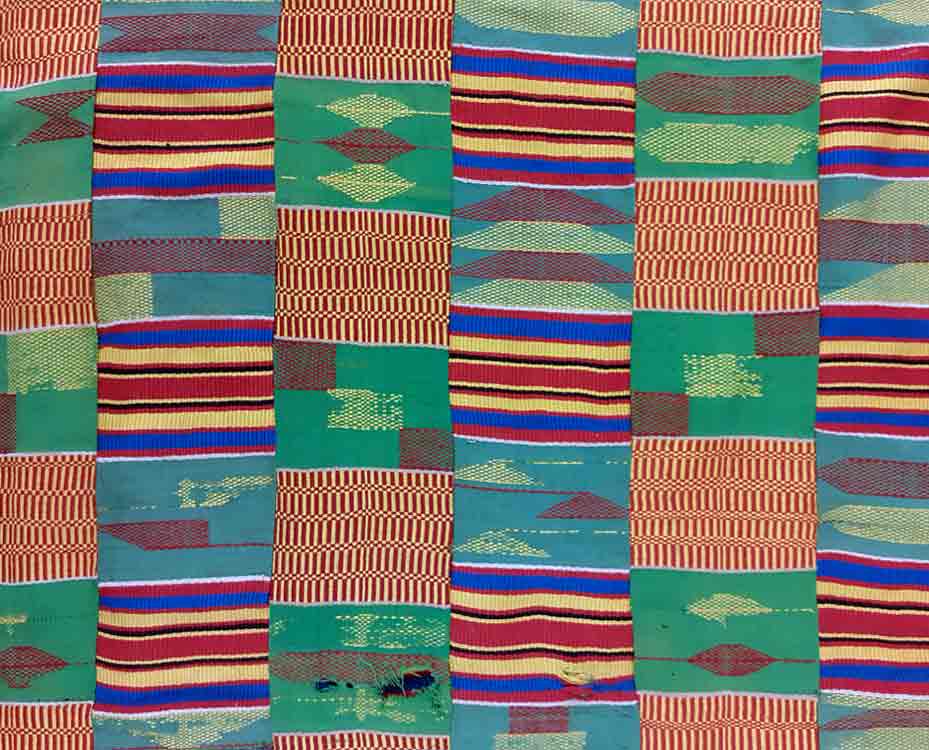
The Kente fabric in the depot of the Museum Fünf Kontinente © Museum Fünf Kontinente (Photos: Sophia Lubin)
Teaching and learning of kente fabric with the focus on history, sociocultural, political significance and educational relevance; improving the production technique for mass production purposes; improving of loom and its accessories; and alternate way of creating handmade kente print, among others, informed my teaching. Learners under my tutelage also explore appropriation of the symbolic kente patterns and engage in experimenting with kente designs.
published January 2021
Reference
- Essel, O. Q. (2019). Dress fashion politics of Ghanaian presidential inauguration ceremonies from 1960 to 2017. Fashion & Textiles Review, 1(3), 35 – 55.
This article is part of a gallery: Perspectives from Ghana on Museum Objects in Germany
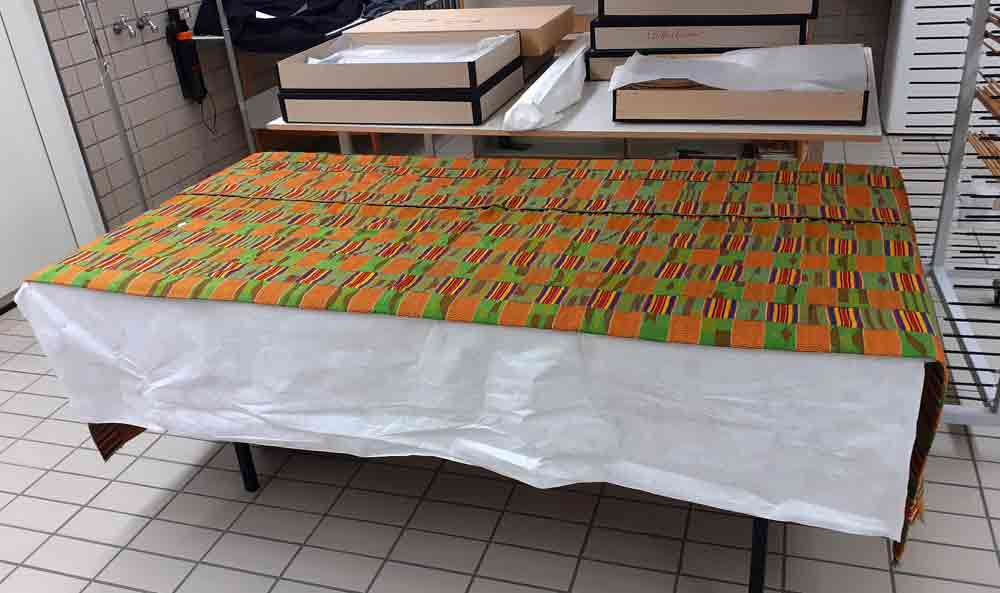
The Kente fabric in the depot of the Museum Fünf Kontinente © Museum Fünf Kontinente (Photos: Sophia Lubin)
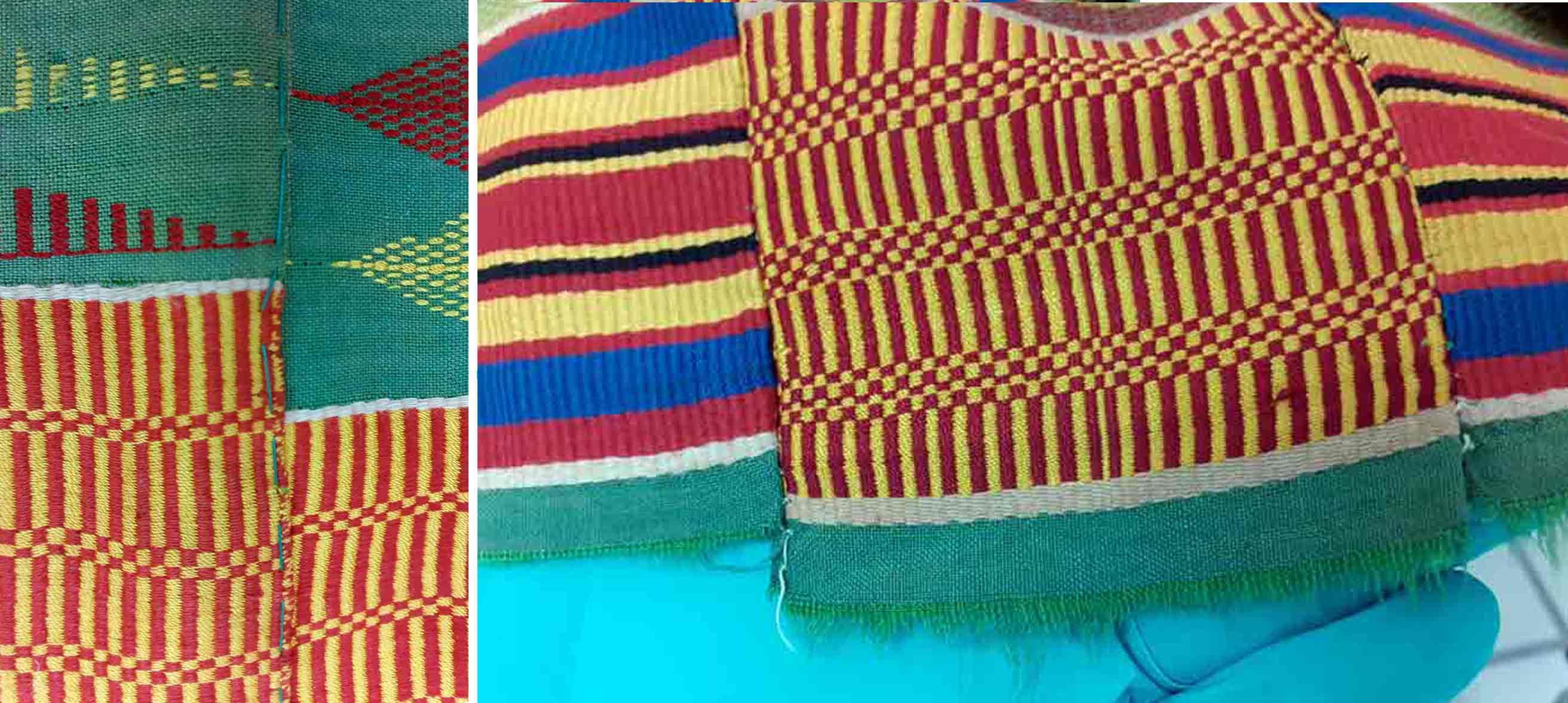
The Kente fabric in the depot of the Museum Fünf Kontinente © Museum Fünf Kontinente (Photos: Sophia Lubin)
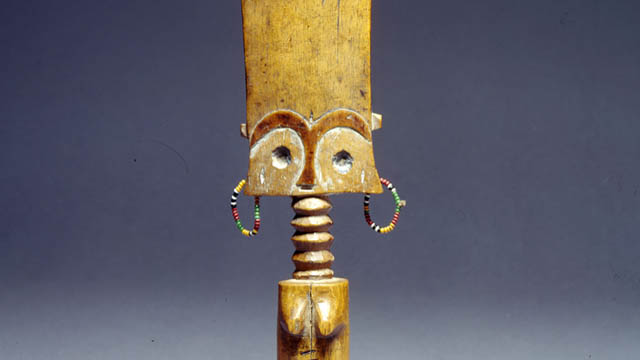
-
 Gertrude Nkrumah
Gertrude NkrumahInversion of Hegemony with Ideas of Femininity
Scholarly works abound on factors and causes of gender inequality in the Ghanaian society and many of these writings address gender inequality solely in terms of women as the victims and thus reinforcing the gender stereotype of female passivity. Although this is true in most cases, such studies do not necessarily address the question of how women have responded to and addressed issues of gender expectations and gender-related roles in African societies. By using the ‘Akuaba’ doll (fertility figurine), this research seeks to explore how the concept of womanhood has been portrayed and represented through time in the Ghanaian society among the Akan ethnic group. It seeks to extend an argument for the interpretation of these images beyond the depiction of women as sexual objects to that of creating an inversion of female hegemony in the society. I argue that instead of considering gender stereotypes as an all-pervasive oppressive tool, we must begin to think of the finer nuances and conceptualize how women have shaped, redefined, and negotiated socio-cultural construction of gender.
The object is widely referred to as the fertility figure, also known as the Akuaba doll among the Akans of Ghana. My reasons for selecting this object are two-fold. Firstly, it speaks to my childhood experiences as a girl growing up in an Akan society and secondly, as someone who is very passionate about gender-related issues either from an intellectual and personal perspectives, I was motivated to choose for this project an object that I can easily relate to, both from a personal and intellectual perspectives.
The object in question is the depiction of a female body, an exhibition of the Akan concept of an ideal woman. The features include a flat forehead with an elongated “ring-like neck shape”1 which reflects Akan standard of beauty. The understanding is that a woman with this type of neck is well-fed, healthy, and strong, a paragon of beauty and affluence. The flat broad forehead also is an embodiment of wisdom, while the accentuated breasts and hips with beads worn arounds the waist is the Akan ideal of womanhood, a depiction of woman as the giver of life. The beads worn around the waist has both aesthetic and symbolical meanings. In terms of beauty, beads were worn as an ornament for beautification, just as portrayed by the wearing of the jewels around her ears. It was also believed that wearing of beads around the waist is sexually appealing, while beads were also worn to broaden the hips and shape the waist for reproductive purposes. It is important to note that in the Akan society, and indeed in most Ghanaian culture, an ideal woman is one that carries and bears children. Clearly, ideas of beauty, sexuality and reproduction were the very essence of womanhood or femininity in the Akan society.
According to a very popular Akan oral tradition, the Akuaba doll is deeply rooted in one’s woman’s quest to overcome her inability in meeting societal ideas and expectation of womanhood.2 Akua, a childless woman, consulted a ritual specialist for a child. She was instructed to go to a woodcarver and make a doll of her choice for a child. Some rituals were then performed on the doll and given back to her to take home and treat and care for as her child. Later she became pregnant and gave birth to a daughter, just as she desired. The Akuaba doll then became symbolic for female reproduction. Amenumey explains that the Akuaba dolls were “…supposed to induce fertility and pregnancy….”.3 Among the Akan, like most precolonial Ghanaian societies, the concept of womanhood was largely defined and shaped by a woman’s ability to give birth to as many children as possible. Childbearing was a blessing from the gods and was usually celebrated with pomp and merrymaking. For instance, the custom was to reward a man whose wife has given birth to ten children with a sheep. The Akan refer to this as “badudwan”4 literally, a sheep for the tenth child. This was usually provided by the wife’s family to the husband to show their appreciation for the replenishing and sustainability of their family.5 In the quest to attain such feat, women worked hard to give birth to at least this number of children as prove of her worth to her husband and the society. This undoubtedly made women who were childless in the society feel undervalued and highly marginalized.
Such ideas and concepts of womanhood and inadvertent marginalisation of women still resonate in contemporary Ghanaian society and indeed in most contemporary societies. A woman’s value and worth continue to be tied with her sexual and reproductive abilities. Although women at present now have access to spaces and engage in works that go beyond the traditionally assigned roles of wife and motherhood (sexual and reproductive values), a woman is still expected to neatly fit in with socio-cultural construct of gender. This underscores the value place on women’s sexuality and reproduction to the detriment of other roles beyond these norms, thus leading to the marginalization of women. It is for these reasons that scholars such as Lerner and Allman have often called for the need to question entrenched patriarchal norms that undermine women’s oppression while it reinforces male- superiority.6
The understanding that women have continually been passive and largely detached from the making of their own history and are mere tools in the hands of a patriarchal society is neatly contested by the history behind the Akuaba doll. While it is true that it was Akua’s desperation to fit into societal expectation of ideals of motherhood that forced her to consult a diviner to help her conceive a child, the knowledge that Akua chose to actively engaged with the process of making the doll; how the doll is carved out, the shape, the physical features, and the aesthetic nature is significant. Additionally, the fact that she chose to carve out a girl child clearly indicates the active role she played in redefining and negotiating power with the matrilineal, yet patriarchal society, thus creating and inverting power in an all-pervasive patriarchal institution. It is also an indication that she did not consider the female as of little value in her society.
Paradoxically then, the history and philosophical ideologies that underpin the concept of the Akuaba doll is a clear exhibition of the nuances and complexities of societal construction of gender roles and status. In a society with a deeply entrenched gender expectations and assigned gender roles, it is remarkable that Akua sought to circumvent, manipulate, and yet conversely acquiesce with existing status quo to her advantage, an inversion of hegemony amidst patriarchal privilege. Therein lies the ambiguities and contradictions of performing gender.
References
- Addo-Fening, R (1973). Asante refugees in Akyem Abuakwa 1875-1912. Transactions of the Historical Society of Ghana. 14, 1. 39-64.
- Akyeampong, E & Obeng, P. (1995). Spirituality, Gender, and Power in Asante History. The International Journal of African Historical Studies. 28, 3. 481-508.
- Allman, Jean. (1996). “Rounding up Spinsters: Gender Chaos and Unmarried Women in Colonial Asante.” Journal of African History, 37, 2, 195-214.
- Amenumey, D. E. K. (2008). Ghana: A concise history from pre-colonial times to the 20th Century. Accra: Woeli Publishing.
- Appiah Anthony K. (1991) “Is the Post- in Postmodernism the Post- in Postcolonial? Critical Inquiry. Vol. 17, No. 2. 336-357.
- Lerner, G. (1994). The creation of feminist consciousness: From the Middle Ages to 1870. Oxford: Oxford University Press.
- Lerner, G. (1986). The creation of patriarchy. New York: Oxford University Press.
Footnotes
1) It is quite common today to hear songs in the Ghanaian society eulogising a woman’s beauty by referring to her ring-shaped neck, together with other physical features. This is an indication that the Akan standard of beauty in the past as enshrined in the Akuaba doll continue to resonate with contemporary Ghanaian societies.
2) This is a popular story among the Akans and was often recounted to young girls especially by an older woman in the family or society. I grew up listening to these stories from my mother and grandmother, among others.
3) D. E K. Amenumey. (2008). Ghana: A concise history from pre-colonial times to the 20th Century. Accra: Woeli Publishing. P. 90. From a spiritual and philosophical perspectives, the use of the Akuaba went beyond just fulfilling the desires of childless women. In most of these Akan societies, when a woman gives birth to twins but in an unlikely situation where one of them dies, she is expected to make a replica of an Akuaba doll in replacing the dead child. Some would also bury the dead child with the Akuaba doll as a way of warding off evil spirit from killing the living child.
4) “Badu” is an Akan name for the tenth born child. ‘Ba’ or ‘ɛba’ is the Twi word for child, while ‘ɛdu’ or ‘du ‘means the number ten in the Akan language. Therefore, the name Badu in Akan usually refers to a tenth born child.
5) It is significant to point out that Akan society, unlike most ethnic groups such as the Mole-Dagbani, Ewe, Ga-Adangbe and Guan, is mostly a matrilineal society. Lineage, inheritance, and chieftaincy succession have always been through the female line. Although precolonial Akan society was not completely immune from patriarchal ideals, women played important roles and and had significant status in society especially in areas of religion, politics and economy. For further details on this, see for example the articles Addo-Fening, R (1973). Asante refugees in Akyem Abuakwa 1875-1912. Transactions of the Historical Society of Ghana. 14, 1. 39-64 & Akyeampong, E & Obeng, P. (1995). Spirituality, Gender, and Power in Asante History. The International Journal of African Historical Studies. 28, 3. 481-508.
6) See for example, Allman, J. (1996). “Rounding up Spinsters: Gender Chaos and Unmarried Women in Colonial Asante.” Journal of African History, 37, 2, 195-214, Lerner, G. (1994). The creation of feminist consciousness: From the Middle Ages to 1870. Oxford: Oxford University Press., & Lerner, G. (1986). The creation of patriarchy. New York: Oxford University Press.
This article is part of a gallery: Perspectives from Ghana on Museum Objects in Germany
published January 2021
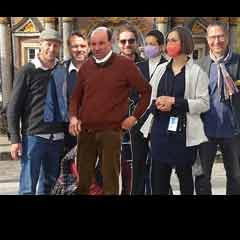 ISB_Team
ISB_TeamA German Perspective on the Akuaba Doll in the Museum Fünf Kontinente Munich
Akuaba Dolls are wooden figures that were and apparently still are in use mainly in rural areas in southern Ghana. Young women hoping for pregnancy or - if they are already pregnant - for the health and beauty of their child, wear these figures on their bodies like real babies and take care of them. That is why they are called 'dolls'.
Akuaba or better Akua-Bà literally means 'child of Akua'. The story tells of "a woman named >Akua< who could not get pregnant and went to a local diviner or priest and commissioned the carving of a small wooden doll. She carried and cared for the doll as if it were her own child, feeding it, bathing it and so on. Soon the people in the village started calling it >Akua< >ba< - meaning >Akuaba's child<, since >ba< means child. She soon became pregnant and her daughter grew up with the doll." (Annor et al., p. 308)
This story also forms the basis for the function of the widespread dolls as aids in a desire for pregnancy. An Akuaba Doll expresses this desire for a child, so the figure is 'cared for' by a girl from puberty onwards. This happens within the family. Outside the family, Akuaba Dolls can be found in shrines under the care of a ritual specialist, where they can be borrowed for their purpose.
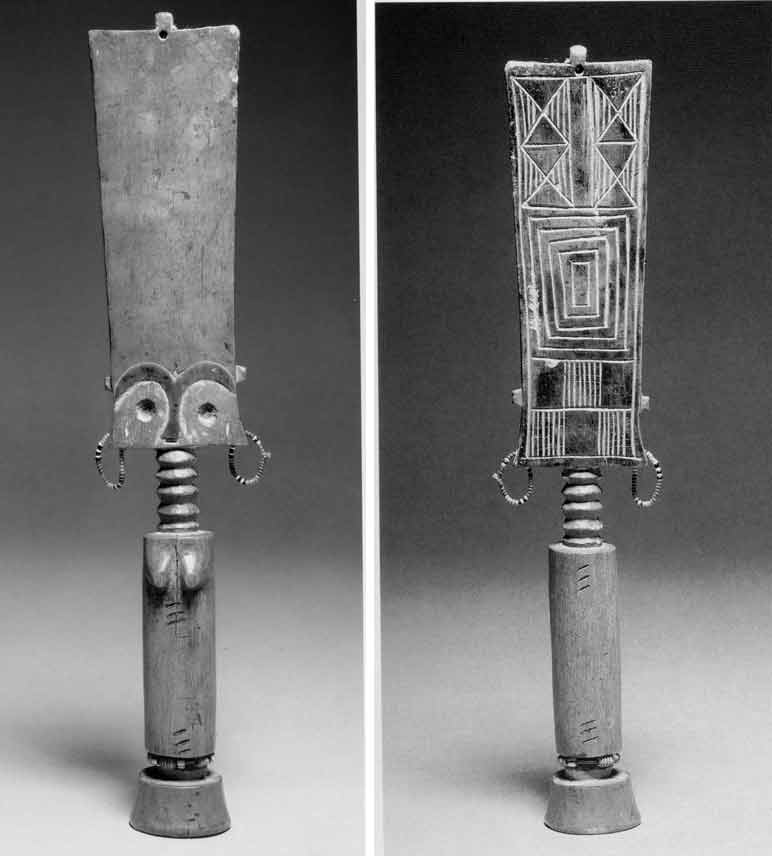
Fig. 1 & Fig. 2 Views of the Akuaba Doll in the Munich Museum Fünf Kontinente
Anonymous artist. Fante Fertility Figure. Early 20th century, Wood. 27,5 cm. Museum Fünf Kontinente. Presentation at Museum Fünf Kontinente.
© Museum Fünf Kontinente
Description
The doll in Munich's Museum Fünf Kontinente (Fig.1) comes from the Fante area. It shows a female figure. The very strongly abstracted forms and proportions symbolise various aspects:
The rectangular shape of the very flat head becomes - seen from the front - somewhat broader in an elegant curve towards the top. A strikingly high forehead, with eyes, eyebrows and nose only indicated, while mouth and ears are missing. The accentuated arch segments of the eyebrows flow together and then form the nose. On the back, the head has geometric patterns (Fig. 2). Added earrings of glass beads give the figure a colourful accent. For Kecskési (p. 38), their daintiness is a sign that the doll has been lovingly treated. At the very top there is another small moulding with a hole where hair was originally attached (compare Fig. 3a).
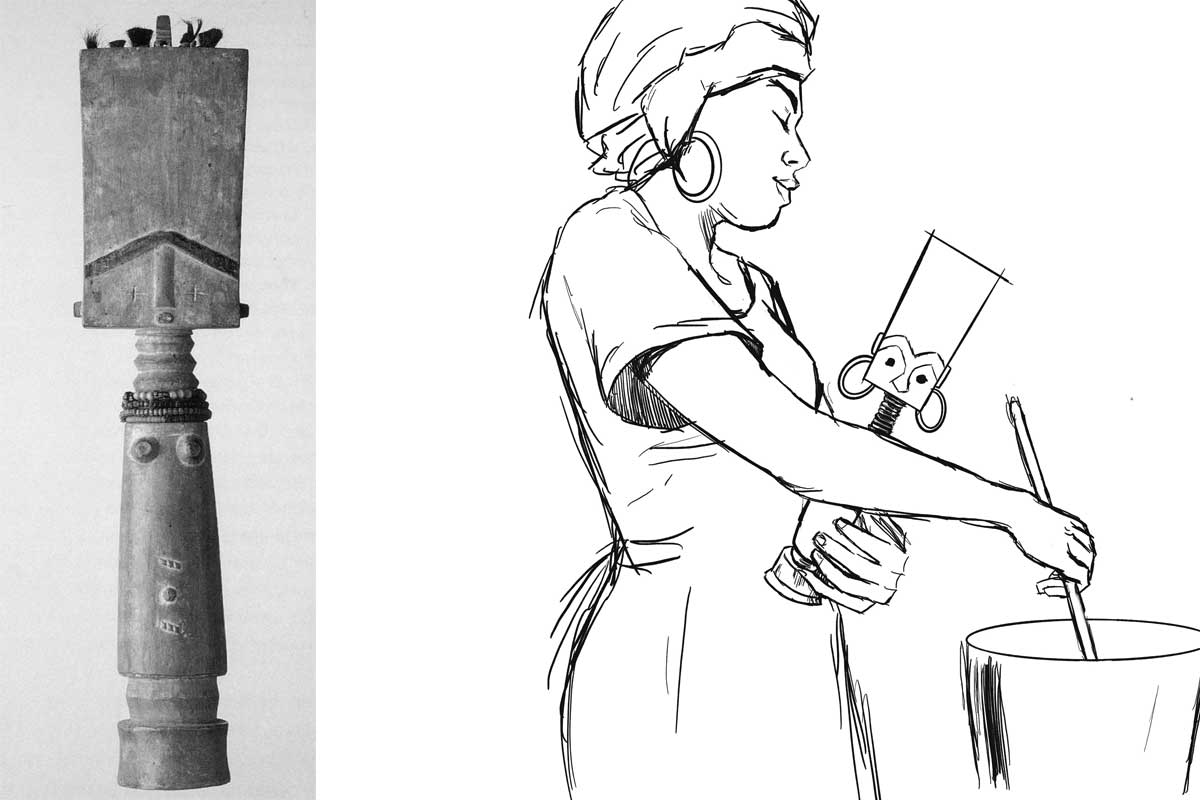
Fig. 3a: Akuaba Doll from the Linden Museum Stuttgart (Forkl p. 94). Fig. 3b: Use of the doll (drawing by Vanessa Rast - courtesy the artist)
The neck has five rings. It sits on a very slender, round trunk, which in turn stands on a delicate base. Striking are two groups of three diagonal embrasures each, which are repeated on the back. The figure has no arms, the legs are short stumps. The protruding forms in the chest area mark the figure as female. Its strict symmetry is softened by small deviations. One can well imagine taking the cylindrical figure in one's hand.
Material and technique
A ritual specialist to whom a woman who wishes to have a child goes makes the decision about the choice of doll at the respective shrine. If no suitable figures are available there, he instructs the woman to order a new Akuaba Doll from the woodcarver. The craftsmen then visit the tree to obtain the wood and ask the tree's spirits for permission to do so (oral information from the Ghanaian colleagues 2022 in Bayreuth [Link]). The Akuaba Doll in the Munich Museum was carved from softwood. (There are also darker examples made of hardwood, for example among the Ashanti, also an Akan group, as the presentation in the Ghana National Museum in Accra shows - see Fig. 4.) In the example in Munich, eyebrows and nose are darker.
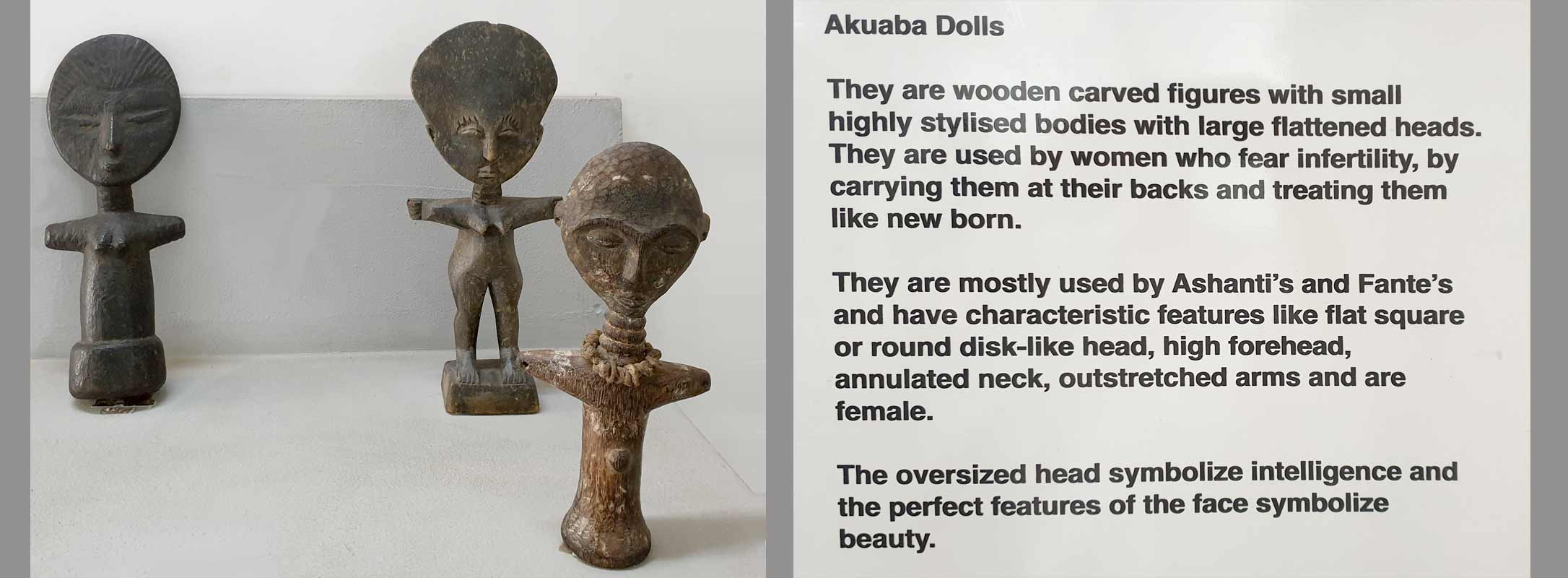
Fig. 4: Presentation of Akuaba Dolls at the Ghana National Museum in Accra (March 2023. Photo: the author)
Interpretation of the Munich figure within the original Ghanaian context
(1) Utility function: The figure is made for the family context. It is meant to lead to fertility, sometimes also to the beauty of a child. The size (height 28 cm), the pleasant material and the weight allow the figure to be carried and cared for like a baby. When an Akuaba Doll has fulfilled its task, it is often returned to the ritual specialist who accompanies the process.
The breasts indicate a female figure, which does not necessarily have to do with a corresponding desire for the sex of the child desired. Forkl (p. 94) assumes, however, that "women desire daughters, on the one hand as progenitors in a matrilineality oriented society, and on the other hand as support in household work." (There are also Akuaba figures with the characteristics of both sexes and probably male specimens; furthermore, breastfeeding examples and those who in turn carry other Akuaba Dolls.)
(2) Body shape: T The conspicuous and disproportionately large rectangular head symbolises the head as the seat of intellect and wisdom in local imagery. Akuaba figures among the Ashanti show round heads (see fig. 4), but they are also proportionally very large. High foreheads and flat faces correspond to the ideal of beauty. Luxuriant bulges on the necks tell that the figure is well-fed and thus refer to happiness and prosperity. There are Akuaba Dolls that show more feminine body shapes, wider hips, possibly emphasised by strings of pearls.
(3) The spiritual context: As Nkrumah writes in her contribution, an Akuaba figure serves as a dwelling place for a soul being, a being that is in a transitional area between the earthly and the spiritual world. Carrying and caring for it is a prerequisite for the entrance of such a soul being, which then sets out to appear on earth as a living being, i.e. to enter the family of the young woman through birth. A ritual specialist is involved in the selection, consecration and regulations for use. After a birth, the figure is returned to the ritual specialist.[1]
(4) The social and cultural context: The figure can also be seen as a sign of the traditional expectation for a woman to bring children into the world. In recent times, where traditional societal expectations of women collide with other worldviews, the ritual use of Akuaba Dolls obviously decreases .

Fig. 5: Souvenir shop at Accra Airport (March 2023. Photo: the author)
In the last decades, an interesting production for tourism has been established - apparently the dolls are seen as 'typical for Ghana'. However, these are not Akuaba Dolls in the traditional sense, but rather 'quotes'.
How can one relate Akuaba Dolls to European visual traditions and experiences?
As familiar as the image of an Akuaba figure may seem in Europe - as a 'typical' example of traditional African art - its traditional meaning is unknown in Europe. Nevertheless, it obviously seems to be attractive to tourists, e.g. as 'airport art' (see Fig. 5), perhaps because its shape somehow corresponds to the cliché idea of 'typically African', the size fits well into the suitcase, or the large head (by means of the Bambi effect) makes it appear 'cute'.
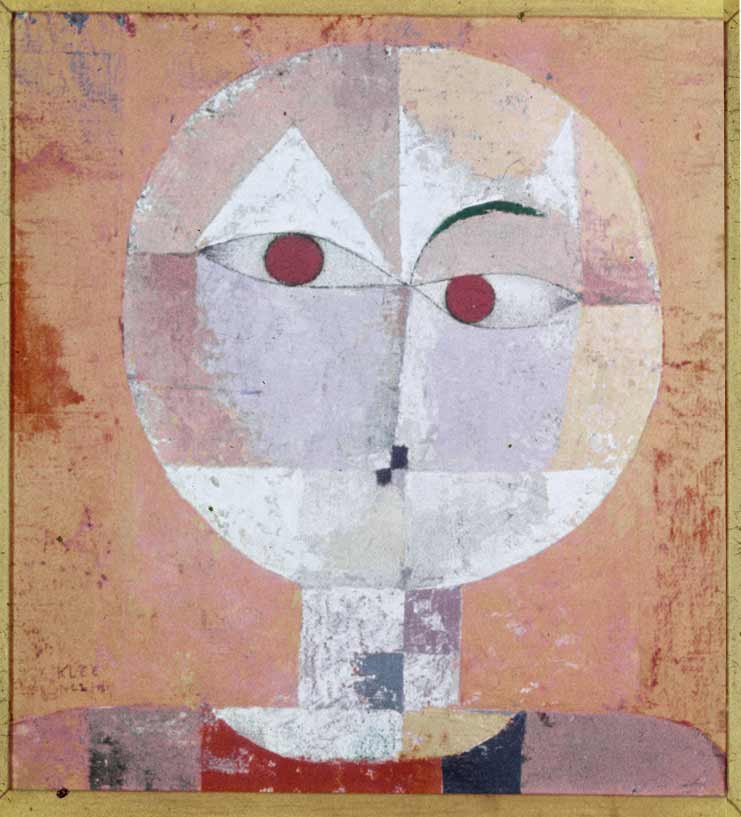
Fig. 6: Paul Klee. Senecio. 1922. Oil on chalk base on gauze on cardboard. 40.3 × 37.4 cm. Kunstmuseum Basel (Wiki Commons)
In the context of art history, the influence of Akuaba Dolls (and many other carved representations from West Africa) on European art of the early 20th century (see Fig. 6) is of interest. [2] The formal similarity to Klee's painting (fig. 6) is striking at first glance, but whether this is a direct reference must first be verified. In the context of art history, it would then be of interest in a next step which aesthetics were of interest to the artists at the time and which they blanked out, i.e. which "image of Africa" they wanted to have and also communicate.
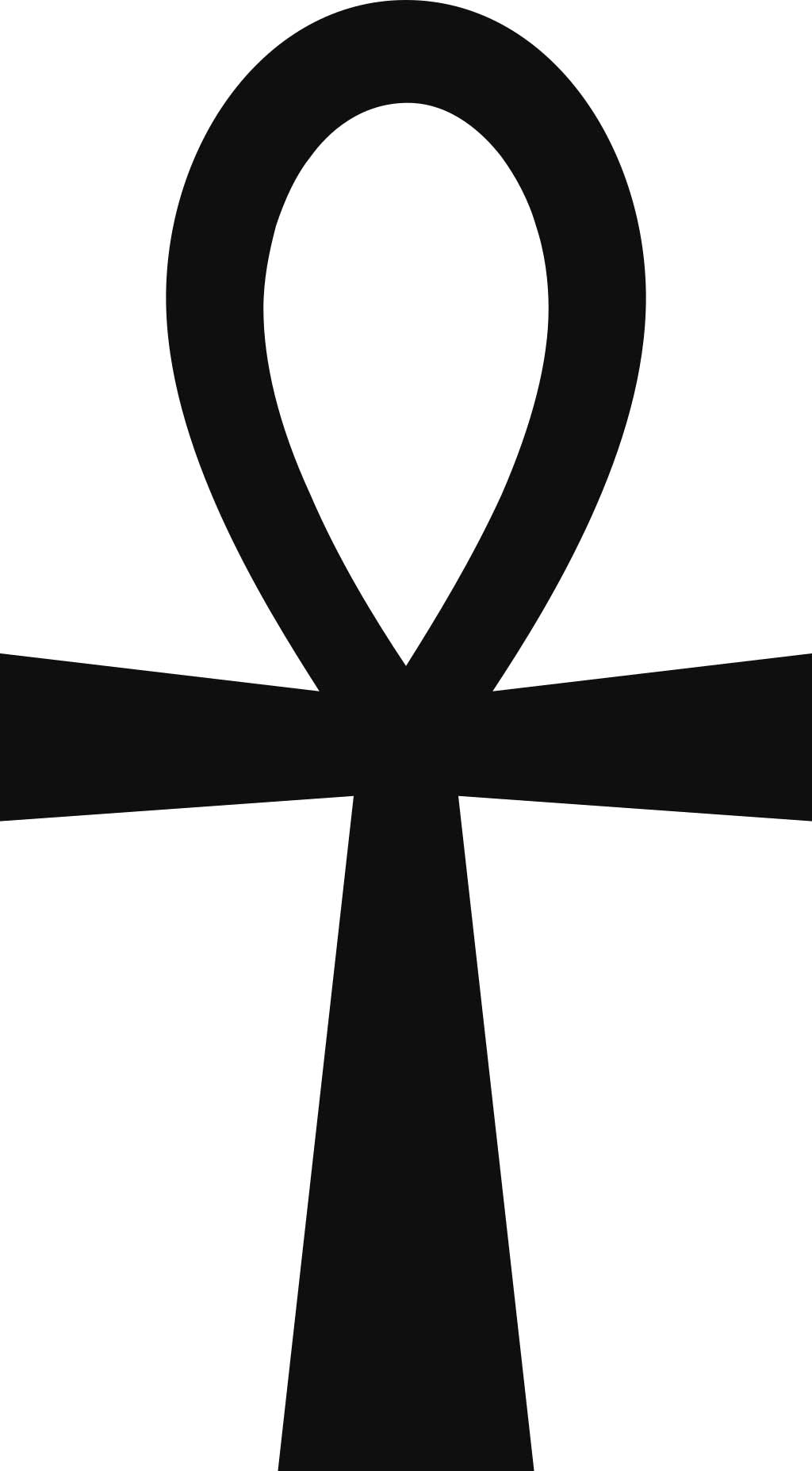
Fig. 7: Hieroglyph Anch
(Photo: https://anthrowiki.at/Anch)
The authors also considered whether the formal similarity of the Akuaba Dolls with the ancient Egyptian hieroglyph ‘Anch’ (the "loop of life" or the "key of life" - see Fig. 7) could have come about through a historical relationship between Egypt and Ghana. This would also correspond to the accentuation of content in Nkrumah's text with regard to the "representation of the woman as the giver of life" (see her chapter). Nevertheless, this association would also have to be examined more closely. To assume a universal archetype in the sense of C. G. Jung appears to be pedagogically misleading in its levelling effect.
In the German educational context, on the other hand, it seems important to link the figure - beyond clarifying its function - to Akua's story and thus include the role of narratives. This prevents another comparison that is also too quick and reductive when it comes to social practices (and not the isolated object), as dolls are also cared for and nurtured in traditional European contexts, but mostly by young children before puberty. So, in Europe, it does not belong to a fertility ritual, even if the child puts itself in the role of a ‘little mother’ or ‘little father’. (Another interesting question, whether Ghanaian women also go to a doctor when they are not pregnant, and whether there are comparable ritualised practices in Central Europe - for example among alternative practitioners or in esoteric circles - would have to be addressed in interdisciplinary approaches.)
Such comparisons appear to be useful, as they can show both similarities and differences, with the aim of better recognising one's own perceptual conventions or stereotypes and thus putting them into perspective. All this still leaves the question of the status of this doll in Munich when it is displayed in a showcase in a European museum (see Lab entry: What is an object? Link). Such a presentation contradicts its ritual and spiritual use. An Akuaba is then no longer an Akuaba. But what is it then?
Sources
This text is based on:
- Contribution by Gertrude Nkrumah: https://explore-vc.org/en/objects/the-akuaba-doll.html
- Talks with the Ghanaian EVC partners in Bayreuth in 2022: https://explore-vc.org/en/activities/archive/april-22-25-2022-joint-workshop-uew-team-and-isb-team.html
- The presentation at the National Museum in Accra, seen in March 2023: Fig. 4.
- Reading: see list of references
References
- Akyeampong, E & Obeng, P. (1995). Spirituality, Gender, and Power in Asante History. The International Journal of African Historical Studies. 28, 3. pp 481-508
- Anderson, Elizabeth L. (1989): The Levels of Meaning of an Ashanti Akua'ba. In: Michigan Academican. 21 205-219
- Annor, I., Dickson, A & Dzidzornu, A. G. (2011): General Knowledge in Art. Accra (Aki-Ola Publications)
- Forkl H. (1997): Healing and body art in Africa. Stuttgart (Lindenmuseum)
- Kecskési, M. (1999): Kunst aus Afrika - Museum für Völkerkunde München. Munich (Prestel)
Footnotes
[1] The number of five neck bulges here (there are also specimens with 3, 8 or 9 bulges) may also be a reference to the sacred number of "Odumankoma", the Akan creator deity, in this context.
[2] On the relationship of the European avant-garde to the aesthetics of West African carvings, see also the discussion of the Blue Rider post on this website (link 1 and 2).
 Christin Winter
Christin WinterMy Encounter with Black Feminism and Womanhood Inspired by the Akuaba Doll
I first came in contact with the Akuaba Doll while reading Bernardine Evaristo’s award winning book Girl, Woman, Other. In the book, the character Nazinga was described as “at least six foot tall with ornamented dreadlocks, large wooden Akuaba fertility doll earrings, red trousers, a cream embroidered caftan and strappy Roman sandals“ (Evarsito 2020, p. 81). I searched for Akuaba fertility doll earrings on the internet, but did not delve further into the topic at this time. A few weeks later, attending a seminar with Dr. Wagner at Friedrich-Alexander University in Erlangen, I stumbled upon the Akuaba Doll again. I knew, I had to take this opportunity to get to know her better. The comment from Gertrude Nkrumah is to be considered my first source of information about the history of origin and the tradition into which the Akuaba Doll is woven.
Through Nkrumah's feminist perspective on the Akuaba Doll, I wanted to dive deeper into the topic of Black Feminism to extend my knowledge in feminist theory. With the Akuaba Doll as my point of departure, I decided to focus on the ability to bear children and the social significance of abortions for Black women.[1]
At this point I move past the Akuaba Doll and her cultural context. Other works of art could have led me to a similar path. I have chosen to look at the Akuaba Doll with categories, which are not directly related to the Akuaba Doll and her cultural context as I questioned whether I have the right to write about the Akuaba Doll considering the colonial past of my own country, Germany. I am a white, European woman, a feminist, who is aware of intersectionality and racist structures within the society I have been socialised in and its way of thinking, but with no cultural connection to the Akuaba Doll other than the colonial impact on African art and culture (cf. Kushinator, Rahman and Dompreh, 2020[2]). Therefore, I chose a topic to which I have access via my role as a student of pedagogy and focus on Black Feminism and Womanhood of Black women living in white-dominated countries.
In white-dominated societies, Black women were excluded from a feminist movement for decades (cf. hooks, p. 216f.). White women systematically utilised the racist hierarchy within women to gain power and thereby forced a specific Black feminist movement to form and uncover the oppression Black women had and still have to face. The prefix “Black” emphases the specific oppression Black women face in white-dominated countries, although, of course, there has been feminist movements in Black-dominated countries before (cf. Roig quoted from Berlin Biennale 2022, 48:00 – 49:50).
In American history, Black women have always had to fight to be seen as women. As bell hooks gets to the heart of it: “the black female was a creature unworthy of the title woman; she was mere chattel, a thing, an animal” (hooks 2015, p. 214). Sojourner Truth[3] had to bare her breasts to prove that she was a woman indeed. Being yelled at “I don’t believe you really are a woman” by a white man represents the contempt and disrespect for Black womanhood (cf. hooks 2015, p. 214). In her famous speech “Ain’ I a Woman” (1851), she argues, that she – as her white women audience too – is indeed a woman. Here she argues with characteristics, that can also be found in the Akuaba Doll. The most important argument is the carrying and bearing of children and the “mother’s grief” (Truth 1851 quoted from hooks 2015, p. 215) she cried out, when her children were sold into slavery.
The ability to bear children has always played an important role in the history of womanhood and was – and still is – utilised to oppress and exploit Black women. In times of slavery, Black women were forced to procreate and bear children, who were worth a lot of money in a perfidious system of human trafficking (cf. Federici 2020, p. 23f.). In the late 20th century, Black men in the U.S. reasserted what they called their “rightful positions as patriarchs” (Taylor 2022) and denounced birth control and abortions as genocide that compromised the future and freedom of Black families by limiting the Black population (cf. Federici, p. 25f.). With the overturn of Roe v. Wade[4] – Black women are specifically affected, as Kwajelyn Jackson, Executive Director of the Feminist Women’s Health Center in Atlanta, Georgia puts it into a nutshell: "Abortion bans are inherently racist because they do not consider the lived experiences of Black people and other communities of colour. Many state policymakers would rather criminalize and endanger Black birthing people than supply them with all of the resources they actually need" (Jackson quoted from Long 2022). Even before the abortion laws were restricted, Black (and other BIPoc) women in the U.S were two to three times more likely to die from pregnancy-related causes than white women (cf. CDC 2019). Being allowed to decide whether you want children or not and furthermore, having access to certain facilities to end a pregnancy or not is still a bound to privileges. It is not only tied to the health care system, but also to cultural beliefs and practices, to the financial and educational background, as well as to class, race and many other factors.
In a world imprinted by patriarchy and privilege, it is important to unravel power structures that dominate our world, uncover where they come from and how different groups are affected differently. As patriarchal patterns of thought are inscribed in nearly all societies of our world, it is a tough task to uncover them in every aspect of our lives and hence require lifelong learning and feminist thought. Nevertheless, it is indispensable in order to build an anti-racist gender-equal society in which every woman can decide herself, if she wants to get children without fearing financial or social consequences.
In this context the Akuaba Doll can be interpreted as an early moment of feminism, where women disrupt the patriarchal system that marginalizes them. As Nkrumah states, by deciding about the gender of her child in a binary system, she chose to bear a girl rather than a boy, which – in the matrilineal line – effects the lineage, inheritance, and chieftaincy succession (cf. Nkrumah 2020). In my eyes, Akua used the power she had to influence her life to her advantage. Yet the worth of women was still tied to her sexual and reproductive abilities, but nevertheless she made a first step by empowering women to stand up for themselves and for their own lives.
References
Berlin Biennale (2022). Panel: Afrofeminism. Bridging the Gap. <https://12.berlinbiennale.de/media/panel-afrofeminisms-bridging-the-gap/> (09/30/2022).
Center for Reproductive Rights (2022). The World’s Abortion Laws. <https://reproductiverights.org/maps/worlds-abortion-laws/> (09/30/2022)
Evaristo, B. (2020). Girl, Woman, Other. UK: Penguin Books.
Federici, S. (2020). Jenseits unserer Haut. Körper als umkämpfter Ort im Kapitalismus. Münster: Unrast.
hooks, b. (2015). Ain’t I a Woman. Black Women and Feminism. New York: Routledge.
Kushiator, G., Rahman, A. and Dompreh, H.-O. (2020). The Influence of Western Culture on Traditional Art Forms and Cultural Practices: ‘Akuaba’ doll among Akan Women in Africa. ADRRI Journal of Arts and Social Sciences, Ghana: Vol. 17, No.6 (5), S.59 – 71.<https://www.researchgate.net/publication/344438737_The_Influence_of_Western_Culture_on_Traditional_Art_Forms_and_Cultural_Practices_%27Akuaba%27_Doll_Among_Akan_Women_in_Africa> (09/30/2022).
Long, S. (2022). Abortion Bans pose a Danger to all Mothers. For Black Women, they’re especially damaging. <https://www.refinery29.com/en-us/2020/10/10015405/abortion-ban-racism-black-women-effects> (09/30/2022).
Nkrumah, G. (2021). Inversion of Hegemony with Ideas of Feminity. <https://www.explore-vc.org/en/objects/the-akuaba-doll.html> (09/30/2022).
Taylor, K.-Y. (2022). How Black Feminists defined Abortion Rights. <https://www.newyorker.com/news/essay/how-black-feminists-defined-abortion-rights> (09/30/2022).
Footnotes
[1] In this context, I will delve into the topic of reproductive abilities and use the term "woman" throughout my text. However, I want to clarify that the ability to bear children is not a defining characteristic of womanhood. Not all women have a uterus, and not all women are able to bear children. Furthermore, one's physical appearance is not a determining factor of one's gender identity. Despite this, the reproductive ability is instrumentalised in our society and can lead to harmful stereotypes, which many women are confronted with at some point in their lives.
[2] In addition to exploring the different forms and cultural backgrounds of Akuaba Dolls, this article delves into the ways in which culture, religion, and artistic expression are intertwined in African cultures. The article points out how the colonization by white, western, and Christian men and women caused a change in function and values of the Akuaba Doll.
[3] Sojourner Truth lived from 1797 to 1883. She was an American abolitionist of New York Dutch heritage and a women’s rights activist. She was born into slavery, but escaped to freedom in 1826. In 1851 she joined George Thompson, an abolitionist and speaker, on a lecture tour through central and western New York State. At the Ohio Women’s Rights Convention in Akron, Ohio, she gave her speech with later became famous as “Ain’t I a Woman?”
[4] Roe v. Wade is a legal case in which the U.S Supreme Court ruled that unduly restrictive state regulation of abortion is unconstitutional and that the Constitution of the United States generally protects a pregnant woman's liberty to choose to have an abortion. This decision from 1973 was overturned by the U.S. Supreme Court in 2022.
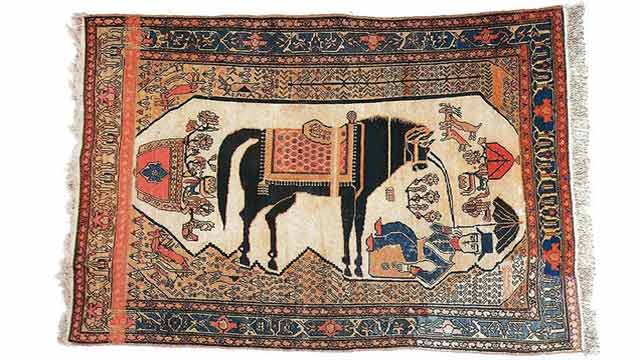
-
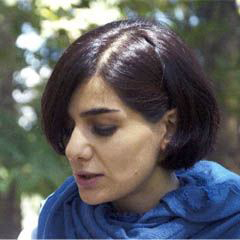 Azar Emami Pari
Azar Emami PariA carpet is neither produced nor read like other pictures. As such, how does it communicate and what is the proper way of reading a carpet? Does it enjoy an esoteric meaning? A meaning beyond that of its patterns? In other words: is the carpet a decorative object with a symbolic or iconic meaning added on top, or does it contain—at least for viewer who belongs to Persian visual culture—a meaning completely different from any other quotidian object? The mesmerizing power of the carpet lies in the fact that it convinces the viewer of the latter. Many studies on the subject aim at understanding how different Persian carpets are made, trying to elucidate the nature of their mode of production. Yet, “how the appearance is consumed”[1] has rarely been the subject of study, as well as inquiring about the causes behind the formation of such a bizarre appearance. It can easily be shown that the answer cannot be reduced to how a carpet is produced: it is clear that Persian carpets are more than, as it were, a pixelated version of Persian images found in other Persian decorative arts, or the product of a “design process” (as one understands the term today) and sheer creativity; it is rather an object unlike any other quotidian objects and not just another branch of fine or decorative arts.
It is very difficult to penetrate the different layers of meaning in a Persian carpet, at least much more so than Persian miniature paintings for example there is a winding path from form to meaning in carpets. A Persian carpet has something to say that is not a statement: it is not a text with a definitive meaning, not even one that we could call “abstract” in the sense of avoiding any reference to the real world. Similar to mystic verses of Sufis, known as shat-hiyyāt, whose general meaning is unclear to the reader, yet written down, with meaningful words, for a purpose clear to the author, the appearance of carpets insists on signifying something: they are not just pleasant melodies without words. As such, the carpet cannot be studied as an abstract painting. (Probably that is why it has rarely inspired modern Persian paintings and protects itself against easy visual plagiarism.) The image of a carpet is not the same as the carpet itself: the carpet is not produced to be “seen”, rather be “watched” in the long term. It is meant to be lived on, not to be distanced from the viewer to produce a moment of reflection, which is the essence of European painting. It is not an exaggeration to say that every Iranian grows up on a carpet and learns visual literacy from it. It is the very first window through which every Iranian look. The opposite of a Renaissance painting, i.e. a window opening to the outside world, is the carpet, not even the Persian miniature painting.
Despite its decorative function, the effect of Persian carpets, and in particular pictorial Persian carpets, on viewers do not depend on the text that accompanies it (as is the case with urban, fictional, pictorial carpets[2] and Persian painting alike). The origins of pictorial carpet have been, as it follows, purely aesthetical, nothing more.
Historically, pictorial carpets appeared as new art, not only because of a change in their function but also because of their new appearance[3]. They were woven according to the personal taste of weavers or specific clients, and for that reason, they were less mass-produced. There is no doubt that such carpets as Persian miniatures are ultimately born of the poverty of illustration[4] in Iran. Such carpets, also known as figural carpets, “emerged in the late twelfth century AH (18th century AD) following developments in various other fields of art in Iran and coincided with the emergence of new possibilities in the visual realm, such as printed pictures or photographs. All these led to a new expression in Persian carpet weaving.” (Tanavoli, 1989:9) The story narrations in the pictorial carpets of Iran have different origins. Themes of pictorial carpets include kings, epic and romance stories from classical Persian literature, religious themes and stories of Quran, dervish and Sufism, Armenians pictorial carpets, nomads’ pictorial carpets, pretty women, and animals.
In order to enter the realm of the Persian carpet, let us begin from a simpler point of departure. We ask: what is the relationship of the carpet to the space in which it is unrolled? What is the horizon of the carpet and what is space and time in the carpet? The objective form of such a relationship is reflected in the relation between the carpet and the architectural space. Of course, we have samples of carpets woven for a particular space, as well as spaces built to house a particular carpet. We know, for example, that Nasser al-Din Shah (who reigned from 1848 to 1896) ordered a complete building to be fitted with a carpet he received as a present from the Ottoman sultan. Mo’ayer al-Mamālek writes: “Abyaz Palace: Although the building is still in place, not everybody knows why it was built, therefore, some facts are mentioned here. Sultan Abdul Hamid sent dozens of pieces of furniture and some precious Turkish carpets to Nasser al-Din Shah. Several large portraits of European kings and queens painted by the most influential painters of the era were also given to Nasser al-Din Shah. As other palaces were all decorated with various ornaments and were not suitable for the aforementioned gifts, so the king ordered the Abyaz palace to be built and tailored to the size of the largest Ottoman carpet. When it was finished, they unrolled the carpet in the hall and decorated the space with precious upholstery. They hung the portraits together with another painting depicting Napoleon I, given to Fat’h Ali Shah, thus creating a magnificent hall for receiving kings and dignified guests. One day I was there when the king went to the treasury, and there he chose some artifacts to complete the arrangement of the Abyaz palace.”
The visual significance of the Persian carpet must be considered as Iranians’ historical understanding of art and painting as an independent language, and pictorial carpets can perhaps be formulated as a new form of testimony to such a language. The language begins with the synchronicity of Persian painting with literature and fiction texts and its culmination in the pictorial carpet. Persian painting is considered narrative art. “Because some example of Persian painting is an illustrated book that depicts a literary text, most of which are fiction.” (Shokrpour, Azhari, 2019:104) In Persian painting, the drawings depend on the text “and this feature is one of the main features of the illustrations of Shahnameh, which includes short and concise themes in which the narrative aspect lies. These texts were chosen for illustration because their readers were fully acquainted with the leading text, allowing the painter to show the last minutes of the events and the most notable or most tragic moments in his work.” (Shokrpour, Azhari, 2019:104) The logic of the carpet, however, is much more complex than painting. The charm and wonder of the pictorial carpet stem from the middle point between the carpet and painting, where the story originates, and which, of course, has become “inexpressible.” Neither the image nor the story is a reality of this world; just like the miniature, pictorial carpet is also an imaginary window to stories; no event or thing in that frame has a real presence. They are pure images (without any text) that create a suspended and immaterial world of colors, shapes, and textures. Pictorial carpet is a unity resulting from the contradictions between the common presence of figural pictures and details of carpet designs. That is why the carpet frame and its details have added to its grace and appeal rather than reducing the magical attractiveness. The “childish” aspect of such images, which are not solely due to the weaver's inability to render everything realistic, is a result of a vast game of imagination combined with pictures.
What is unique in the pictorial carpet is the magical aspect, and the subject of the painting is completely insignificant. Of course, in harmony with the scene, each picture has its own special figural drawing and necessities in terms of color combination. (The color combination is insignificant in nomadic and rural pictorial carpets. For example, the skin color of the body could be very strange, e.g., red, etc.). But whatever the image is, whether romantic like countless scenes of Shirin bathing with Khosrow secretly watching her or battle scenes, such as the battle of Rostam and Sohrāb, the shocking effect of the pictorial carpet is the same in each case.
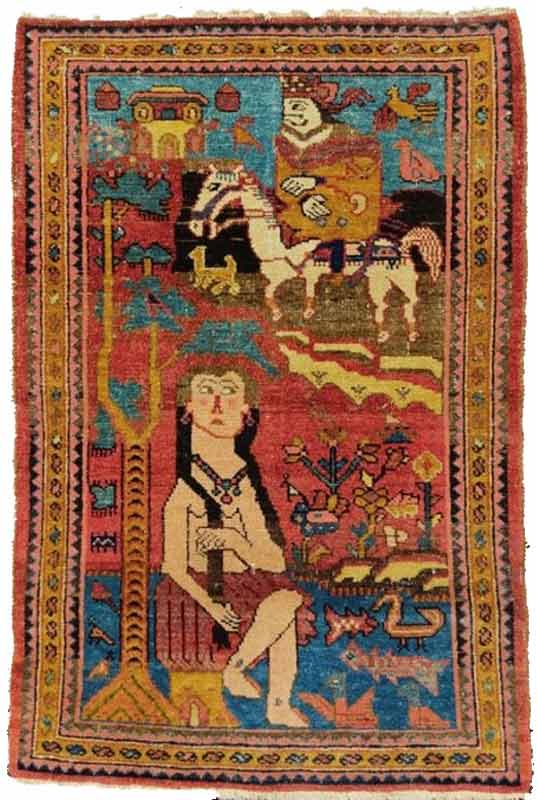

Figure 4: Lilihan Poshti. The story of Khosrow and Shirin. Natural color, size 100*67 cm, Yousef Samadi Bahrami’s Collection.
Figure 5: Rostam and Sohrab, Karabakh (South Caucasus), inscription reads: “Sohrab” (inverted text), late 13th century AH, 120*85 cm, asymmetric knot, displaying 672 knots per square decimeter (Tanavoli 1989, 43) When the carpet depicts a story, it does not narrate it.
A pictorial carpet is not really depicting the place of an event or the feeling or interpretation of what happened in the scene. Apart from the feeling of wonder at the visual beauty reflected in the carpet, there is nothing but a thoughtful or emotional expression: there is no drama, no sadness or sense of impression. The event as a whole is an absent element in the pictorial carpet. All details are equally important; thus, the important function of a pictorial carpet is that it guides the viewer's gaze on numerous details of the carpet, while an inner harmony skillfully creates a strong, decorative unity. Such carpets attract viewers’ attention, not because the scene is a special story that is unsuccessful in its narration, but in the harmony with the story figures within the form of a carpet.
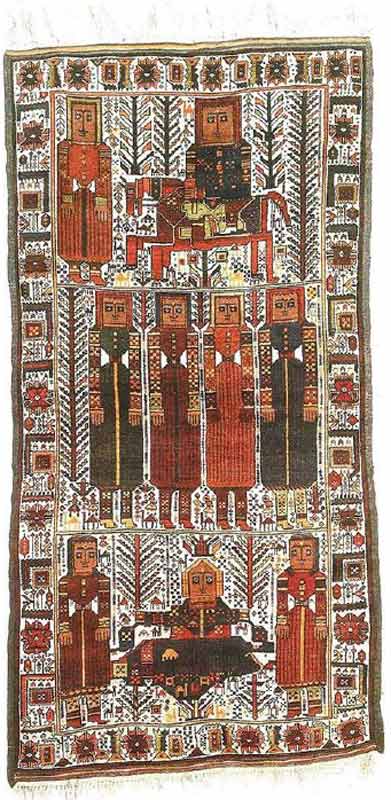
Figure 6: Baluch, Zabol, mid-14th AH century, asymmetric knot, 1280 knots per square decimetre; this carpet displays a scene from the story of Khosrow and Shirin. However, the images in the carpet do not narrative anything and if the viewer is unfamiliar with the story there is little to be understood from the images. (Tanavoli 1989, 48)
Of course, the carpet, in its physical aspect, has a distinctive relation to space in Persian architecture, as it covers a rectangular space that shall not deflect both horizontally and vertically. It is true that the carpet was not always considered a floor covering and not necessarily been rectangular in shape: as in the case of saddlebags and cushions, or carpets hanging from walls or covering a horse or a mule, and so on. Yet it is the Persian architectural space that provides a flat, rectangular space for the carpet: it is part of the formal relationship of carpets with the architectural space. This is why in European paintings that feature a Persian carpet, the first thing that strikes an Iranian viewer is the unusual use of these carpets: Hung from a window crawled up the stairs and deflected in height. This, in itself, has a definite relation to the way the carpet is seen: on the one hand, the formal carpet looks like a horizontal tableau that is clearly framed and as such forms a totality. It does not resemble, for example, the scattered Islamic designs on glazed tiles that crawl up walls whose entirety forms the totality of the building; on the contrary, the carpet has a strong, coherent framing that protects it against any deflection.
In the past, Persian carpets were not masked by pieces of furniture and thus better seen in their entirety. The carpet was the most important part of interior design. It was a furniture in itself. Thus, the carpet is fundamentally different from a painting: viewers of a carpet never actually see it in its entirety because they are already standing “on” the carpet. They never lose contact with it or distance themselves from it, far enough to see it in its entirety. They can kneel and touch it, or sit or lie down on it and get closer to it as much as they want, but their distance to the carpet never exceeds their height. The prohibition of walking on carpets with footwear allows a close and intimate relationship with the carpet, emphasizing its dignity and sanctity. Even paintings on ceilings (which sometimes reflect the patterns of a carpet, as in the case of Sheikh Safi’s tomb) do not enjoy such quality and can be seen and appreciated in one glance while remaining out of viewers’ reach. In the case of carpets, viewers can see the design from different angles and need to move in space and change their standpoint to fully appreciate the work (exactly the same way they need to circulate within the introverted spaces of Persian architecture in order to grasp a proper sense of space).
It might seem that the distance between the carpet and the observer is a secondary quality of the carpet and does not have a direct impact on the aesthetic aspect of the Persian carpet. However, we know of aesthetic systems (including that of Kant) that define the aesthetic experience fundamentally on the basis of an idea of distance. The most prominent is that of Edward Bullough (1880-1934), the English aestheticist, i.e. Psychical Distance. In a paper published in 1912, Bullough writes that the aesthetic experience takes place at a certain distance from the work, not too far nor too close, and this applies to the locative, temporal, and subjective distance of the observer from the object, and is an aesthetic principle (Neil 1995, 304), and is an element present in all art forms (ibid., 299). The transition from the agreeable to the beautiful takes place through distance (Neil 1995, 305). And it is advisable to reduce this distance both in creating and in understanding art, without having it completely removed. (Neil 1995, 302) In his view, this depends both on the audience and the object (Neil 1995, 302). For instance, the Persian miniature takes advantage of its small dimensions to reduce such distance. In carpets, however, the distance is completely different, both objectively and subjectively. The maximum distance is a person’s height and the minimum is zero. It is this distance that has resulted in the unique form of viewing carpets. The Persian carpet is not seen, but “watched” (tamāshā), as was the case with Persian gardens. That is to say, carpets were observed in motion, with a constant shift of the viewer’s point of view. The term tamāshā means “to watch” and “to walk in the garden with a friend” at the same time. Such a relationship between how carpets and gardens are viewed is by no means a coincidence. Persian carpets have long been associated with Persian gardens, sometimes even reflecting and imitating their patterns. In terms of function, the Persian carpet brings nature into the interior and plays the role of green in times of the year when grass does not grow. We know that the famous Sassanid “Baharestan” carpet had a similar function. Tabari History writes about this carpet:
“They wove a carpet with colored silk, sixty cubits in sixty cubits … they unrolled it in wintertime when no flowers blossomed and no green was seen on the globe. On the margins were sown emeralds and peridots… Omar ripped the carpet and the gems and gave each person a fair share… Ali ibn Abi Talib received his, which he sold for twenty thousand Dirhams.” (Tabari History, 1985, 41).
Thus, we encounter one of the most important subjective aspects of the relationship between carpets and architecture: the viewer is a part of the image; the observer of a carpet is “inside” the carpet. This also properly explains the horizon line in Persian carpets, which is very different from that of miniature painting: the carpet does not necessarily have a horizon line, and the horizon line is not necessarily within the carpet or in its “upper” part. The figures in pictorial carpets are not depicted “on” the carpet but are rather “inside” the carpet, like a letter in an envelope.
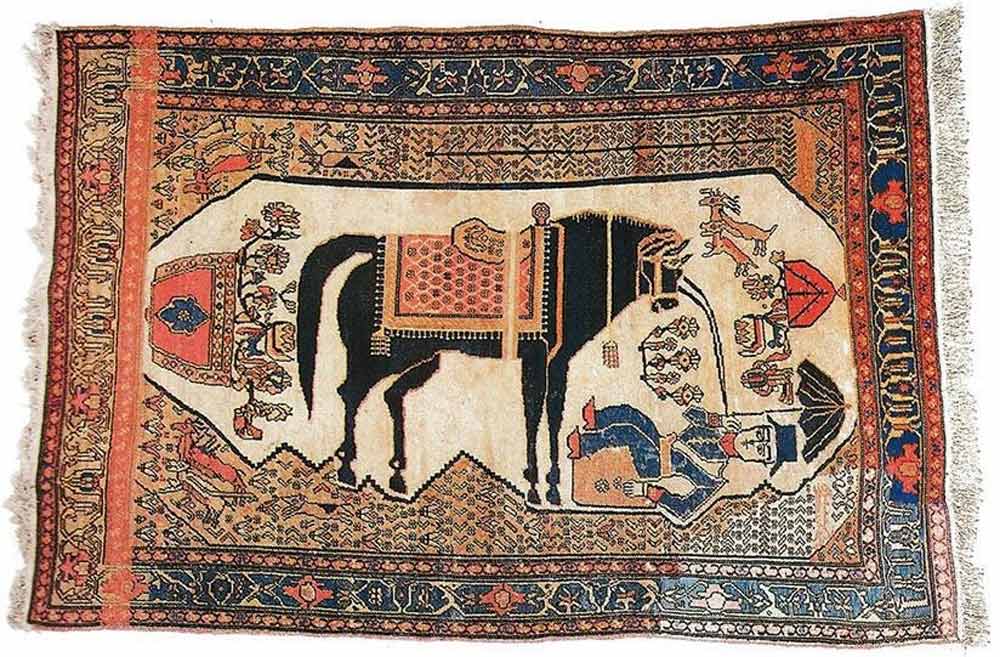
Figure 7: Horse and stableman, Hamedan, Darjazin, early 14th Century AH, 189*129 cm, symmetrical knot, 1296 knots per square decimeter (Tanavoli 1989, 95). The logic of the carpet design is much more bizarre than miniature. Where is the horizon line in this carpet?
This statement is also true on another level: the observer is “within” the carpet subjectively too. The carpet is not a home decoration, it is part of the home: it is home itself. This is why the unit for counting carpets, was called “home” (khāneh), or why the carpet sometimes imitates the plan of the Persian houses or gardens. Children are well enough familiar with this concept and elders respect it too. Children carefully trying to walk on the lines of a carpet pattern imagine themselves walking on a bridge above avoid. The patterns of a Persian carpet always show depth, as opposed to Persian miniature painting which appears flat and even.
So, when confronted with carpets, even pictorial ones, “touching” is more important than “seeing”. In fact, this is the only way to see it. Touching renders, us more dominant. Seeing does not allow one to understand the physical quality of a phenomenon, but the tactile sensation does. In pictorial carpets, this touching proximity is more realistic than an unattainable distance, as it empowers the viewer to touch the universe once again. The carpet is a representation of the universe, as the root of the Persian term indicates: in Haji/Engineer Travelogue, Ali Hassouri traces the root of the word Qāli (carpet), back to Qalin in the early Islamic centuries, to the words Kalinin the Sassanid era and Kar’einé in Avestan, back to the word Kāshtan (“planting”), as making every carpet knot is like planting a seed, that would later represent grass at the time of its absence in winter: the carpet is a perpetuated Persian garden. (Hassouri 2017, 42) In Mithraism, human beings are descendent of the plants: Mashya and Mashyana, the first human beings to grow out of the earth. Each knot of a carpet is a seed that is planted with hope and carries a wish, the same way lovers knot grasses in Nowruz with the hope of their wishes being fulfilled. Every Persian couple begins their married life with a home/carpet on which their children will later grow up and flourish.
Resources
- Emami Pari, Azar, and Bavand Behpoor. “The Iranian Carpet Is not a Picture”, Herfeh Honarmand (Iranian quarterly journal on visual arts), no. 73 (2019): 151-160.
- Parviz Tanavoli (1989) Iranian Pictorial Rugs (Tehran: Soroush Publication)
- Hafiz-e Abru, Nur-Allah ibn Lotf-Allah ibn 'Abd-al-Rashid Behdadini, edited by Seyyed Kamal Haj Seyyed Javadi (Tehran: Ministry of Culture and Islamic Guidance Publications)
- Ali Hasouri (2017) Haji muhandes Travelogue (Carpet Travelogue) (Tehran: Cheshme Publication)
- Doost Ali Khan Muir al-Mamalek (2011) Notes on the private life of Nasser al-Din Shah (Tehran: Iranian History Publication)
- Alex and Aaron Ridley Neil (ed.) (1995) The Philosophy of Art: Ancient and Modern Readings (Boston, Mass.: McGraw-Hill)
- shokrpour, and f.azhari , Azhari. “The role of the Figure in the Narratology of Persian Paintings” (Case Study: Six Drawings from Shahnameh Tahmasebi), Journal of Visual and Applied Arts (Quarterly Journal of Tehran Art University). no. 25 (2019): 101-121.
- Tabari History, illustrated version, 1208 ed., Astan Quds Razavi, Iran Culture Foundation, 1966, 17-18, quoted from Parham 1985, 41.
Acknowledgments
I would like to express my special thanks to my colleague and friend, Mr. Bavand Behpoor, for his intellectual support and insightful comments on this paper.
[1] The function of a carpet does not justify its appearance: Persian carpet has played throughout history a much more significant role for Iranians than merely providing a warm and soft flooring and has gained its appearance through complex and lengthy historical procedures.
[2] Persian pictorial carpets have been divided into two classes: one is urban carpets, and the other rural and nomadic ones. Urban carpets were woven according to a plan, painted by a carpet-designer, while nomadic carpets had a different origin. In Iranian villages and among Persian tribes, carpets were woven without a plan, and rather based on another carpet. When a weaver intends to weave a carpet, s/he borrows a carpet from their neighbors or relatives and uses it as a model (in local parlance: “Dastūr”). (Tanavoli, 1989:16)
[3] The installation of pictorial carpets on walls brought about changes in the way carpets were used. The new application moved the carpet from the floor and underfoot to the walls, turning it into a painting. Previously, ordinary carpets were occasionally hung on at door gates and walls, but that was a temporary function, in occasions such as wedding, religious celebrations, especially commemorating the birthday of the last Imam (the Messiah or “Mahdi”). Walls of houses, shops and markets could be decorated with carpets, a custom that still exists today. (Tanavoli, 1989:14)
[4] The 19th and 20th centuries should be considered the time of popularization of illustration in Iran. In those two centuries, a significant tendency towards simulation and naturalism became apparent in nearly all branches of art. Simulation, as a pervasive movement, attracted the attention of artists. The leaders of that movement, of course, were painters. Although painters constitute different classes and branches in this, the main goal of all groups was to depict their subjects through likeness and similarity to nature. Two groups of painters had the largest share in spreading visual arts among the masses: Coffee-House painters and religious painters. The works of these artists were widely seen and influenced the taste of artists in other disciplines, including engravers, illustrators of printed books, and carpet weavers. (Tanavoli, 1989:11)
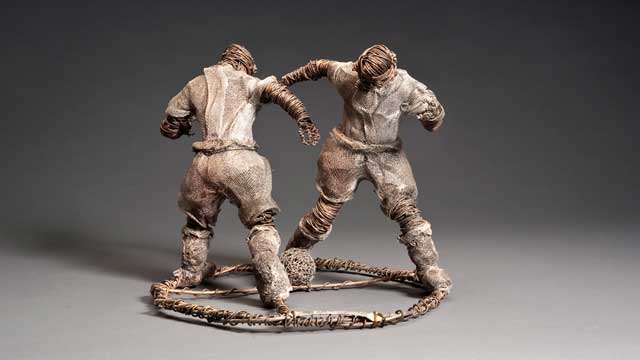
-
 Stefan Eisenhofer
Stefan EisenhoferHis artistic production is informed by the basic concepts of "love", "peace" and "liberty", and he expressly hopes that his works will help to create a better future.
Since 1996, after twenty-five years of working with clay, plaster, stone, cement and wood, Joe Big-Big has mainly used wire, iron nets and barbed wire to produce works with a very characteristic signature. Through the use of metal nets, he produces an effect of lightness and dynamism, even in sculptures several metres high. It was his fondness for big and high sculptures that earned him the nickname Big-Big.
Through his choice of materials he reveals the preoccupations that inform his work: he believes that people are free to decide whether they want to produce or destroy something, to encourage or suppress. In Joe Big-Big's work, wire and barbed wire, commonly symbols of oppression, captivity and division, represent the overcoming of bondage: they stand for prevention and protection. Joe Big-Big plays here with the notion of wire as an everyday material that normally goes unheeded, but which can become an instrument of human creativeness and global understanding through artistic activity. However, in Joe Big-Big's work this metal material seldom loses its ambivalence – for it is also a symbol of human labour and human toil. The artist makes use of these associations in works showing toiling people.
Joe Big-Big is intensely interested in the iconology of his metal materials and the objects he integrates into his works. Padlocks, for instance, symbolize the difficulties we get ourselves into, while keys stand for solving problems, freedom, peace and happiness. Coins represent the money we need to live, and clocks or watches are references to the time we need for solving our problems on the way to a carefree future. The metal materials thus symbolize wealth, strength and power. The artist also deliberately combines old with new metals, as a reminder that one needs to remember the old in order to be able to cope with the present and the future.
The themes taken up by Joe Big-Big come from nearly all areas of human life. His works are concerned with very personal issues as well as with political topics, such as war, poverty, flight, displacement, or the equality of women. He believes that his images speak louder than words, and he intends them to arouse emotions in the viewer, for "art without emotion, feeling or meaning is like a voice or a noise without meaning".
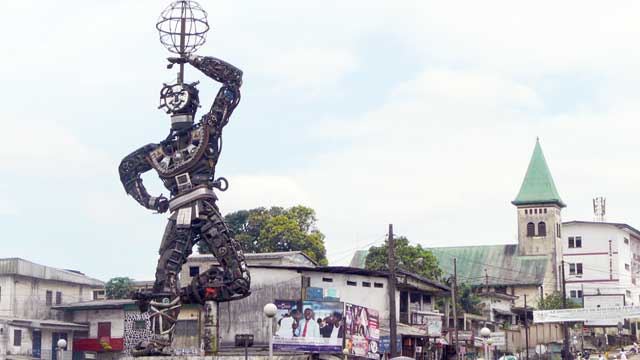
-
 Paul-Henri Souvenir ASSAKO ASSAKO
Paul-Henri Souvenir ASSAKO ASSAKOThrough its form, it reveals the modern urban context, a composite universe whose harmony is constantly negotiated in the logic of the delicate assemblages that characterizes the artist's technique. The work also reveals the socio-cultural mutations of which the artistic practice becomes an expression with its new form. Through the processes of recycling and assembling industrial waste, through the monumental appearance of a work whose silhouette recalls a human figure, through its installation on a roundabout, La Nouvelle Liberté brings together the elements of a manifesto of the transformation of cultural practices and particularly of the visual arts in the second half of the 20th century in Cameroon.

Screenshot from the entry about Douala on Wikipedia
This sculpture is special because of the context in which it was created. The commissioning of the work was part of the first projects of the very first and almost unique contemporary art center in Cameroon, doual'art (1991). The Centre was born in the aftermath of the adoption of the law on freedom of association (law No. 90-53 of December 1990). The approach to artistic promotion that it adopts is defined by the principles of artistic act-action-activism as the main modalities of intervention in the city of Douala. It is in this approach that doual'art commissioned the sculpture from Joseph Francis Sumégné.
Doual'art's artistic project SUD2017 (Link) is a clear expression of the freedoms to which Cameroonian society ardently aspires, according to the president of doual’art, Marilyn Douala Bell. She describes its context as follows: “while the project’s gestation began in 1981, after the election of Francois Mitterrand as president of France, the two principal triggers occurred in the 1990s in Cameroon: firstly, socio-political movements incited the people to seize the street and reclaim “democracy” and, secondly, there was the promulgation of December 1990 law authorized freedom association for the first time in this country” (I. Pensa & al., 2017, 9).
Nouvelle Liberté is one of the major works that marks the transformation of artistic practice in Cameroon which now focuses on the contemporary national society in its various historical, socio-cultural, political and economic aspects. The work takes a great conceptual dimension; it draws material from the field of negotiation and change of cultural meanings in the same context that inspires the image it reflects. For Sabine Breitwieser “for many this field has become the basic practice, focusing on actions and processes along the connecting line between the arts, everyday life, and politics” (A. Alberro & S. Buchmann,2006, 9-10).
Joseph Francis Sumégné explores the urban world both from the material and the conceptual perspective. According to Joana Danimbe (2021), the city is a field of experimentation that affects the work of this artist. The process of making the work and its title place the observer in a critical relationship with urban modernity. The sculptural work echoes the city in which it is erected. It echoes it by its constructed form through a process of assembling diverse heterogeneous elements, industrial waste (plastics, metals, alloys of all kinds) that the city has difficulty in absorbing.

Sumégné, Nouvelle Liberté, Detail (Creative Commons)
The difficulties posed by the management of industrial waste is only one aspect of the work, which questions the impact of the accelerated modernity of the mentalities of city dwellers, which Yakouba Konaté notes as new and characteristic in African cities (Assako, 2011, 103). In this context of modernity par excellence, it is difficult to guarantee the harmonious development of those who live there. The latent tribal and communal tensions in these cities are a sufficient proof of the fragility of this harmony. For example, the nickname "Nju Nju (evil spirit) of Deido” given to Sumégné's work highlights some aspects of the limits of collective integration posed by the cities. The artist reminds us that: “this negative designation is based on the strong protests voiced by native populations against La Nouvelle Liberté. After these first polemics, mainly concerned with aesthetical features of the sculpture, a violent controversy was raised by the media on the origins of the artist (who hails from the western part of Cameroon) taking the fold of an ethnic struggle between the indigenous people of Douala. For such reasons, La Nouvelle Liberté was officially inaugurated only eleven years later, during SUD 2017” (I. Pensa & als., op cit., 93).
The city of Douala, the economic capital of Cameroon, makes the facts of social and cultural transformation, industrialization and related issues in Cameroon remarkably appreciable. Douala is the most important port city in Cameroon and Central Africa. It is a city of great industrialization. The economic opportunities offered by the city make it a real national and international pole of attraction and an important migratory drop-off point as well. The city is therefore a center of great demographic concentration and mixing. It is reputed to be the most polluted city in Cameroon due to its industrial and economic activities and its human density. It is also the city most exposed to social implosion due to the high number of young people who find themselves in precariousness and in search of decent employment. The balance of urban life depends on the city's capacity to promote a process of integration which leads to the construction of a collective identity.

On the right: J.NicolasKondaYansa. Vue aérienne de Douala (Creative Commons).
This is the phenomenon that the image of Sumégné's work has succeeded in bringing about in Cameroon over the past twenty years. It has crossed the phase of rejection and critical questioning to become the object of collective appropriation and an emblem for the Douala people in particular and the Cameroonians in general. "By recovering rejected objects, the artist becomes by force of circumstances a full-fledged actor in the organization of urban life, sharing the basis of his innovative thinking on the relationship between cities, cultures, representations of working-class neighborhoods and environmental ecology. “In his thinking, the city is a place where the intimate (the family side, religion and its rites) and the universal (openness to other cultures within the city) meet” (Joana Danimbe, op cit., 33).
However, this collective identity is not given. There are permanent conflicts between rural and urban, rich and poor, order and anarchy, libertinism and freedom, civic-mindedness and uncivil behavior, etc. For politicians, however, national development is expressed through actions that are generally in vain and aimed at giving a 'modern' appearance to cities. It should be noted, however, that the urban ecosystem, on a social level, lives on the permanent 'daptaïsme[1]' (S. Andriamirado, 2002) of city dwellers in search of a balance between the socio-economic and political references of Western modernity and those relating to the various local customs that are superficially apprehended. In such a context, flourishing in the city takes its trajectory from inventive intuitions as demonstrated by Sumégné in the process of shaping La Nouvelle Liberté. The artist's bold work imposes itself on the city dwellers in the form of a new experience. He magnifies this experience through the novelty and singularity of the codes of representation of his artistic work. The elements offered by the city and used by the artist to create his works are chosen on the basis of two main values: they are true generators of ideas and they are inspirers of structures.
The verticality of Sumégne's work is evident at the Deido roundabout, which is one of the main entries of the city of Douala. The sculpture has a human silhouette and stands on a concrete pedestal. Its posture describes a movement whose balance is suggested by an asymmetrical gesture and a distribution of masses and volumes in relation to the vertical axis. The ascending tension of the monumental sculpture is supported by the base of the right foot, crosses the trunk, the head and ends on the globe which caps the upper end of the work. The movements described by the limbs make the sculpture even more dynamic. The bent left leg crosses the right leg at knee height from behind. The position of this leg structures the pelvis and the part above the knees of the figure in a truncated cone shape. The upper left arm is raised above the head to hold the globe and the right arm is bent and oriented as if to rest on the hip with the fist closed.
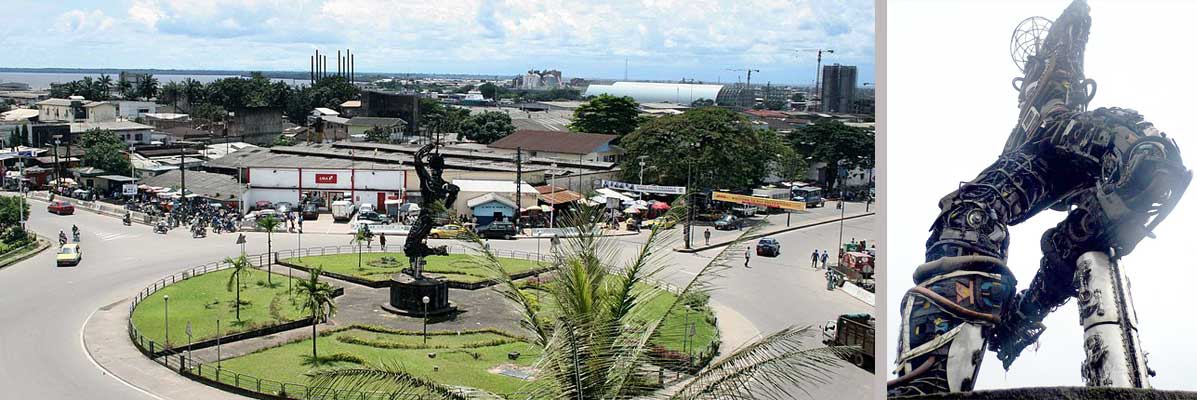
Steve Mvondo, NadègeNN: Sumégné, Nouvelle Liberté (Creative Commons left / right)
A dynamic posture that gives the work pride of place, but also conveys a sense of fragility. This proud appearance is further suggested by the expressiveness of the statue's circular head, which draws a smiling face or a sun. The attention paid to the elegance of the statue can be seen in the details of the adornment on the work. The neck is outlined with a grey band that acts as a necklace. The same band is used to define the belt worn by the figure. A sort of waistcoat covers the figure's torso and contributes to the attention to the adornment being a characteristic detail of the work. The care given to the detailed elaboration of this kind of waistcoat enhances the drawing, engraving, upholstering, painting and sculpting skills, which allow the artist to easily interweave the traditional with the modern and the modern with the traditional through the technique. The technical game describes a stirring of the memory in which Sumégné crosses the past and the present in a delicate process of balance, harmony and construction of a work of art that the work gives to appreciate.
The accelerated modernity of mentalities is accompanied by deviations rather than guaranteeing the expression of freedoms favorable to the construction of a collective identity and a more social dimension of the meaning of development in the cities. The Cameroonian city must cease to be a mere showcase for political celebration / instrumentalization and a springboard for socio-professional accomplishment for city dwellers and become the real space for a new life, a sustainable life. Art, as illustrated by Nouvelle Liberté, has embarked on this path by investing itself materially and conceptually in the urban environment: The contemporary art scene in Cameroon's economic capital, which is one of the most active and committed in urban Africa, is itself in constant movement. Objects, ideas and practices are given new meanings on a daily basis, often politically, and which, like “La Nouvelle Liberté", highlights questions of identity, the right to speak and self-determination (D. Malaquais, 2006, 122).
Published 2020
References
- Alberro Alexander & Buchmann Sabeth. 2006. Art after conceptual art, Vienna, Austria, Generali Foundation, pp.9-10
- ANDRIAMIRADO Virginie. 2002. « Tout est prétexte à la création », entretien avec Ndary Lo, in « Africultures, n° 48 » Éditions l’Harmattan, 63-67
- Assako Assako PH.S. 2011, l’art au cameroun du XXe au début du XXIe siècle : étude des expressions sculpturales en milieu urbain, thèse de Doctorat/Ph.D. en histoire de l’art, Université de Yaoundé
- Danimbe Joana.2021. Joseph Francis Sumegne, le méditoire du Jala’a, Paris, Ed. Fondation Blachère
- Dominique Malaquais, « Une nouvelle liberté ? Art et politique urbaine à Douala (Cameroun) », Afrique & histoire 2006/1 (vol. 5), p. 111-134.
- Lagnier Sylvie. 2001. Sculpture et espace urbain en France, histoire de l’instauration d’un dialogue 1951-1992, Paris, Ed. l’Harmattan
- Pensa Iolanda & als. 2017. Public art in Africa, Genève, Metis Presses
[1] Vocabulary borrowed from the Senegalese sculptor NDARY LO, who designates "daptaïsme" as a philosophical principle on which his art is based, and which consists in adapting to everything and in all circumstances. The artist collects salvaged objects that he diverts and manipulates according to the circumstances of his creation. So, the urban ecosystem adapts and cobbles together alternative solutions on a day-to-day basis.
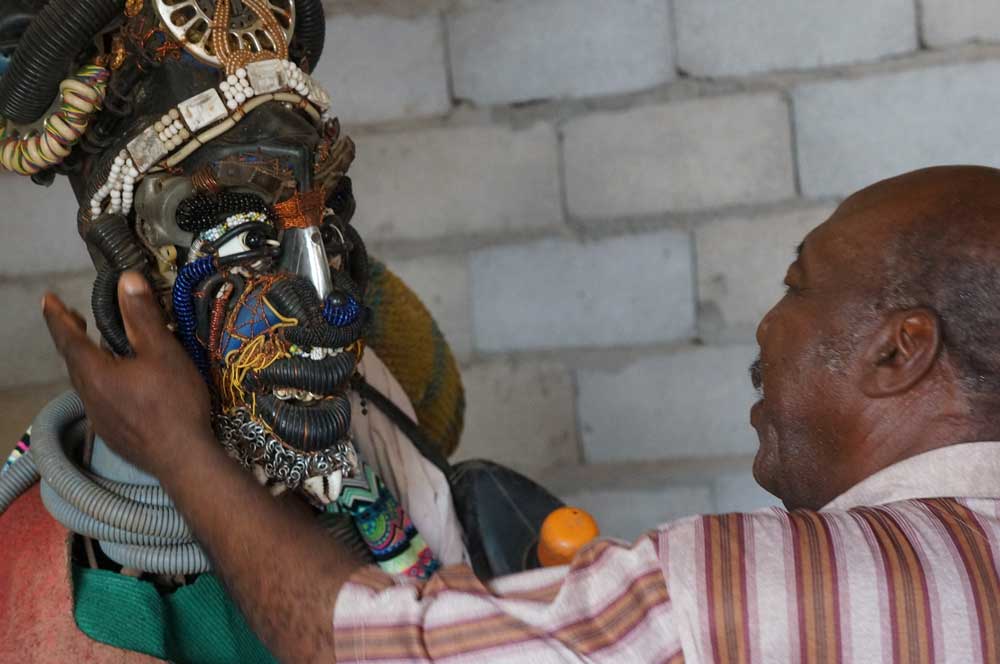
The artist working in his studio 2019 (Photo Ernst Wagner)
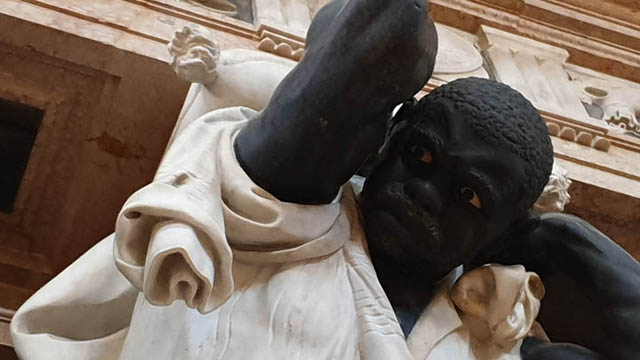
-
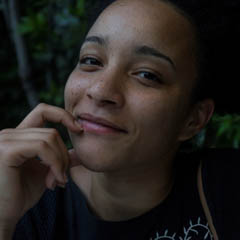 Leonie Chima Emeka
Leonie Chima EmekaFour figures of captured Africans in black and white marble support a massive triumphal arch on their shoulders. On white marble cushions rests the heavy construction with a sculpture of the doge Giovanni Pesaro in its center. flanked by four virtues — Fides, Fortitudo, Caritas and Justitia — the effigy states justice, faith and militant power as the virtues of the Venetian Republic under the reign of Giovanni Pesaro.1 With striking vividness the tomb seems to propagate the subjection of the black body in favour of the Venetian civilisation.
The literally black skin of the slaves, their round faces, full lips and swallowing round eyes encourage the assumption that what we see here is a typed representation of the so called ‘Sub-Saharan African’. Our perception today is materially influenced by the knowledge of images of Blackamoors in American and European popular culture, as well as the concrete exploitation of the black body during colonialism and slavery. The experience of Venetians in the 17th century, however, was considerably different to our postcolonial and post-slavery perception today. What nowadays generates emotions of horror and contempt, was meant to advertise a short reign that lasted merely one year from 1658 until the doge's death in 1659.2 The tomb was built in 1669, ten years after Giovanni Pesaro’s demise, according to the design of the famous Venetian architect Baldessari Longhena (1598-1682).3
The figures of the black slaves are by most accounts ascribed to the German sculptor Melchior Barthel (1625-1672) and relate, not to Africans captured in the transatlantic slave trade, but to the people enslaved in the war against the Ottoman Empire in defence to the island of Candia (today Crete) which was partly lead under Pesaro’s command.4 The weapons and armour which adorn the entablature suggest that the tomb in the shape of a triumphant arch refers to a victorious war. The iconography of victory, however, is a vast exaggeration of the truth, as Pesaro had not been considered successful in his defence of Candia and “ironically the island fell in the hands [… of the Ottoman; note from the author] in 1669, as the monument was completed”.5 Other than the slave’s de-humanising features might suggest the monument does not legitimise systematic exploitation of the black body equally to blackamoor iconography. Although the transatlantic slave trade had already started when the Pesaro tomb was completed, many more Europeans suffered enslavement in North Africa than has previously been commonly acknowledged.6 Venetian enslavement was such a common experience, that “both Ottomans and Venetians counted their imperial rivalry partially in terms of slaves taken and returned”.7
In 1669 Great Britain, which later became the most investigated in the transatlantic slave trade, lost more people to Ottoman enslavement than the other way around. The military strength of the Ottoman Empire rather suggests that the compositional subjection of the black marble slaves are meant to refer, or even constitute, a military strength that was strongly challenged in Pesaro’s lifetime. Unlike the blackamoor iconography, the grave is not to be understood as a visual manifestation of the transatlantic slave trade and colonialism, but postulates a militaristic superiority that was in fact strongly challenged.
Although the black marble slaves in Venice precede blackamoor imagery and its historical context, one cannot disconnect our perception from the traumatic history that would follow. It is hard to overlook the de-humanising effect of the eternally oppressed African sculptures and not to remember the disturbing past of systematic enslavement and its visual representation in de-humanising blackamoor imagery. Even if compared to another massive monumental sculpture featuring Africans as captives the black marble slaves remain singular in their artistic strategy of de-humanisation of the black body.
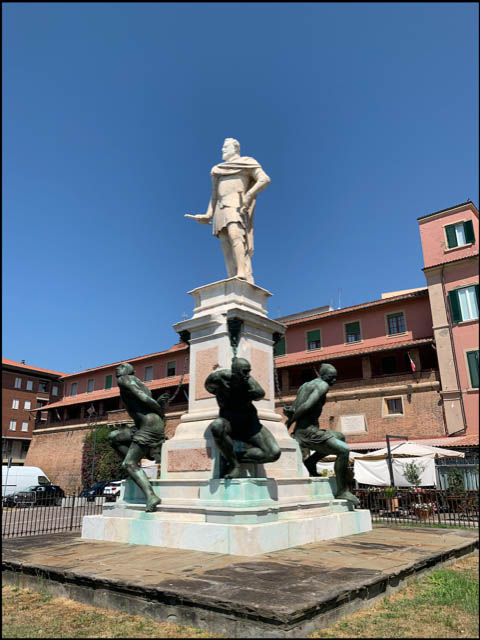
© Leonie Chima Emeka
Giovanni Bandini, Grand Duke Ferdinando I de' Medici 1597-99,
marble, and Pietro Tacca, I quattro Mori, 1621-26, bronze, height 33 ft. 3 in. (10.14 m)
© Leonie Chima Emeka
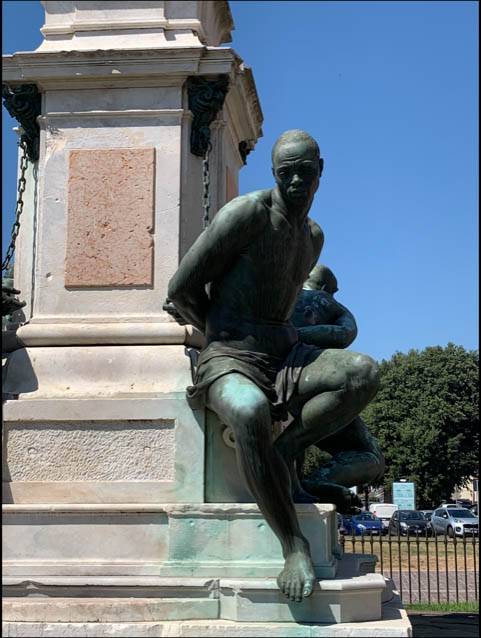
© Leonie Chima Emeka
Pietro Tacca, I quattro Mori, 1621-1626, Piazza Micheli, Livorno
The Monument to Grand Duke Ferdinando I de' Medici in Livorno, Tuscany, is considered the first public monument in early modern Italy to depict enslavement of the black body as a violent act and might have served as a model for the black marble slaves in Venice.8 The four bronze figures were manufactured in 1626, only 33 years before the Venetian sculptures, by Pietro Tacca. The four Livorno slaves are in fact a later addition to the monument of the likeness of Ferdinando I. Grand Duke of Tuscany.9 Tied to the pedestal they are meant to be understood under the control of Ferdinand I. It is the slaves’ strength and the explicitly forced subjection of these muscular bodies that indicate the elegant but lean Ferdinando I as a strong, assertive and powerful figure.
The four attributes of power completed in Pesaro’s youth, might have offered an alluring imagery for the later Doge, who had been highly criticised and actually taken to court for his military actions in defence of the Isle of Crete.10 Also the Venetian slaves represent physical strength as they support the massive tomb on their shoulders. The round eyes and big lips in the grimacing round faces which are contorted to an almost animal expression, however, mark the Pesaro slaves as hideous beings. The Venetian Slaves surpass their models in Livorno transcending the degree of de-humanisation to evoke the impression of the African slave as inferior. The slaves in Livorno, who wear a challenging or defeated expression, invite sympathetic emotions while the Venetian figures are deformed to almost caricatures. The status of dominance and subjugation is already apparent in the Venetian figures themselves. Not the presence of the chains, nor their mere position marks them as victims of subjection. It is rather indicated that the subjection is already incorporated in their hilarious features. In presence of the Pesaro slaves one cannot help but feel the uncomfortable impression, that it is the slaves themselves, their explicitly depicted inferiority, which legitimises their enslavement. Barthel’s artistic strategy of de-humanisation marks a shift in the representation of the black body in European imagery. If racism is defined as the naturalisation of the inferiority of the black body it concludes: the Monumento al Doge Giovanni Pesaro is a racist monument before systematic racism.
Footnotes
1 Identification of virtues: da Mosto, p.250.
2 Da Mosto, p.253f.
3 Da Mosto, p.251. Longhena’s plan can be found in the Zentralinstitute für Kunstgeschichte in Munich.
4 Ascription and life dates: Kaplan, p.186. Residency in Venice and Ascription: De Mosto, p.251.
Ascription to Ottomans and War of Candia: Da Mosto, p.238, p.249, p.253. Kaplan, p.186.
5 Kaplan, p.186. Although Kaplan and De Mosto name “Turks”, I chose the term Ottoman according to Lowe’s statement, that the term ‘Turks’ was often used to describe the whole Ottoman Empire. Da Mosto, p.253.
6 Davis, p.87ff.
7 Rothman, p.429
8 Rosen, p.38.
9 Construction of pedestal and sculpture: 1597 and 1599 by Giovanni Bandini ibid., p.38.
10 Da Mosto, p.254.
published July 2020
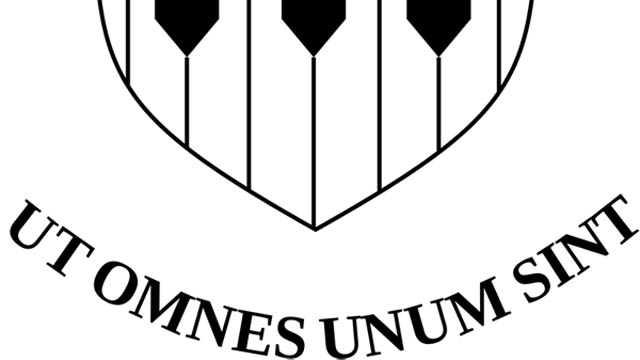
-
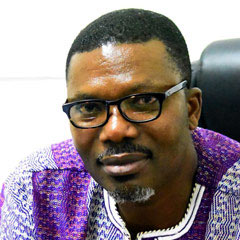 Patrique deGraft-Yankson
Patrique deGraft-YanksonSchool crests, school logos or school emblems as they are variously referred to are a popular feature in the functions of all academic institutions in Ghana. They are normally designed to visually reflect the key ideologies and philosophies upon which educational institutions thrive. In determining a logo for academic institutions therefore, efforts are put in place to ensure that they serve an appreciable level of visual representativeness. By this, school logos in so many ways establish emotional connections with parents, students and other stakeholders, whose interpretations and perceptions determine their level of confidence and trust in the institutions.
This logo, by its very visual appeal, informed by the familiarity of the key compositional element and simplicity, generates a point for discussion. Moreover, the popularity and the history of Achimota College always makes it an important destination for various studies pertaining to senior high school education in Ghana. In my current interest in the study of icons and symbols therefore, the Achimota School crest comes handy, worthy and accessible.
The designer of the Achimota School crest is not really known as most of the literature on the school's history is silent on the subject. However, judging from the fact that the key concept behind the logo emanated from a popular quote from Dr Emmanuel Kwegyir Aggrey, the Old Achimota Association attributes both its origin and design to him (OAA, 1973). The creation of the Achimota School crest follows strictly the conventional crest design procedures which inform the design of several school crests in Ghana. It is composed of a classic narrow base shield, with the all-important motto of the school, ut omnes unum sint (Latin phrase meaning ‘that all may be one’), rendered in an arc form below the shield to provide a mantling and support of a sort to the design. In a rather minimalistic fashion, the key element of the design which also represents the main ideal of the school (the piano keyboard) has been rendered in amazing level of simplicity which makes it easy to perceive and reproduce by all graphic reproduction methods.
By this design process, the Achimota school logo offers a depth of meaning without being too literal in its composing elements. It has a pleasing contrast between dark and light, and connection to the existing school structures. Most importantly, the logo has sustained the semiotics and narratology which students, parent and stakeholders have always responded to since the establishment of the school.
It can be said that the logo of the Achimota college is more than a visual representation of the ideals of an educational institution. By mere consideration of the diversity in the caliber of people who masterminded its foundation, the school’s logo could indeed be described as the very foundation upon which the school was built. The logo seems to echo silently a belief that underscores the essence of peaceful coexistence of all manner of people, as exemplified in the collaboration of people of different colours from different parts of the world coming together to establish an institution of that caliber. It must be noted that the use of black and white keys of the piano to signify the harmony that comes along with peaceful co-existence of people of all races mean a lot more than anti-racial advocacy. It is obvious that Aggrey, drawing from his own experiences as a black young man who has been able to successfully attain the feats that could be equaled to what any white young man of his age could attain, was drawing the attention of the African youth to their own strength and capabilities. This is because Aggrey lived in a time when the “black man” looked up to the “white man” as an embodiment of all wisdom and custodian of all the goodies that mankind needed for their existence. The idea that he, as a black young man could attain a higher education just as the white man had not been very much considered. Aggrey making himself a case for the possibility of the black race mixing up perfectly with the white race to produce something good therefore seemed to be the underlining principle for the creation of the logo of the Achimota school.
The question of Aggrey creating this logo not for some cooperate body or a church is also an interesting factor to consider. As far back as 1924, Aggrey sought to established the efficacy of ‘education’ in the promulgation of ideals, principles and philosophies. This is deducible from the efforts he put in co-founding the Achimota College with Sir Frederick Gordon Guggisberg and Rev Alec Garden Fraser; opening up the college for both male and female; and ensuring that teachers were made up of blacks, whites, males, females. This indicates Dr Aggrey’s confidence in education as an important avenue for the promotion of peaceful co-existence and harmonious living. He believed strongly that quality education would contribute to balance and a peaceful society, and promote his conviction that ‘black keys of the piano give good sounds and the white keys give good sounds, but the combination of the two gives the best melody’. What a beautiful reason for all mankind to live as one!
Considering ongoing efforts towards the achievement of a coherent global community, as well as the premium laid on education as a single unit that can be used to achieve the sustainable development goals, it could be concluded that the relevance of the Achimota school logo is important today more than it has ever been. It therefore makes a whole world of sense to argue that the logo of the Achimota school could be considered as a strong icon for well-balanced education and a perfect advocate for education for sustainable development (ESD).
References
- Old Achimota Associstion (1973). Dr Aggrey. Retrieved August 3, 2020, from Retrieved 03 https://sites.google.com/site/oaa1973akoras/home/founders/dr-aggrey
- Wada, K. (2010). Achimota School. Retrieved August 3, 2020, from https://www.blackpast.org/global-african-history/achimota-college-achimota-school-1924/
published August 2020
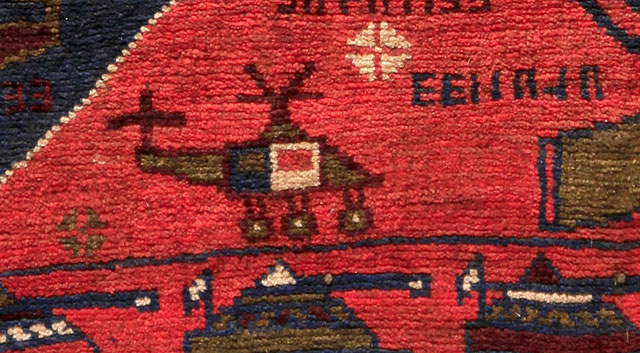
-
 Zoe Schoofs
Zoe SchoofsThe oriental carpet — in Europe it was once proof of the owner's long journeys or good trade relations, but in the regions of origin it was an everyday object used everywhere, often with a reference to paradise. With the invasion of Afghanistan by Soviet troops, the aesthetic concept changed — instead of lively gardens and elaborate arabesque patterns, suddenly there were tanks and weapons — so-called war rugs were created. Not only, but also for European viewers, whose idea of carpets is decisively influenced by classical Persian appearances, these new conventions of representation represent a break with the familiar. Soldiers, diplomats and war correspondents brought such pieces with them from their stays in Afghanistan and made them known in Europe and the USA. Enthusiasts and museum staff were quickly found to create collections of these objects, including the collectors Hans Werner Mohm, Till Passow and Enrico Mascelloni, as well as the Museum für Völkerkunde in Freiburg and Die Neue Sammlung – The Design Museum in Munich.
Carpets from the Orient were already popular at European courts in the 13th century, as they referred to the good trade relations with the Near and Middle East and served as prestigious items of the interior. Carpets were imported, but were also knotted directly in European court manufactories. With the enthusiasm for the Orient that emerged in the middle of the 19th century, the perception of carpets, whose origin had been relatively irrelevant until then, changed to a meticulous, scientific analysis, especially with regard to origin and iconography. World exhibitions and museums made them accessible to an ever wider public. While up to then carpets from courtly and urban manufactories had been the object of desire, over time those with a nomadic context became the centre of interest (Jansen 2001: 138). While this interest had already subsided on the part of the ruling dynasties in the 17th century, carpets for decorative use were produced for the bourgeoisie in the course of the industrial revolution. In 1861 William Morris founded his company Morris & Co. in Great Britain. "Over time, the carpet became part of an aesthetic 'spatial concept'. The technique and decorative motifs were first adopted from the Orient, but then adapted to Western tastes.“ (Bristot 2011: 32) They embodied "[...] the romantic ideal of the free and combative nomad in boundless expanse [...] the Turkmen carpet could be regarded as a sign of this independence sought among men.“ (Jansen 2001: 64) Thus the carpets found their way into male smoking rooms and libraries, also as blankets, cushions and seat covers when cut into pieces. The relocation of the production to factories brought with it simplifications of the motifs and thus further changes. The luxury good was now accessible to a broad section of the population and was thus the object of everyday use.
Carpets from these contexts, unlike woven textiles, are often knotted. They can be found in many different cultures all over the world. Basically, a distinction is made between courtly and urban works and works of the rural and nomadic environment, although there are of course blurred lines. While in the case of courtly and urban carpets all work processes were carried out by the respective specialists (spinning, dyeing, designing, knotting, etc.), all work processes for the carpets from the rural-nomadic environment were in one hand. These objects were primarily produced for the company's own needs and in some cases for the small local market. Courtly and urban carpets, on the other hand, were mostly commissioned works, intended for export or as envoy gifts and made in manufactories. The respective environment had a decisive influence on the appearance of the knotting work. In contrast to rugs made in manufactories, those produced in private homes or a rural community where meant for the local market.
The objects that today are commonly known as classical oriental carpets mostly originated from the Persian Empire and are therefore also known as Persian carpets. At this point, however, it should be noted that a large number of ethnic groups which were united under Persian rule knotted those carpets and that therefore there a large number of different aesthetic concepts. Those from northwestern Persia are most likely to correspond to the European idea of a particularly valuable carpet. The basis for this was an enduring period of peace under Shah Ismael in the 16th and 17th centuries, which is why sufficient resources were available to create works with particularly elaborate motifs (Bristot 2011: 56). In addition to purely ornamental patterns, numerous representations of gardens were created; vases, flowers and trees of life often referred to paradise.
On one hand, various textiles are ubiquitous in many societies: in tents and yurts, carpets have been hung on walls and lain on the floor as thermal insulation since ancient times and hung at the entrance as a substitute for doors. On the other hand, carpets were made in a (semi-)nomadic context in memory of the deceased. These carpets were placed on walls and, in addition to their insulating function, also had the function of commemorating the ancestors. The prayer rug was of central importance for the performance of religious practices. Thus, textile products shape the visual perception of craftsmen and users, and on the other hand, everyday things also find their way into the art of knotting (Frembgen/Mohm 2000: 15).
When Soviet troops invaded Afghanistan on Christmas Eve 1979, war became part of everyday life for many people there; in the course of the years, a civil war broke out. “As early as 1981, the war took on genocidal dimensions. Young and old, men, women and children were affected by unspeakable atrocities.“ (Knauer 1994: 27) "The cultural policy of the [Prorussian] Afghan government was aimed at destroying the traditional ties of Afghan culture to the Islamic world and at adopting the Soviet ideology.“ (Knauer 1994: 28)
As a reaction to these developments, women began to process these impressions into carpet art. The aim was not only to report on specific events, but also to motivate resistance against these conditions and the political system. The resulting carpets originated from the nomadic rural environment. In contrast to large manufactories, in which the knotting and design process was usually carried out by different people, these experiences could be directly converted.
In Figure 1, three horned hexagons arranged one above the other in a light background dominate the main field, which is lined by a wide, sixfold border. In the inner field of the rhombuses representations of three to four prayer rugs, several stylised mosques and a centrally placed ZSU-23-4 tanks were arranged. Although the tank immediately catches the eye, the carpet looks very calm, there are no other war instruments depicted. This impression is reinforced by the many geometric borders and the structure of the main field, whose symmetrical arrangement is reinforced by the triangles placed on the sides. The similarities to Mushwani carpets from the west and Baluchi carpets from the south are striking (cf. MacDonald 2017: 77 / 78; Parsons 2016: 166/167). The carpet measures 160 x 88 cm and was probably knotted in Pakistan in the 1980s. Since the carpets were mostly in use before they came to the bazaar and to Europe through traders, only estimates can be made in this respect. Since it didn't take long for international buyers to become interested while there was also a market in Afghanistan and Pakistan, such carpets were soon produced in Pakistani refugee camps to generate income.
In Figure 2, a border of BTR-60 tanks frames the midfield, on which two identical representations are arranged one above the other: A hand underneath hammer and sickle is directly related to the map of Afghanistan. Below is the inscription جهاد (Dschihád). This motif of map, hand and writing can be found twice in the carpet. On the right side two AK-47 rifles were placed. On the left side there are two representations of trucks each with a ZPU-4 rifle (heavy multi-bore anti-aircraft machine gun) and also a Mi-24A combat helicopter with glazed bow. The field is filled with pseudo-cyrillic writing.
In addition to the motifs shown here, there are many other illustrations that can be found on such carpets. Some point out the changes in day-to-day business by depicting weapons, others illustrate specific attacks on cities. But what was the purpose of those carpets whose motifs depict violent everyday scenes? In this respect, too, only speculations can be made. Scientists around the world hold different views on this question. What is certain however, is that the aesthetic change from classical ornamentation to specific depictions was also accompanied by a change in function.
Surely the desire to process the experience played an important role. According to Jürgen Frembgen, it can be ruled out however, that carpets depicting objects of war have found their way into the family space. Instead, he assumes that the carpets were used in the men's house, hujra, or in the reception room of a house reserved for male visitors, otaq — rooms in which conversations and discussions took place. "The use of space and spatial presence are [...] the expression of social interaction and include shared experience. Spaces thus become zones of identity building.“ (Issa 2009: 83) In such a place they could also serve as a call for resistance. The aesthetics of Object 2 resemble anti-Soviet leaflets that circulated in large numbers, often showing the head of state Babrak Karmal, appointed by the Russians, represented as an (Afghan) puppet whose strings were pulled by the Russian hand. In Carpet 2, only the hand and the Soviet symbol were taken from this illustration. A carpet that makes war the subject of discussion could stimulate conversation and strengthen the idea of community. In addition, the homeowner positions himself on the side of the mujahideen. Pursuing the same purpose, they have been presented "in the houses and tents of some mujahidin commanders (sic!) and wealthy people — as ornaments and probably also out of pride about victories won.“ (Frembgen/Mohm 2000: 46) Accordingly, the objects would have been bought and used as "art within resistance" (Frembgen/Mohm 2000: 46). With the resignation and presumably also a further deteriorating economic situation, the objects later came back onto the market and were then purchased by international buyers.
At first glance, it may seem surprising to be processing everyday life in a carpet. Since particularly Persian pieces are often seen as an investment, timeless patterns or representations of traditional legends are more common. These representations of realities of life therefore mark an aesthetic idea of Modernism in which "the textile is already understood as a pictorial surface in the sense of narrative, sometimes even realistic iconography.“ (Baumhauer 2016: 156)
Since their creation carpets with war motifs have served various purposes: to contribute to financial survival, to express political messages, to represent a medium of processing war. At a time when issues concerning refugee policy in Germany make up a large part of the political debate and there is disagreement about how to deal with migration of all kinds, the carpets have not lost any of their actuality. They are contemporary witnesses of the beginnings of a war that is hardly remembered today. Globalized relationships have made it possible for them to be known to experts around the world. Using various narrative concepts, the carpets with their „pictures against oblivion“ are meant to serve as a reminder of the conditions in the country for the following generation" (Frembgen/Mohm 2000: 45) – thus another purpose can be added, not only in Afghanistan, but all over the world. Although they were not explicitly created for this specific purpose, they could gain it through their display in museum spaces.
References
- Baumhauer, Till Ansgar: Kunst und Krieg in Langzeitkonflikten. Visuelle Kulturen im Dreißigjährigen Krieg und im heutigen Afghanistan, Berlin 2016.
- Bristot, Monique Di Prima: Bildlexikon Teppiche, Berlin 2011.
- Frembgen, Jürgen Wasim / Mohm, Hans Werner: Lebensbaum und Kalaschnikow: Krieg und Frieden im Spiegel afghanischer Bildteppiche, Blieskastel 2000.
- Issa, Christine: Baukultur als Symbol nationaler Identität: Das Beispiel Kabul, Afghanistan, Dissertation zur Erlangung des akademischen Grades Dr. rer.nat im Fachbereich Geographie, Gießen 2009, https://geb.uni-giessen.de/geb/volltexte/2010/7483/pdf/IssaChristine_2009_12_08.pdf [15.12.2018], S. 83.
- Jansen, Simone: Von der Jurte ins Herrenzimmer. Reisen von orientalischen und zentralasiatischen Teppichen, in: Dietrich, Andrea / Herbstreuth, Peter / Mannstein, David (Hrsg.): Orientale 1. Recherchen, Expeditionen, Handlungsreisen (Kat. Ausst. ACC Galerie, Weimar 2001), Weimar 2001, S. 58–71.
- Knauer, Karin: Afghanistan. Krieg und Alltag (Kat. Ausst. Museum für Völkerkunde, Freiburg 1994), Waldkirch 1994.
- MacDonald, Brian: Tribal Rugs. Treasures of the Black Tent, Woodbridge 2017.
- Mascelloni Enrico: War Icons, in: Mascelloni, Enrico / Sawkins, Annemarie (Hrsg.): Afghan War Rugs. The Modern Art of Central Asia (Kat. Ausst. Memorial Art Gallery, University of Rochester 2016), https://mag.rochester.edu/exhibitions/afghan-war-rugs/ [19.11.2018], S. 15–20.
- Parsons, Richard: The Carpets of Afghanistan, Woodbridge 2016.
- Passow, Till / Wild, Thomas: Geknüpftes Gedächtnis. Krieg in afghanischer Teppichkunst (Kat. Ausst. WILD Teppich- und Textilkunst, Berlin 2015), Berlin 2015.
- Schlammiger, Karl / Wilson, Peter L.: Persische Bildteppiche. Geknüpfte Mythen, München 1980.
published February 2020
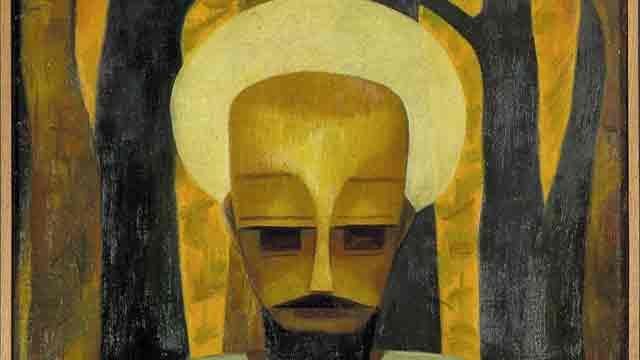
-
 Osuanyi Quaicoo Essel
Osuanyi Quaicoo EsselThe seated human-like figure is centrally placed with the head occupying almost the centre of the entire composition while the hands rest gently on the laps. The head and the face of the human figure is rendered in planes and cubistic orientation, a style reminiscent in precolonial African wooden sculptures. Hands of the figure received similar cubistic treatment with less details as in realistic depiction. Interestingly, there is a deliberate subtle emphasis on the head size of the figure. In African sculptural renditions, the human head is considered as seat of wisdom and, therefore, presented bigger to defile the realistic canonic proportions and connote its Afrocentric symbolic essence. This concept of head re(presentation) is termed as African proportions (Amenuke et al, 1991).
To create a harmonious contrast of colour and shape, tints of yellow forms an arc-shaped design around the head. This treatment possibly suggests a halo effect characteristic of saintly figural paintings in Western art traditions. It also mimics a turbaned human figure. As an artist who hailed from a predominately Muslim community, this stylistic treatment, perhaps, pays tribute to his religious cultural background. The eyes are presented with dark brown rectangular dabs, with the forehead gently highlighted with bright yellows, a treatment that puts the human figure in a meditative mood and sanctimonious character. Though Uche Okeke presented the work in a portrait orientation, the skilful placement of the human figure, and the peculiar colouration of the head regions creates a triangular effect when imaginary diagonal lines are projected from the bottom corners of the composition to the halo-shaped found on the head. Similarly, the haloed effect on the head and the elongated pharaonic beard creates an imaginary inverted triangle resonating a visual excitement.
Symbolically, yellow depicts riches and royalty in African colour scheme. With this schematic colouration, Okeke gave a clue to the kingly characteristics of the human figure. The white looking garment of the figure also adds to the sanctimonious conjecture of the figure as in African colour symbolism. The artist’s use of luminous chromatic reflection of the tint of yellow and dark shades helped in achieving the sense of depth in the garment. Complementing the overall kingly posture of the human figure is its elongated pharaonic beard and bodily language as found in sculptures of ancient Egyptian kings.
Okeke skilfully deceived viewers of this composition into believing that it is symmetrical per its stylistic tendency, yet an intense observation reveals a psychedelic mutation of the placement of the fingers, padding of the background with tree-shaped figures in rich application of tints and shades of black, yellow and brown to create contrast of colours and shapes. Placement of the trees in colour variations and the sprouting of the branches forms a psychedelic cross and contribute to breaking monotony. The patchy effects of the intense yellow forming the negative spaces adds to creating a perceptual believability that the human figure wears a contemplative mood per the facial looks. There seem to be gentle highlights of the yellow from the shoulders to the halo-shaped object.
Per the compositional portrayal, Okeke showed a kingly and majestic posture of, perhaps, the Christian religious icon in Africanised bodily posture and cultural praxis. This compositional contextualisation feeds into his personal manifesto that he did not subscribe to borrowing Western artistic accent hook, line and sinker. Neither was he comfortable with resorting his Nigerian indigenous artistic traditions without modification. He emphasised in his manifesto that it is ‘… futile copying our old art heritages, for they stand for our old order. Culture lives by change. Today's social problems are different from yesterday's, and we shall be doing grave disservice to Africa and mankind by living in our fathers' achievements’ (Okeke, n.d). For that reason, he appropriated western artistic accents and fused them with Afrocentric artistic concepts and perspectives to achieve a hybrid artistic language which is not purely African nor Western, but yet circumvent the boundaries of artistic cultural traditions in general. The fusion lends itself to exploring the familiar and the unfamiliar to create a renewed breed of art. He called this effect ‘natural synthesis’. Emanating from Nigerian non-conformist artist group named Zaria Rebels, Okeke sought to reinterpret the Western artistic style of realistic depiction, perspectival detailing, accurate proportions and tonal gradation he was exposed to by the Eurocentric-inspired faculty in the so-called formal education setup in art in Ahmadu Bello University, Zaria. As part of the pioneering post-independence artists in Nigeria, Uche Okeke was experimenting for a renewed artistic accent for his creations through the assessment of his Nigerian cultural values and the new artistic training he had been exposed to in order to arrive at the boundary of these two traditions.
Using this painting in teaching and learning in the context of collective memory could inspire relevant competencies in the learners. Gathering inspiration from the artistic pursuit of Okeke, learners could fuse multiple artistic traditions of the artworld to arrive at their individualised artistic accents. Teachers could engage learners in this manner by asking them to borrow and appropriate a foreign artistic style and fuse it with their nationalistic art making techniques to develop a new breed of art or concept. Teachers could also discuss with learners about the fact that gathering artistic inspiration is multicultural with no boundaries. Furnishing learners with links to the biographical account of the artist for them to understand his cultural nuances remains key in the process. It would also be beneficial to guide learners to explore with their own interpretation of the artwork (figure 1). Teachers could also provide learners with printed copy of the painting and ask them to redraw this religious-centred figure to suit their own religious understanding and cultures. This approach addresses the competencies of critical thinking and problem solving; creativity and innovation; cultural identity and global citizenship; and personal development.
References- Amenuke, S. K., Dogbe, B. K., Asare, S. K., Ayiku, F. D. & Bafoe, A. General knowledge in Art for
- senior secondary schools. Evans Brothers Limited.
- Okeke, U. (n.d.). Natural synthesis. final okeke natural synthesis manifesto 1960.doc (live.com)
 Mahmoud Malik Saako
Mahmoud Malik SaakoThe image is presented in a form of a male figure in a seated position with long beard, white turban, white robe, long sleeves and a probably waist band. The painting represents fairly the complexion of a male, black bearded and wearing a face mask, with hands resting on the laps possibly in a meditation mood. The Background is probably a wooded environment or garden with tall trees of two colours (black and yellow). The figure seated probably on a staircase or an amphitheater. The sun ray penetrating through the tree created shaded patches reflected on the image.
An Islamic perspective: I base my interpretation of the painting on Islamic perspective as one of the foreign region that had an early contact in northern Nigeria as early as 15th century long before Christianity and eventual colonization of Nigeria by European power (the British) and its possible independence in the 1960. The emir is mostly male usually dressed with a white robe, long sleeves and a white turban tied around his head to signify his authority. The painting perhaps represents an Emir of the Zaria state at that time sitting in a garden relaxing.
Using an African mask: The use of an African mask to represent the figure was done deliberately or perhaps to avoid revolution from the Muslim community of disrespecting their leader which the author was much familiar in this volatile society especially, the intolerance nature between Muslims and Christians at this era in the Zaria state. The mask as a tradition signature that ubiquitous across many cultures that can be used to represent the religious discourses by appropriating and manipulating them to produce art forms of the past to produce a mythology for the present.
Lessons
- The image portrays the power of the emir in the Zaria state with a possibly palace and vineyard or gardens where he retires to relax. The seat or staircase/amphitheatre is constructed within the park for relaxation.
- It also shows the importance of trees because the natural air and shade provided. It reflects the symbiotic relationship between man and the natural environment or biosphere.
- The long beard is a reflection of the age of the figure, combined with the white turban tied around the head which is a symbol of power and authority of the emir within the context of an Islamic state. Again, the white long robe coupled with black beard and the white turban is a reflection of the dress code of the emir within the states dominated by Muslims. The waist band (blue sea colour) is used to tie the robe for easy movement.
- The facial representation of the figure doesn’t conform with normal human head based on the eyes, nose and mouth. It is probably a mask of an Egyptian pharaoh to imbibe the spirit of the Pharaoh as a kingly figure that wielded much power. A story that is synonymous in both Islam and Christian doctrines except the West Africa Indigenous Religions that do ascribe this myth. The use of the mask also simmer the tension of using identifiable imagery that would have rise tension in this probably consecutive Muslim state. The use of masks within the Africa context show the spiritual powers embedded in them that the wearer or user is mostly possessed and transfigured a situation that can only be explained by adherences to that particular belief system.
- The black and yellow tall trees depict the diverse nature of the ecosystem and the symbiotic relationship mostly exhibited in the environment. This shows the complex nature of the human society with diverse cultural and different colours complexion that need a person with wisdom and patience to rule, like the emir who assumes the position of an Egyptian Pharaoh.
- Uche Okeke, was a revolutionary artist who tried to break away from normal art presentation handed to Africa by the white colonial powers. This diversion was to Africanize the art industry in West Africa and Africa at large. This where Okeke decided to use the Pharaoh mask from Egypt that was considered even among Europeans of the cradle of human civilization in the world.
 Ernst Wagner
Ernst WagnerI argue in the following text from a special position. Firstly, I was present in Bayreuth on 26.4.2022 when the two co-authors, Osuanyi Quaicoo Essel and Mahmoud Malik Saako, discussed the painting in a larger circle. The representatives of the Iwalewa House clearly expressed their doubts about the (traditional) title of the painting "Christ".[1] Perhaps this brought the question of who was depicted in the painting, Christ or another person, to the fore. This question also shapes my discussion of the painting presented here. It became the guiding theme behind which other topics disappeared, such as the question of the painting's function (what was it created for?), its biography (how did it come to Bayreuth?) the role of oil painting (is it a European import), the context of the debates on modern art during the independence movements in Africa (does the painting belong to a global modernism after the Second World War or does it mark a Nigerian path? [2]) - to name just a few.
My own interpretation is therefore less an independent approach to the work than a response to the positions presented with the intention of building bridges between the approaches by introducing a meta-level. Whether this is convincing, whether the bridge is sustainable, is for the reader to decide. But more on that below.
Traps through aesthetic stereotypes that lead to false classifications / interpretations
And a second preliminary remark: I didn't like this picture at the beginning. It reminded me too much of the religious pictures of the 1950/60s of my childhood. They were popular for death pictures back then: A mixture of a bit of Pre-Raphaelite and icon-inspired imagery, soaked in the formal world of a moderate and esoterically inclined modernism (Franz Marc). The intention was easy to see through: To somehow keep alive that which, in my view, was no longer contemporary at all, and to do so through a bland, unconvincing and even less convincing adaptation (a kind of "modern facing"). This is also why, when I saw the picture hanging at the entrance to the Iwalewa House from the corner of my eye, I immediately saw a Christ.
Iconography - inclusion of other perspectives

Detail
In the discussion mentioned at the beginning, the intervention of Mahmoud Malik Saako was really surprising for me - against the background of this perception, which was shaped by my own stereotypes. The halo (which I saw - see detail) was a turban (which Malik saw). But I could not counter his view. There was no argument for the interpretation as a halo. This is also true now when I read Malik's text (like Osuanyi's). So I first had to recognise my stereotype in perception, which had lured me onto a perhaps (?) wrong track, I had to get rid of this, unlearn something, in order to be able to open up to the other perspective.
Why I - retrospectively - still speak of "perhaps wrong", a research on Okeke's work has confirmed as meaningful. After all, there are obviously works in his oeuvre that iconographically quite certainly represent Christ or St Mary, as an internet search reveals (see fig. below). The auction house Bonhams (Abb.1) states - even if for 1963, two years after our work: "in 1963 ... the Passion of Christ was a recurring theme for the artist. He had produced the stained-glass designs of the Fourteen Stations of the Cross in Munich earlier in the year." (www.bonhams.com/auctions/25800/lot/28 accessed 14 Sept 2024)
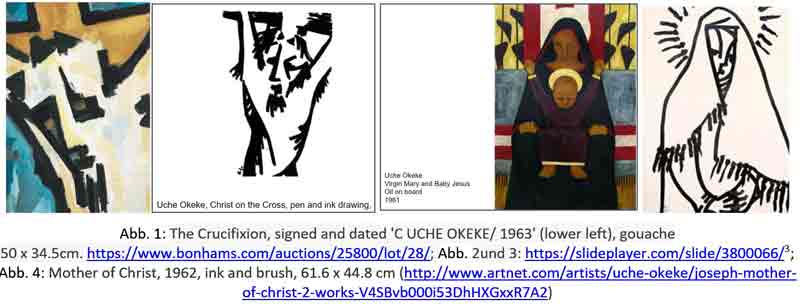
Christian motifs in Uche Okeke's Ouevre between 1962 and 1963 found by the author on the internet (May 22, 2022)
Perhaps this is why the discussion about whether Christ or a Muslim is depicted makes me feel uneasy. In my mind, the question is connected with the attributions or depreciations: To whom / which faith does the work of art belong? Does it belong to the Christians, the Muslims, or the traditional believers in northern Nigeria, if, as Philipp Schramm or Mahmoud Malik Saako suggest, one also discovers a traditional wooden mask?
New approach and reflection on its anchoring
Hence my attempt to think of the painting in a different way, i.e. not from the artist's point of view and what he or she wanted to represent. In doing so, it is clear to me that I am taking a specifically Western approach to a modernist work (where I now place Okeke's painting) with my new approach. This approach is based on the loss of a binding iconography and a fundamental openness / never-quite-unambiguity of 'autonomous' works of art for a Western-oriented, middle-class audience. In addition, my proposal for interpretation is based on a specific position in the interpretation of images, from production theory to reception theory (in the context of constructivist epistemology). The loss of a binding iconography is accompanied by a greater significance of form (which is now itself charged with content to compensate for the loss). In a next step, I therefore try to examine the image - beyond a positioning in the question of whether it is an "Islamic" or a "Christian image" or a "traditional image" - form-analytically.
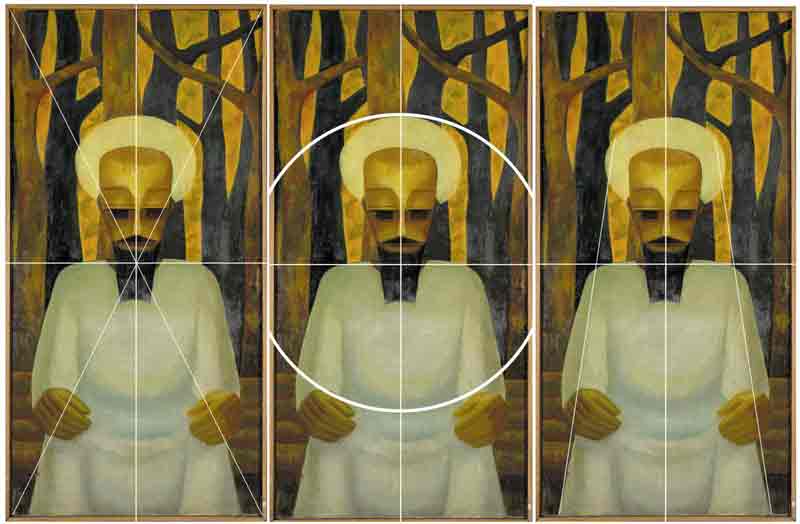
Analytical composition with auxiliary lines. (c) the author
Form analysis
The dominant, almost penetrating axial symmetry in a very high longitudinal format speaks of high order; the pyramidal structure of the figure also speaks of calm and stability, indeed of sublimity and dignity, of quiet, immovable power. And this dignity is not fed by external insignia or theatrical staging, but by a calm that radiates from within. It is a picture in front of which one can become calm if one trusts the order as a viewer.
The striking human figure contributes to this effect. Although clearly figurative, it does not represent - to the degree of abstraction - a concrete portrait or a human being that can be grasped by the senses. This is most obvious in the geometricised eye area, which is shaded in various dark zones. This makes the gaze ambiguous: is the figure looking at the viewer, is it looking forward, is it looking inwards (contemplatively, with closed eyes)? Together with the geometric rhythm of the picture's surface (the symmetry, but of course above all the parallels that can denote eyelid, tear sac, eyebrow - or not) support the depiction of a human being in an abstracted ideal form that remains open to itself, as in a mask. The latter is also characterised by the fact that the viewer immediately sees what has been made, what has been assembled, as in the case of the moustache, for example.
The figure sits quite classically in front of a middle and a background: at the bottom the zone (again - between two-dimensional and spatial effect - strongly abstracted) is divided into horizontal stripes, which become slightly narrower towards the top. They again suggest something familiar (a wooden bench), but this remains ambiguous. In the upper zones, the tree trunks (without leaves) form the liveliest, least symmetrical, most restless element in the painting, even if the alternation of light and dark again shows the abstracting hand of the artist.
With this spatial layering in clear zones (background, trees, seat, figure), but also the geometric reduction of the forms, the picture looks like a carved relief. The colouring also fits in with this, for example when the "sky" behind the trees as well as the lighter trees have the same colouring as the face, while the beard, eyes and the dark trees form a second colour zone. The lightest zones are formed by the robe and the shape around the head. Despite the large spectrum in the area of light-dark contrast, the picture does not appear colourful, rather like a natural wood relief. An effect that is again particularly evident in one detail: the way the hands are shaped is reminiscent of hands carved out of a piece of wood.
This character is supported by the way Okeke uses oil painting. He clearly outlines the contours of the surfaces. The objects are each assigned a main colour, applied impasto with broad brushstrokes. The modelling creates plasticity, lightly set with internal structures enliven the colour surfaces.
Conclusion
The degree of abstraction, the modelling construction of the figurative out of a colourfulness, the strict symmetry of the composition, the tectonics of the pictorial space unfold a tableau that nevertheless - and this is now decisive - creates zones of ambiguity in the figurative. The viewer must fill these with his or her own ideas. The viewer's gaze is directed towards the picture, but the eyes do not look back. In this respect, the painting is suitable for contemplation, meditation, spiritual experience. In seeing the painting, one's own can come to rest. And so the distinction between the Christian halo, the Muslim turban and the ritual mask can also come to rest in the contemplation of the painting.
This consideration is based on an 'ideal viewer' of the work, i.e. it is reception-aesthetically oriented. If one finally turns it once again to production aesthetics, one could interpret the work as an attempt by the artist in which it experimentally unfolds what a spirituality beyond the distinction traditional - Christian - Muslim could look like.
Footnotes
[1] Philipp Schramm's position becomes clear in his text (https://www.bayfink.uni-bayreuth.de/de/Sommerausstellung-2021_-Not-yet/audio-not-yet---welcome/index.html).
[2] Perrin Lathrop, "Uche Okeke," in Smarthistory, August 9, 2015, accessed May 21, 2022, https://smarthistory.org/uche-okeke/.
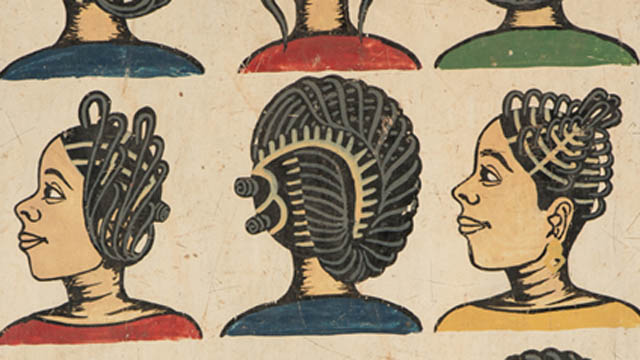
-
 Osuanyi Quaicoo Essel
Osuanyi Quaicoo EsselCatching a glimpse of the feminine hairstyles (re)presentation in rows on a single support, brings to memory the barber salon promotional campaign artworks that served as visual displays to invite potential customers in parts of Africa in the past. Artists in the community were commissioned to create picturesque signages that display plethora of Afrocentric hairstyles on wooden boards and placed in front of hair salons or vantage points to attract potential clients. The artworks served as form of advertisements to the salon operators. Some itinerant hairstylists moved around with these signages in search of customers. The painted images have been replaced with printed catalogue of pictured hairstyles printed on large sheet of papers and flexy materials which are displayed in and outside salons in the communities. The picturesque hairstyles signage presented in this exhibition reminisces the artistic practice of creating these portraits as form of hair salon advertisement in Togo, Ghana, Nigeria and other West African countries.
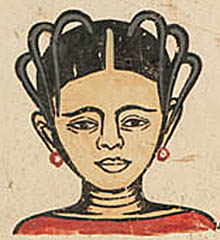
Cutout from anonymous artist, second half of the 20th century, plywood, oilpaint, Image: Osuanyi Quaicoo Essel.
Uniformly arranged on a support, the artist presents fifteen Afrocentric feminine flashy plaited coiffures in portrait orientation. Of the fifteen hairstyles, one occupies the epicentral position of the entire composition in frontality of pose, depicting her full facial details in simple flat tone of brownish colour with the hair stylization rendered in black. Her rigged neck, pronounced eyebrow and bejeweled ears depicts her feminine characteristics. In Togolese culture, wearing of earring is a preserve of females as in the case of Ghana and some West African countries. The artist’s treatment of this centrally placed figure gives hint of Togolese feminine beauty standards. Four of the hairstyles are shown in side view, facing the left. Similar to these four figures in profile are the type-form head, rigged neck details and varying earrings. The rigged neck features found on these four figures also appear on the centrally placed figure in the composition. With this treatment, the artist makes visual notation of feminine beauty culture standards that characterised some West African countries. Rigged neck feature is considered as a marker of beauty ideal, and commonly depicted in West African feminine sculptures. For example, Akuaba (wooden doll, predominantly used as fertility figure), of Ghana is often armoured with rigged neck characteristics. Understanding the beauty culture ideals of Africa depicted in this simple but interesting hairstyles composition offers viewers of African art a better understanding of the art.
To reveal a great deal of the level of sophistication of the hair stylizations, the artist showed ten of the figures in back view posture, three each atop and down in horizontal placement, while four are arranged in a kite-shaped arrangement in the middle portions of the painting. The artist generates visual interest with the arrangement of the figures to create a sense of movement, variety and rhythm. For example, in the depiction of the clothing of the figures, shades of reds were used in a serpentine orderliness that forces the eyes to traverse gracefully upon a gaze from the topmost middle part to the down and vice versa. Similar colour treatment is achieved with shades of blue from the top left, moving in diagonal direction to far right of the middle portion of the painting, and orchestrating another diagonal turn towards the down left part. One striking feature that bedews the ten hairstyles in back view posture, is the skillful use of the negative and positive spatial relations that creates visual curiosity for deeper gaze of the hairstyles. With the exception of the blue-shirted figure on the last row of the composition, the remaining blue-shirted figures wear trumpet-shaped hairstyles with multi-sectional visual interests.
All the hairstyles represented by the artist are a reflection of the Afrocentric standardized beauty ideologies and practices inherent in the social environment of practice. These hairstyles make use of no hair extensions and or wigs; and are also practised in Ghana and other neighbouring countries. Females usually cared for their hair to grow long and plait it with black twine to form long narrow stripes which are then arranged in a particular manner by way of styling. Based on the society that wear them, the hairstyles may be given names and have symbolic meanings. The hairstyles portrayed are usually worn by the youthful and middle-aged females.
Colonialists’ invasion, slavery, Western religion, racial discrimination, amongst others, contributed to Black hair stereotyping which has caused some Black women to resort to hair beauty ideals of the colonialists. Historically, the discrimination resulted in some Black women who found themselves in foreign lands, hiding their hair by using coverings, especially, in public places. Some Black women use artificial chemicals to straighten their hairs to imitate the beauty ideals of the colonialists. Despite the counter-resistance to the stereotyping of Afrocentric hairstyling through civil right movements and visual (re)presentation by its practitioners and artists, many African women now wear extensions and wigs, a trend that raises the question of identity crisis and politics. The work of the artist in this context sheds light on the purely Afrocentric hairstyling culture of Togo and its neighbouring countries, and makes unapologetic statement of turning away from the colonial past.
The work brings into focus the need for fashion art educator and artists to join hands in contributing to institutional restructuring of teaching and learning of African fashion history including standardised beauty ideologies and ideals for reclamation of the past, and impenitent practice of Afrocentric beauty culture. Towards this end, teaching and learning should be focalised on the African cultural reorientation, concept of sankofaism (return to fetch the goodies of the past) and respect for one another irrespective of geography, skin colour, hair type or physique. Learners must be taught to build positive self-esteem and love for their culture, and demonstrate love for individual differences.
This article is part of a gallery: Perspectives from Ghana on Museum Objects in Germany
published January 2021
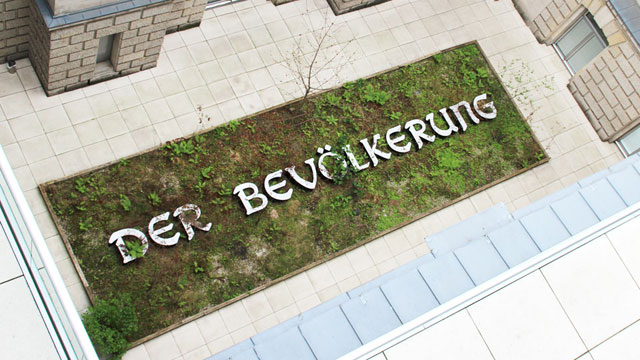
-
 Ernst Wagner
Ernst WagnerBased on the Ghanaian interpretation, it quickly became clear that certain ideological or political positions are immediately connotated with the respective image selection. These in turn are linked to historical and social experiences, which Winkler (2021) recently elaborated on the basis of the history of Germany. In our case, the West German, left-liberal intellectual milieu is of particular interest, since all the German project partners involved in the discussion can probably be assigned to such a milieu. "In the 1970s, the view prevailed among liberal and left-wing intellectuals in former West German, which objectively was not a nation state, did well to see itself as a >post-national democracy<. In the 1980s, this led to the conviction among many that the time of the nation state had passed and that Europe only had a future as a post-national union. [...] The self-destruction of one's own nation-state [in Nazi Germany - author's note] led to the conclusion that the nation-state as such had outlived its usefulness, and the term ‘national’ was equated with nationalist. [...] In Germany the idea that the nations had to merge into a European republic found a broader public echo." (Winkler 2020 p.186)
For art educators, the majority of whom probably feel committed to this idea of Germany as a post-national democracy, the question of a current symbolisation of national unity[1] is therefore obsolete. It cannot therefore be relevant to art education. A consensus in the German team on how at least the general topic could be addressed could be reached by the proposal to deal with the topic on another level, and to use Hans Haacke's installation "Der Bevölkerung" (2000, courtyard of the German parliament in Berlin) to deal with the topic of "national unity" in a contemporary art lesson.
Hans Haacke (*1936) is a German-American artist who has lived and worked in New York since 1965 and whose conceptually influenced works primarily address art-political processes.
Figure 2: View into the courtyard of the Reichstag building. © Hans Haacke / VG Bild-Kunst.Haacke's installation "Der Bevölkerung" is located in a courtyard of the Reichstag building. This architectural context is part of the work. The building was constructed at the end of the 19th century, during the Second German Empire (1871-1918). In neo-baroque style, it paid homage to the national pomp under emperor Wilhelm II. Damaged by fire in 1933, it was further damaged during the Second World War. Located directly on the Wall to East Berlin, the dome was finally blown up in 1954. In reunified Germany, however, a new function was found for the building. Rebuilt according to plans by Norman Foster in the 1990s, it now serves the German parliament, the Bundestag.
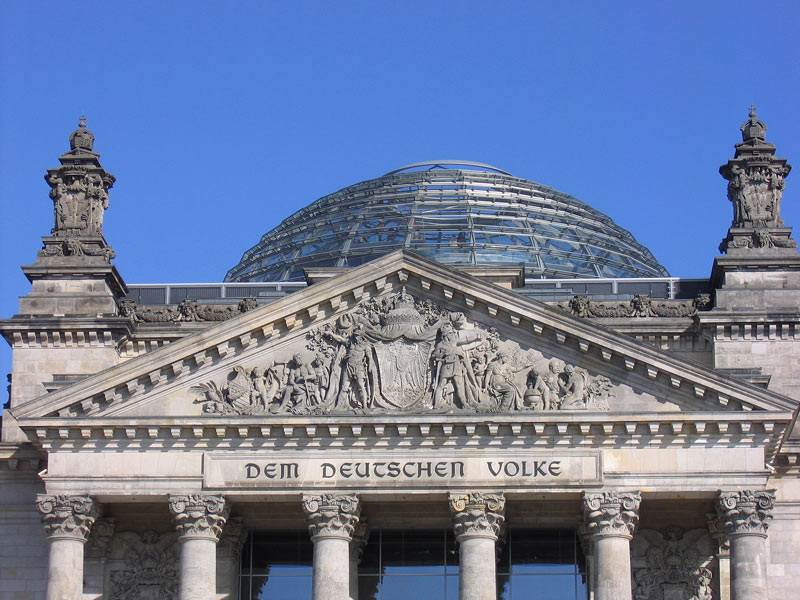
Figure 3: View of the façade of the Reichstag building with the inscription "Dem Deutschen Volke" © Hans Haacke / VG Bild-Kunst.
Hans Haacke built a 21 x 7 metre rectangular, flat wooden enclosure in this building. He then asked the MPs to gradually fill it with soil from their respective home regions. In the middle of the box, the inscription "Der Bevölkerung" (To the People / Population) can be read, in white letters illuminated from the inside. The typeface corresponds to the inscription "Dem Deutschen Volke" (To the German People / Nation), which has been on the outside of the building's west portal since 1916.[2] According to the initiator, the invitation to bring soil from the constituencies is valid as long as members are democratically elected to the German parliament. A webcam, belonging to the installation (www.bundestag.de), takes a picture every day at 2 p.m. and 8 p.m. and thus allows a take a look at the development of the project since 2000 and at the current situation.
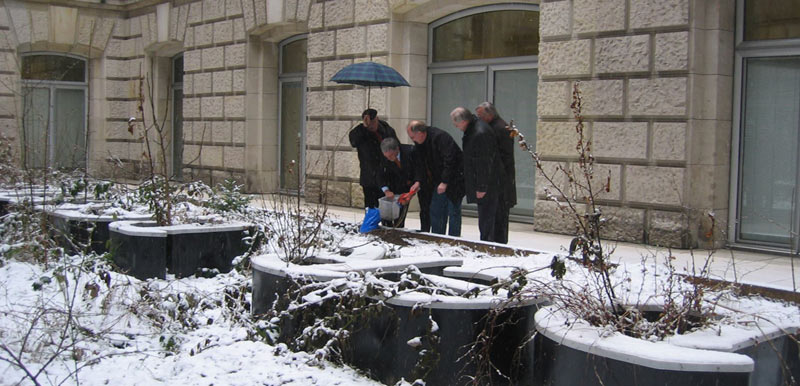
Figure 4: An MP distributes the home soil from his constituency in Haacke's installation. © Hans Haacke / VG Bild-Kunst
When Haacke proposed to install this large-scale installation in the new parliament in 1999, ten years after German reunification, it triggered a heated public discussion. Many MPs found the words "Der Bevölkerung" (To the People / Population), which appeared to be a dedication, inappropriate and provocative. Haacke was deliberately alluding to the older inscription "Dem deutschen Volke" (To the German People / Nation) on the outer façade. In contrast to this, he used the term " Bevölkerung - population" to refer to all the inhabitants of Germany, including people who do not have German citizenship and live here. According to his own statement, Haacke was inspired by Bertolt Brecht when deciding on the lettering. Brecht had written in 1935 in exile that whoever said population instead of people would avoid many lies (Brecht 1935). Haacke is obviously also concerned with the question of how words can and should be used in the context of a national parliament to designate the basis of this democratically elected representation of the people/population. Does the term "Volk" fit, a traditional, conventional but loaded and perhaps not at all accurate term? Or would be the term "population" better, a word that sounds unfamiliar and strange at first, but perhaps makes more sense. The discussion intended on such questions is part of Haacke's work.
Similar discussions were triggered by the idea of having MPs bring home soil. For many, this was reminiscent of the National Socialist blood-and-soil ideology. Or they criticised it as "kitsch" because of the well-intentioned but overused symbolism. Obviously, the work here plays with this iconographic tradition (“Heimaterde”), but reinterprets it just as it reinterprets the lettering. At the same time, the installation is constantly changing as a result - both through the ever-changing soil and through the growth of the plants over the course of the year.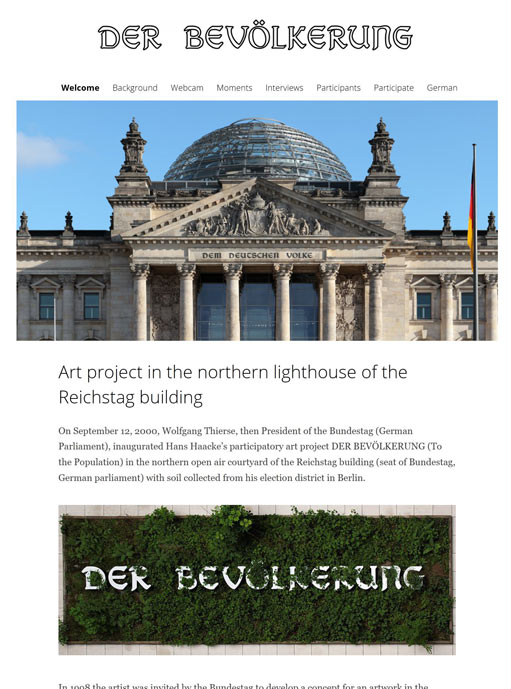
Figure 5: Screenshot of the project's website https://derbevoelkerung.de
© Hans Haacke / VG Bild-Kunst.
The installation is thus in constant dialogue with the population designated in the inscription, tries to involve the MPs and responds as a living piece of nature to the stone surroundings of the parliament building. The work of art is thus never fully completed. Haacke's art project was particularly controversial in parliament; only by a narrow majority did the MPs finally vote in favour of the realisation of the artwork in 2000 after a specially scheduled debate in the Bundestag. The entire debate is documented on the project's website - as another part of the work (Bundestagsdeabtte 2021).
[1] I.e. a "small German" solution after 1990 and with shifted borders after 1945.
[2] It was designed by the Art Nouveau artist Peter Behrens.
References
- Brecht 1935: Bertolt Brecht. Five Difficulties in Writing the Truth. www.literaturwelt.com/werke/brecht/wahrheit.html (13.10.2021)
- Bundestagsdeabtte 2021: https://derbevoelkerung.de/bundestagsdebatte/
- Kaernbach 2011: Andreas Kaernbach. Projekt „DER BEVÖLKERUNG“ im Reichstagsgebäude. https://www.bundestag.de/besuche/kunst/kuenstler/haacke/haacke-198996 (13.10.2021)
- Winkler 2020: Heinrich August Winkler. Wie wir werden, was wir sind - Eine kurze Geschichte der Deutschen. Munich (Beck)
- Winkler 2021: Heinrich August Winkler. Das widerspruchsvolle Erbe des Otto von Bismarck. In: FAZ of 18.1.2021, p.6
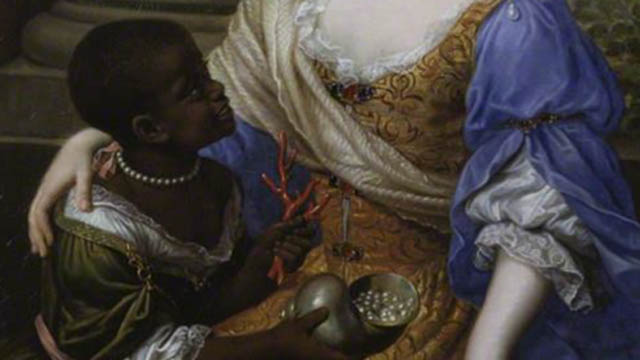
-
 Leonie Chima Emeka
Leonie Chima EmekaIn 1682 a prominent French portraitist named Pierre Mignard (1612-1695) painted a large canvas of Louise de Kéroualle, Duchess of Portsmouth (1649-1734), one of many mistresses to King Charles II of England. The artist depicts her in a richly adorned dress, sitting on an upholstered bench against the background of a stone balcony that opens to a stormy sea. With one hand Louise de Kéroualle gently embraces her page, an African child. The fashion to hold black slaves, especially children, climaxed in the late fifteenth century, but also throughout the seventeenth century slaves were present in wealthy European households as servants.
Mignard’s painting lines up with other paintings of prominent provenance featuring African pages as an attribute of wealth: Titian’s Portrait of Laura Dei Dianti from ca. 1523 and Cristovao de Morais’ Portrait of Juana of Austria from 1535-1537 both depict an Italian respectively Portugal-based noblesse in company of an equally well dressed young African page. Like the duchess Louise de Kéroualle, Duchess of Portsmouth the young female page, whose name is not conveyed, is dressed in beautiful European clothes. More peculiar however is the child's expensive pearl necklace. In the late seventeenth century pearl necklaces were a fashionable accessory for European women of extensive wealth. Imported from the Caribbean, Pacific and Indian Oceans initially by Iberian traders — later also by British and other European traders — the white, oval shaped pearls were an important trading good and symbol of prosperity and wealth. As such the valuable jewellery seems rather out of place on the neck of the page. It seems much more appropriate on the neck of the Duchess.

Fig. 1, detail
Compared to her page, the Duchess’s jewellery appears almost humble, as she wears the same pearls on small earrings. In a much higher amount, the same pearls are mirrored in a shell that the laughing child offers to her serious looking owner. In the other hand the page holds a red coral; a material that has become exceedingly valuable in many regions of West Africa. The most famous example is the kingdom of Benin (today in the region of Nigeria), where the red coral rose to a symbol of royalty and was appointed for the exclusive use of the Oba (Benin sovereign) and his household. The red coral in the hand of the African child connects the picture to the intercontinental trading network between Europe and Africa.
European merchants traded red corals from Mediterranean regions with West African traders or sovereigns in exchange for goods such as gold, ivory or slaves. In all her appearance, from her beautiful dress to her valuable attributes the representation of the African page refers to the trading network, which preceded her presence in the picture next to the Duchess. The servant acts as an attribute of wealth — well-dressed she represents the wealth of the person and house to whom she is made to belong to.
On the other side of the equator, there can be found relief works to a similar effect that allows us to further investigate the historical intercontinental trading network. Many brass reliefs, produced by the royal brass workshop in the kingdom of Benin in the 16th and 17th century, acted as attributes of economic and political power of the royal court. They represented the influence of the sovereign and the wealth of the palace where they were exhibited. A large corpus of brass plagues adorned the palace, which was the economic, religious, political and administrative centre of the kingdom of Benin. One example, currently in the collection of the anthropological Museum in Berlin, depicts two dignitaries flanked by two Omadas (palace servants) before the background of the royal palace. All of them wear pearl ruffs and headgear made of corals. Similar to Mignard’s painting, the corals also function as indicators of the far reaching diplomatic relationship of the Benin palace and symbols of the interregional economic influence of the royal household. The main trading partners to the kingdom of Benin had been Portugal and later Great Britain to whom they sold slaves, gold and ivory in exchange for brass, corals and weapons. However dissimilar the artistic technique of oil painting and brass relief might seem, in the coral they share iconographic meaning. The commodity of red corals make reference to the trading network between Europe and West Africa.
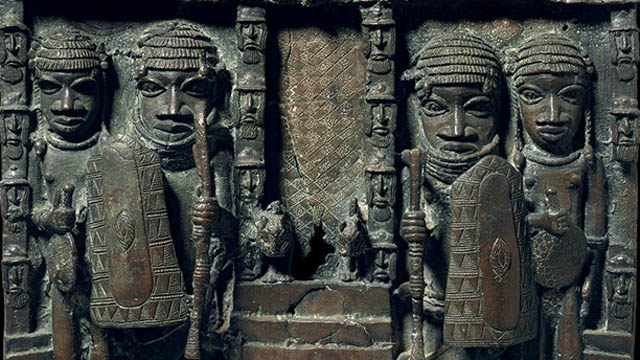
Fig. 2, detail
The trading relationships between Great Britain and Benin which were highly profitable for the rich and powerful in both kingdoms would change successively to an exploitative relationship; the final step to colonial subjugation was the British punishing expedition in 1897, which ended in the destruction of Benin and the robbery of the brass relief plaques to London, from where they were sold to institutions and private collections in Europe, the two Americas and Australia. Until today the royalty of Benin as well as the state Nigeria ask for restitution of the brass relief plaques and other works which were taken by the colonial power of Great Britain.
Peculiar about the Benin brass relief are the Portuguese heads that are engraved on the four palace columns in the background of the effigy. The Portuguese have a distinctive appearance with long straight hair and astonishingly long, pointed noses. In other reliefs the Portuguese are often depicted with Manillas, a ring in the shape of a horseshoe. The foreign metal of brass was imported to Benin by Portuguese traders. The valuable material, an alloy of copper and tin, supplemented cowrie shells as currency in the kingdom. As such the reliefs which adorned the royal palace were made of a material that circulated as money. The Portuguese merchants are depicted on a material which was an important means of their trade. Similar to the child holding the means of her enslavement in her hands, also the Portuguese heads are represented on and with the commodities which preceded their appearance in the imagery. Also British traders were depicted on brass reliefs, mostly with the attributes of armours, weapons and helmets.
At first glance the painting and the brass relief do not have much in common and a comparison seems rather pointless. One is an oil painting by one of the most famous portraitist of his time. The other was made by the prestigious royal brass workshop of the kingdom of Benin. When taking a closer look, however, one finds that both images — however different the outcome — both reveal similar means of constructing an image and its motive behind. The assets and people flanking the depicted patronages in the center of each image — on the one side the pearl necklace, red coral and the enslaved child, on the other the red corals, the manillas the Portuguese heads — build a network within the image that reflects on the economic trading network between both kingdoms. As both images were produced in the context of a royal court, and both intend to depict their far reaching trading relations, they may serve as documents to the complex histories and relations between the two kingdoms and if seen as such, may illuminate an important part of shard history that preceded the colonial era.
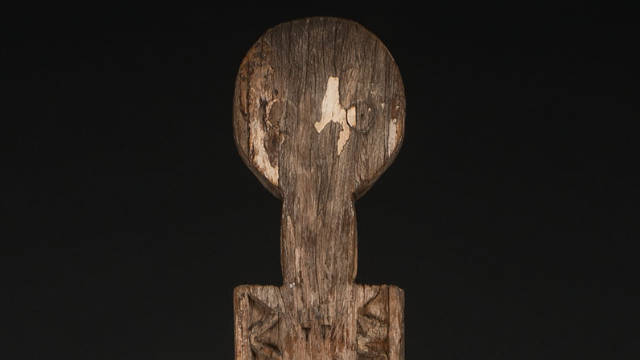
-
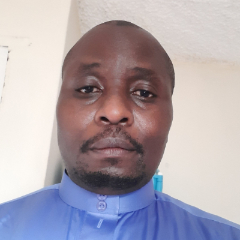 George Juma Ondeng
George Juma OndengGiven the ownership structures of museums in countries such as Germany, the local politicians will never support repatriation requests if they still solely understand objects as pieces of art/craft. It is high time we appreciate spirit, soul and body of these objects. To illustrate this point, I will use the three funerary posts, the vigango (singular kigango) from the Giriama Community in Kenya which are part of the museum collection in Munich. Museum audiences and art enthusiasts in the Global North admire the artistic side of these objects. The truth is, they are not objects according to the producing community. Vigango are souls of the departed elders and thus an integral part of the Mijikenda community. Vigango are also significant to the Giriama as a way of communicating with Mulungu (God). The vigango serve as media of communication with Mulungu since they are no longer trees (wood) but humans (spirits). The vigango are very tall and are made largely for those who have attained the highest status in the society. Vigango are anthropomorphic carvings. They are made using valued indigenous species of hard wood through a lengthy ritual process. There are also strict rules to handle a fallen kigango. Thus their presence in museums collections are highly contestable!
Perhaps Western museums ought to exhibit the processes involved in making of these objects more. To have a better understanding of these objects it is important to learn how they are used in their original community. To make a kigango, an appropriate hardwood tree is selected and prayers made to sanctify it and transform it from being a tree to a human spirit. Vigango are normally handled with great care usually wrapped with white cloth and erected when it is still dark (around 5am).
The vigango provide protection to the community and ensure the education and progress of the family and members of the community in general. The living Mijikenda believe that the dead members of their community not only have influence on them but also that their special needs must be met for which they would receive blessings of good health, abundant rainfall and bountiful harvest. Otherwise they would cause trouble to them when neglected as indicated by the presence of termites or snakes in the house. When a kigango falls down it is left to rot away, under no circumstance it can be picked up and given to a museum or treated as part of a museum collection. A new kigango would be made to replace it. They can be erected somewhere in the kaya or in homestead and as much of the kigango is under ground as above the ground.
Understanding vigango therefore should move beyond the motifs and patterns shown in them and look at the cultural significance and what they represent in Giriama community. As human spirits, Vigango are revered in Kenya and thus treated as human remains. Therefore no one dares to tamper with the fallen ones for fear of the repercusions. Besides, it is locally known in Giriama society that those community members who were complicit in removal of vigango for sale as works of art met early death. While such assertions may be hard to ascertain, it shows how valuable they are to the local Giriama community. It is worth noting that this community reveres the remains of their elders in exactly the same manner they treat vigango. Which brings the question, if they are considered as human spirits by the makers, should museums keep them in their storages? Should they not be treated as part of human remains because the process of working the trees into vigango transforms the trees into anthropomorphic characters with special influence over the living?
If that was to happen, first, the only vigango that should remain in Western museums could be those purposely commissioned by holding museums for purposes of advancing their artistic values. If such a kigango is to be exhibited, it should be accompanied with a community documentary which gives the community an avenue to explain to the world the role of the object in their community including changes through time and space.
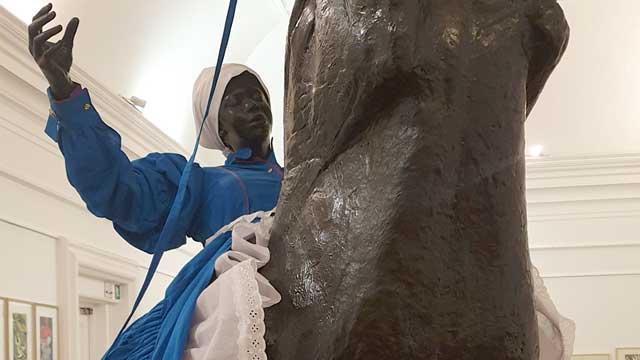
-
 Estelle Vallender
Estelle VallenderMary Sibande’s sculpture The Reign (2010) affects the viewer due to its interplay of bipolarities such as European/African, male/female, past/present, working class/bourgeoisie, private/public, reality/fiction. It forces us to scrutinize our contemporary thinking about the past in relation to the present. The criticism of the colonial era and the rebellion against limitations, that history has placed on identity is inherent in the work, which focuses on African women, historically oppressed as Blacks, as workers, and as women. As a sign of resistance and tribute to all Black women fighting for equal rights it raises questions about race, class and gender.
Vaulting on a boisterous horse, a life-size female figure is displayed in the hyperrealistic sculpture. Rider and mount – both made of fiberglass – are identical in color, creating a consistent medium of presentation for the abundant dress supported by a scaffolding of white and purple undergarments rimmed in Broderie Anglaise, a technique of embroidery, which originated in 16th-century Europe. In addition, the mannequin wears a white apron tied into a voluminous bow at the back and a white headscarf covering her hair. On the one hand, the distinctive elements of the apparel such as puffed sleeves, petticoats and ruffles can be identified as characteristic features of 19th-century Victorian fashion. The style of clothing popular in Great Britain was brought to Africa by the settlers during the unprecedented expansion and consolidation of the British Empire, where it became a symbol of colonial rule. On the other hand, the specific blue color in combination with the white headscarf, collar and apron refers to the uniform of South African maids, that has hardly changed until today. Domestic service – established in the earliest days of European colonisation and later assured by Apartheid – has long been a major sector of the South African labour market. In 2010, the same year the sculpture was created, “the domestic worker industry employed 18% of all women, and 80% of domestic workers were women, with poorly educated Black South Africans making up the vast majority of these women.” (Bosch & McLeod, 2015, p. 135, quoted after Dinkleman & Ranchod, 2010) Readily available at local supermarkets the artist draws on the maid’s uniform and uses the mass product as starting point for her textile hybrids. Born into a line of domestic workers that stretches back three generations, Sibande makes her family history the subject of her art. (Dodd, 2010, p. 467) From silicone casts of her own body she created a fictional character named Sophie [the English name given to her grandmother by her white employer, as Corrigall (2010, p. 155) states]; as alter ego, homage, and representative of former and current domestic workers, she appears here as the protagonist of the work. Through the interplay of the Black body and the dress oscillating between workwear and sublime gown, Sibande performs a subtle manipulation of the semiotics of fashion and their social function as indicators of status, gender, and affiliation (Corrigall, 2015, p. 150). Power relations are explored and the dichotomy of maid and mistress, which implies further bipolarities such as colonist and slave, oppressor and oppressed, European and African, woman of substance and pauper, is deconstructed. “Sophie” occupies the role of the white landlady and thus claims a social position denied to her by repression and racism, whereby her outfit can be read as recovery of autonomy through dispossession of the 'Other'. Regarding the title of the work, the words reign and rein are played on here. In The Reign she is holding the reins both figuratively and metaphorically.
The composition is, also due to its surface property and shade, reminiscent of the European equestrian statue, a portrayal of a sovereign, politician, or commander on horseback, that has functioned since antiquity as a tried and tested means for the demonstration of male power. During colonial rule it was also introduced in South Africa; two well-known examples are the statues of Louis Botha (general in the Second Boer War and first prime minister of the South African Union) in Cape Town and Cecil Rhodes (British entrepreneur and one of the leading players during the high point of imperialism) in Kimberley. Thus, the equestrian statue as a form of representation of white supremacy is anchored in the collective memory of South African society and is here referred to, deconstructed, and reinterpreted by Sibande.
By replacing the idealized male character with a Black female figure, the artist adds an additional layer to the postcolonial debate about South Africans as oppressed Blacks and oppressed workers: women’s limited scope of action in the patriarchal system. Through the usurpation of potentiating positions of power – the mistress first, the sovereign second – Black femininity is calling for an uprising. Dodd (2010) points out that the maid, who is expected to disappear, unseen and unheard, into the background of private life and thus remained socially and culturally invisible for a long time, has assumed the center stage, boldly announcing herself to the world in the gallery room. Her visibility in public space was once again enhanced as the sculpture was featured during the 2010 World Cup within the city of Johannesburg on the side of a building as large, photographic mural. To ensure a dominant and imposing presence, Sibande shows the mount in the so-called pesade: Using the horse's body as a shield and its front hooves as a weapon, the rider is erect according to the movement of the rearing horse and is usually depicted in paintings and sculptures as a battling hero with a sword in his hand and a determined expression on his face. “Sophie” can thus certainly be understood as an insurgent and tribute to all Black women fighting for equal rights. But in my reading the absence of a weapon and the daydreaming character of the human figure, which has her eyes closed as if in trance, break with art historical tradition and expose the scene as an objectification of inner desires and empowering imaginations. The overcoming of class and gender boundaries as well as of limitations, that history has placed on identity, still more of a wishful thinking than an actual condition. This is also evident in the ambivalent figure of the horse, which on the one hand symbolizes the momentum of the protest movement, but on the other hand can also be interpreted as the oppressive system that must be made compliant. While circling the sculpture, it becomes visible, that the dynamics of the animal are not necessarily reflected in the rider’s posture. In a fragile intermediate state, half falling, half vaulting, she presents herself to the viewer from one side as if she were controlling the horse, and from the other as if she would be thrown off at any moment. The Black woman exploring options in the political and social field is thus in a constant balancing act between control and loss of control, combat and lethargy, fiction and reality.
In the large scale work The Reign, Mary Sibande calls on the elaborate attire of the Victorian era to, in some way, refashion our contemporary thinking about the past in relation to the present. She is intent on collapsing binaries around race and power, and alerting us by means of the textile, which is a linchpin of identitarian negotiations, to unexpected interplays between apparently oppositional and asymmetrically related cultures; the plastic body thereby serves in accordance with the functionality of the mannequin as an accessory that reinforces the statement. Clothing is used performatively and, in addition to the cultural reappraisal of national history on the macro level, functions on the micro level as a vehicle of expression and personal search for the artists own postcolonial identity.
References
- Bosch, Tanja / McLeod Caitlin: Dress, Address and Redress. The relationships between female domestic workers and their employers in Cape Town South Africa, in: Global Media Journal African Edition, Vol. 9 (2015), p. 134-155.
- Corrigall, Mary: Sartorial excess in Mary Sibande's “Sophie”, in: Critical Arts 29 (2015), p. 146–164.
- Dodd, Alexandra: Dressed to thrill. The Victorian postmodern and counter archival imaginings in the work of Mary Sibande, in: Critical Arts 24 (2010), p. 467–473.
- Long Live the Dead Queen (Exhibition Catalogue). Gallery MOMO Johannesburg 2010, Johannesburg 2010.
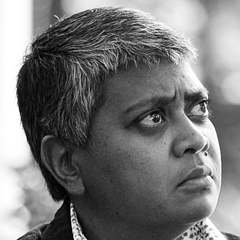 Avitha Sooful
Avitha SoofulIn my reading of this work, I am tempted to and almost seduced by the immediate crutch of a colonial critique that is rooted in positioning the rider and horse within a Eurocentric frame. Instead, I re-read the words spoken by the artist Mary Sibande in an interview held with Malibongwe Tyilo (2021) from the Daily Maverick that crystalises Sibande’s thinking. “My work is not about complaining about apartheid, or an invitation to feel sorry for me because I am black and my mothers were maids. It is about celebrating what we are as women in South Africa today, and for us to celebrate we need to go back, to see what we are celebrating. To celebrate, I needed to bring this maid” (Tyilo 2021).
In summary, Sibande speaks of celebrating black women today and this is vested in the courage that black women had during apartheid to protest against such experiences. It was my responsibility as a researcher to seek out these celebratory moments that Sibande speaks about in her work. In response to the sculpture The Reign (2010), the artist portrayed Sophie riding a black horse that stands on its hind legs referred to as rearing. The rearing of a horse is associated with aggression, disobedience, or pain that is experienced by the animal and in this case, the horse appears to be a mare rather than a stallion. The rearing can also be caused by an inexperienced rider however, it appears that Sophie is calm and in full control of the horse that she rides. Would this animal not be a metaphor for all black women during apartheid in celebration of their aggression, disobedience and pain endured while facing the inhumanity that was meted out to them? In retaining this thought, would Sophie then not be a symbol for all the black female leaders who led the women’s struggle during apartheid and who were also labourers on the farms and domestic workers in cities?
I think that Sibande deliberately played with the pronunciation of the words reign and rein when she titled the work. On the one hand, the work references the reign of black women who were revered as queens when they marched and protested their abuse. The fact that they were severely undermined by apartheid restrictions made them more militant than men. During the years of abuse under apartheid, anger festered within black women, giving rise to 60 000 women who marched to the Union Buildings in Pretoria in 1956, a protest against the pass laws and the 1957 Public Utility Transport Corporation (PUTCO) bus boycott which began in Alexandra. Women also formed the Natal Organisation of Women (NOW) in 1983, The Federation of Transvaal Women (FEDTRAW) in 1984 and the United Democratic Front Women’s Congress (UDFWC) in 1987. Women as members of these organisations protested and marched against high rents, increased food prices and demanded the release of incarcerated black leaders.
Sibande also references rein in this work that indicates the control that the rider has on the horse or the female leadership over the thousands of women who marched on apartheid via protest marches and the formation of women’s organisations. This idea of control via the use of a rein is indicated by the blue length of the rein attached to the horse that Sophie loosely holds in her hands. This shows that Sophie does not require or impose an aggressive response to the rearing horse but allows the horse to perform as Sophie does sitting on its back. In this paused moment, control is about leadership that is asserted without force.
The Reign (2010) appears to include the seeds of democracy with Sibande’s use of the purple undergarment that the rider wears. This introductory period would be 1989 into the 1990s when the African National Congress and many other anti-apartheid organisations were unbanned, and many political prisoners were released including Nelson Mandela which allows for the greater celebratory moments that Sibande refers to. The year 1989 is significant apart from it being the year when violent protests took place nationally, in schools, universities and on the streets. It was the year when the police used purple dye in water cannons to spray protestors, a dye that did not wash off easily and was referred to as the purple rain.
When one considers the idea of protest during apartheid, it was a performance by a mass of people, a performance that included song, dance, body gestures and movements that emulated, ridiculed, and promoted a different approach to the ‘norm’. The rearing horse is a performance indicative of the protests that fuelled the journey to democracy. A journey that demanded sacrifices from black people of their time, lives and brutality that can only be imagined. In my view, the meters of the blue dress that Sophie wears is a metaphor for the millions of workers who participated in this struggle. The sculpture is a metaphor for the black female struggle during apartheid, her struggle against patriarchy and a demand for equality that was situated within the broader apartheid struggle. These two struggles gave birth to the adoption of the Women's Charter (1954) and the Freedom Charter (1955) in Kliptown, Soweto.
There is no doubt that the work is a critique against colonial rule however, the manner in which Sibande has invented and presented the work, is saturated with the achievements of black women within metaphors of significance that describe the black female struggle without pity. It celebrates black female achievements in eroding the inhumanity imposed by apartheid specifically on women who endured the slurs and oppression of race, class and gender.
The fact that Sophie sits with her eyes closed, allows her to reminisce about the periods that announced the celebration of black women’s victories against the apartheid beast through women’s protests, boycotts, arrests, torture, fragmented family lives and mass marches. The domestic attire is Sibande’s prop for the historical enactments that define black women’s contribution to the struggle against apartheid.
In my view, Sibande’s work The Reign has encapsulated black women’s struggle not only against apartheid but their right to equality within a South African democracy.
References:
- Tyilo, M. 2021 Iconic South African Works: Mary Sibande’s ‘The Reign’. Daily Maverick. 22 June (online)
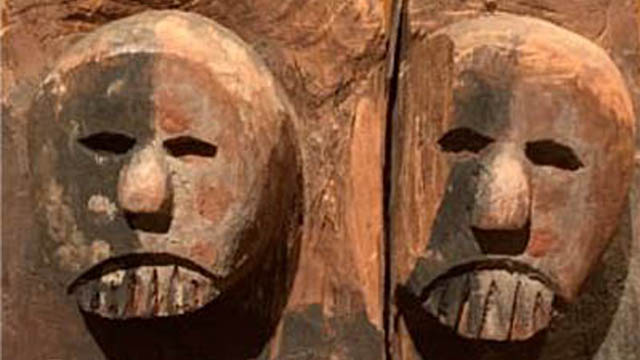
-
 Patrique deGraft-Yankson
Patrique deGraft-YanksonExploring an Enigmatic Piece of Traditional Cameroonian Sculptur
The Veranda Post found in Museum Fünf Kontinente is an exemplification of the extent to which indigenous Africans mutually reinforced socio-religio-cultural existence and expressiveness of form through sculpture. Various examples of these artefacts abound in the collections of African plastic artforms found in many museums across the globe. The beauty in experiencing, analysing and speaking about this artwork (as well as many of its kind), lies within the absence of authenticated historical and analytical literature on them. This makes it possible for the observer to exert complete authority of personal perception and interpretation devoid of any fixed attitude that dictates, interfere or curtails aesthetic enjoyments, interpretations and judgements, as attempted in this presentation.
With the dimensions of 199 x 60 x 50 cm, the Veranda Post found in Museum Fünf Kontinente is one of the numerous examples of the African artistic expressiveness, confirming the artistic prowess of the traditional African. Examples of these artefacts abound in the collections of African plastic artforms which record indigenous religious beliefs, practices and performances that date back from the beginning of African history.
As typical of most indigenous African sculptures, this work is not only uncaptioned, but the artist/creator is not known. What is known, however is that, its peculiar characteristics and style makes it easily identifiable and representative within the milieu of popular African sculptures. According to the Museum Fünf Kontinente records, this work was collected from 'Kamerun'. 'Kamerun' was an African colony of the German Empire between 1884 and 1916, which was located in the region of today's Republic of Cameroon (Wikipedia, 2020). Comparing the characteristic features of this sculpture with similar sculptures described by some art historians as Veranda Posts created as part of ancient African monumental architectures found in the Cameroons Grassland (Willett 1981) therefore, it is not difficult place it within that category. Hence its caption.
As can been seen from similar ‘posts’ and judging from the elaborateness of the images created on them, the major reason for the production of these posts was more to afford the sculptor or sculptors the opportunity to decorate the buildings with stories, rather than serving as supports (see figure 1).
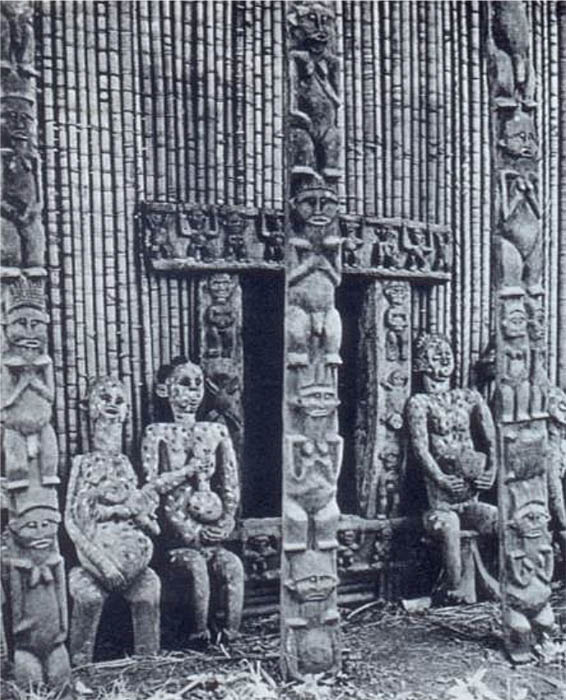
Figure 1: Ancestor statues, carved door-frame and verandah posts (Source: Willett 1981)
As said above, the beauty in analysing and speaking about this artwork (and many of its kind), lies within the absence of historical and analytical literature. The fact that this makes it possible for me (and for that matter any other observer) to exercise personal powers of perception and interpretation without any fixed attitude to direct or curtail their aesthetic interpretations and judgements made it my object of choice for this project at the Museum Fünf Kontinente.
Going by Margaret Trowell’s generalisations about African art, this Veranda Post can be classified under the ‘spirit-regarding’ art. Like many others of its kind, this work, which has front and back views, is flanked with human and other figures, ostensibly those of ancestors and is symmetrically disposed about a vertical axis, rendering it frontal at both sides.
Analyses of the images created on this pole reveal striking similarities between the age old traditional religious practices of the African and the Western religious beliefs and practices brought in by the earlier missionaries.
At the direct look of the object from the front (as it has been positioned at the museum, but actually one of its two sides), a prominent kneeling figure with hands clasped together unto the chest (much like the praying hand) can be seen in a pose that looks very much like the kneeling praying postures at Christian worships. To the African, this posture is not only assumed at prayer sessions as a visual image of submission to God’s authority, but is also exhibited as a sign of respect, humility and total surrender to a superior authority. For the sculptor to present the kneeling man as a central figure and subsequently rendering all other human figures in similar submissive postures therefore makes the theme of prayer, submissiveness and spirituality very strong in the composition.

Figure 2: The kneeling or praying figure
The kneeling man is placed right below two human faces whose prominence and positioning easily pass them for elders, superiors, or better still, ancestors. Before the ancestors, all supplications are made, and through them, request are carried through to the supreme God.
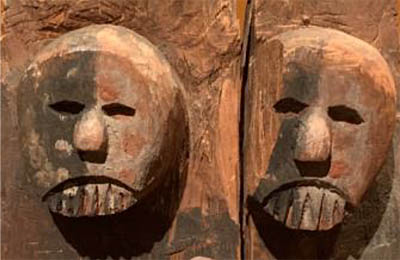
Figure 3: Ancestor figures
The importance of the two faces and emphasis on their superiority is further strengthened by a strong demarcation between them and the kneeling man through a thick rigid contoured line that forms a partition between the elements. This could be interpreted as a spiritual borderline that separate the spiritual world from the physical world. Generally, the African believes in the existence of the physical and the spiritual worlds as separate entities and this demarcation clearly depicts this belief. Also worthy of notice is the orientation of the demarcating border which rhymes with the praying hands of the kneeling figure, thereby visually connecting the figures. This carefully chosen placement of the two faces in the composition alludes to the supremacy of the ancestors and their exclusive existence in the after world as well as their connection with humans.
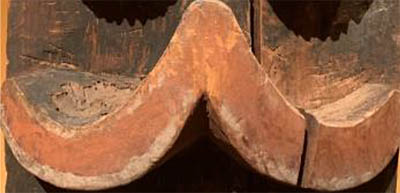
Figure 4: The spiritual borderline
Another striking imagery is created with the placement of a very visible image rendered in concentric circles. Among many African ethnic groups, the circle represents completeness, holiness, perfection and other such attributes ascribed to the supreme being (God). Among the Akan people of Ghana, for instance, the Adinkra symbol called Adinkrahene (king of Adinkra symbols) is presented as concentric circles. This symbol represents authority, leadership and charisma. The sculptor most likely created a bull’s eye of this symbol as an indication of exactly where this particular post belongs. The post could possibly be one of the furnishes for a palace or the abode of a traditional priest. This could also suggest the likelihood of the prominent kneeling figure being the King or the chief priest. Considering the atmosphere created by these symbols, the circle, with the kind of prominence it exudes could also represent the omnipresence of the supreme being, thereby heralding the people’s belief in the iniquitousness of God and His closeness to mankind.
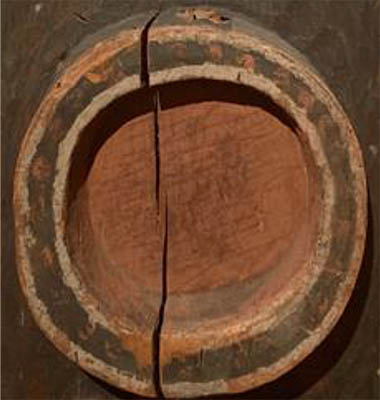
Figure 5: The concentric circles
Other recognizable images of animate and inanimate objects in the work include crocodiles, lizards and geometric shapes. Whilst it is likely that the geometric figures may have been deliberately presented to create balance, simulate a built living environment and arouse aesthetic sensibilities, the images of animals like those of the crocodiles have significant meanings as far as African culture and belief systems are concerned. Among some ethnic groups in Africa, crocodiles are believed to be the souls of ancestors who come back to live with men. Examples are the crocodiles in the Crocodile Pond at Paga in the northern part of Ghana who virtually live peacefully among the people. There are numerous African stories about crocodiles coming to the aid of men to either protect them or lead them to safety. Their inclusion in this particular work therefore is to establish the existence of spirits among men, especially as humans pray to seek their guidance and protection.

Figure 6: The crocodiles
Considering where it was created and where it is located now, as well as the current effort towards extracting a meaning out of its symbolism, this veranda post and many other such African artefacts in several museums around the globe have demonstrated how images and symbols resonate relationship between cultural practices around the world. The confluence of symbolic interpretations of the icons in the traditional African religions and the Euro-Christian religion, as depicted in this veranda post, gives justification to Africa’s unquestionable acceptance of Euro-Christianity and all the associated visual cultural practices.
For comparison, also read Karin Guggeis' analysis of this object here.
References
- Roy, C. (2019). Signs and Symbols in African Art: Graphic Patterns in Burkina Faso. Signs and Symbols in African Art: Graphic Patterns in Burkina Faso. https://africa.uima.uiowa.edu/topic-essays/show/38?start=13
- Wikipedia. (2020). Kamerun. Kamerun. https://en.wikipedia.org/wiki/Cameroon
- Willett, F. (1981). African Art. London: Thames and Hudson.
 ISB_Team
ISB_TeamThis 'Veranda Post' is variously referred to (mostly in relation to its architectural-functional context) lintel or "te ken dy dye" (in the local Bandjoun language - PHSAA), porch post, house front pillar, post, cult house post (M5K, p. 17), Cameroon post / family crest (Macke at M5K, 13, 24). Post, however, in the sense of sign (post-it) is suggested by PdGY to address the communicative function. Other designations do not address the function, but limit themselves to the given, perhaps to avoid any pre-interpretation: 'sculpted wooden block' (Kecskési 1999 n. 108) or 'large carved square wooden block' (Kecskési 1976, p. 22).
Object biography: The object was taken before 1893 by Max von Stetten during expeditions on the Bamileke Plateau (south-western Cameroon), where it was presumably part of a meeting house of a confederation. Stetten (1860-1925) was German commander of the Kaiserliche Schutztruppe for Cameroon until 1896. Cameroon was a German colony at that time. The exact circumstances of how the object came into Stetten's possession are unknown, as is its original location and context.[2] In 1893, the Royal Ethnographic Collection acquired the pillar as a gift from Stetten.[3] In 1912, a photograph of the pillar was published in the Almanac of the Blaue Reiter. It is currently on display in the permanent exhibition in the Museum Fünf Kontinente Munich in a niche - a mirror allows a view of the second side (see Fig. 2). Along with other objects from the collection, it is currently the subject of a transnational project on their provenance (GI).
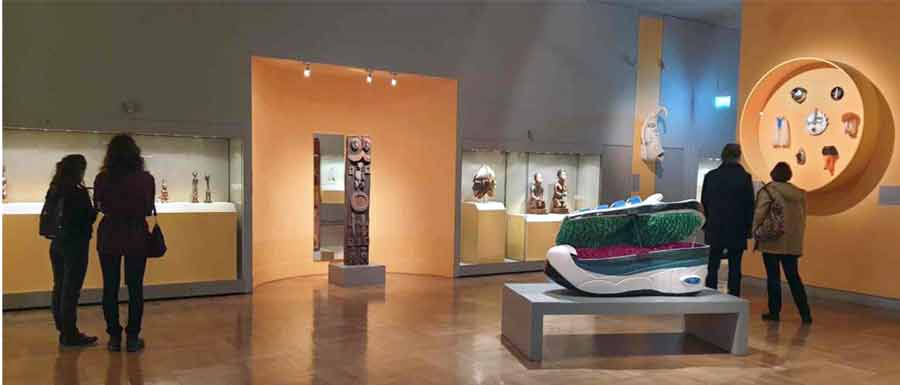
Fig. 2
Status: In comparison with carved mullions on façades of royal residences in the Cameroon grasslands (Fig. 3),[4] other mullions or door frames in the Museum Five Continents (M5K, p. 17, Kecskési 1999 No. 11, 70, 75) or in the Humboldt Forum Berlin, there is a partial similarity of motifs, but a strikingly 'archaic' formal language. Other examples are clearly more 'elaborate'. The multitude suggests that this type of pillar is quite typical of works from this period in this region of West Africa.
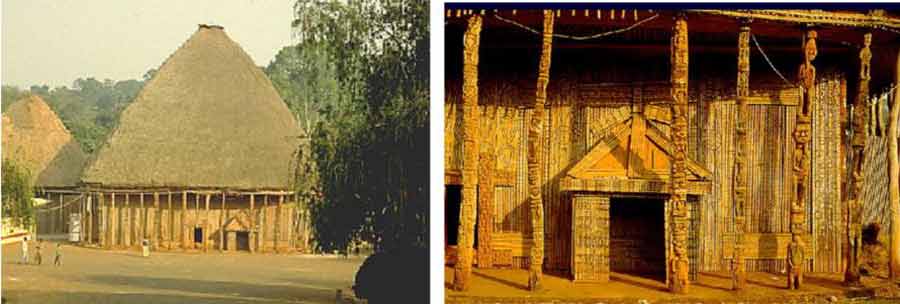
Fig. 3
Interpretation
The current view of the work
For the interpretation, the following questions lend themselves to art lessons: Form, iconography (meaning of the motifs), function, theme (or core idea) of the object, i.e. an interpretation.
With regard to the guiding idea of multi-perspectivity, two positions will be addressed: On the one hand, the view of today on the basis of ascertainable contexts, which seeks to understand the object from its time of origin and its context of origin. On the other hand, the view of the object by the artists of the Blaue Reiter. The comparison of these perspectives seems particularly relevant from an art didactic point of view, even though other perspectives would be conceivable, e.g. from the point of view of museology, provenance research, from the context of current restitution debates, etc. However, these are addressed in the teaching suggestions.
Shape
At first, the pillar develops an immediate physical presence for the visitor: through its sheer size (larger than life, almost square in plan), the materiality of the massive, cracked block of wood (the outline is irregular and probably corresponds to the tree) and the clear, concise, reduced language of form, whose meaning seems inaccessible. The surface treatment is archaic, the wood is more hewn than carved.[5] Thus it appears powerful and at the same time mysterious, which is supported by its presentation in the exhibition on a plinth and without glazing (see Fig. 4).
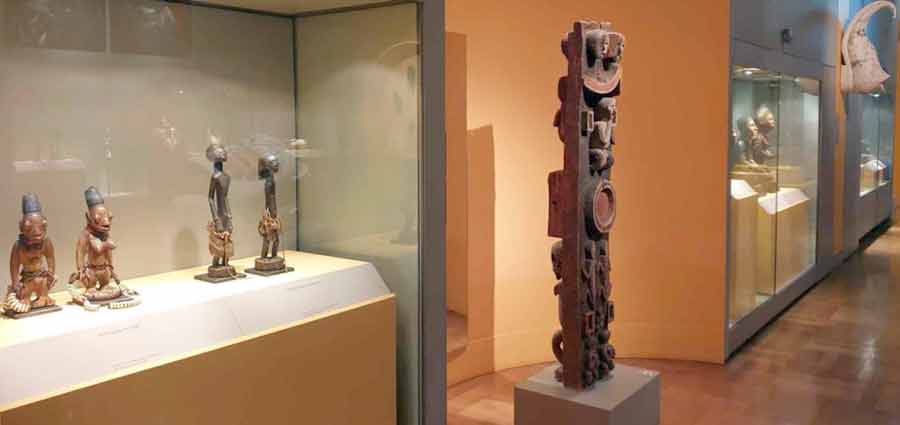
Fig. 4
A closer look reveals how the sculptor interweaves various modes of representation between complete abstraction (circle, rectangle) and representationalism (human figures, animals) in a compositional way[6] , monumentalising the individual motifs through internal symmetry, geometrisation, frontality and statics. This is supported by the painting (see Fig. 5). In this reduction, everything narrative is missing. The representation becomes emblematic, it becomes a symbol.
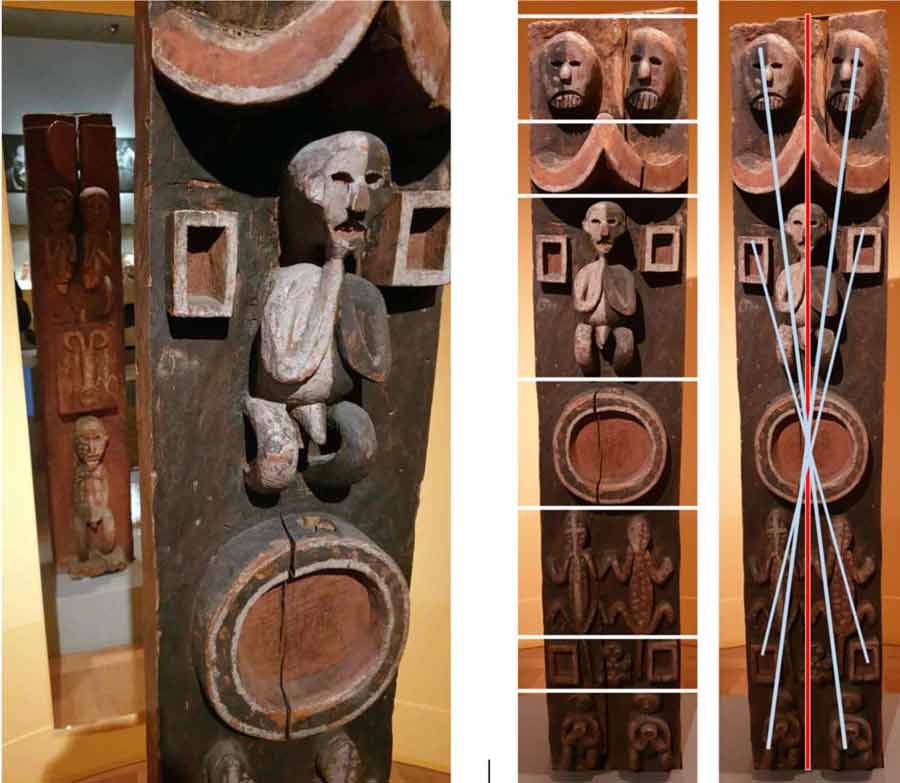
Fig. 5, 6 and 7
This is also supported by the overall composition, which obviously follows a calculated geometric order. It is strictly horizontally divided into individual zones, only once do lizard tails protrude into another zone. However, the separation into individual layers is ingeniously overcome compositionally by the strict axial symmetry in the vertical, but also by the point-symmetrical arrangement around the respective centres. The result is a tension between the contradictory compositional principles (see Figs. 6 and 7) that is decisive for the effect of the pillar.
The lack of any narrative on the one hand and the high creative effort on the other underline once again that it is about a symbolic level. This can perhaps be deciphered, even if its immediate complex order makes it seem above all direct, sensual.
The secure decoding of the iconography (what the individual motifs as well as the arrangement meant in the context of origin) is not possible with today's state of knowledge. Oral culture has left no written sources that could be consulted. Moreover, the oral tradition has been torn down - not least due to colonial destruction. However, since the work obviously has a symbolic language with clear iconography, this level cannot be left out in art lessons. German-language literature and oral experts from West Africa were consulted here. The results contradict each other, but nevertheless yield a court of meaning (see Fig. 8, in which the individual attributions of meaning are named)[7] , which provides a certain direction.
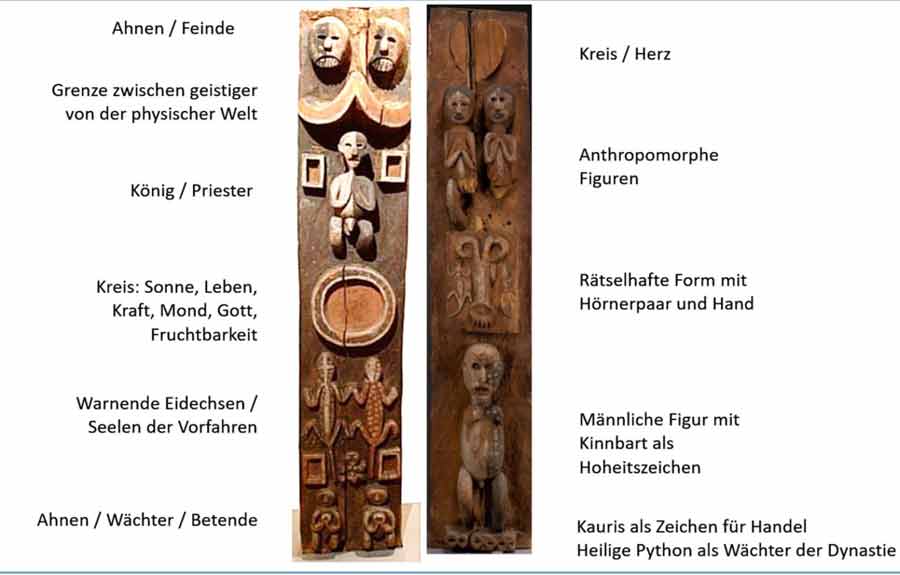
Fig. 8
In addition, the block is painted in three colours. These also carry meanings: Black could symbolise suffering, white could be the colour of the dead and symbolise mystery, red, the colour of blood, symbolises life (PHSAA). The light-dark contrasts themselves symbolise life and death (Kecskési 1999).
Function
PdGY suspects that the pillar - as part of the architecture of the house - stood at the spatial interface with the public (on a path) in order to communicate the significance of the house, presumably a cult house, to the outside. The object could therefore have been part of the façade of a particularly distinguished house[8] , also with a supporting function for the roof. It communicates what happens in the house or who lives or resides there.
Kecskési, on the other hand, considers a free positioning in space (Kecskési 1976, p. 22) and suspects an ancestral tablet. This in turn would fit the following determination by Gouaffo: "The 'Blue Rider Post' is a spiritual object. According to oral traditions, the object was placed in the sacred house like a statue. Caps, chains, bags or skeletons could hang from the object. Secret societies like the 'Losango' used the statue to perform certain rites, for example to cleanse the village of evil spirits." (Albert Gouaffo in GI) KG also suspects the context of a meeting house of such a secret society. Common to all assumptions is that the pillar stood in the context of a house with a sacred or cultic function.
'Theme' of the object: Basically, three different levels can be delimited, some complementary, some contradictory. First, the communication function on the façade or at the entrance to the outside. Then the pictorial formulation of a certain understanding of human being-in-the-world is asserted; man is ultimately embedded cosmologically.[9] At the Humboldtforum Berlin, in turn, such pillars from West Cameroon are also seen as the "architecture of power", power exercised by the rulers or the secret societies through impressing and deterring.[10]
Second perspective
The interpretation provided above can be countered by a second perception of the pillar, as it appears in the almanac "Der Blaue Reiter". This almanac, an artist's book, was published in 1912 by Franz Marc and Wassily Kandinsky. The reception of this book is over a hundred years old, but it is significant for the development of European art, as it is a good example of how artists of this time created a new frame of reference by referring to non-European art. In this respect, the Blaue Reiter clearly differs from Cubism, Expressionism or Dadaism, which were all being developed at the same time.
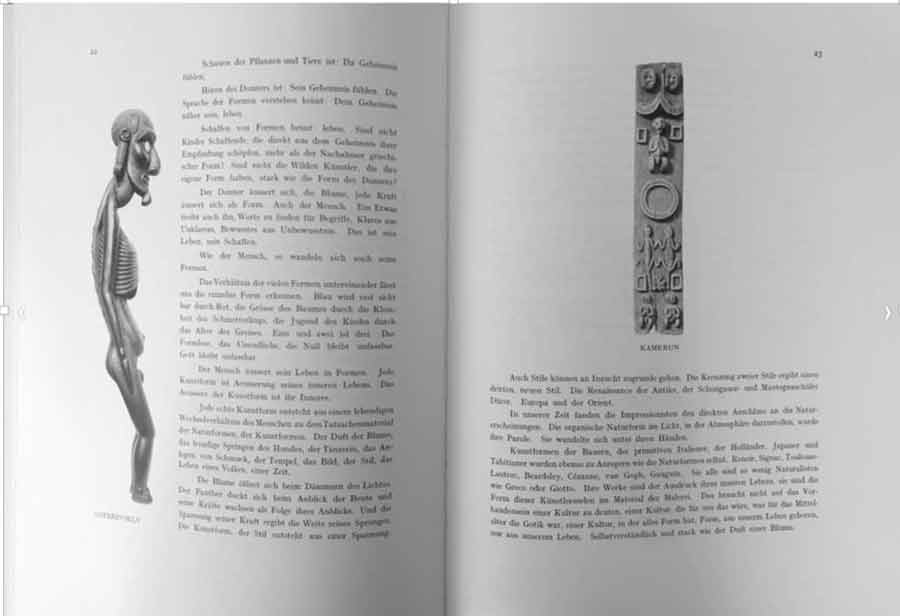
Fig. 9
In the Almanac, on pages 21 to 27, there is an essay by the painter August Macke entitled "Die Masken" (The Masks), in which a relatively small illustration of the pillar in question is embedded (see Fig. 9). Macke's contribution, like all the other texts in the Almanac, was probably written at a joint meeting of Macke, Marc, Münter and Kandinsky in Murnau.[11]
Visits to ethnographic museums are documented above all for Wassily Kandinsky, who was a trained ethnologist, and Franz Marc. Marc had also admired sculptures from Cameroon in particular during his visit to the Berlin Ethnographic Museum in 1911. And it was he who was ultimately responsible for the insertion of the photograph of the post in Macke's article.[12] In his letters to Macke, Marc writes about this. On 14.1.1911 about the objects from Cameroon in the Berlin Ethnological Museum: "I remained amazed and shaken by the carvings of the Cameroonians"; and later that he would furnish Macke's article in the Almanac with "ethnographic wonders" (MW).[13] In the text itself there is a single, very brief reference to "carved and painted pillars in a Negro hut", by which presumably the post was meant.
The text itself represents Macke's conception of art. In it, "intangible ideas", "mysterious forces", an "invisible God" express themselves in the world of appearances and "cultic expressions". The invisible materialises in the visible. This realm of the visible includes not only art, such as that of Giotto or van Gogh, who are classified as 'primitive', but also nature. Children's drawings, the folk art of the 'primitives' and 'savages' or non-European cultural forms are also expressions of the mysteriously invisible. These themselves are - and this is decisive - equal to each other. There is no hierarchy, no distinction between high and low, between high art and popular culture. All forms speak - as Macke characterises it - in "strong language". For Macke, the pillar in the museum is then an example of "the tangible form for an intangible idea, the personification of an abstract concept" (Macke 24). He also calls this the figure of an "idol".
The approach underlying this thinking sounds familiar; we have known it since the Platonic theory of ideas. However, this approach does not justify the selection of this particular post, as other posts from the museum's collection would also have been available.[14] Here one can only assume. I suspect that there are various factors that led to the selection: the archaic power of the forms; the initially wild and carefree-looking, additive combination (or montage) of the various principles of representation in the individual motifs (concrete - abstracted, geometric - organic, symbolising - depicting), which on closer inspection, however, then reveals itself to be consciously composed; or the coarse, physically perceptible materiality of the cracked, thick block of wood in impressive dimensions. PdGY also speaks of "wonderfully composed".
In the work, everything is represented with great sensual power that is the opposite of an "empty" image in European "cultures that have already passed through a thousand-year course, like [...] Italian Renaissance" (Macke 24) and from which Macke renounces: "We must bravely renounce almost everything that has hitherto been dear and indispensable to us as good Central Europeans [...] in order to get out of the fatigue of our European lack of taste". (Macke ibid.)
In art lessons, the question arises to what extent the image that Marc or Macke create of the pillar (as representative of the idea of an idol) goes together with what the object presumably was and is in its original context. Or to put it another way: are they designing a certain, exotic image that does not correspond to the object itself? [15]
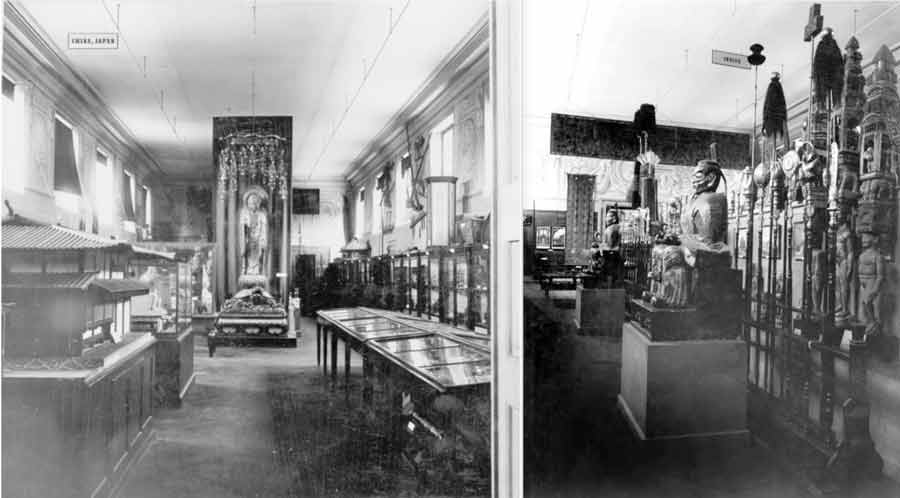
Fig. 10 Historical photos of the exhibition of the India Department in the Munich Museum around 1910 (source M5K)
References
- GI: Juliane Glahn and Marta Krus: CAMERUNS RIGHT TO CULTURAL OBJECTS. https://www.de/prj/zei/de/pos/22656808.html
- Kecskési 1999: Maria Kecskési. Art from Africa - Museum of Ethnology Munich. Munich (Prestel) 1999
- Kecskési 1976: Catalogue for the exhibition African Art. Andreas Lommel (ed.). Munich (Bruckmann) 1976
- M5K: Staatliches Museum für Völkerkunde München (ed.). The Blaue Reiter and the Munich Museum of Ethnology. Munich (Hirmer) 2009
- KG: Karin Guggeis. The Blue Rider Post. (2021): https://www.explore-vc.org/en/objects/expanding-the-canon-of-art-at-the-global-north.html
- PdGY: Patrique deGraft-Yankson. The Veranda Post. (2019) https://www.explore-vc.org/en/objects/the-veranda-post.html and oral interview on 23.4.2022 in Bayreuth, Iwalewahaus.
- PHSAA: Paul-Henri Souvenir Assako Assako. Information by email 20.5.2022
- Wikipedia: Cameroon & Max von Stetten
- MW: Macke Wolfgang (ed.). August Macke - Franz Marc: Briefwechsel, Texte und Perspektiven. 1964. Cologne (DuMont).
- Macke: Macke August. The Masks. In: Almanac "Der Blaue Reiter", 1912, edited by Franz Marc and Wassily Kandinsky, pp. 21-27
Appendix on iconography
- Anthropomorphic figures: ancestral couples / guardians and protectors of the royal residence. These anthropomorphic figures are treated with respect as extraordinary personalities. They are considered ensouled beings, spirits with supernatural powers. (PHSAA) Depiction of all human figures in similar postures: theme of prayer and submission to spirituality. (PdGY)
'Front' side from bottom to top:
- Two people: Ancestral couples / guardians and protectors of the royal residence (PHSAA). People pray for the guidance and protection of the ancestors (PdGY).
- Lizards: The symbol of the lizard warns everyone; it symbolises death. (PHSAA) PdGY sees here two crocodiles (ancestral souls returning to live with humans) instead of lizards.
- Circle: motif of the sun, symbol of life and power; the moon, image of woman and symbol of fertility. (PHSAA) The circle represents completeness, holiness, perfection and other attributes attributed to the supreme being (God). (PdGY)
- Kneeling figure: King or priest (PdGY)
- Line of demarcation between the spiritual and the physical world
- Two heads above: Ancestors (PdGY)
'Back' side from bottom to top:
- Python (geometric frieze at the bottom of the 'back' side): royal totem/sacred python, guardian of the dynasty (PHSAA).
- Male figure with chin beard as emblem of sovereignty (Kecskési 1999)
- Enigmatic form with a pair of horns ending in a hand (?) at the bottom (Kecskési) on a rectangle with two flanking lizards.
- Anthropomorphic figures
- Circular area
Footnotes
[1] The object is variously referred to, mostly in relation to its architectural-functional context: lintel or "te ken dy dye" (in the local Bandjoun language - PHSAA), porch post, house front pillar, post, cult house post (M5K, p. 17), Cameroon post / family crest (Macke at M5K, 13, 24). Post, however, in the sense of sign (post-it) is suggested by PdGY to address the communicative function. Other designations do not address the function, but limit themselves to the given, perhaps to avoid any pre-interpretation: 'sculpted wooden block' (Kecskési 1999 n. 108) or 'large carved square wooden block' (Kecskési 1976, p. 22).
[2] The first German trading posts were established in Cameroon as early as 1868, and in 1891 German military "expeditions" were launched in Cameroon. In 1884, the German Consul General concluded protection treaties with regional rulers and thus proclaimed the protectorate of Cameroon as a German colony. The seizure of the hinterland, which included the grasslands, took place over the course of the following 30 years. (Wikipedia) Even if the provenance is still not clear today, one can certainly share the Humboldt Forum's assessment of such objects that - even if they were not looted through acts of war - they are nevertheless "an expression of unequal power relations and structural, colonial violence". (https://www.smb.museum/nachrichten/detail/ethnologisches-museum-weg-frei-fuer-die-rueckkehr-der-ngonnso-nach-kamerun/)
[3] In the entry book it is noted: "Gr. square block, 1.80 cm high made of heavy wood, carved on both sides with humans and lizards, heavily damaged by termites". (https://onlinedatenbank-museum-fuenf-kontinente.de/) In 1895 Stetten published detailed "Travelogues" in the Deutsches Kolonialblatt.
[4] http://www1.biologie.uni-hamburg.de/b-online/afrika/kamerun/palast.htm; http://www1.biologie.uni-hamburg.de/b-online/afrika/
[5] The block is almost certainly worked with a chisel.
[6] "decorated with geometric, anthropomorphic and zoomorphic forms" (PHSAA)
[7] All performers avoid a complete decoding. They only make suggestions for individual motifs.
[8] It could have been the house of a 'priest' whom one could consult there and through whom or ancestors one could pray to God (PdGY).
[9] "Expression of the cosmogony of the universe of the peoples of the Bamileke plateau; expression of the belief system" (PHSAA).
[10] The assertion of power is also included by PHSAA.
[11] Catalogue: August Macke, Lenbachhaus Munich, 1987, Bruckmann. Munich. S.164
[12] He simply titled the painting "Cameroon", the name of the country of origin (the country whose sculptures he admired).
[13] There are other illustrations in the text: a bird's head from Brazil, a figure from Easter Island (see Fig. 9), one from Mexico, a bird mask from New Caledonia, a cloak from Alaska[13] and a child's drawing entitled "Arabs". Except for the child's drawing, all objects are from the then Royal Ethnographic Collection in Munich (M5K, p.11). They are only titled with the respective country of origin, e.g. Cameroon. Macke was obviously involved in the selection as well as the layout, as his layout sketch shows (M5K 24).
[14] It is not certain what was shown in the presentation at the Royal Ethnographic Collection in Munich at the time, which covered 400 square metres in six rooms in the north wing of the Hofgarten arcades in Munich. The only thing that is certain is that photos of the ten objects depicted, which came from various parts of the world, were lent to the artists for the publication of the Almanac. Photos of the presentation do not exist. "Whether Marc and Macke [actually also] saw the work in the exhibition at that time can be assumed with a high degree of probability, since it is after all very large and thus impressive." (Information Karin Guggeis 26.7.2022)
[15] In this context, it seems of interest that neither Marc nor Macke take up in their own pictorial language the aesthetics of the non-European works they "celebrate" here.
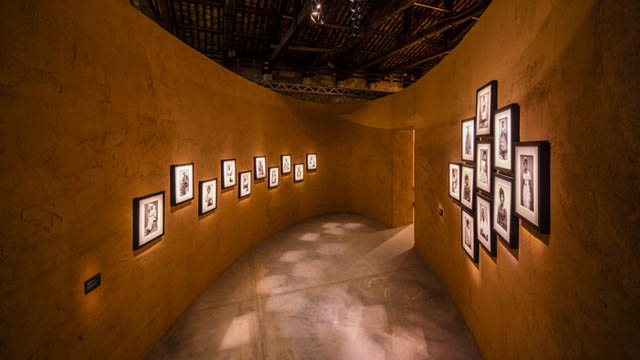
-
 Kwasi Ohene-Ayeh
Kwasi Ohene-AyehThe Ghana National Pavilion at last year’s 58th International Art Exhibition of La Biennale di Venezia served to augment the fervent energy of contemporary art already simmering in its locality. The Pavilion staged a stellar intergenerational selection of six “multi-local”1 artists from Ghana— Felicia Ansah Abban, El Anatsui, John Akomfrah, Lynette Yiadom-Boakye, Selasi Awusi Sosu and Ibrahim Mahama— whose works range between photography, painting, film, video, and installation. Stationed in the Artiglierie within the Arsenale, the Pavilion displayed the artists' works in continuous cylindrical enclosures designed by architect David Adjaye, and executed with laterite soil couriered from Ghana. The nation’s debut outing at the Biennale, titled Ghana Freedom, summoned the “boundlessness” and euphoria in the spirit of self-determination promised in its mid-century Independence moment and epitomised in such cultural events as the World Festival of Black Arts— the first being Festival Mondial des Arts Nègres (FESMAN) which took place in 1966 in Dakar, Senegal, and then the Festival of Arts and Culture (FESTAC) which happened in Lagos, Nigeria, in 1977. “There is no longer any need to look back in the same way as an act of reclamation or reaction”, writes the curator Nana Oforiatta Ayim, since “these pathways remain with us and evolve”(Ayim, 2019, pp. 31).
The emancipatory ideal summarised in the titular of the exhibition is a poignant basis for this evolution given the colonial mediation of Ghana’s formal education in general, and art education in particular (seid’ou, 2014; seid’ou, 2016). In this regard, Ghana Freedom could be said to have countenanced an approach to the practice of art that is unconstrained by the de-contextualised imposition of the beaux-arts tradition which became ingrained through colonial instruction in the Gold Coast (pre-independence Ghana) from the late-19th century to the late-1950s, and which prevailed in the postcolonial mediation from then till the first decade of the 21st century. Exhibitions of this dispensation predominantly lacked curatorial direction. Indeed, the Ghana Pavilion, however obliquely, can also be said to have announced the inventiveness of emergent exhibition practices in the country. For example, Ibrahim Mahama’s early site-oriented and itinerant exhibitions in public places is a pragmatic and critical response to the derelict infrastructural conditions an art practitioner in the country has to contend with. Mahama’s attitude to this systemic neglect is traceable to the interventionist ethic and affirmative politics of blaxTARLINES KUMASI.2
It goes without saying that the spectacular occasion of the Pavilion accumulates cultural capital for the nation in asserting a compelling place and reputation as far as the global mainstream of art is concerned— more especially for a nation which has been treated as a footnote in literature on the history of art in Africa. It is therefore our task to, so to speak, “brush history against the grain” (Benjamin, 1969, pp. 257) by practically intervening in it through such exhibition making ventures. In this vein, the success of the Pavilion highlights two major points for discussion.
The first is a dialectical situation. At a time when cultural institutions and producers are enduring famishing conditions as far as state support or infrastructural systems are concerned, the state has demonstrated that it is possible to alter this fate— seeing as the Ministries of Finance and that of Tourism, Arts, and Culture, respectively supported and commissioned the Pavilion. But now that the impossible has happened, one would have thought that prioritising a National Pavilion would pave the way to launch serious longterm cultural policies ensuring continued presence in Venice itself, and also to invest in and build the necessary economic and cultural support structures for those local practitioners who are in dire need of it. As this is yet to happen, it will be crucial for Ghana to sustain the legacy of the Pavilion beyond the rhetoric of representation, even if it turns out to be a one-time affair.
Secondly, turning our attention to local relevance, the intention of the organisers to, later that year, bring the exhibition to the National Museum of Ghana to be able to show it to local audiences and to generate new knowledge has yet to materialise, for whatever reasons.3 This is unfortunate given the curator’s unequivocal concern for institution building and the “possibilities of artistic development in Ghana itself” (Ayim, 2019, pp. 140). If we keep in mind, apropos Borges, that every exhibition, at any given moment, based on its arguments or claims, “creates its own precursors” and therefore holds the potential to alter our conceptions of both past and future within that genealogy,4 then it presently counts as a missed opportunity not to have optimised Ghana Freedom in terms of creating history rather than solely staging one. What I mean is that the exhibition could have served as an epistemic site through which to actively produce and update the history of contemporary art in Ghana. For example, by citing5 or acknowledging the timeliness in the return of the exhibition to the National Museum falling on the 20th anniversary of South Meets West6 — the seldom talked-about contemporary art exhibition of African artists based on the continent and in the diaspora which also took place at the National Museum in 1999 with an artist lineup including Atta Kwami, Tracey Rose, and Yinka Shonibare— in addition to such “precursors” as FESMAN, FESPAC and “Authentic/Ex-centric".7
Such an instance would have contributed to the intellectual legacy of Ghana Freedom in fulfilling the task of theorising the newly emergent curatorial and artistic paradigms in Ghana, all the while establishing the critical connections, differences, and evolutions between postcolonial and transnational antedatings of such political attitudes to exhibition making. This is especially important when we take the emancipatory promise of contemporary art seriously by considering the exhibition as a system that is not only meant for [re]producing spectacular displays, while taking the commodification of art for granted, but as one which deploys the convergence of symbolic and material consequences enveloped in the immanent tensions of history and power. Particularly when we acknowledge that the National Pavilion structure of the Venice Biennale impedes the institution from turning towards the non-imperialist substance of contemporary art.8
It remains to be seen how far representation of culture as the sole basis of participating in such blue-chip events as the Venice Biennale can get us9 (or any nation with egalitarian aspirations for that matter). Let us also not forget that biennales have not always existed, nor should they necessarily always exist in the future.10 Accepting this, at least, cautions us not to take its existence as well as what it promises for granted. If we succeed in the latter it breeds conformism which can be opposite to true freedom. To boot, the present COVID-19 pandemic has gone a long way to expose the fragility of existing exhibition conventions as it threatens to revolutionize our economic, socio-cultural, health and political sectors on a planetary scale. The institutions by which we traditionally associate the production, circulation and experience of art— i.e. galleries, museums, the art market, etc.— have all suddenly ground to a halt and are facing the challenge to structurally rethink their modus operandi. Therefore the future of exhibition making, as we know it, is what is currently at stake. We are confronted with the task, now, as in previous times in history, to be more inventive with the exhibition form. Bonaventure Soh Bejeng Ndikung, artistic director of Sonsbeek (2020-2024), articulates this grammar of contingency well enough in the epigraph.
Where Ghana goes from here in verifying art as an egalitarian universality and creating particular models to suit its locality is entirely up to us, its protagonists. And so the question becomes, when such real threats and crises have paled the superficiality of representation (in other words, when all the pomp and pageantry of Ghana Freedom has disappeared), what will its historical substance be posthumously based on?
About Selasi Awusi Sosu's presentation at the pavilion see: Link
About Ibrahim Mahama's "Savannah Center for Contemporary Art" in Tamale see: Link
Footnotes
1Taiye Selasi uses this term in her essay Who is Afraid of a National Pavilion? in Ayim (2019 pp.38-44).
2Both Mahama and Selasi Sosu are alumni of KNUST and active protagonists of blaxTARLINES who espouse these transformations. This internationally networked collective has been functioning as the contemporary art incubator in the Department of Painting & Sculpture in Ghana’s foremost Art College at the Kwame Nkrumah University of Science & Technology (KNUST) since 2015, and has radically upended the hegemony of salon style display formats erstwhile ubiquitous in commercial galleries, hotel lobbies, and other spaces which had contrived the realisation of artistic potential primarily for the patronage of tourists.
3Nana Oforiatta Ayim confirmed in her lecture in ibid. (in June) after its opening on May 11th that the show would be at the National Museum of Ghana later that year.
4I appropriate this thought from Jorge Luis Borges in his essay Kafka and his Precursors (1951).
5By citing, I do not mean merely mentioning (since the curator succeeded in mentioning FESMAN, FESPAC and “Authentic/Ex-centric” as precursors), but through curatorial research, and coming to terms with their historical, theoretical, and aesthetic substance and formulating an argument that deals critically with the claims and implications of these events through an analysis of their significance to our own epoch.
6South Meets West is an exhibition organized by Kunsthalle Bern and Historical Museum of Bern in collaboration with the National Museum of Ghana which happened in Accra in 1999 and travelled to Bern in 2000. The exhibition curators are Dr. Bernhard Fibicher (Kunsthalle Bern, assisted by Eszter Gyarmathy), Dr Yacouba Konaté (Université d’Abidjan-Cocody, Côte d’Ivoire), Dr. Yvonne Vera (National Gallery Bulawayo, Zimbabwe). Participating artists are Jane Alexander, Fernando Alvim, Meshac Gaba, Kendell Geers, Tapfuma Gutsa, Atta Kwami, Goddy Leye, Zwelethu Mthethwa, Tracey Rose, Yinka Shonibare, Pascale Marthine Tayou, Yacouba Touré, Minnette Vári, and Dominique Zinkpe. The catalogue included texts by Oladélé A. Bamgboyé, Dr. Bernard Fibicher, Kendell Geers, Clive Kellner, Dr. Yacouba Konaté, Atta Kwami, Simon Njami, Prof. Joe Nkrumah, Tonie Okpe and Sarah Zürcher. See South Meets West (2000).
7Oforiatta Ayim acknowledged her debt to Salah Hassan’s and Olu Oguibe’s curated exhibition at the 49th Venice Biennale in 2001, Authentic/Ex-centric: Africa In and Out of Africa. See Ayim (2019. pp. 140).
8Oforiatta Ayim commented on the problematics of this in our public conversation in op. cit. @thestudioaccra. (2019). Taiye Selasi also points at this issue in her catalog essay.
9The curator of the Pavilion, Nana Oforiatta Ayim, states her motivations for realising the Pavilion as such: “One of my driving forces [for being in Venice] is this idea of representation— of voice, of narrative— of who gets to speak the narrative.” She made this statement in a public conversation I had with her at @thestudioaccra. (2019, June 27). Ghana Pavilion Venice Biennale: Conversation with Nana Oforiatta Ayim. [Facebook post]. https://web.facebook.com/accrastudio/photos/a.1118364178194088/2491384694225356/?type=3&theater. Audio of lecture is in author’s archives, courtesy @thestudioaccra.
10I appropriate this thought from Walter Benjamin who, in a similar spirit of contingency, was speaking particularly of the novel form in literature. See Benjamin (1998. pp. 89).
References
- Ayim, N. O. (Ed.). (2019). Ghana Freedom: Ghana Pavilion at the 58th International Art Exhibition La Biennale di Venezia [catalogue]. Koenig Books.
- Benjamin, W. (1969). Theses on the Philosophy of History. In Hannah Arendt (Ed.) Illuminations: Essays and Reflections. Schocken Books.
- Benjamin, W. (1998). The Author as Producer. In Understanding Brecht: Walter Benjamin. Verso.
- Mitter, S. (2020). Art Biennials Were Testing Grounds. Now They Are Being Tested. 2020. https://www.nytimes.com/2020/05/01/arts/design/art-fairs-biennials-virus.html. Accessed 6th May, 2020.
- seid’ou k. (2006). Theoretical Foundations of the KNUST Painting Programme: A Philosophical inquiry and its contextual relevance in Ghanaian Culture [Unpublished PhD Thesis]. Kumasi: KNUST.
- seid’ou, k. (2014). Gold Coast Hand and Eye Work: A Genealogical History. Global Advanced Research Journal of History. Political Science and International Relations ISSN: 2315-506X Vol. 3(1). pp. 008-016.
- South Meets West exhibition catalogue. 2000. Kunsthalle Bern, NÀWÁO. ISBN 3-85780-124-7.
published May 2020
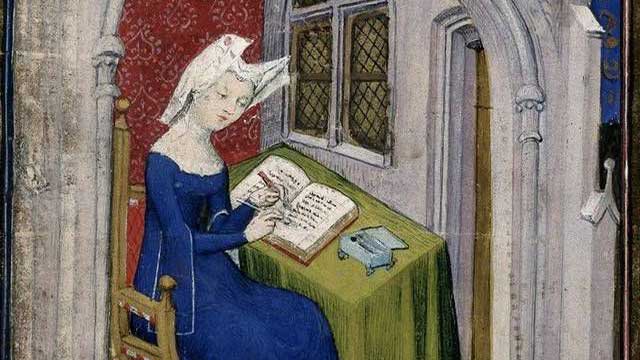
-
 Bea Lundt
Bea LundtThe picture of Christine de Pizan and our knowledge about her life show that this is not true. Christine de Pizan (1364 – c. 1429), born as Cristina da Pizzano in Venice, was a poet and author at the court of King Charles VI of France. Christine produced a large number of vernacular works, in both prose and verse. Her works include political treatises, mirrors for princes, epistles, and poetry.
This very famous miniature is an illustration from a book, handwritten in the years between 1410 and 1414 and preserved at the British Library in London (Harley MS 4431, Vol. 1, fol. 4 r). This manuscript contains texts by Christine de Pizan and is called The Book of the Queen, as it had been produced on behalf of and dedicated to Isabeau of Bavaria, wife of King Charles VI of France. There is another miniature showing Christine on her knees dedicating the book to the French queen. Christine can be identified by her facial features and style of dress.

Detail of: Master of the Cité des Dames and workshop, 1413 - 1414, parchment, 36,5 cm x 28,5 cm, British Library, London. © British Library, London. Photo: the author
In the centre of the aforementioned picture, a woman is shown sitting at a table and writing into a voluminous book. With her left hand, she is erasing coloured letters with a knife and with her right hand correcting them. This dynamic gesture of self-correcting fills her working situation with life. On her head is a headdress typical for a widow, the guimpe/wimple. Around the desk, we see some fictive architecture with a broad symbolic meaning: it shows a room which is specifically tailored to an intellectual working woman but also opens to the outside, as there are windows, an arch, and entryways. The roof of another storey marks the building as a town house. Though the scene is an interior one, the colours on the woman are bright, and there are warm red colours around her. This is different from older pictures showing clerical female authors in the narrow, closed rooms of a cloister.
‘Je, Christine’: An independent author defining her role in society
The picture shows a professional female author in an urban context in the process of writing a book and working for the public, where she is honoured as being part of the highest level of society. There are similar pictures with Christine sitting behind her desk with an open book and people coming and arguing with her in a lively manner. In one, a young man, who has been identified as her son, stands in front of her and speaks to her. Another one shows four men visiting her in her room and discussing her writings with her. Sitting Christine, standing men: the arrangement shows that the guests will leave soon. Such encounters are also atypical for a cloister, which is said to be the usual space for educated women.
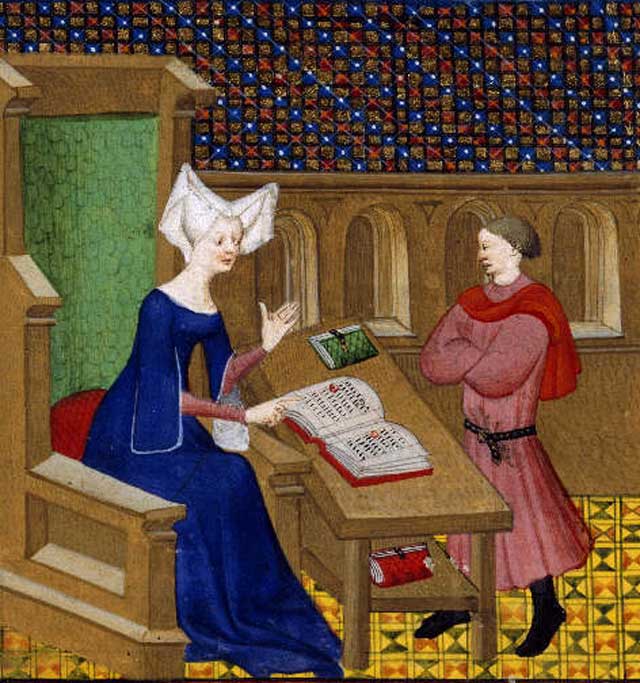
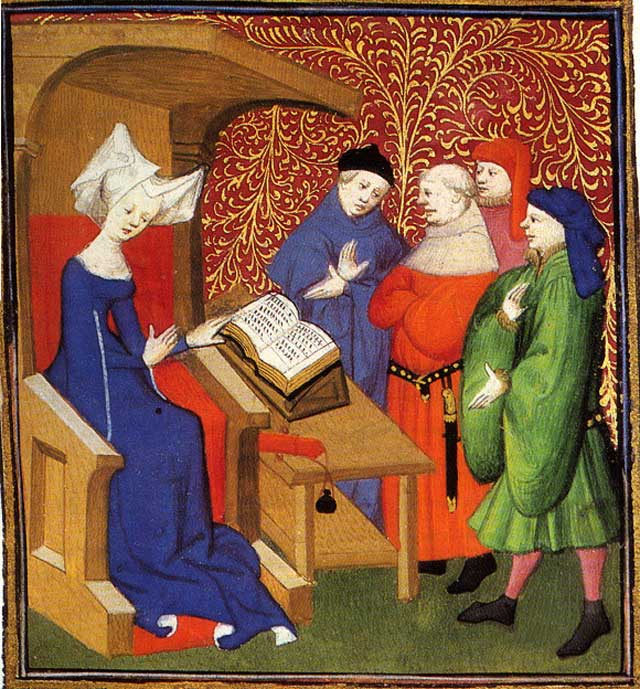
Detail of: Master of the Cité des Dames and workshop, 1413 - 1414, parchment, 36,5 cm x 28,5 cm, British Library, London. © British Library, London. Photo: the author
As experts see it, it was Christine herself who ordered the illustrator to characterise her in this manner. Several autobiographical comments of hers document that she liked to show herself living this individualist intellectual lifestyle. Traditional scholars call this typical for the Renaissance, which began a bit after Christine’s lifetime. Very often in her books we find ‘Je, Christine’ (‘I, Christine’), at the beginning of a chapter.
Christine’s life story
Christine was born in Venice in 1364 as the daughter of a doctor of medicine and astrology. He was called to the French court in Paris. Christine married a royal secretary and had three children. But then her father, her husband, and the king who had supported the family died. Christine was 25 years old and had to care not only for her children but also for her old mother and younger relatives living with her. She decided not to marry again but to support her living by writing. Her oeuvre contains poems alongside utopian, philosophical, historian, didactical, allegorical, and autobiographical texts. Noble families ordered her books and paid her well. In her old age, she escaped from the civil war in Paris to a cloister nearby where she died around 1429.
The first secular female author in Europe
With her Italian-French background, Christine is an example for the migration of intellectuals in southern Europe in the late Middle Ages and early Renaissance. She was not herself noble but came from an academic family and remained near the court. She was privately educated, mostly by her father, and also educated herself using the offer of the erudition centre in France. Living within a totally Christian cosmos with a spiritual way of thinking, she was not a clerical but rather a secular woman. In her books, she fought for gender equality, especially in education, as well as for recognizing the extraordinary performances of women in the past and in her own time. She wanted this knowledge to be part of a new understanding of history. She sharply protested against texts which reduce women to sex objects. With her pugnacious notes, she provoked the first literary quarrel about femininity and masculinity in Europe, the ‘Querelle des Femmes’.
The masculinisation of literacy and education in the modern era
In premodern Europe, competencies in literacy were considered more or less ‘feminine’. Girls learned to read at least the Bible to their families; noblewomen were taught languages and literature to be able to marry into different countries. The ideal for masculinity was fighting strength; sitting with books seemed to be viewed as non-masculine. Many kings and noblemen were illiterate. This changed in modern times. Literacy became part of the public world and school education developed as a privilege of men.
In the colonial period, Europeans attempted to impose this central European order on the African colonies: women were relegated to the private sphere, while men had the privilege of acting in public, which was more valued. The colonisers argued these gender roles were anthropologically fixed constancies, and they had the civilising mission of transferring this pattern to their colonies. But African scholars insist that in precolonial times, polar structures of different worlds for men and women did not exist, exactly as they had not in premodern Europe.
Conclusion: Confirming non-dualistic, fluid gender concepts
As we still need to fight against the discrimination of women and girls in educational systems worldwide, the message of the picture might be encouraging. This visual icon helps to deconstruct a common myth about Europe and to reject static ideas about continuities of bipolar gender structures. Even in the European Middle Ages, independent female authors were shown, combining inside and outside worlds. To see that it was different in history motivates us to see the hybridity of gender structures on both continents, which do not merely follow the dualistic scheme of men working in public professions and women working as housewives.
References:
- Christine de Pizan: Le Livre de la Cité des Dames. Stock 1986 (French).
- Christine de Pizan: The Book of the City of Ladies (Penguin Classics) rev. 2000 (English).
- Christine de Pizan: Das Buch von der Stadt der Frauen. Originally in Middle French. Translated and with commentary and an introduction by Margarete Zimmermann, Orlanda Buchverlag Berlin 1986, dtv 1999 (German).
- Roberta L. Krueger: Towards Feminism: Christine de Pizan, Female Advocacy, and Women’s Textual Communities in the Late Middle Ages and Beyond. In: Judith M. Bennett, Ruth Mazo Karras (eds.): The Oxford Handbook of Women and Gender in Medieval Europe. Oxford University Press 2016, pp. 590-606.
- Henry Kam Kah: The Sacred Forest. Gender and Matriliny in the Laimbwe History (Cameroon), c. 1750-2001. Berlin 2015.
- Oyewumi, Oyeronké: Colonizing Bodies and Minds. Gender and Colonialism. In: ibid (ed.): Invention of Women. Making an African Sense of Western Gender Discourses. Minneapolis, MN 1997, pp. 121-156.
Edited by Kelly Thompson.
published August 2020
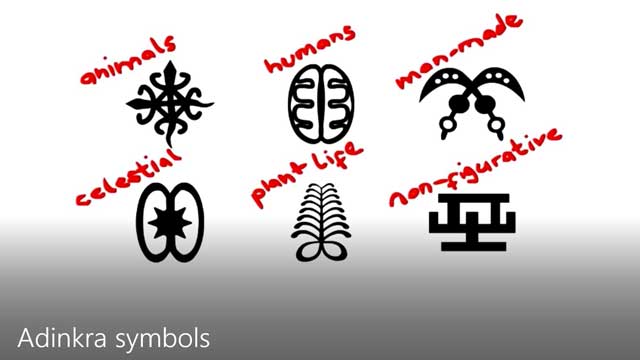
-
 Patrique deGraft-Yankson
Patrique deGraft-YanksonSome of these signs and symbols depict historical events, human behaviour, animal behaviour, attitudes, plant life forms and shapes of objects, many of which have grown to assume recognizable iconographic dimensions. Others carry rich proverbial messages that are traditionally considered a mark of wisdom. These attributes indeed give credence to the need for the preservation and popularization of traditional symbolism and imagery.
Therefore, in this project (which is one of many others in progress) therefore, has made an attempt to repackage Adinkra and other traditional symbols through animated videos. The aim is to make these age-old symbols more accessible and attractive to the modern Ghanaian youth. Presenting traditional symbols digitally would not only appeal to the youth, but would also ensure widespread visibility, presentation and thus, better preservation.
published October 2020

-
 Elfriede Dreyer
Elfriede DreyerOver the last three-and-a-half centuries, South Africa has experienced volatile and turbulent histories of a colonial, postcolonial and global kind. These brought on substantial nomadic movement of people, leading to political and social displacement, and hybrid identities. Since 1652, as a multifariously colonised country South Africa has shown cultural patterns of movement in and out of the country, and from place to place. The country is extraordinarily rich in mineral resources and gold, which has brought about massive wealth, but also instability. Johannesburg was established in 1886, due to the so-called gold rush, with fortune seekers and diggers flooding from all over the world to the country. Since then, the gold mines have attracted an influx of locals as workers, which contributed to much nomadism, but ironically – especially since 1948 during apartheid – such mine workers were allowed to work underground but once above ground they had to return to townships outside the large cities. During apartheid, non-whites or ‘people of colour’ were removed from the city and forcibly established in townships outside the city; they were only allowed as workers into the city; and had to carry passbooks (identity documents) on them all the time.
Such nomadic identity as a result of marginalisation and displacement is still presiding, but for different reasons since 994 and the end of apartheid. From this time onwards there has been a immense influx of people from all over the African continent to South Africa in search of greener pastures. Whereas during apartheid many intellectuals and people ‘of colour’ emigrated from the country, over the past two decades there has been an outflux of people due to a strong degree of political uncertainty and actions of political redress in the post-apartheid constitution, or to convicted beliefs of ‘not belonging’ to the new political dispensation.
Senzeni Marasela’s series of works entitled Waiting for Gebane (2015-2016) entails a continuation of her previous work, such as the embroidery series Theodorah in Johannesburg (2006) and Sarah, Senzeni and Theodorah come to Joburg (2011). In the latter works she explored her relationship with Johannesburg as city and experiences her mother had when she first arrived there. She used embroidery as technique and thread due to its associations of fragility, and conceptually she considered the issue of black women in migration to the cities. Theodorah was depicted as travelling to the city with the aim to finding out exactly what it is that has made many people disappear into Johannesburg. She is uncertain of what she is actually looking for. In the 2014 exhibition catalogue for Nomad bodies at the Wintertuin gallery of the Royal Academy of Fine Arts in Antwerp (curator: Elfriede Dreyer), Marasela stated that “I continuously return to the city, looking and relooking as it undergoes massive transformation. Having grown up in a catholic environment, penance informs a great deal of methods which are labour intensive. The city of gold is important as a transitory space: people go through the city, they come to the city and many dream of this city. There is something impermanent about this city, and it is precisely at this point that I began to write my own histories. The social climate of the city has never been favourable to the women that enter it. It is deliberate that I leave the city arid, without indications of lived experiences, as I seek to build the Johannesburg I can safely occupy.”
However, in Sarah, Senzeni and Theodorah come to Joburg the artist includes herself and Sarah Baartman also as nomads or pilgrims in the city. The three women’s plights are fundamentally different – Theodorah is on ajourney looking for her lost son Gebane; Senzeni is on her journey finding her foothold as individual, and colonial Sarah was displaced to Europe from the Eastern Cape– but they are one in their search for a place, recognition and restitution. They are each other’s doppelganger in their journey through the city of Johannesburg which forms the backdrop to the works. The metaphor of the rhizome is of particular interest to an engagement with nomadic identity in the context of a continent such as Africa. Already in 1987 Deleuze and Guattari (1987:7). coined the idea of rhizomatic being, stating that the “rhizome itself assumes many diverse forms, from ramified surface extension in all directions to concretion in bulbs and tubers”. Living on a vast continent, Africans are accustomed to long journeys; however, poverty, violence, civil wars, imperial infiltrations and oppression have resulted in a generalised nomadic condition where people are constantly moving and travelling in the search for a better life and even survival. However, in a wider sense, globally, Rosi Braidotti (2011:3) states that the nomadic predicament and its multiple contradictions have come to age in the third millennium after years of debate on the “’nonunitary’ – split, in process, knotted, rhizomatic, transitional, nomadic – so that fragmentation, complexity and multiplicity have become everyday terms in critical theory.” Braidotti has been engaged since the 1990s with the question as to what the political and ethical conditions of nomadic subjectivity are, grounded in a “politically invested cartography of the present condition of mobility in a globalized world” (Braidotti 2011:4).
Zygmunt Bauman (in Hall & Du Gay 1996:19) views the ontologies of nomadic identity as becoming critical when there is uncertainty as to where one belongs, a view that is crucially relevant to emerging urbanising African identity. `the figure of Theodorah can be aligned with the idea of the flâneur, which Bauman appropriates in his presentation of the stereotype of the pilgrim who as a stroller is on a teleological journey – ordered, determined and predictable (Bauman in Hall & Du Gay 1996:21). Comparing the contemporary world to a desert through its fragmentation, Bauman views it as being inhospitable to the notion of the pilgrim, being unable to leave a footprint in the sand. The forward march of the pilgrim (Theodorah) is equally compromised and in the context of the wind effacing footprints (of Gebane) and the rhythmical similarity of the desert environment, the pilgrim goes in circles (Bauman in Hall & Du Gay 1996:23). “The overall result is the fragmentation of time in episodes, each one cut from its past and from its future, each one self-enclosed and self-contained. Time is no longer a river, but a collection of ponds and pools” (Bauman in Hall & Du Gay 1996:25).
As in these afore-mentioned works, in the series Waiting for Gebane the artist’s mother is depicted as going from her rural environment to the ‘big city’, Johannesburg, in a search for her son Gebane who left for the city and never returned. She becomes a nomad in her searching ritual, but it is a dystopian journey, providing no teleological “good ending” and leading nowhere, since she cannot find him. The works depict a potent image of Africans searching for a better life elsewhere, but simultaneously failing in finding answers to their economic and other dilemmas. Waiting for Gebane explores cultural and artistic mappings of the social and political power geographies and complexities that dominate cities. Of pertinent interest here is how people’s decolonial transition from rural to urban contexts have been voiced, claimed, renegotiated and contested, especially in the context of capital cities as locations where there is a conflation of global and local influences. Mendieta (2001:15, 23) argues that cities have become the “vortex of the convergence of the processes of globalization and localization … [and] epitomes of glocalization, to use Robertson’s language (1994)”; and that the “city is the site at which the forces of the local and the global meet: the site where the forces of transnational, finance capital, and the local labour markets and national infra-structures enter into conflict and contestation over the city.”
In Marasela’s work, contemporary African identity is characterised by particular cultural histories, as well as by identifiable patterns of transitivity and how people construct their identities psycho-geographically. Dispossession of the embodied and embedded self is articulated so that the city and placelessness become sides of the same coin (Braidotti 2011:6). Braidotti (2011:7) argues that “The contrast between an ideology of free mobility and the reality of disposable others brings out the schizophrenic character of advanced capitalism”, which is nowhere more visible than in the political and social extremities in South Africa. Marasela’s work expresses the idea that meaning is created through the crossing of space and distance between bodies, or as Soja (1989:133) argues, “To be human is not only to create distances but to attempt to cross them, to transform primal distance through intentionality, emotion, involvement, attachment.”
New decolonised Identities emerge through movement through in the world and interfaces with alterity. Often, it is a sense of alterity or the attraction to the exotic other that produces nomadism. Waiting for Gebane thus presents the ambivalent Baumanian idea of the pilgrim-tourist who keeps going in circles, driven by a non-teleological sense of survival and looking for a better life, which might not lead to a ‘good ending’. Nomadic identity is essentially rhizomatic here, and in South Africa – also in an amplified sense on the African continent – the drive to belong and the utopian quest for a better life have resulted in identity being redefined, renegotiated, rerooted and sprouting in many directions.
Senzeni Marasela is a female South African artist of Zulu origin, born in Thokoza, KwaZulu Natal in 1977. She is currently completing a MA degree in Art History from Wits University (SA); she has exhibited widely in the national and international contexts; and she has been awarded several grants and residencies, for example from Devon Arts Residency (Scotland) The Ampersand Foundation and Axis Gallery in New York; The Thami Mnyele Foundation in Amsterdam; and the Kokkola Art Academy in Vasa. Her artist website is found at http://www.senzenimarasela.com.
References- Bauman, Z. ‘From pilgrim to tourist – or a short history of identity’. In Hall, S and Du Gay, P (eds). 1996. Questions of cultural identity. London/New Delhi/Thousand Oaks: SAGE.
- Braidotti, R. 2011. Nomadic subjects: embodiment and sexual difference in contemporary feminist theory. Second edition. Gender and culture: A series of Columbia University Press. New York: University of Columbia Press.
- Deleuze, G & Guattari, F. 1987 [1980, French original]. A thousand plateaus. New York: University of Minnesota.
- Hall, S and Du Gay, P (eds). 1996. Questions of cultural identity. London/New Delhi/Thousand Oaks: SAGE.
- Mendieta, E. 2001. Invisible cities: a phenomenology of globalization from below. City: analysis of urban trends, culture, theory, policy, action 5(1):7–26.
- Soja, E. 1989. Postmodern geographies: the reassertion of space in critical social theory. New York/London: Verso.
published February 2020

-
 Kerstin Pinther
Kerstin PintherAs a miniature, the sculpture Indépendence Tchao (2014) by the Franco-Algerian artist Kader Attia refers to the Hôtel de l'Indépendence in Dakar, Senegal. At the beginning of the1970s – a little over ten years after the independence of the west African country under Lépold Sédar Senghor and a few years after the first Festial Mondial des arts nègres (1966), the hotel was built by Henri Chomette and Roland Depret. Since the end of the 1940s and into the 1980s, the office of the French architects had built governemental and private buildings and others in numerous African countries. Indépendence Tchao was initially created as a site-specific installation on the occasion of the 11th Dakar Bienniale in Senegal. It refers back to the hotel high-rise with the sculpture; the ‘borrowing’ can immediately be recognized, above all by its characteristic brise-soleil façade. Kader Attia used discarded and somewhat rusty inex index boxes, stacked on top of each other. The inventory of the archive itself came from a dissolved administration in Algeria. Only a few kilometres away from the central exhibition venue of Dak'Art, the hotel still forms a striking, decidedly 'modern' architectural antithesis to the flat neo-classical colonial administrative buildings - an aesthetic incunabulum that symbolized the future in its outstanding verticality and modern furnishings. However, the former architectural icon is now empty and in a state of decay. Indépendence Tchao (the title is a reference to the famous song Independence Cha-cha from 1960/Kalle) thus refers both to a utopia that has grown fragile, the bursting of a dream; as well as to the persistence of colonial archiving and (also structural) standardization practices, to old and new (architect) networks in the postcolony.
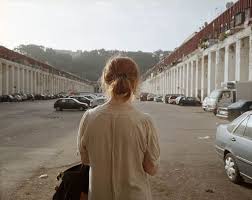
Attia, Kadar. Pascale, Fernand Pouillon, Alger. 2012
https://inferno-magazine.com/2012/06/23/kader-attia-le-corps-utopique/ [Stand: 28.10.24]
Two further - this time photographic - works by the same artist also address the ambivalences and potentials of modern architectural promises: In the case of the photograph of a woman, seen from behind, surrounded by the mighty arcades of the 200-column courtyard, the connection between the body as the 'first architecture' and the 'built' architecture is central. Not least through the title Pascale, Fernand Pouillon, Alger (2012), it becomes apparent that the person is a transsexual. According to Attia in an interview, the strangeness in one's own body corresponds to the 'architectural' alienation that the inhabitants of the 'Climat de France' who had resettled from the Kasbah in Algier must have felt in the 1950s; the necessity of appropriation, re-territorialisation or even 'becoming at home' applies to both bodies (the human and the architectural).
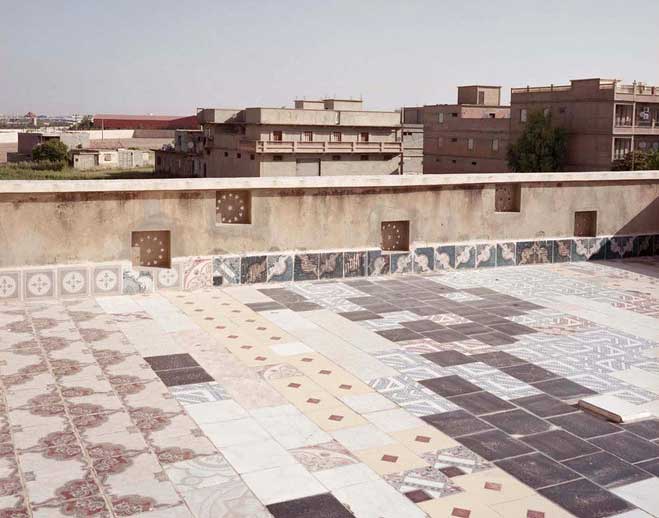
Attia, Kadar. Déconstruir - Reinventer. 2012
https://slash-paris.com/en/evenements/construire-deconstruire-reconstruire-le-corps-utopique/sous/3669 [Stand: 28.10.24]
A reflection on transgression and imagination also lies at the centre of another photo: Déconstruir - Reinventer (2012) actually shows only the results of a minimal intervention in the standardized construction method, and yet these traces of spatial action are marked here as meaningful in the sense of aesthetic place-making.
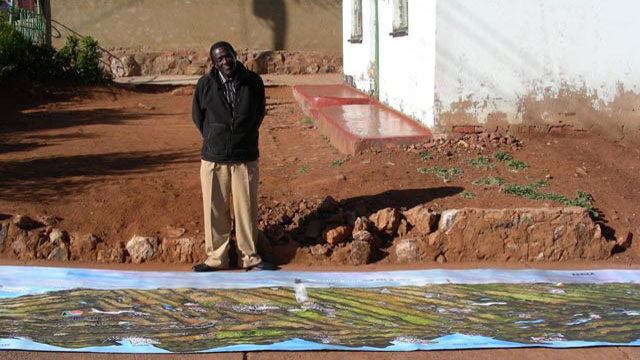
-
 Elfriede Dreyer
Elfriede DreyerMatiyane depicts cities of the world in the form of large mixed-media panoramas, utilising a naïve style of schematic outlining and an almost unsophisticated usage of coloured pencils and crayons, not unlike the early travelogues of the Renaissance and colonial explorers. In his panoramas, the landscape is flattened out into a subjective urban picturesque adorned with the city’s commercially most well-known markers functioning as a concise overview of or introduction to its most important historical events and its icons. Although Matiyane generally presents wide panoramas of cities, thus ‘walking’ multi-viewpoint compositions, he often creates panopticon-like designs in which he functions as a kind of ‘watchman’ surveying the city from a single point of observation – his own. In the late eighteenth century, the English philosopher and social theorist Jeremy Bentham coined the idea of the panopticon as a particular type of institutional building design that could allow surveillance by a single watchman in such a way that the entire institution could be surveyed from a single angle. The term ‘panopticon’ has been derived from Panoptes in Greek mythology that was a giant with a hundred eyes and known as a very efficient watchman. Bentham's architectural designs were very much aimed at the design of institutions such as prisons, for instance, or corporate environments, where inmates or workers could be surveyed without them realising it. Bentham’s ideas acted as precursor to twentieth-century technology such as closed-circuit television (CCTV).
Having been territorialised under the apartheid regime of segregation and living in Attridgeville a township outside Pretoria, the country’s administrative capital, Matiyane embarks on a kind of symbolic remapping of these histories. Operating without sufficient transport and with minimal equipment and art materials places limitations on his mobility and professional practice; within the context of the strenuous context of his daily battles, the spectacularity of powerful world cities and their apparent glitz and glamour to him seem like places of pleasure and the world like a global utopia where poverty and agony can be forgotten. In his Panorama of Africa: Cape to Cairo, Matiyane expresses a particular sense of place and a human condition, echoed in Alice Ming Wai Jim‘s (2008:264) description of Hong Kong in ‘Mediating place-identity: Notes on Mathias Woo’s A Very Good City’:
Over the last decade, contemporary art in Hong Kong, informed by travel(ing) theory, the special administrative region’s ambiguous (post) colonial-national-global connections and its inimitable set of historical and cultural situations, has been preoccupied with the themes of mobility, transition, and location in its representations of the city. This fixation, or, rather, the urgency of its mediation in not only artistic but also cultural, economic, and political arenas is inextricably linked to an ongoing elaboration of a Hong Kong identity. But assertions of “who we are” are often intimately related to suppositions of “where we are,” and ideas captured in the environmental psychological concept of place-identity.
Matiyane’s sense of identity and notion of ‘who he is’ is similarly tied to ‘where he is’, but virtually he can be anywhere. In every panorama, the artist traces the contemporary city’s ontology of mobility and transitivity in images of technology, airplanes, trains and boats. To him these images represent power, positive energy and dynamism, being tropes of transition and movement towards improvement, development and transformation. His utopian imagery can be interpreted as being populated by a multitude of heterotopic elements, such as powerful personae and images of transitivity represented by trains and boats that function autonomously but concurrently in close relation to their socio-cultural and geopolitical contexts; as liminal instruments connecting space and place; and as vigorous agents of change. In a work such as Panorama of Gauteng (2014), for instance, the artist included images as well as the life history of Nelson Mandela, interpreted as the as an iconic symbol of transformation and change, and in Panorama of Africa: Cape to Cairo, he once again presents Mandela as the most powerful legacy in Africa. It becomes a stratagem of power mediation to point out the country’s instruments of advantage within the global sphere of competition. His vision radiates optimism and hope and deconstructs the notion of the processes of historisation as categorically fixed, predetermined and non-negotiable.
Through the act of being empowered to depict any place in the world, the artist constructs his identity in the domain of the global self that utopianistically interacts with perceived spectacular environments. By mostly depicting cities that he has never been to, Matiyane expresses a desire and a longing for the exotic Other, yet his relationship to place is transmutative in essence. He imagines places where the home of the place–identity involves a process in which the self and local become metamorphosed into the global world. The artist becomes a ‘nomad’, displaced and diasporic in his pursuit of fame, wealth and global stardom through the fusion with ‘famous’ and ‘successful’ cities in his depictions. Global psychogeography is created in which cultural disparities are flattened in renderings of cities and their surrounding landscapes, each endowed with air and ground transport, patterns of housing, own histories, a national flag and a city centre. Becoming ‘playful masquerading’, the artist’s presentation of panoramic landscapes imbued by factual information makes the real, perceived and imaginary differences between cities, cultures and worlds fall away. Surveyed through the panopticon framework of his panoramas, there are superficially neither perceivable binaries of have and have-not, poverty and wealth; nor anxieties, losses or racial discrimination. East meets West meets Africa in a global blueprint of urban patterning.
By crossing the borders of the self and the local in his depiction of cities, Matiyane becomes a virtual flâneur of the cities of the world and a cartographer of imagined spaces.
Reference
Ming Wai Jim, A. Mediating place-identity: Notes on Mathias Woo’s A very good city, in Asselin, O, Lamoureux, J, Ross, C (eds). 2008. Precarious visualities: New perspectives on identification in contemporary art and visual culture. Montreal & Kingston/London/Ithaca: McGill-Queen’s University Press.
About the artist
Major exhibitions since 2008
2018, Venice Architecture Biennale, Japan Pavillion
2018, Titus Matiyane’s Cities of the World, ZAM, The Hague
2014, Cool Capital Biennale, curated by Elfriede Dreyer and Adele Adendorff. Panorama of Pretoria: Mamelodi to Soweto
2014, Reserve Bank, Cool Capital Biennale exhibition. Panorama of Pretoria: Mamelodi to Soweto
2013, Royal Academy of Fine Arts, Artesis University College, Antwerp. Group exhibition, Nomad bodies curated by Elfriede Dreyer
2012, Stevenson Gallery, Johannesburg. Panorama of Polokwane to Sasolburg
2012, Fried Contemporary Art Gallery, Pretoria. Group exhibition, Me 3, curated by Elfriede Dreyer
2011, La Société générale, Casablanca, Morocco. Cities of the world exhibition and Panorama of Western Cape. Curated by Annemieke de Klerk
2010, Fried Contemporary Art Gallery, Pretoria. Group exhibition, Cities in transition, with Eric Duplan and Lucas Thobejane, curated by Elfriede Dreyer
2010, Lille Métropole Museum of Modern, Contemporary and Outsider Art. Panorama of Lille
2010, Big 5 Festival, Teater aan het Spuy, The Hague. Panoramas of Cape Town, Berlin, Tanzania, Mali, Dubai, Johannesburg, Mpumalanga and KwaZulu Natal. Curated by Annemieke de Klerk
2009, UJ Gallery. Cities of the world. Panoramaas of New York, Pretoria, London, Dubai, Kwazulu Natal, Pietersburg to Sasolburg
2008, Aedesland, Berlin. Cities of the world. Curated by Annemieke de Klerk
2008, National Museum Of Mali, Bamako. Cities of the world. Curated by Annemieke de Klerk
2008, Fried Contemporary Art Gallery, Pretoria. Group exhibition, On the globe, with Pieter Swanepoel and Diek Grobler, curated by Elfriede Dreyer
2008, Delft University of Technology, Faculty of Architecture, Delft. Cities of the world. Curated by Annemieke de Klerk
Publications
- Annemieke de Klerk, Melinda Silverman, Stephen Hobbs, Wytze Patijn, 2007. Catalogue for the exhibition, Titus Matiyane: Cities of the World. Afdeling Bouwkunde, Technische Hogeschool Delft. 010 Publishers. Published for the purposes of the Cities of the World travelling exhibition, 2007- 2008 and the manifestation "African Perspectives" held December 6-8,2007, both commissioned by the Faculty of Architecture of Delft University of Technology.
- Makorakora: Shaping wire into vehicles. 1985. SA Today. Article featuring photograph of model of spacecraft “Challenger” made by artist.
- Rankin, E. 1994. Images of metal: Post-war sculptures and Assemblages in South Africa. Johannesburg: Wits University Press.
published February 2020
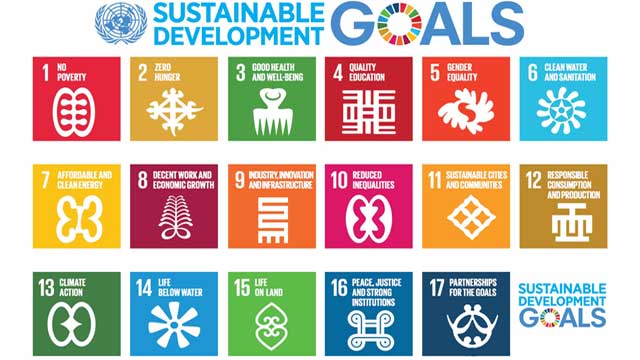
-
 Patrique deGraft-Yankson
Patrique deGraft-YanksonWe may be right to assume that the level of awareness just at a little over four years of its implementation should not be too alarming. However, analyzing such low level of SDGs awareness among a people a country whose president is a Co-Chair of the Eminent Group of Sustainable Development Goals Advocates in Africa leaves some cause to worry.
The good news however is that, not being directly aware of the SDGs in the way they have been blueprinted does not mean the people are insensitive to its calls and claims. The fact is that, most of the demands of the SDGs are already embedded in the culture and belief systems of the people, and I consider this as an important resource to deploy for awareness creation and enthusiastic implementation of the SDGs.
For the realization of UNs commitment to leave no one behind in the mobilization of the citizens of the world to achieve the 2030 agenda (UN, 2020) therefore, I am of the belief that efforts at linking the relevance of the 17 goals to cultural manifestations of the people should be highly considered. The image shown above is a demonstration of how various traditional symbols speaks to the SDGs in a language which is understood by the traditional Ghanaian. These symbols transcend language barriers and their meanings are inherent within their traditional belief systems, making the goals both physically and spiritually relevant to people.
The meanings of the symbols are as follows:
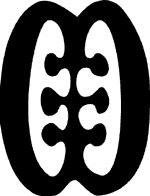
Ese Ne Tekrema (The teeth and the tongue)
Symbol of generosity towards one another. Through the formation of a linear relationship in diversity towards a common goal, both the personal and societal needs of the people will be realized.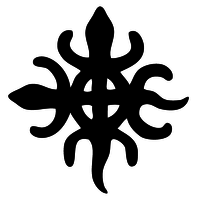
Funtumfunafu Denkyemfunafu (Siamese/conjoined crocodiles)
Symbol of brotherly feeling, caring and sharing. The society stays stronger when people coexist in the belief that we all smile and grow together when we feed and enjoy the good things in life together.
Dua Afe (Wooden comb)
Symbol of sanitation, cleanliness and beauty. This symbol reechoes the essence of physical and spiritual wellbeing through personal and environmental cleanliness.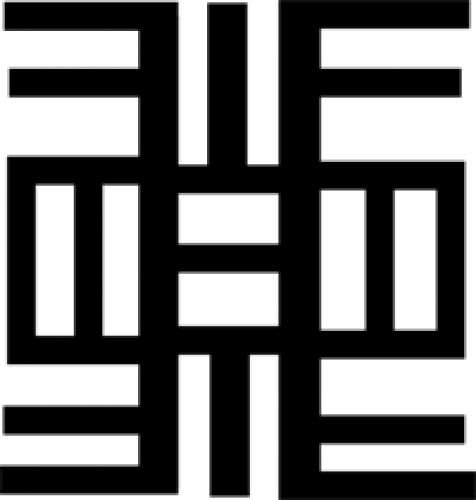
Nea Onnim No Sua a, Ohu (Anyone who does not know is capable of ‘knowing’ through education)
Symbol of educational opportunities. This symbol plays down ignorance by reminding people of their inert capabilities to get educated to any level of their preference. In other words, opportunities for quality education exist for all.
Obi Nka Bi (No one bites the other)
Symbol of equal regard, recognition and treatment for all. No one bites the other as a value ensures that all genders and age groupings have equal rights for existence in the society which allow them to listen and be listened.
Sesa Wo Suban (Change your life)
Symbol of deterrence and admonition towards all unapproved societal behaviors that affect the natural environment. This symbol represents strong advocacy for transformation and dynamic life patterns that affect nature. One of the unacceptable life patterns this symbol is currently addressing is the Ghanaian youth’s preference for wealth through illegal mining which destroys precious water bodies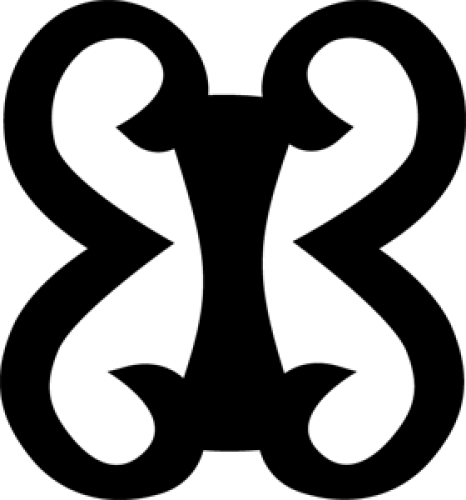
Pempasie (Sew in readiness)
Symbol of production and sustainability. This symbol emphasizes the importance of societal preparedness and readiness for the future through effective production and management of all resources for posterity.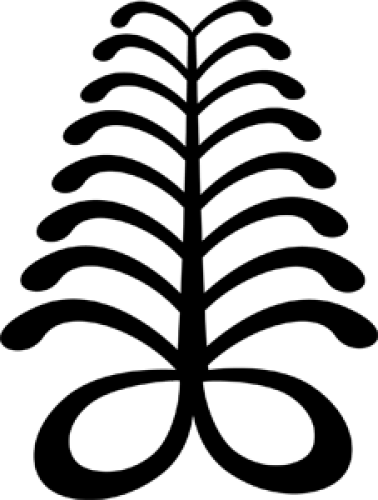
Aya (Fern)
Symbol of resourcefulness through resilience, self-reliance, hard work and judicious engagement of the environment and its resources.

Nkyimkyim (Twisting)
Symbol of collective action towards the building of the human society through initiative, dynamism, versatility, innovation and resilience. Indeed, building a successful society, like life itself, is not a smooth journey. The journey of life is tortuous and it requires a great amount of innovation and creativity to sail through.
Nkonsonkonson (Chain)
A symbol of unity. This symbol, depicting two links in a chain, advocates for the need to heal the componentized society since in unity lies strength.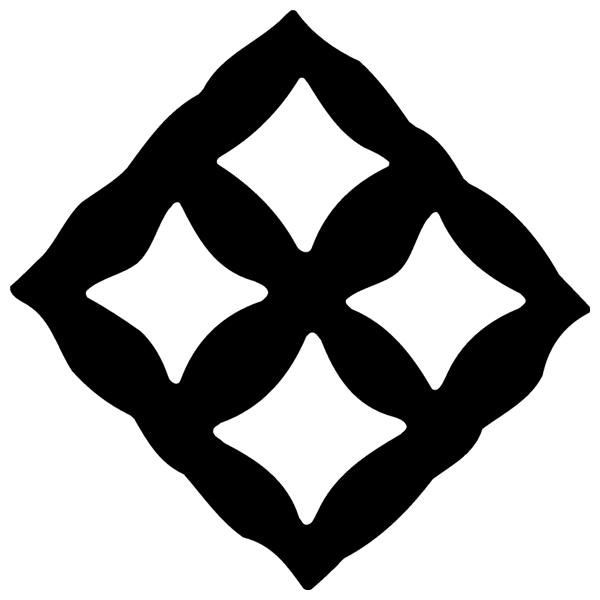
Eban (Fence)
A symbol of love, safety and security. The fence symbolically secures and protects the family from unhealthy activities outside of it.
Hwehwe Mu Dua (Measuring stick)
Symbol of examination and Self/Quality Control. This symbol emphasizes the need for circumspection in all human endeavors. It directs attention to self and quality control in everything including production and consumption. It admonishes against over consumption, over production and all forms of egoistic instincts and behaviors which adversely affect the general good of the society.

Nyame Biribi Wo Soro (God resides in the heavens)
Symbol of reverence to the heavens, the abode of the Supreme Being. Recognition to the ‘heavens’, or the skies as the residence of the supreme being is tied to the belief that all good things come from the heavens – rains, sunshine, fresh air, etc. The ‘heavens’ need to be respected for continuous flow of life-given goodies.
Ananse Ntentan (Spider’s Web)
Symbol of knowledge and wisdom about the complexities of life. This symbol alludes to the intricate personality of Ananse, the spider, a well-known character in Ghanaian/African folktales. In Ananse’s world, all facets of life need to be somehow manipulated, positively or negatively, for good or bad reasons. This sometimes led him to dire situation. Ananse therefore is a character for admonitions and reprimanding. Being conscious about the character of Ananse guides your steps against any unfair treatment to the world around you, be it the skies, on the land, in the waters or below the waters.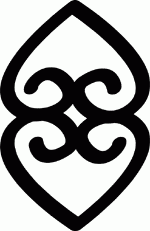
Asase Ye Duru (The Earth/Land is heavy)
Symbol for reverence and recognition to the providence and the divinity of the ‘Earth/Land’ and everything associated with it. The ‘Earth’ is the mother to everything. It carries the entire humanity, trees, water bodies, the sea (and what is in it and beneath it), big and small animals, etc. This why it is described as ‘heavy’. Respect/reverence to the Land is respect/reverence to life.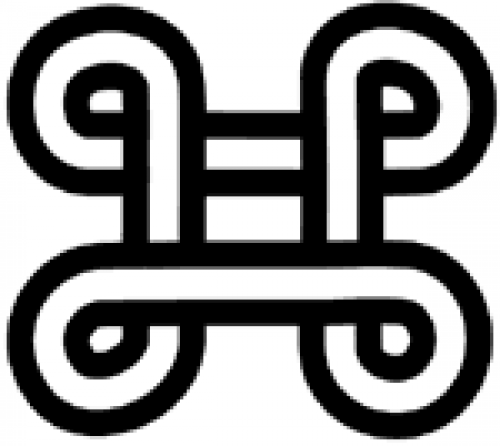
Mpatapo (Knot of Pacification/Reconciliation)
Symbol of bonding and adjudicatory factor which brings back parties in a dispute to a peaceful, harmonious and reconciliatory coexistence to ensure unified and strong societies and institutions.
Ti Koro Nko Agyina (One Head does not forma Council)
Symbol for partnership, collaboration and teamwork. This symbol emphasizes the importance of cooperation and collective efforts in the realization of all goals. Obviously, the attainment of the SDGs is a collective responsibility. No one nation (one head) can make it happen. It takes the concerted efforts of the entire citizenship of the world.Bibliography
- Adinkra Brand, A. (2020, November 15). African adinkra symbols and meanings. Retrieved from Adinkra Brand: https://www.adinkrabrand.com/blog/african-adinkra-symbols-and-meanings/
- Kasahorow Adinkra Library, K. A. (2020, November 15). Adinkra symbols and meanings. Retrieved from Kasahorow Adinkra Library: https://www.adinkrasymbols.org/symbols/nkyinkyim/
- United Nations, U. (2020, December 7). Sustainable Development. Retrieved from Uited Nations: https://www.un.org/sustainabledevelopment/development-agenda-retired/
published January 2021
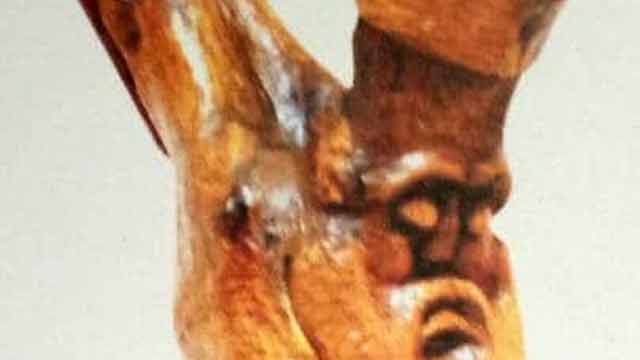
-
 Patrique deGraft-Yankson
Patrique deGraft-YanksonFortunately, contemporary Ghanaian artists like Vincent Akwete Kofi and Kofi Antobam, who by their training, developed both the skills and the mindset to create and fully appreciate African arts have played major interventional roles. They, through rigorous production of masterpieces over the years, led the move to redirect the wavelength of Ghanaian artistic expressiveness along the paths of decolonization. A typical example of these arts is the Crucifix, the selected object for this discussion.
The Artist – Vincent Akwete Kofi
The Crucifix is a sculpture in the round, measuring 45x10x19 inches, and was created by Vincent Akwete Kofi, a Ghanaian artist who lived between 1923 and 1974. Characteristically, Vincent creates outstanding sculptures in humanistic forms. His sculptures speak to traditional African philosophies, ideals and beliefs (Grobel, 1970), and he through his works, seeks to reinforce the beauty, dynamism and complexities of African art. Indeed, Vincent’s artistic posture was largely informed by his training in the then Achimota College in the Gold Coast (now Ghana), an educational institution which sought to bridge the gap between European and African forms of knowledge (Woets, 2014).
Description and interpretation
The Crucifix was carved in tropical hard wood, one of Vincent Kofi’s preferred media, with the style and subject matter reminiscing his belief in the creative and objective fusion of lessons from the history of modernism in the arts by an immersion in his Ghanaian heritage. Like his earlier sculptures therefore, the choice of this Euro-Christian theme throws lights on his Pan-Africanism and decolonization intents.
The sculpture is a depiction of a free-standing human figure with features that conform with his earlier wood carvings, such as depiction of enlarged head and heavy feet which are more representational than naturalistic. Again, the entire form is seen as being directed by the limitations of the tree trunk deliberately chosen for the work. This, of course is one of Kofi’s traditional wood carving styling.
The Crucifix is postured in a clasped forward-bent lower limb. Like the lower limbs, the upper limbs of the figure which are raised over the head and stretched backwards, are also clasped together, depicting the entire image in a rather discomforting posture. Further strengthening the feeling of distress and discomfort in the image is the dropped and lifeless face and facial features of the image. The long thick beard of the image with the tightly fitting cylindrical hat on the head, carved after one of those won by royals among some sections of Ghanaians, give the figure an elderly look.
Other significant features of the image are the exaggerated clasped, forward-bent and wobbly elephantine feet, dropped face with shuttered eyes, flaccid body/skin/muscles (which is visible even in wood), and the heavy beard.
In trying to understand the presentation of the Crucifix, it is important to note that Ghanaians have stories about characters who lived and suffered similar fates as that of the Christ. The Fante people (a section of the Akan ethnic group), for example have records on a man called Ahor, who offered himself as a sacrifice to the gods, when the life of a human being was demanded as an antidote to a calamity which befell the people. Up to today, Ahor is celebrated in a festival called Ahorbaa to commemorate his brave and sacrificial feat. Other ethnic groups in Ghana have similar stories which render the Passion of the Christ not just a familiar phenomenon, but a lived experience recorded in the history of the people.
Also worthy of notice is the familiarity of the various themes which characterize the story of the Christ, such as his kingship, miraculous personality, sacrificial journey and his eventual torture and death. The Crucifix therefore, was Vincent Kofi attempt at depicting the passion of the Christ in a way that would make it familiar and relevant to the people.
The image in Kofi’s Crucifix was therefore needed to be presented as a man with royal personality, as depicted in the cylindrically shaped cap, which is symbolic of some of the Ghanaian royal millinery that depict kingship and authority. This is reinforced by a heavy beard to portray wisdom. Wisdom which is reserved for kings and aged people.
Analysing from the experiences of a people whose history was not devoid of unpleasant experiences, such as enslavement, brutal torture and execution, the image presented in the Euro-Christian Crucifix could not have been a complete representation of the Man of Sorrow described in the Christian holy book (Isaiah 53:3). Kofi therefore saw the need to present a figure which paints a real picture of a man who had gone through an extreme physical pain. Those strong and heavy, yet wobbly feet were a symbol of a man overburdened with sorrows and sins of the world.
Indeed, the man on the Crucifix was dead, with no chance of maintaining a smooth and shiny skin as seen in the Euro-Christian crucifix. In Vincent Kofi’s Crucifix, therefore, he, even in wood, managed to present a flaccid body/skin and muscles which, with the closed eyelids, dropped and lifeless face gave an impression of an extremely tired dead body. Probably an artistic rendition that comes close is Mel Gibson’s crucified Christ in his movie, the Passion of the Christ.
Conclusion
Early missionaries introduced the Christian religion with its attendant icons, images, stories and language in 1400s. Semblance in religious icons, images, stories and their associated functions made the acceptance of Christianity easier among indigenous Africans/Ghanaians. Vincent Kofi’s Crucifix could therefore be considered as a great effort towards connecting foreign Christian belief systems to known religious experiences, thereby making Christianity much more relevant to the African than it has been.
References
- African Artists in America (1978). African Affairs, 11 (3), 84-85.
- Frank, B. (1999). The Visual Arts of Africa: Gender, Power, and Life Cycle Rituals by Judith Perani and Fred T. Smith (A review). African Affairs, 11 (3), 14-16.
- Kwami, A. (2016). Kofi, Vincent Akwete (1923–1974). In the Routledge Encyclopedia of Modernism.: Taylor and Francis. Retrieved 31 Dec. 2021, from https://www.rem.routledge.com/articles/kofi-vincent-akwete-1923-1974. doi:10.4324/9781135000356-REM845-1
- Moore, G. (1967). The Arts in the New Africa African Affairs, 66 (263), 140-148.
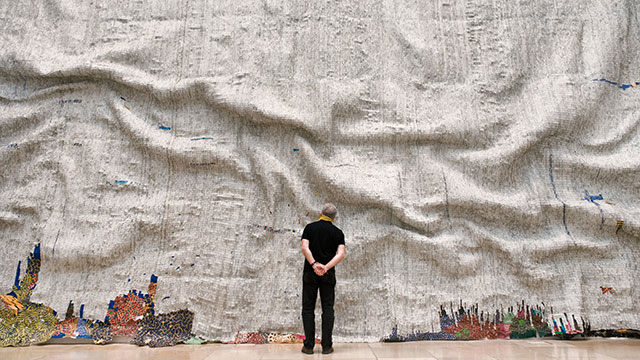
-
 Patrique deGraft-Yankson
Patrique deGraft-YanksonThe Rising Sea by El Anatsui is a naturalistic presentation of an ocean in turbulence, which elicit attention through both grotesquery and finesse. The work, which covers an area of about 14,38 by 6,90 meters, is made up of several pieces of flattened aluminum bottle tops stitched together with copper wires into a massive sheet of grey wall overlay.
To achieve the intended illusion, the artist manipulated portions of the metal fabric into large series of ridges of different sizes that combine into an irregular rhythm randomly positioned across the surface of the sheet to simulate sea waves. Beyond supporting the movements of the sea waves, the rhythm created by the raised portions of the work also provides narrow range of values that effectively bring out the three-dimensionality of the work and transforms the otherwise flat sheet into an illusionistic volume.
Like the texture of oil paints in Van Gogh’s Starry Night, the texture of the stitched pieces of metals sheets introduce energy into the work, bringing out the fluidity of the sea and the potency of the mesmeric sea waves. Indeed, improper disposal of those materials used (and many others) is causing a lot of nuisance in his home country and other parts around the globe, with the sea being the most affected. Therefore, right from the materials used to its marvelous finishing, it is not difficult to discern a blend of severe censuring and admonition in the voice of the artist. The sea is, in the way presented, depicted as rising against improper treatment; and El, by the pains taken to stitch every piece of material together, seems to emphasize the need to make it our business to salvage the sea from improper handling.
The sea, which has served as an important source of livelihood for Ghanaians over the centuries invokes multidimensional viewpoints and draws out divergent responses and reactions depending on its relationship with the people. Among the coastal dwellers (and indeed a very great population of Ghanaians), the sea is considered an important resource for commercial activities, an arena for entertainment and recreation and grounds for spiritual exploits and worship.
He himself being born in the coastal town of Anyako in the Volta Region of Ghana, El seems to know so much about the sea. Growing up, he most likely experienced the sea being perceived, treated and utilized in many different ways. Besides its major use for commercial activities and other useful ventures, he might have listened to many stories about the sea as a god (with other inhabitants), as a provider and as a friend. He might have learnt about how the sea and her inhabitants contribute to the fortunes of the people. He might have witnessed how people got healed as they bathed in the sea, or had their fortunes turned around as they threw some coins in the ocean and made their requests known to the sea.
Beyond this, he might have also been warned about the consequences of flouting the taboos and other prohibitions that regulate the “use” of the sea, including forbiddance from desecrating the sea with unhealthy practices such as defecating in the sea, throwing filth into the sea or wearing sandals or shoes in the sea and the need to observe the tabooed fishing days, and so on. Besides, another important thing which Ghanaian coastal dwellers take very seriously is the need to adhere to physical signs and conditions of the sea, which have various local interpretations and implications. For instance, there are periods when the sea is considered as “full”, during which times the sea waves “rise” and become more intense and turbulent. Fisher folks are supposed to take a rest from “climbing the sea” (as they say in the local parlance) as the sea is likely to be unfriendly, and therefore unconducive for fishing.
Factors that cause the “rising” of the sea may not be ordinarily known. However, according to coastal dwellers, there is always something sinister about a rising sea – either somebody got drowned, or someone or a group of persons might have violated the rules of the sea god – and what motivated El in his presentation of the Rising sea might not be any different from what are traditionally believed. Probably the sea is fed up with deliberate dumping of wastes and toxic materials into her bowels. Therefore, she must rise!
But the “full” or “rising” sea is not as unfriendly as it sounds. Though it prevents fishing activities, which might be one way of punishing the people for disrespecting her, it also affords the people the opportunity to dry up their canoes, mend their nets and relax in the beautiful view of the sea along the coast. The occasions of the rising sea also witness other people who just move along the shores to observe the large waves that gather in the deep ocean, roll angrily towards the shoreline and dissolve tumultuously at the shore in a creamy white lather. The views at the seashore during these periods are nothing short of aesthetical experience that is shared by different kinds of observers with different perceptions, questioning, discussing, enjoying.
In so many ways therefore, the spectacle of observers in front of El Anatsui’s gigantic reconstruction of the Rising Sea gives so much semblance to the natural phenomenon, and this is a fundamental underpinning to the success of El’s work.
Culturally, the Rising Sea could be perceived as an allusion to the dynamisms in life, which sometimes rise against human tendencies and restrict mundane behavior, at the same time ensuring regularization of natural behaviors. What is important is to identify what is causing what, and how to seek for the right solutions.
For it to be presented as an aesthetic piece of work, El is probably saying that, the Rising is Sea is frightening; it is confusing; it is chaotic. But she is still beautiful, because in the right time, when given the right treatment, she will calm down so we have nothing to fear. She is still our god, our friend, our provider and our protector.
published February 2020
 Ernst Wagner
Ernst WagnerEl Anatsui (* 1944) created 'Rising Sea' 2019 specifically for a particular wall in a comprehensive solo exhibition of his oeuvre entitled “Triumphant Scale” at the ‘Haus der Kunst’ in Munich. Like many of his other works, “Rising Sea” is a large-scale piece comprised of thousands of flattened liquor bottle caps (extrapolated approx. 190.000) that have been tied together with copper wire. It hangs like a large tapestry from ceiling to floor and though it looks solid, it is flexible and has a seemingly textile structure. The effect is monumental and magnificent; it impresses by the sheer size as well as by the sensual materiality of the almost infinite number of small, shimmering pieces of tinplate.
To see the composition we need to view the work from a distance. The sculpture is divided into three starkly contrasting horizontal zones. A vibrantly colored strip runs along the bottom. It appears fragile and becomes thinner and interrupted as it runs toward the lower right corner. The broad, massive, monochrome grey zone in the middle falls with heavy folds. The third zone at the top is a narrow, shiny, silver and smoother appearing plane that rises from its lower edge on the left in a sharp line upwards to the right, like a ‘Silberstreif’ (i.e. glimmer of hope).
Nearing the work, we discover bright flecks of color that emerge out of the shimmering mother-of-pearl gray middle zone. While some of the flecks appear to build concrete figurations others seem to be randomly dispersed. In the lower right corner small speckles of color gravitate toward and buzz around a concentrated cluster of speckles. We are enticed to move closer and to discover more details. Individual bottle tops become recognizable out of a speckled ‘field of pixels' or 'threads in the fabric’. One recognizes and reads the labels "Turn to open" and the names of African high-proof alcoholic beverages that are popular in Ghana or Nigeria where El Anatsui lives and works (KP Beverages, Bacco , etc.)
As with an impressionist painting, this work enables and requires two different viewing positions: close up and from a distance. Both perspectives tell different stories. In contrast to impressionism, El Anatsui’s stories address political and social issues of highest relevance. From a distance, the rising water level caused by global warming is addressed, to which the title of the work 'Rising Sea' refers. “Reading” from left to right, sculptural folds in the large gray middle area remind us of mighty waves that are in the process of destroying the narrow, speckled strip on the floor that we may associate with human dwellings and their fragile situation. The ‘Silberstreif’ is dwindling and so is hope. Obviously, this meaning is addressed directly and in all clarity.
The inscriptions on the bottle tops tell another story, the story of alcohol and slave trade during European colonialism in West Africa. Thousands of Africans were sold and taken across the Atlantic in ships to cut sugar cane in the Caribbean plantations to make rum. The rum was shipped to England and then later sold to Africa. Rum with its high alcohol content became another means of dominating an already exploited people. In the course of time, West Africans commonly used rum and other forms of alcohol for libations. However, El Anatsui only uses discarded bottle caps from liquor made in Africa today.
In turn, the process of 'sewing' the individual metal pieces together is an important, additional cultural-historical referral to El Anatsui’s roots in West Africa where there is a long tradition of weaving colorful textiles.
The close-up view of “Rising Sea” thus speaks of the past in West-Africa. Whereby the view from the distance, speaks of the future, a future that directly and indirectly affects the world globally. The narrative strands are connected by the idea of upcycling: discarded bottle caps become art, the cheapest material becomes sumptuous beauty, the past becomes present and future, regional colonialism becomes the narrative of a global threat.
It is important to remember that it is a black artist from Ghana exhibiting this threatening beauty in a space that was built in Munich to serve National Socialist racism. The title of the exhibition 'Triumphant Scale' alludes directly to this context, which Okwui Enwezor, the initiator of the exhibition, was certainly aware of. The Nazi regime, a regime without scale, built the Haus der Kunst, a building that broke all scales. El Anatsiu’s magnificent, grand scale triumphs over the excessive Nazi scale.
Challenging the Western concept of art
As an artist, El Anatsui is a representative of the Global South as well as of global art. He displays past and present catastrophes in decorative splendor. We can understand this message through classical analysis and interpretation on the base of the iconography of material and motifs. This system of decoding is familiar to us and confirms our Western expectations of a work of art. However, the simple explicitness of the content of El Anatsui’s work, poses a challenge to Western expectations of open, complex, self-contradicting art.
According to the latent notion of the community of art experts, if there is a clear content in art it should be as ironic, witty or distanced as possible. Hence, the intrinsic value of art (l'art pour l'art) eludes ideological appropriation and art gives no instructions for action. None of these tenets of Western art is is evident in Anatsui’s work. "Turn to open” with an arrow pointing up or down is the instruction repeated thousands of times in the middle section of “Rising Sea”. The sentence can be read as a directive for us to act on the challenges of our time.
El Anatsui thus negates the ‘prohibition' of unequivocal, direct symbolism and narration in the Western concept of art and its associated prohibition of politics and agitation. As a global artist, he challenges this concept. In addition, it is interesting to note that El Anatsui, unlike most Western artists, often leaves the responsibility of installing his work in exhibitions to the respective curators. In every exhibition, the same works look a little different, or quite different: folds will fall differently, pieces will be grouped differently and work that has been previously exhibited hanging on the wall may even be presented lying on the floor. With this artistic strategy, he formulates an unmistakable position from the Global South. Thus Western dominance loses its normative power in art and culture in general. The world becomes more diverse and polycentric.
Learn more about El Anatsui.
published February 2020
 ISB_Team
ISB_TeamTwo perspectives on one work of art
In 2019, a large solo exhibition of the Ghanaian artist El Anatsui, initiated by Okwui Enwezor, took place at Munich's Haus der Kunst. It was the occasion for Patrique deGraft-Yankson and Ernst Wagner to write together about one of the works there. deGraft-Yankson and Ernst Wagner agreed on a parallel writing process in order to minimise any mutual influence of their respective approaches. Thus, they knew nothing of each other's point of view. The resulting texts can be read above.
The result of this exercise is surprising and fascinating. In some aspects, of course, the interpretations of the work coincided, but in others they differed considerably. What they had in common, for example, was the appreciation of the production process and the impressive effect of material, size and surfaces. Also that the issue of environmental pollution plays a central role in the interpretation of Rising Sea. But it was precisely here that the first differences, even mutually exclusive approaches, emerged: for example, when deGraft-Yankson referred to the sea as a deity, a deity that can sometimes be friendly, but also unfriendly. Understood in this way, the sea in its immediate effect is simultaneously frightening and beautiful, it threatens and at the same time invites aesthetic enjoyment.
Ernst Wagner could easily relate this aspect to the Western aesthetic of the sublime, however, the difference becomes quite clear when we look at the underlying concept of what an art work is. deGraft-Yankson's text takes the work of art as its point of departure, but it always speaks of the sea itself, while Ernst Wagner always speaks of the work - and not of the sea. This different focus marks a fascinating difference: deGraft-Yankson is concerned with the sea, which he brings to us through his discussion, while Ernst Wagner is concerned with a work of art that simply has the sea as its subject. For deGraft-Yankson, the sea is "in" the work, it is really present. For Ernst Wagner, the sea is a represented motif, it lies "behind" the work, so to speak. It serves as a theme or a point of reference.
This has consequences for the methodology: while Ernst Wagner delivers an analysis of form, deGraft-Yankson focuses on contextualising the art work; he describes the significance of the sea for the people on the Ghanaian coast today. This difference is probably also due to the different perceptions of what the sea itself is: in his text, deGraft-Yankson speaks of the sea as an independent, souled entity, an acting being or a god that enters into a relationship with people. For Ernst Wagner, the sea - as part of the ecosystem - is also in relationship with humans, but he does not ascribe an independent will to it.
These different understandings of the relationship between human beings and the world are then echoed in an obviously equally different concept of what art or an art work is. In deGraft-Yankson's text, the work of art, like the sea itself, is charged with energy. The sea appears, as it were in the work, indeed it is present there. In the work, then, the sea materialises as something we perceive directly. In this sense, the work and the sea appeal to us to "preserve it from improper treatment [...] or it will be desecrated."
This approach of deGraft-Yankson, in which everything interpenetrates, is contrasted with Ernst Wagner's approach, which analytically separates everything: proximity and distance, splendour to be enjoyed and admonition to be taken seriously, discourse on colonialism and ecology, work and motif, art system and ecology, art system and colonialism, and so on. In the end, Ernst Wagner achieves a synthesis, but it only works on a meta-level by addressing the irritation of the Western concept of art through Anatsui's work. An irritation that dissolves or at least relativises the fundamental separation in Western understanding of viewer and object, of sign (the concrete work) and signified (the rising sea), of spirituality and reality, of art and ethics.
Annette Schemmel, then member of the ISB group, wrote to the the authors in 2020:
"Dear Patrique, dear Ernst,
Your texts are a great read and so complementary! For me, writing from Munich, the aspects raised by Patrique have opened up an entirely new reading of this marvellous piece of art, which I was lucky to contemplate at the exhibition of Haus der Kunst. What you're telling about Ghanaians' relation to the sea is unveiling and beautiful, thank you for unfolding these narratives here! Thank you all the more for sharing a piece of local wisdom (how the sea can react angrily) and linking these narratives to the global challenge of saving the sea, a challenge with impacts on localities all over. On another note, the evocation of "Starry Night" caught my eye at once and does make a lot of sense to me. I will be using it in my art classes, if you don't mind.
Ernst's reading of the piece is much more familiar to me, obviously. He is telling about the context of the exhibition on site in Munich, a context that is so highly charged! When exhibited at this specific museum, Anatsui's work can't but comment on our German history, laughing at its racism by means of its "immoderate" dimensions and calling for a long-due revision of our role in colonialism and in exploitative global circuits of goods like alcohol. It is for this potential of speaking to a place that artworks should always be seen in different locations!
I would also like to point out that Ernst is exemplifying a familiar method of accessing artworks here, a method that I am happily teaching to my pupils. This method from academic art history wants you to start from close observation and description of formal aspects of the work before risking an interpretation. By means of this strategy arguments about a work of art are meant to become more solid, even if this visible gesture of searching for the right interpretation makes a text less smooth. Thus, Patrique's and Ernst's approaches are totally complementary.
This said, I am not agreeing with Ernst in the way that "Rising Sea" is explicit in a way that certain Western art lovers might want to criticize. They might, but they would be very wrong. Let me explain: to me, the reproach of explicity rhymes with simplicity and a lack of layerdness. As you both have shown, "Rising Sea" does have multiple layers of possible interpretation and certainly some more, which have not been addressed here. These layers are visible, not only but most clearly, if the work is read against the backdrop of different locales. Artworks from our global age command us to look at them with changing perspectives. If certain Western art lovers can't be bothered to do this, they will forever be missing the point. Their fault. Let me add that you might even spot a good deal of irony in the way that El Anatsui has made this piece outstandingly beautiful, caressing the eye to the degree that every exhibition visitor wanted to take a selfie in front of it, while at the same time pointing to some very painful and threatening truths about today's humankind. Therefore, I would like to uphold that this artwork's relation to the viewers and to its places of exhibition is complex and challenging rather than simple or explicit.Annette"

